Allison Collection Photos
January, 1944
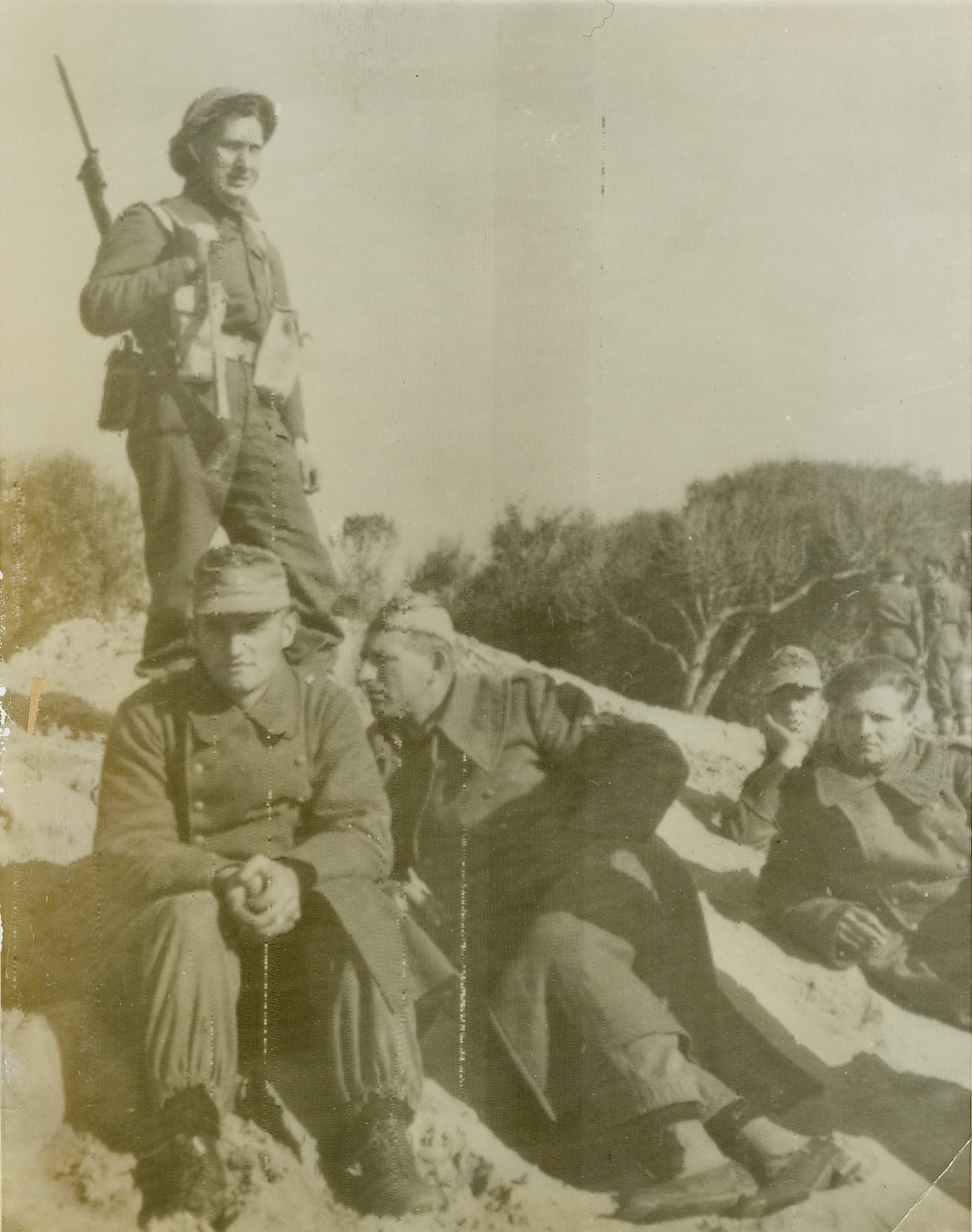
First Prisoners, 1/23/1944. With the Fifth Army in Italy – Four German prisoners, the first taken by Allied Forces after the initial surprise landing south of Rome on January 22nd, lounge on a west coast beach, guarded by a British Tommy. The entire Nazi Army was as surprised as these hapless captives to find the Allies in that section of Italy. After more than 24 hours in their new positions, our forces have met with only token resistance. Credit: British Army photo via OWI Radiophoto from ACME;
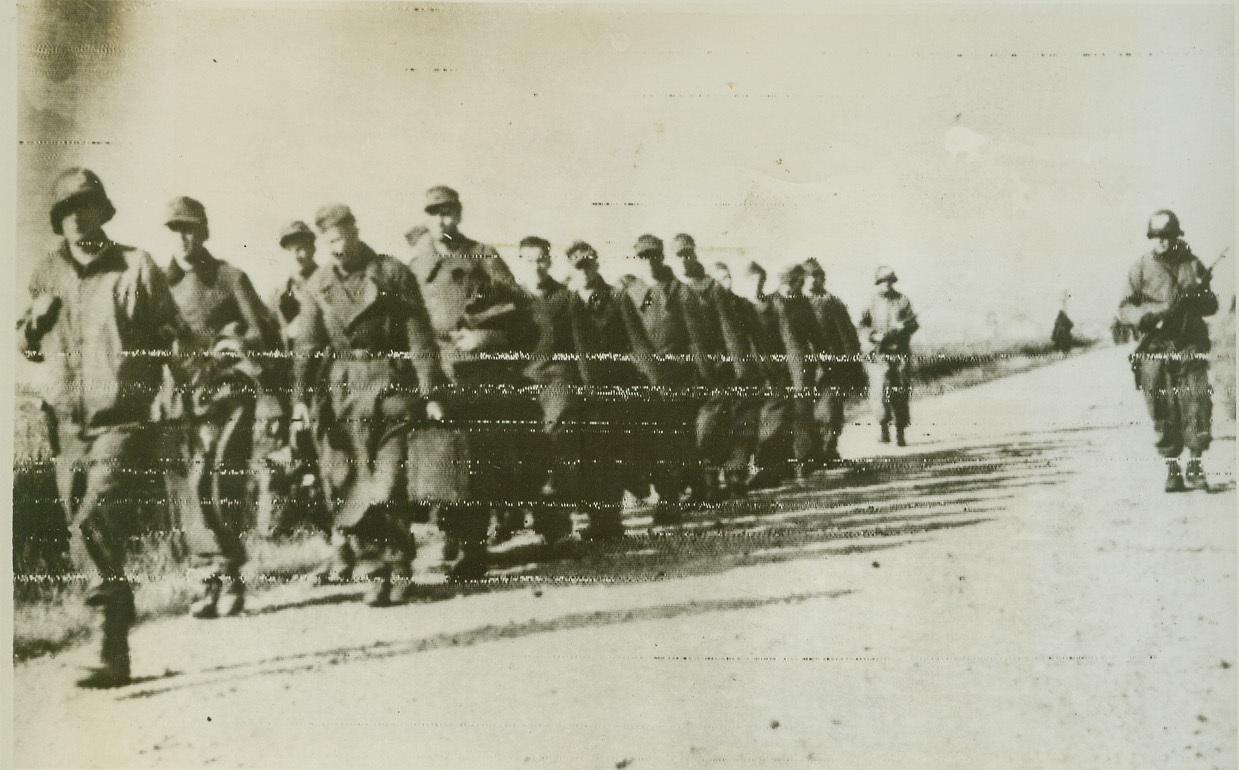
Nazis captured in new Allied thrust, 1/24/1944. Italy – A column of captured German soldiers are marched to the rear by Fifth Army fighters taking part in the new Allied thrust toward Rome. The American, British and French assault troops have drive four miles inland and are reported only 30 miles from their goal, Rome. Credit: Stars and Stripes photo via OWI Radiophoto from ACME;
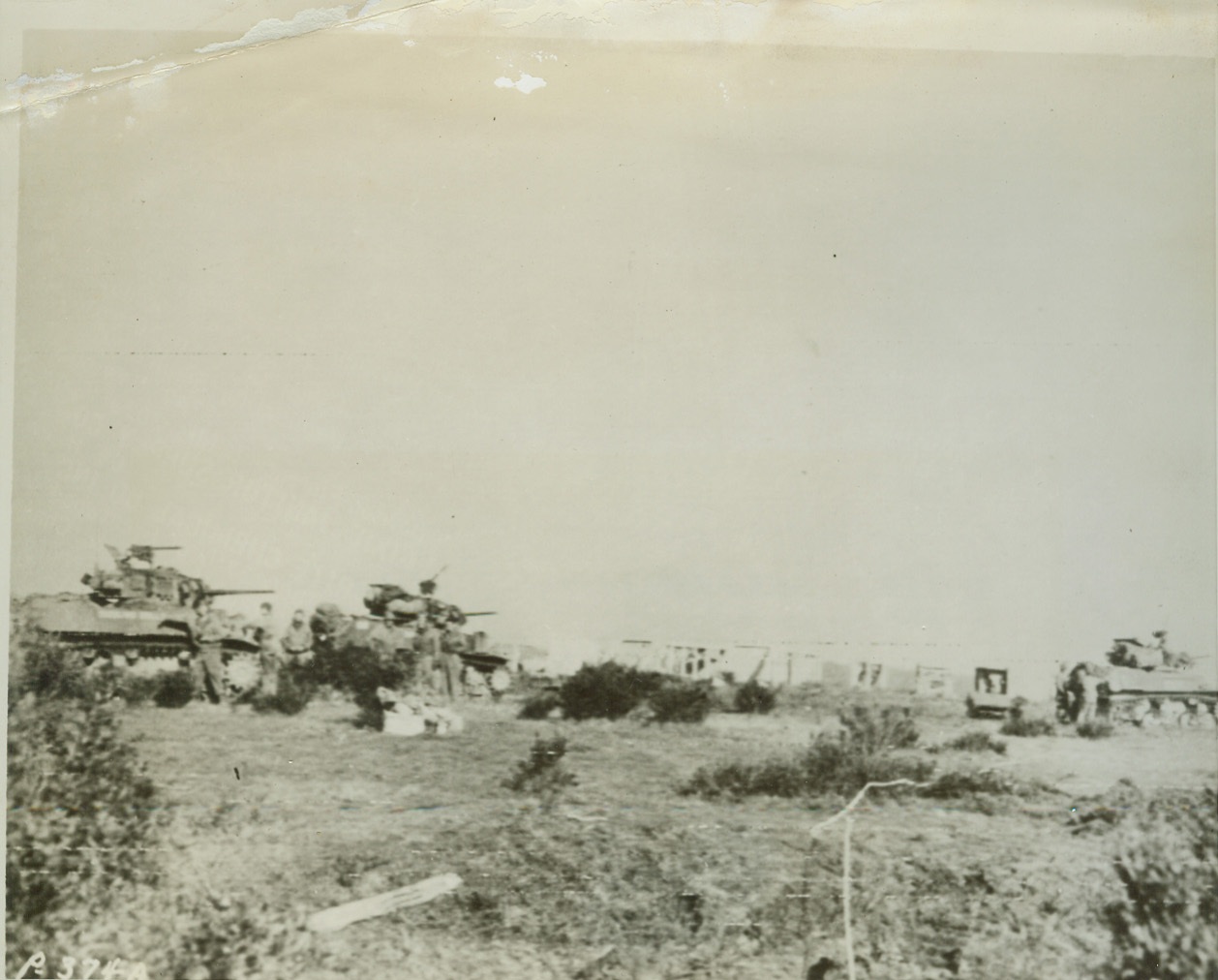
Short cut to Rome, 1/24/1944. Italy – In this photo flashed to the United States by Radiotelephoto today, American Army light tanks stop far inland from the beachheads captured by the Allies in their “shortcut” landings south of Rome. Reason for the halt (above) are the concrete barriers (center background) put up the enemy. Today, it was announced that Allied Forces have driven four miles inland and are less than 30 miles from Rome. They have still encountered little resistance from the Germans. Credit: (U.S. Signal Corps Radiotelephoto from ACME);
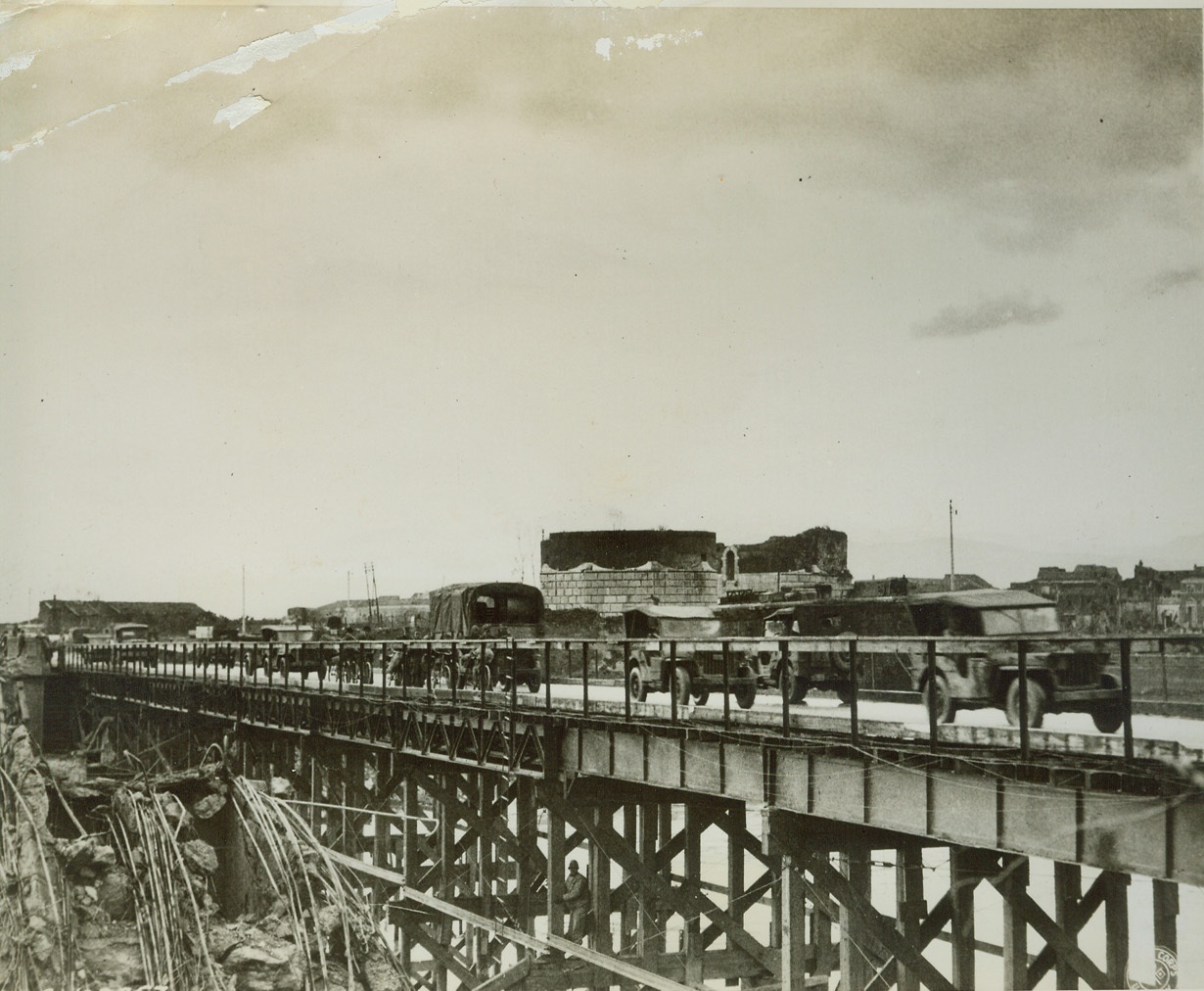
New Bridge for Old, 1/24/1944. Capua, Italy – When the Germans retreated across the Volturno River recently, they destroyed every bridge in the path of the Allied advance. As American troops reached the river, U.S. Engineers built pontoon bridges and then, when both sides of the river were in Allied hands built more permanent structures such as this bridge at Capua (above). Part of the structure of the old bridge can be seen at lower left. Credit: (U.S. Signal corps photo from ACME);
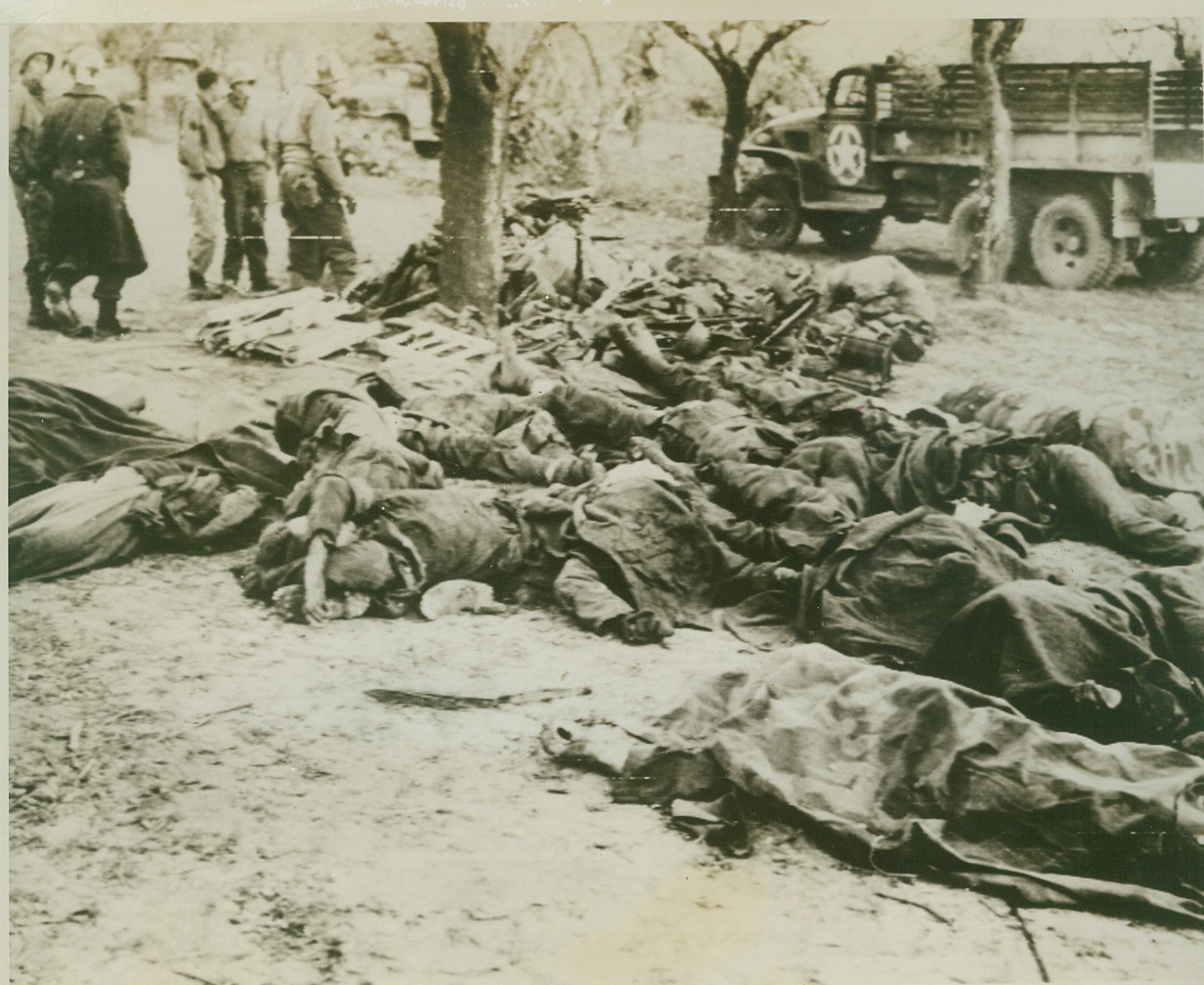
They Died for Hitler, 1/21/1944. San Vittore, Italy – A flock of fallen Nazi warriors lies, with a batch of German equipment, on the ground at San Vittore collecting point. American Medical Corps personnel can be seen in background. Credit: (U.S. Army Radiotelephoto from ACME);
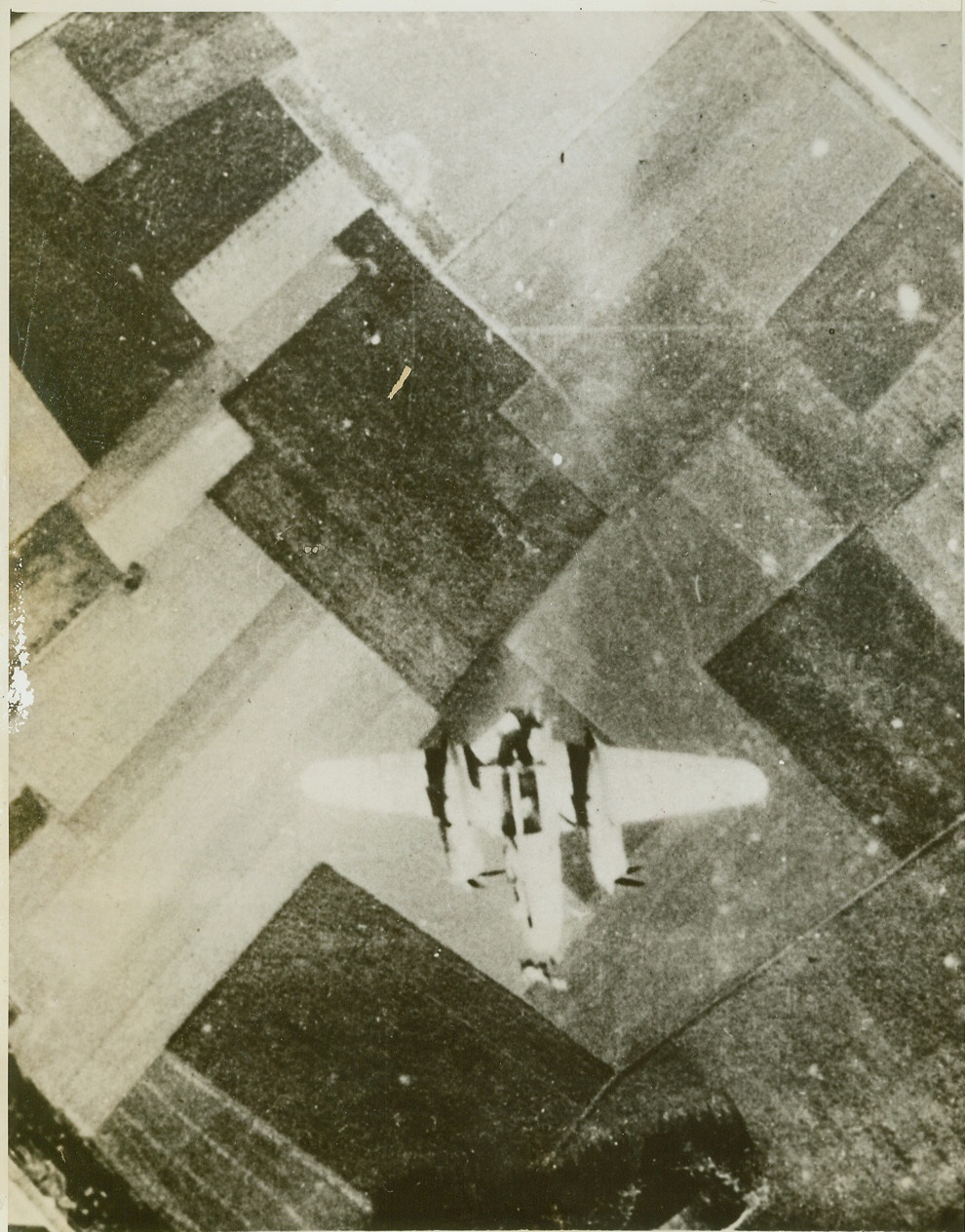
Marauder Goes Down Over Europe - 1, 1/21/1944. Severed by enemy fire while on a mission over enemy-occupied Europe, the forward part of the fuselage of a B-26 Marauder plunges earthward. This is one of two unusual photographs made during a U.S.A.A.F. raid over Hitler’s land. Credit (U.S. Army Air Forces photo from ACME);
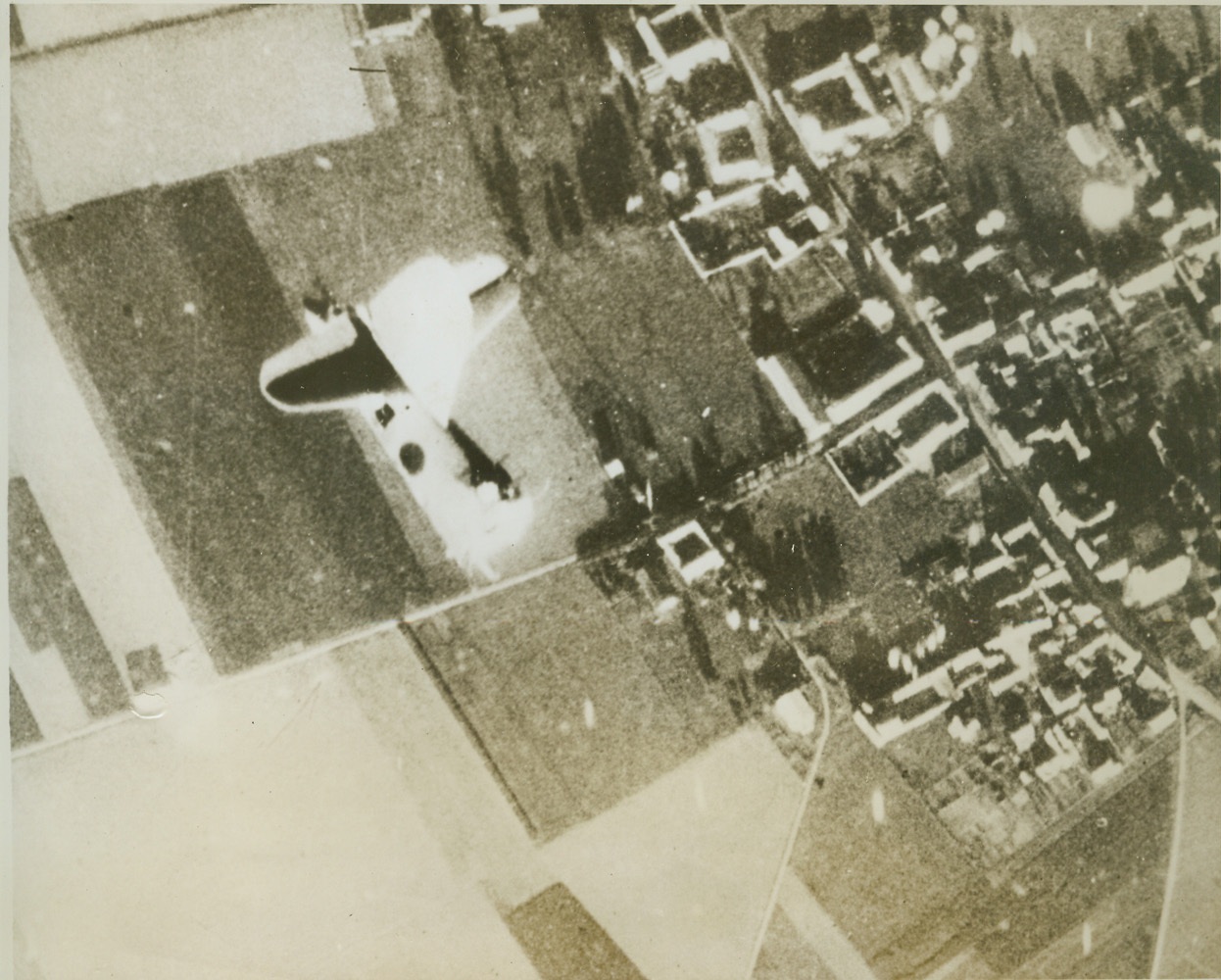
Marauder Goes Down Over Europe – 2, 1/21/1944. Torn from a B-26 by enemy fire, this Marauder tail section plunges down toward Hitler’s Europe. The ill-fated plane was downed during a U.S. Army Air Forces raid over enemy-held Europe. Credit (U.S. Army Air Forces photo from ACME);
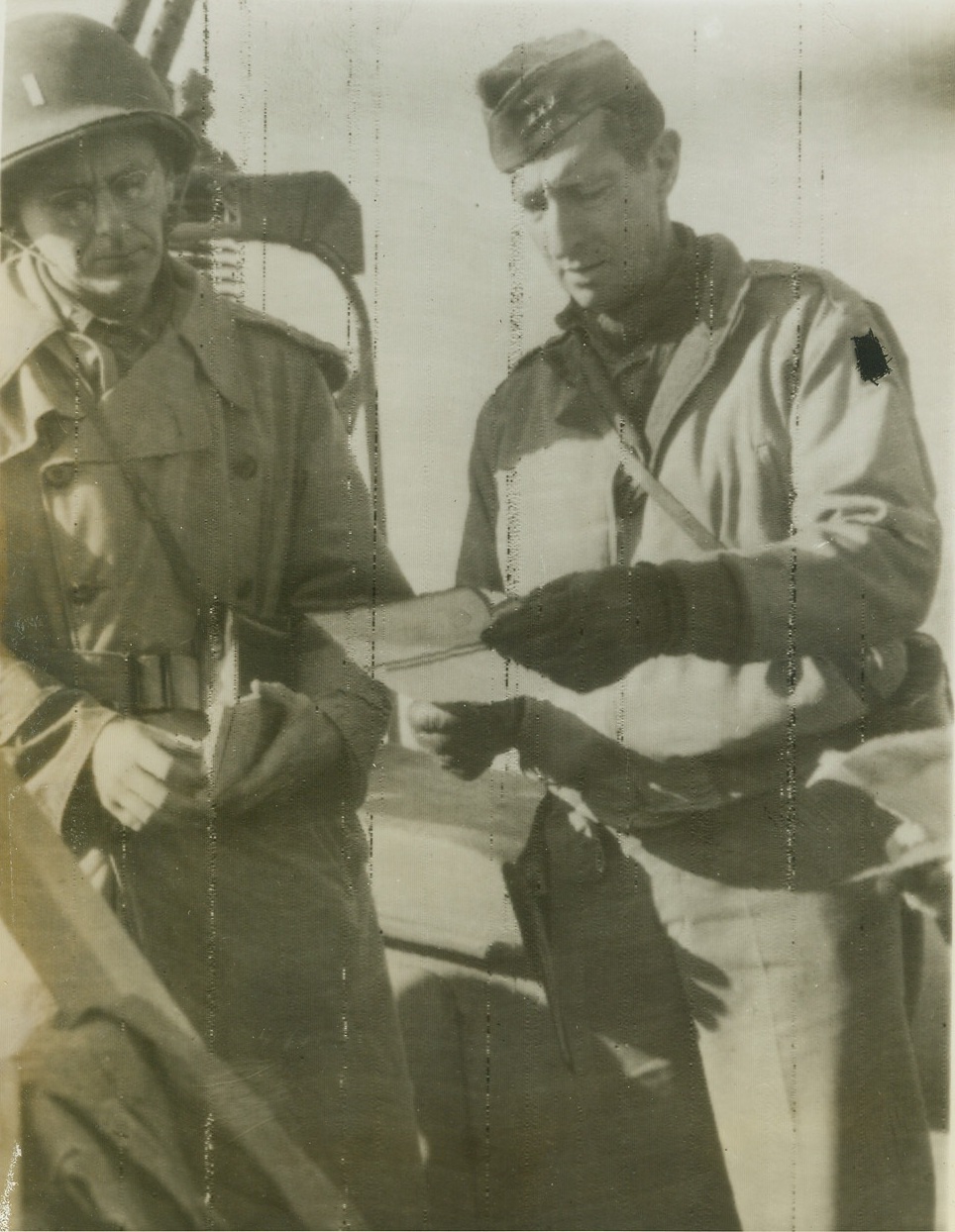
Good News for Clark, 1/23/1944. With the Fifth Army in Italy – Lt. Gen. Mark W. Clark, commanding general of the Allied Fifth Army, gets his first message from his invasion forces and reads the heartening news that our fighters swarmed ashore with ease, meeting no enemy resistance as they landed at dawn on January 22nd. Pushing inland from their newly established beachhead, our troops have met with only token resistance. Credit (U.S. Army Signal Corps photo via OWI – ACME);
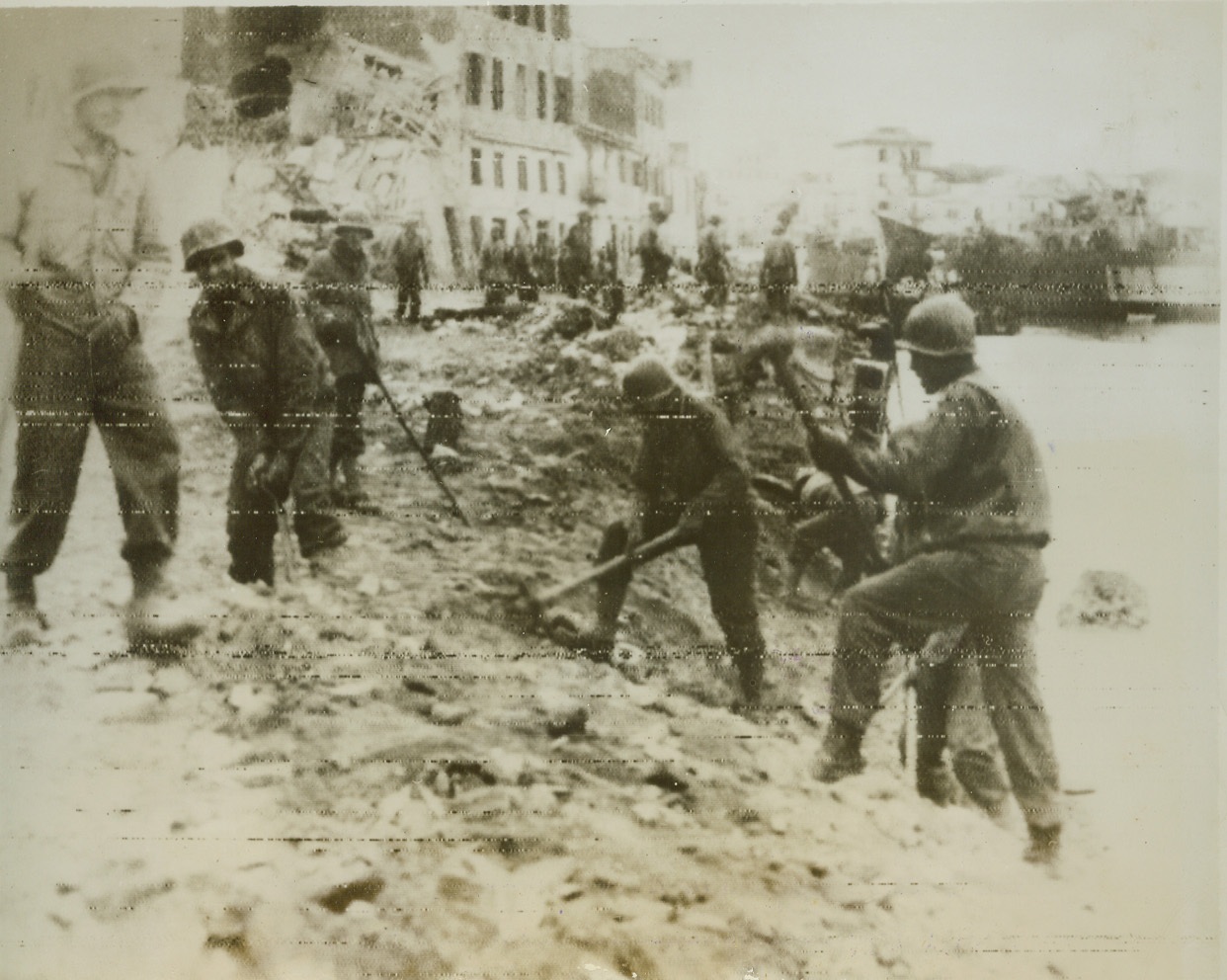
Anzio, Italy, 1/26/1944. American soldiers remove depth charges and demolition bombs planted by the Germans, along the beach at Anzio, one of the points where streams of men and material are pouring ashore for the Allied march on Rome. When Allied forces made their surprise bypass landings near Anzio, Germans tried to demolish harbor installations in the city but were not entirely successful. Note some buildings (background of photo) showing damage. Photo was flashed to New York by radio tonight. Credit: (Stars and Stripes photo thru OWI radiophoto from ACME);
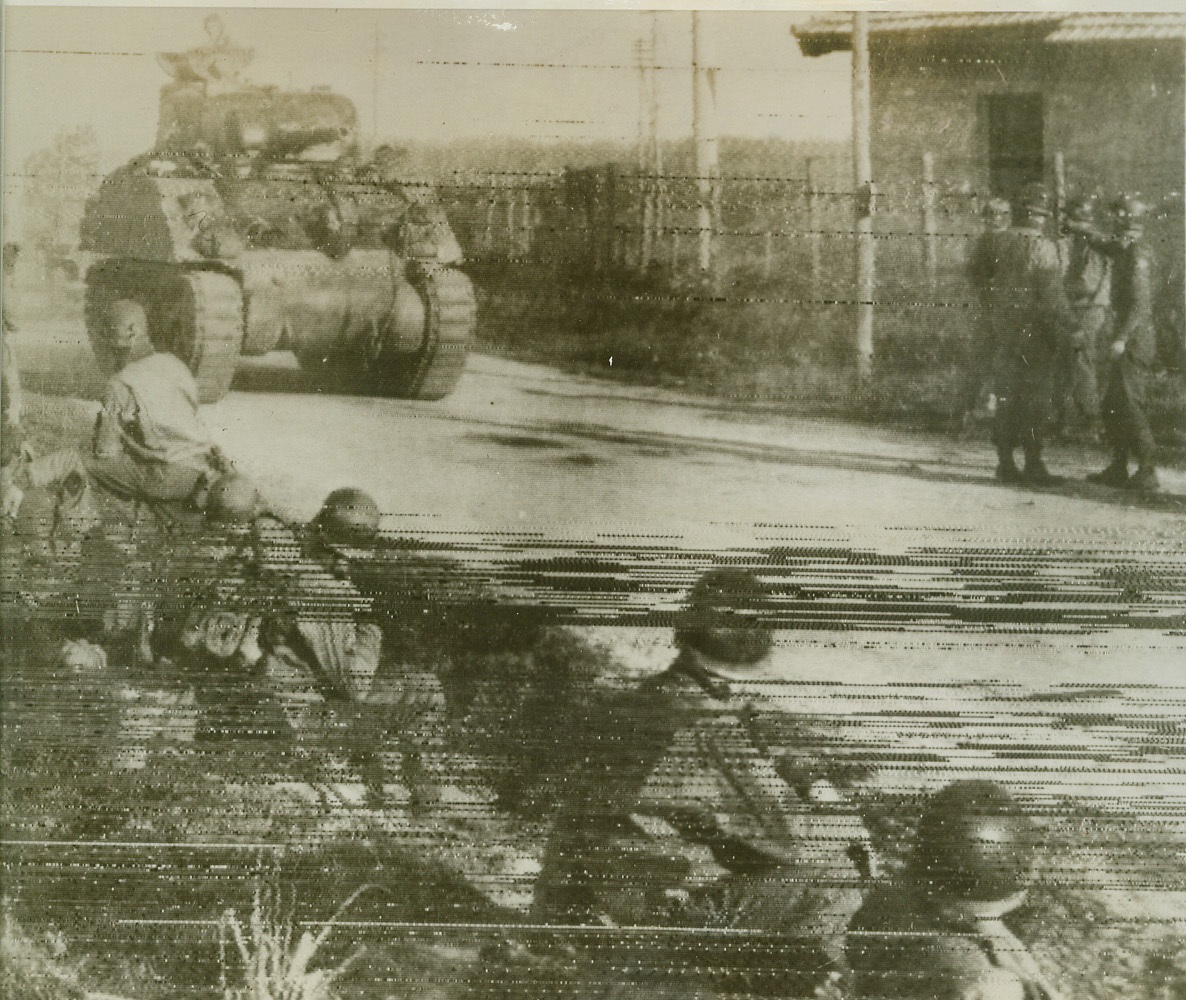
5th Army Tank Heads for Rome, 1/26/1944. Nettuno, Italy – A 5th Army tank rolls inland along the new “Road to Rome” as men, equipment and supplies pour ashore almost unopposed at Allied bridgeheads south of Rome. This photo, taken near Nettuno, was flashed to New York by radio tonight. Credit: (Stars and Stripes photo thru OWI Radiophoto from ACME);
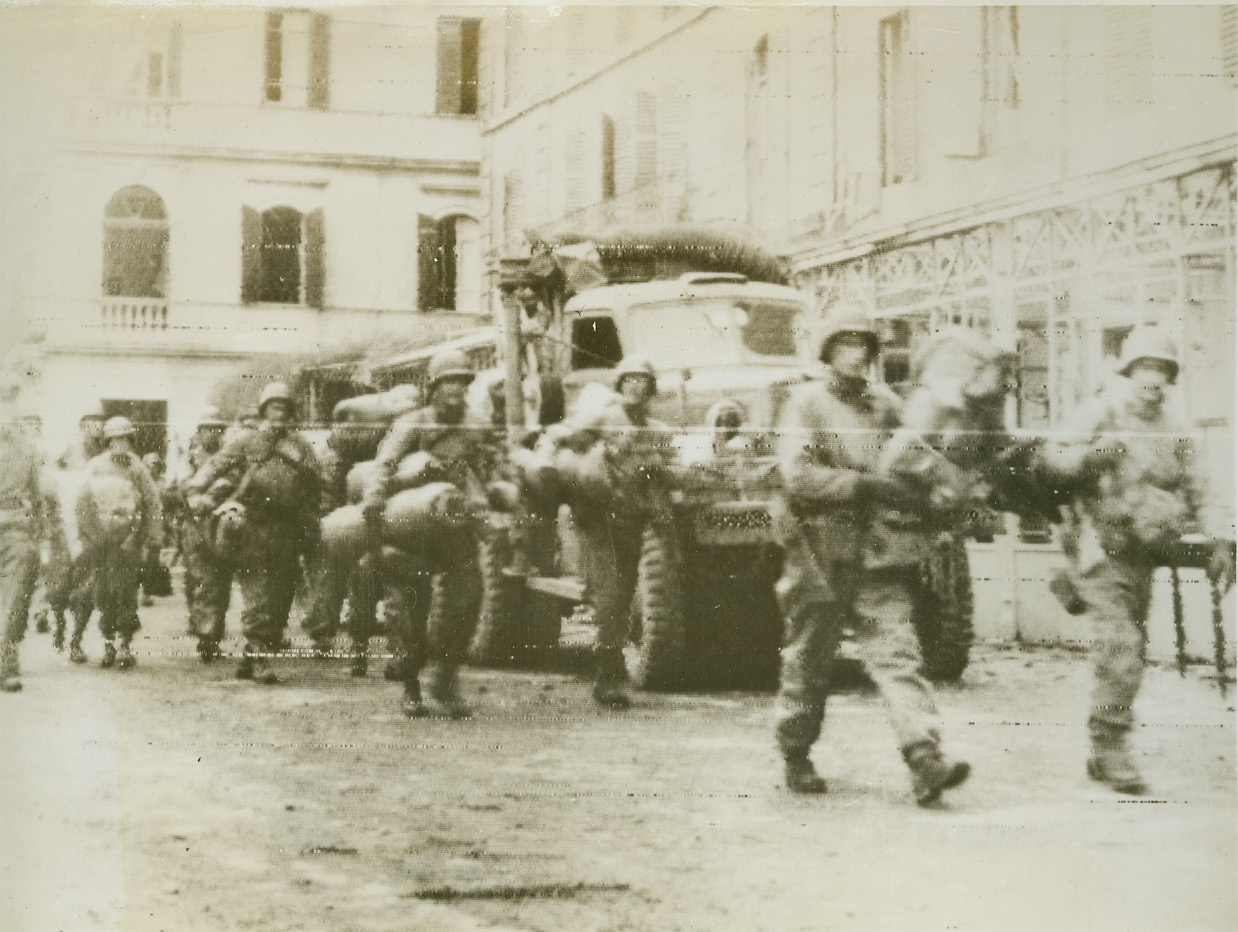
Reinforcements for March on Rome, 1/26/1944. Anzio, Italy – This photo, flashed to New York by radio tonight, shows American soldiers carrying bedrolls, as they marched through the coastal town of Anzio, to reinforce the Allied spearhead southwest of Rome. In the photo can be seen a truck bringing supplies from the newly-established beachhead south of Rome. Credit: (Stars and Stripes photo thru OWI radiophoto from ACME);
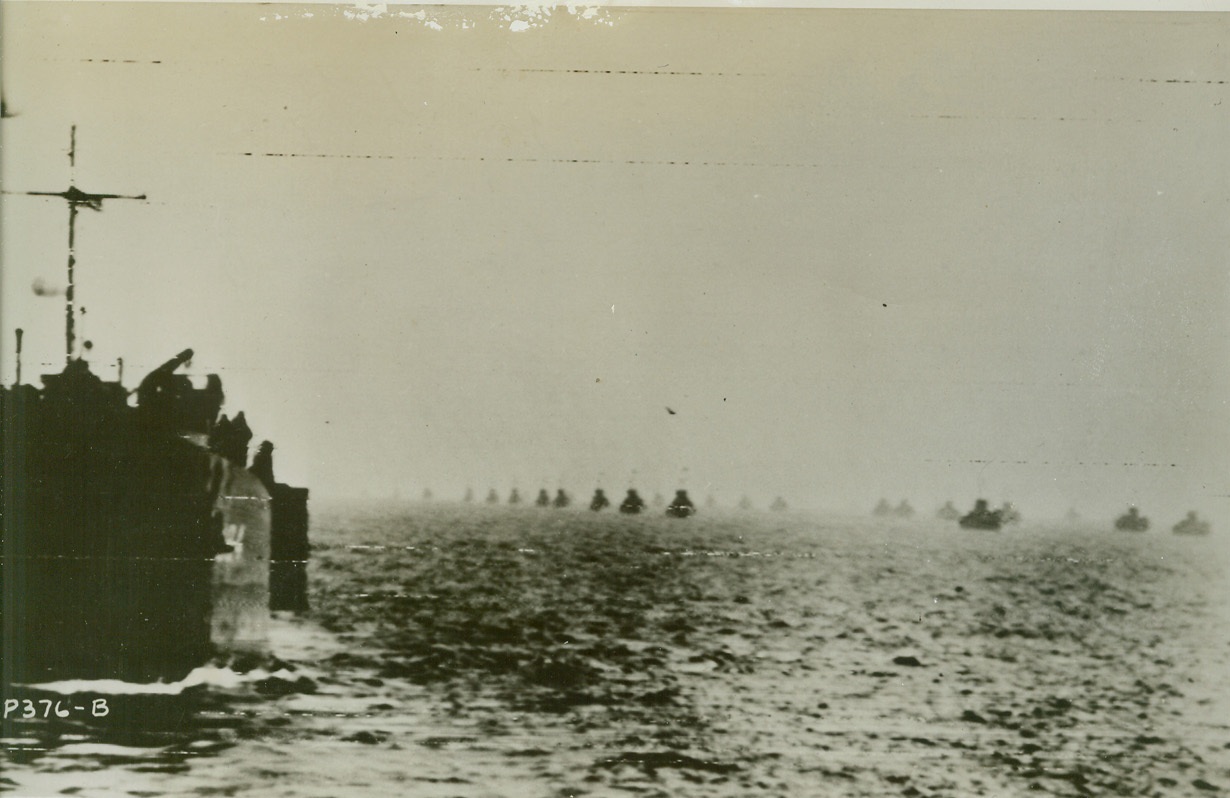
On Way to New Italian Landing, 1/26/1944. Washington, D.C.: Allied ships, transporting soldiers and their equipment, plough through the sea en route to the new landings on the west coast of Italy, south of Rome. Credit (ACME photo by Bert Brandt for War Picture Pool via Army Radiotelephoto);
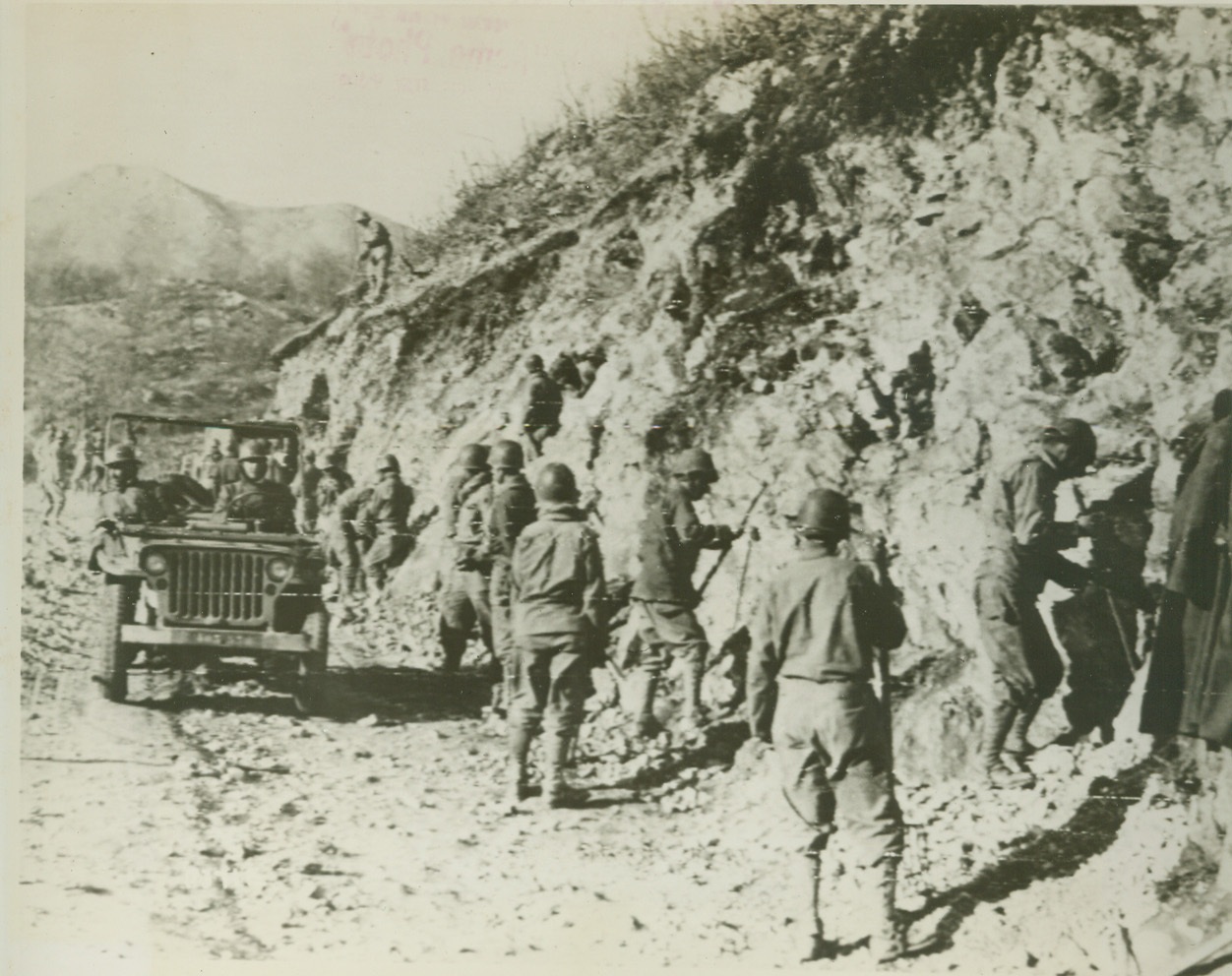
French Engineers Repair Road, 1/20/1944. Italy – French Army Engineers of the Allied 5th Army, clear dirt and debris from a road in Italy bombed by the Germans in an attempt to block the Allied advance. Today, it was announced that 5th Army troops had captured the important communications center of Minturno, North of the Garigliano River. Credit: (ACME photo via Army Radiotelephoto);
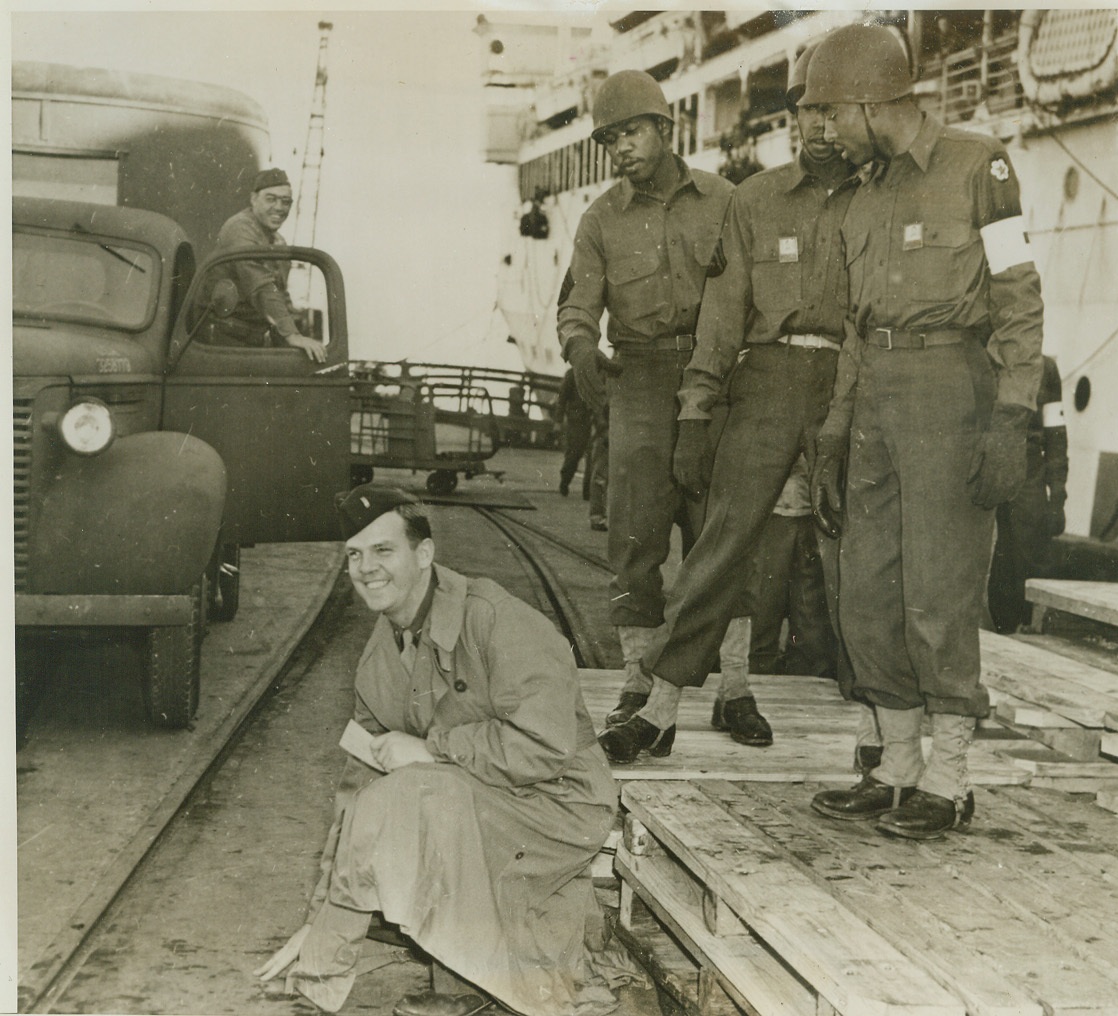
French Engineers Repair Road, 1/20/1944.Italy – French Army Engineers of the Allied 5th Army, clear dirt and debris from a road in Italy bombed by the Germans in an attempt to block the Allied advance. Today, it was announced that 5th Army troops had captured the important communications center of Minturno, North of the Garigliano River. Credit: (ACME photo via Army Radiotelephoto);
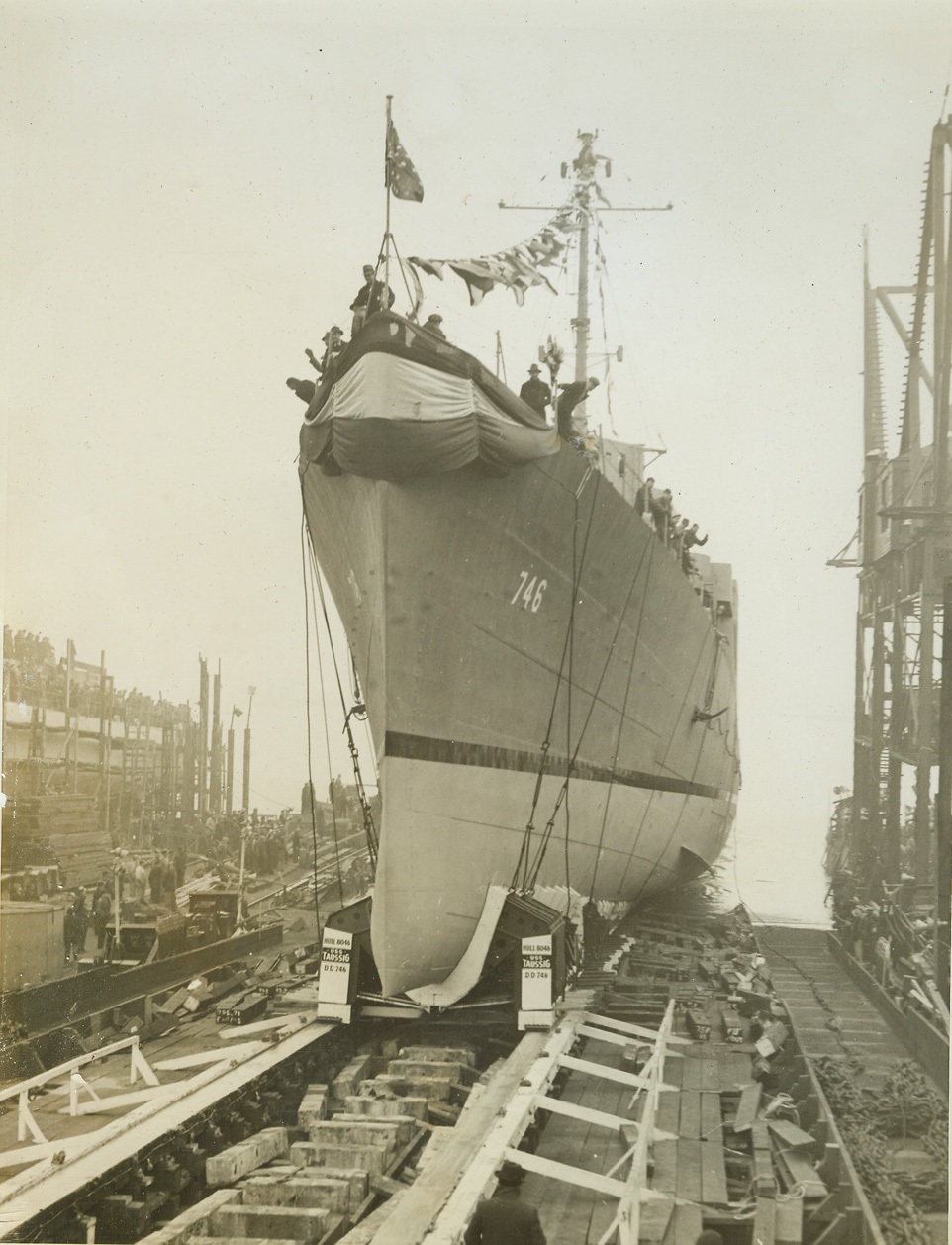
Destroyer Taussig Launched, 1/25/1944. STATEN ISLAND, N.Y. – The 2,200-ton super destroyer U.S.S. Taussig, named after the late Rear Admiral Edward David Taussig, whose heirs have also made naval history, slides down the ways at the Staten Island yard of the Bethlehem Shipbuilding Corp. With the striking power of a World War one cruiser, the U.S.S. Taussig has been designed largely for action in the Pacific as a “Jap-buster”. Credit: (ACME);
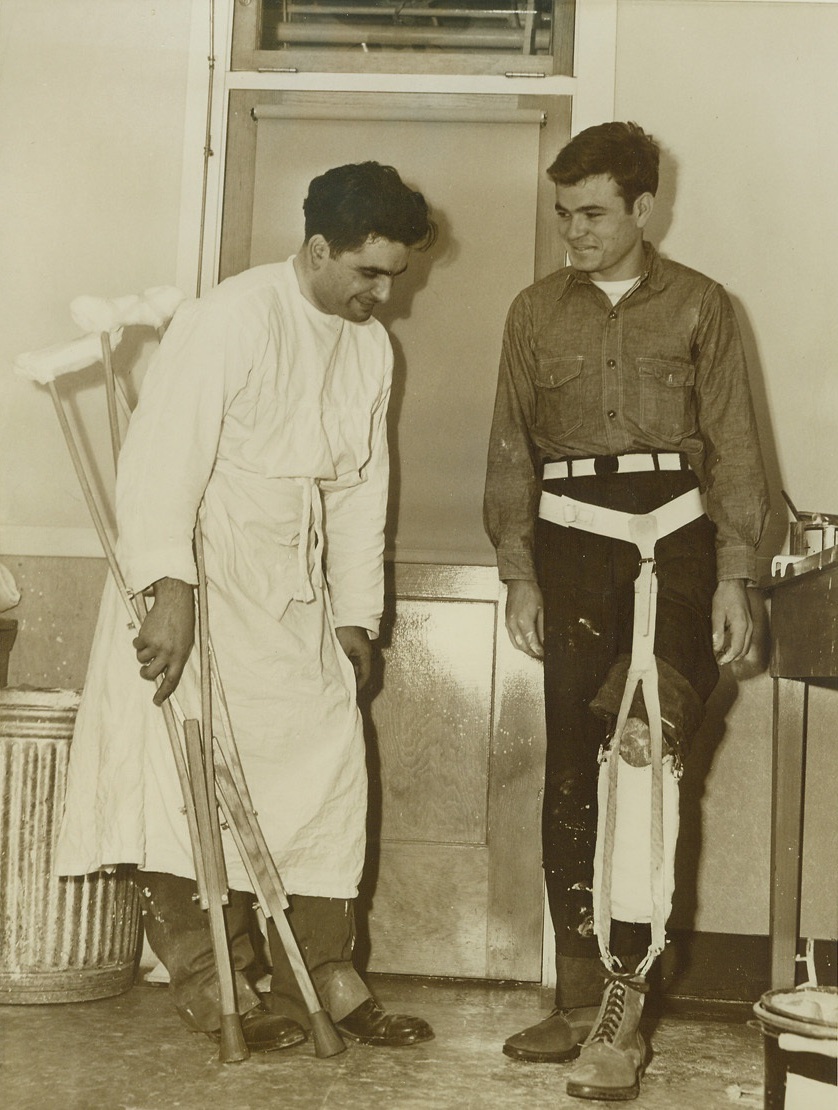
New Leg for Crippled Veteran, 1/20/1944.Mare Island, Calif. – S.C. Blankenship, ship cock 3/C of Alum Creek, Va., tries out his new, temporary artificial leg, watched by Matt Lawrence, in charge of the artificial limb department at the Mare Island, Calif., U.S. Naval Hospital. A plastic and steel limb will replace this temporary one, fitted to Blankenship barely six weeks after he lost his own leg from action on Vella Lavella. Credit: (ACME);
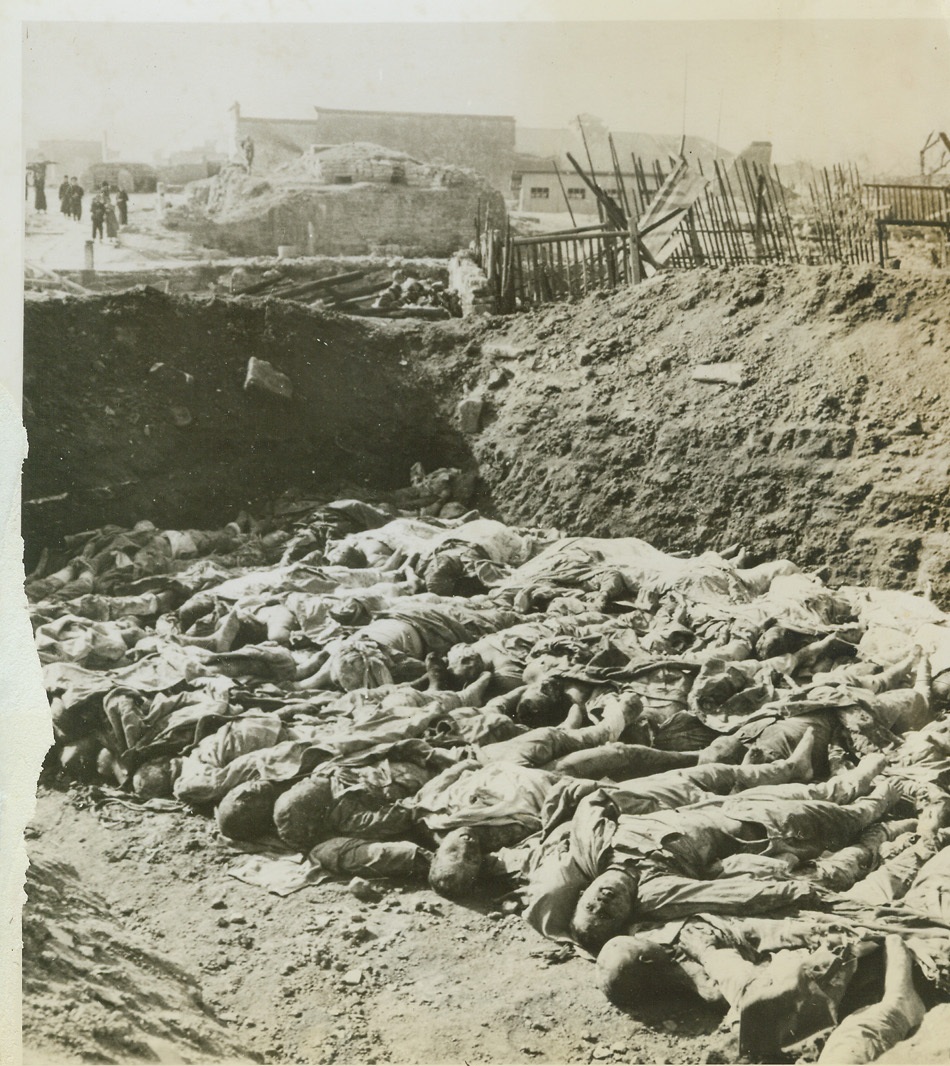
These are the Dead, 1/29/1944. Changteh, China – Chinese soldiers, in open combat, are giving their answer to Japan’s barbarity. This is a common grave for Jap soldiers, dug by the Chinese, on the battlefield at Changteh, where the sons of China routed their enemies on December 3rd. Taken by the Chinese Ministry of Information, this is one of the first photos of Changteh battle scenes to be released. Credit: (ACME);
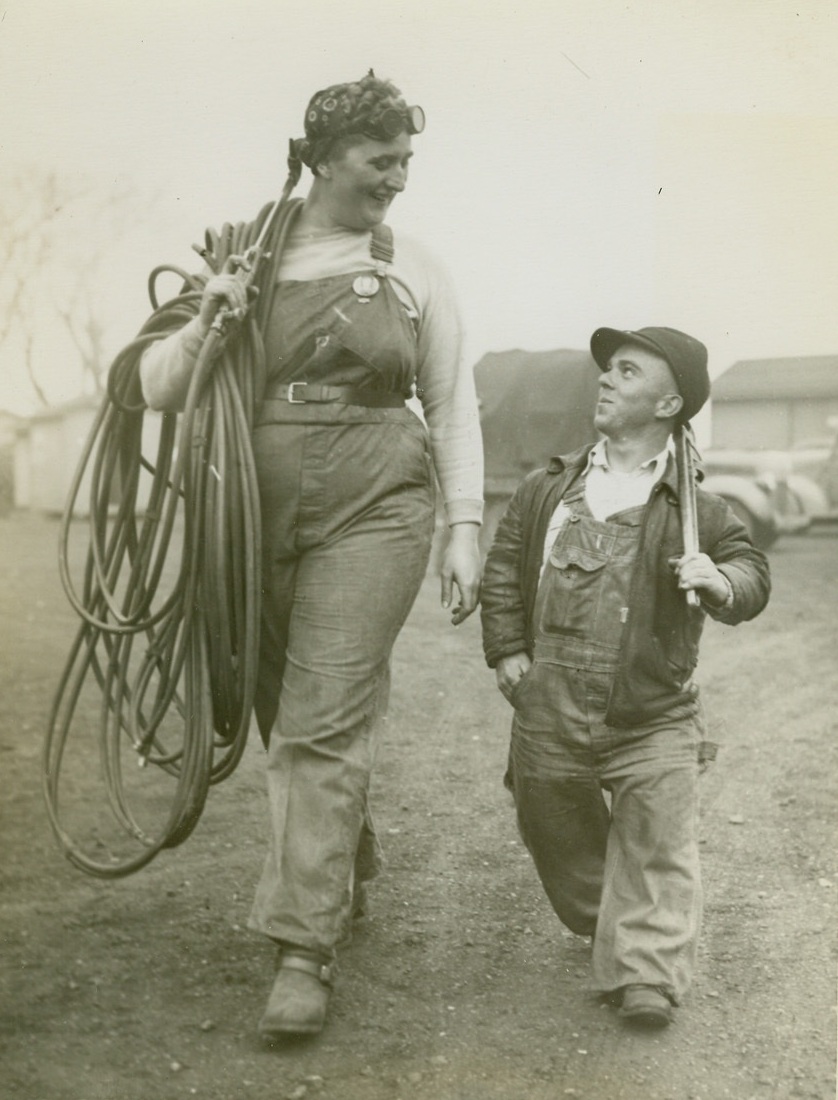
SHIPBUILDING BRINGS BOOM TO EVANSVILLE, 1/29/1944. EVANSVILLE, IND.: Built on waste land, the two year old shipbuilding plant of the Missouri Valley Bridge and Iron Company, has been credited with producing a greater tonnage of ocean-going vessels than any other inland shipyard of the world in the last year, in building the Navy’s Landing Ships for Tanks or LST, to be used on both sides of the world by invasion forces, although being built 1,000 miles from the sea. Photo shows a pair of oddly matched workers, Ruth Nunley, 6 foot, 1 inch tall and weighing 254 pounds, and Johnnie Houston, 4 foot 4 inches tall and only weighing 120 pounds. In spite of the heavy work, and the weather, a great number of women work side by side with men, welding, burning and painting. Credit: ACME;
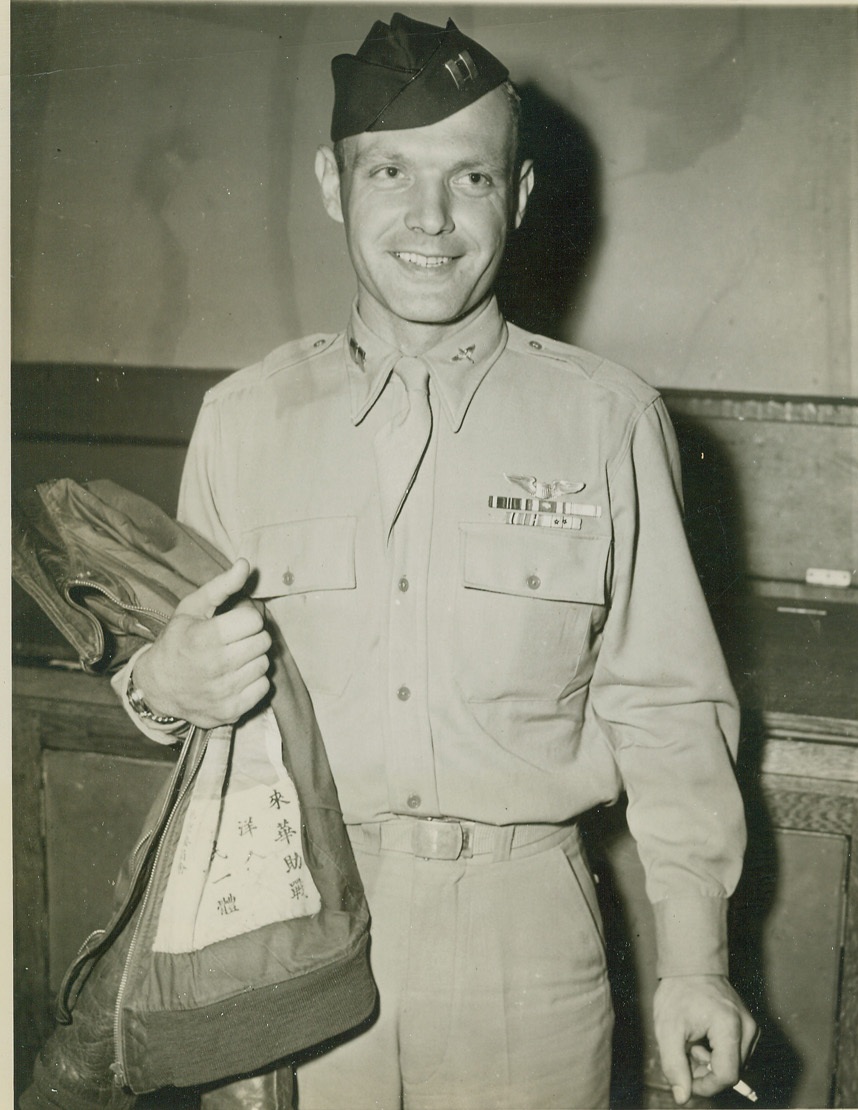
MAYBE HE’S JUST MODEST!, 1/29/1944. CHICAGO – Capt. Robert Bixby, 27, Helena, Mont., holder of the Distinguished Flying Cross and the Air Medal with Clusters, who has participated in 92 missions over India, Burma and with General Chennault’s Flying Tigers, says he hasn’t shot down any Jap planes. Moreover, the Captain grins, he hasn’t even SEEN one! Credit: ACME;
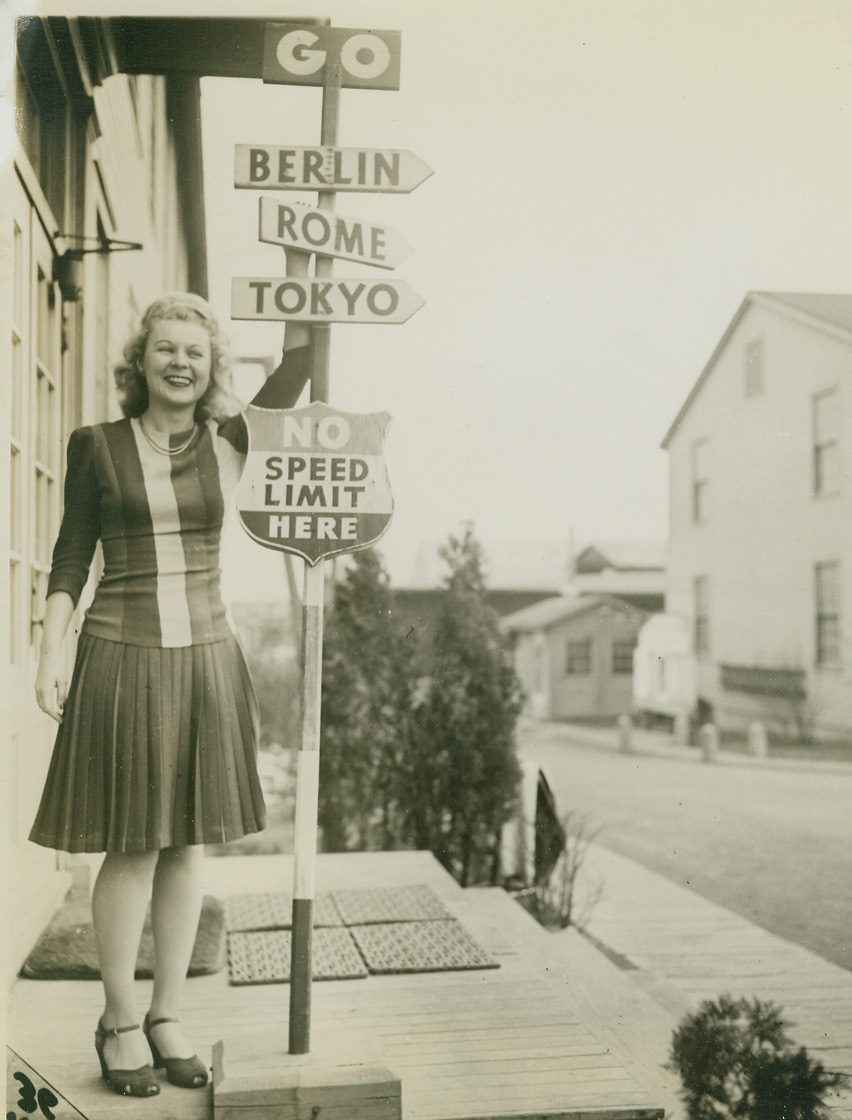
SHIPBUILDING BRINGS BOOM TO EVANSVILLE, 1/29/1944. EVANSVILLE, IND. – Built on waste land, the two year old shipbuilding plant of the Missouri Valley Bridge and Iron Company has been credited with producing a greater tonnage of ocean-going vessels than any other inland shipyard of the world last year, and the Navy has boosted its order to double last year’s quota! The company builds the Navy’s ugly-ducklings, landing ships for tanks, or LST, as they are known in the service. Photo shows Mary Hollencamp, a secretary, with sign outside the yard office reminding the workers where their product is to be used. Credit: ACME;
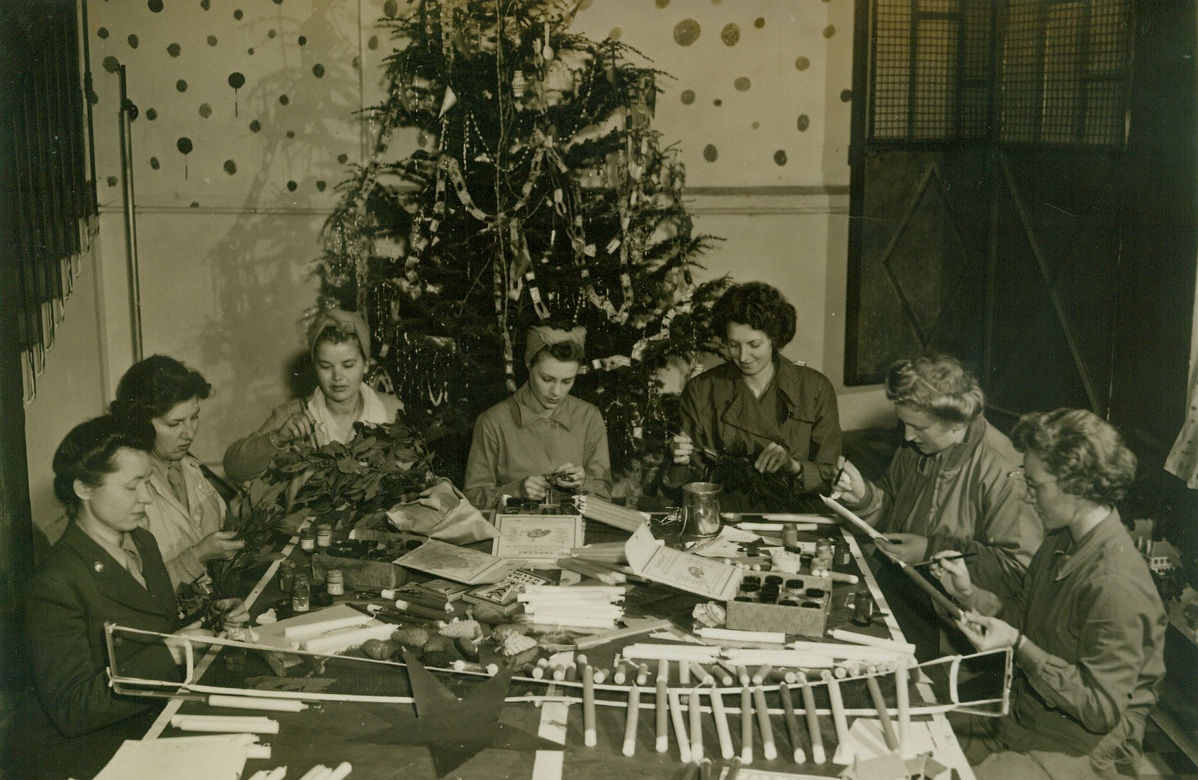
WAC Ingenuity Makes a Gala Christmas Tree, 1/4/1944. NORTH AFRICA – The nimble fingers of WACs in North Africa fashion cones, stars and paper chains, painting other ornaments in gay colors for their Christmas tree. (Left to right) Pfc. Iva Hess, of Washington, D.C.; Pvt. Marguerite Carnal, Dekalaba, Ill.; Corp. Theda McNall, Silver Spring, MD; Pfc. Mildred Ayers, Kosse, Tex.; Pfc. Ruth Ringenn, Peoria, Ill.; Lt. Sara Kruskall, Boston, Mass., and Pfc. Lucille Smith, of Milwaukee, Wisc.Credit: ACME photo by Charles Seawood, War Pool Correspondent;
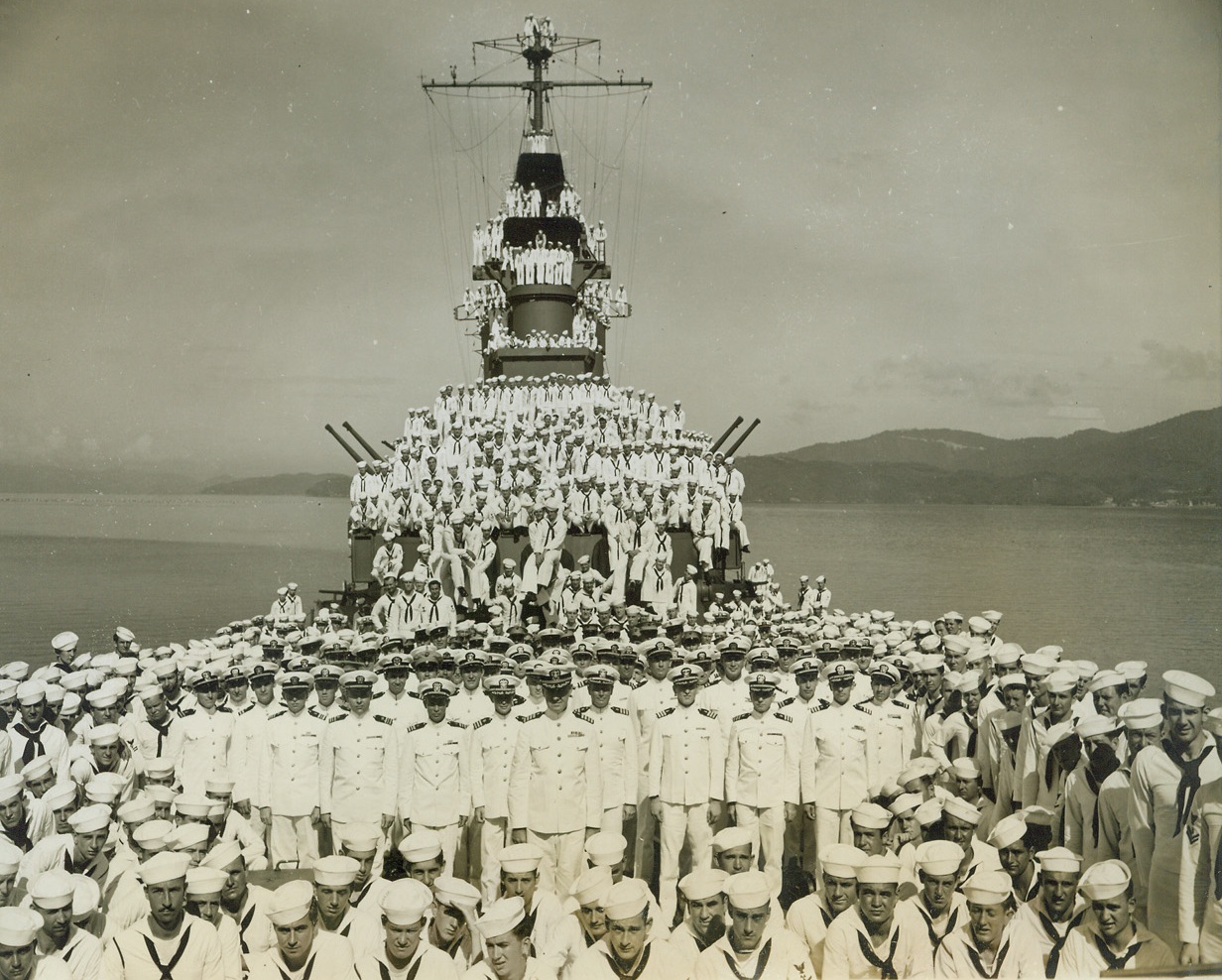
Shakedown Cruise, 1/26/1944. . AT SEA – A vital part of the training of men who fight at sea is the shakedown cruise, the run on which embryo sailors try their sea legs, get acquainted with their shipmates, and learn how to operate their ship. Here are some of the white garbed Navy men going out for their shakedown cruise. Although every inch of standing room in this section of the ship is utilized, only a portion of the vessel’s crew is shown.Credit: U.S. Navy photo from ACME;
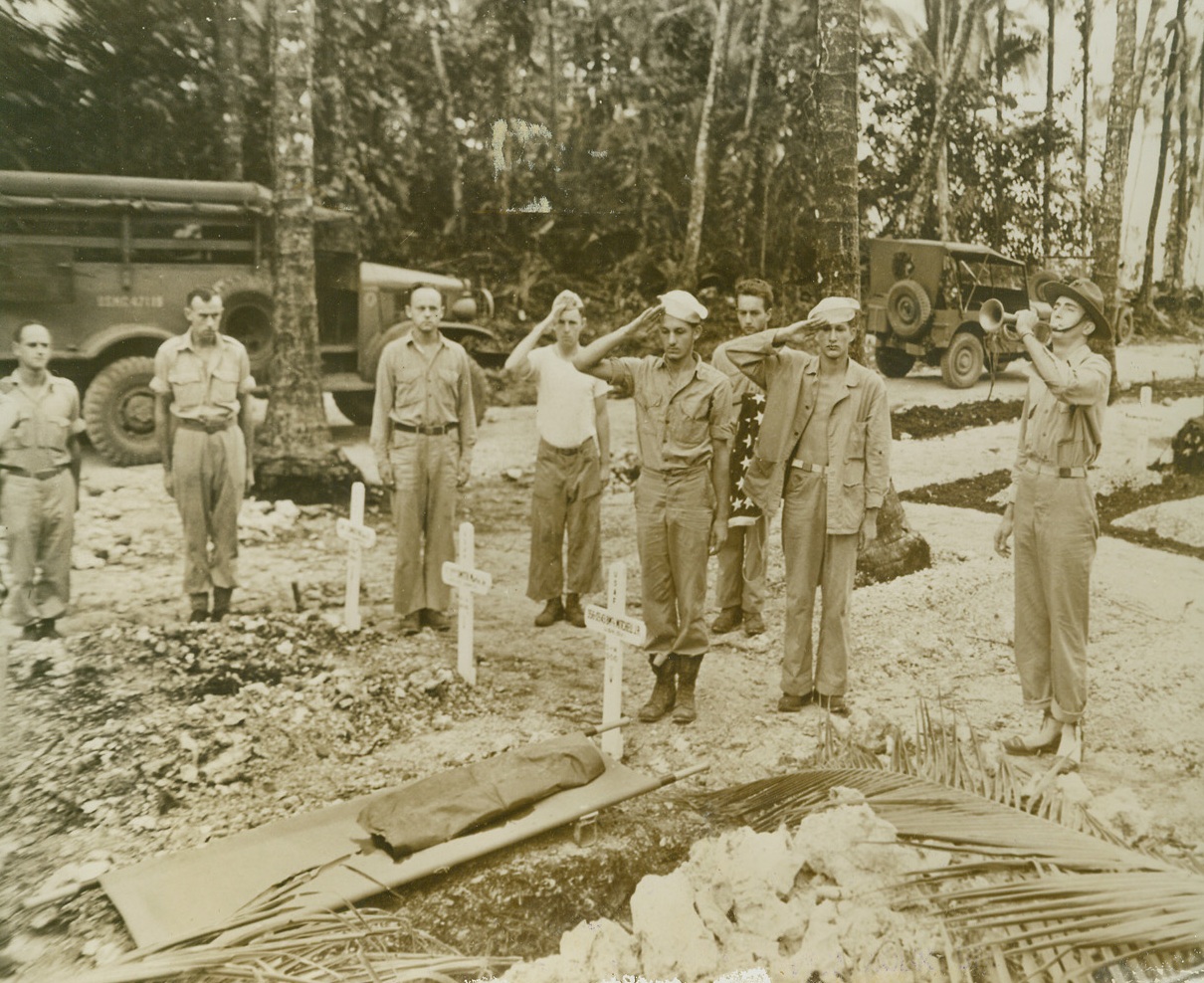
Taps Fro Good, 1/18/1944. SOLOMONS—While Taps sound for him the last time, a group of fighting men pay their respects to a fallen buddy somewhere in the Solomons. A stretcher lies over his grave and on the faces of the saluting men is written the realization that there will be no road back for him.Credit: Official US NAVY Photo from ACME;
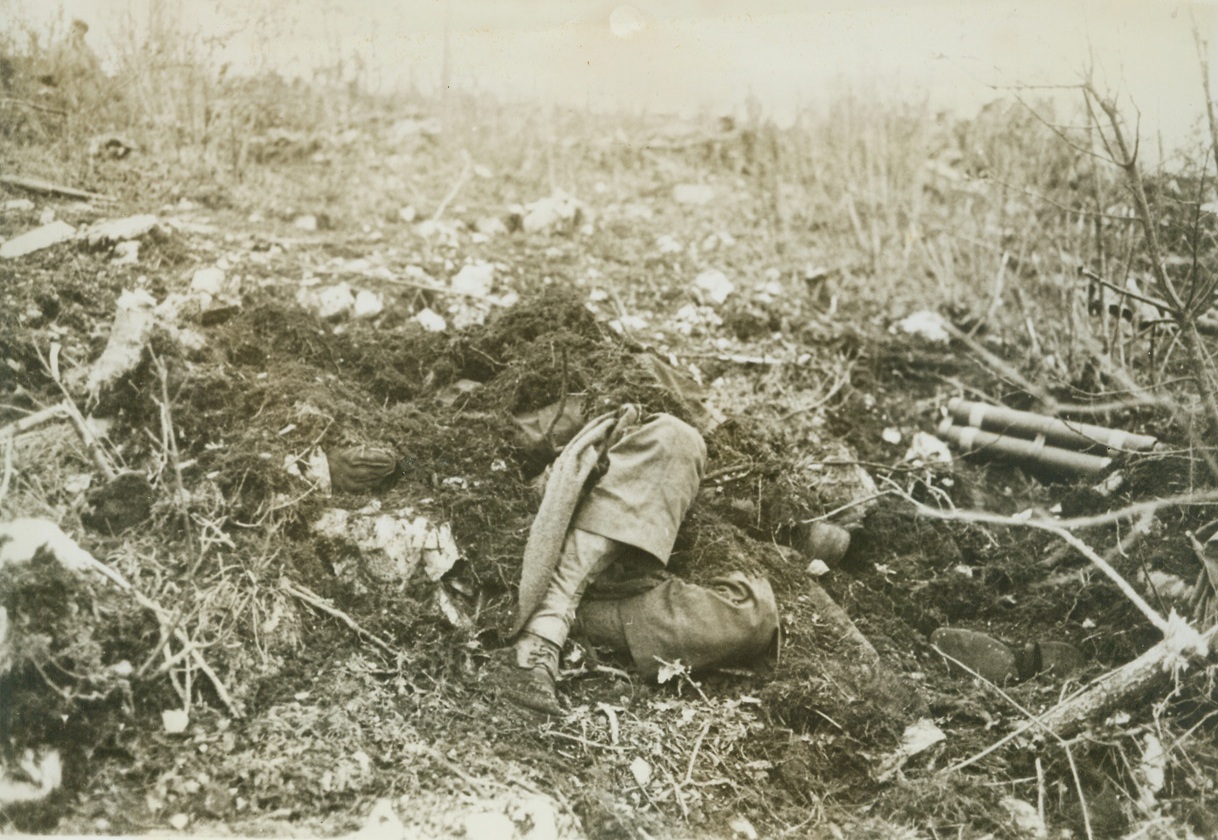
The Americans "Hold Out", 1/22/1944. Italy – Dead American Fighters are covered with brush and clothing by French relief troops who marveled that the yanks could “hold out” on the blasted mountains above the Cassino Valley. Enemy mortar fire reportedly ripped almost every square yard of the slope, and it looks as though this lost crew suffered a direct hit on their emplacement. When this photo was made a U.S. Fifth Army burial party was on the way.Credit: ACME;
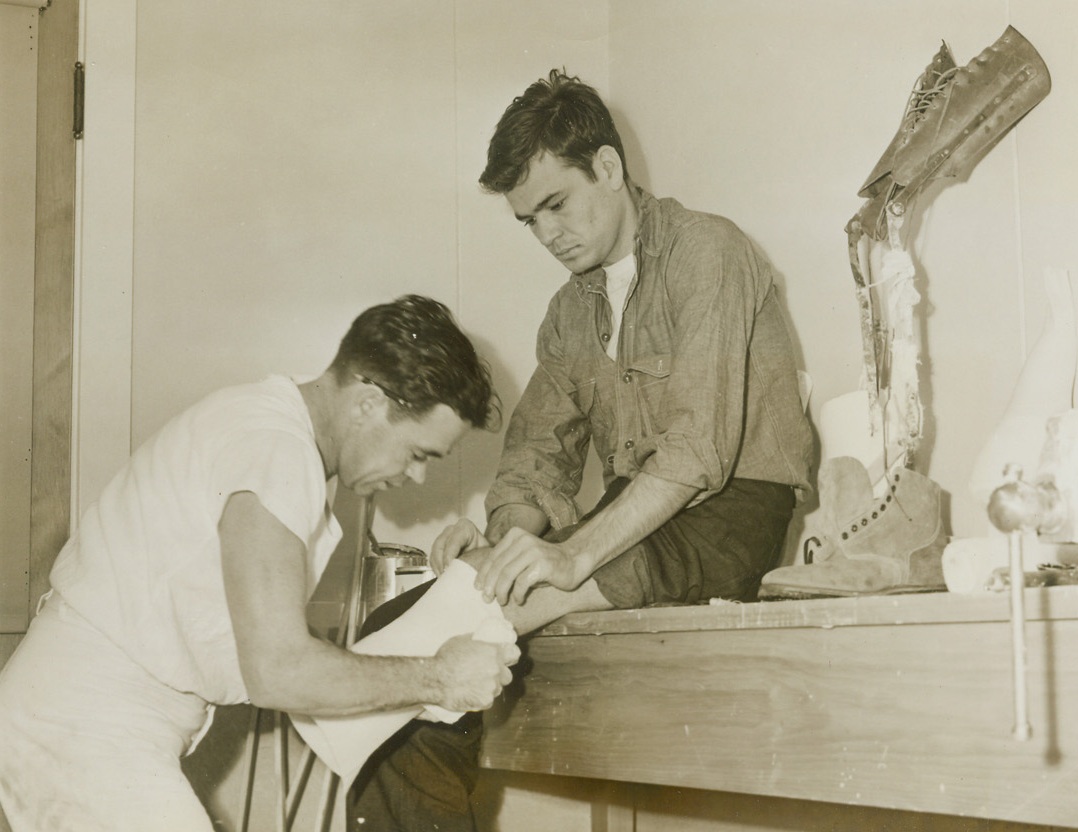
SO THE CRIPPED MAY WALK AGAIN, 1/20/1944. MARE ISLAND, CALIF.—S. C. Blankenship, ship cook 3/c of Alum Creek, W. Va., is fitted for an artificial leg by Pharmacist Mate J. J. McFado, an orthopedic technician, at the U.S. Navel Hospital, at Mare Island, Claif. The temporary leg on the shelf will enable the sailor to walk, barely six weeks after he had his leg amputated due to wounds received a Vella Lavella on December 2. Later, a plastic and steel leg will replace the temporary artificial one.Credit: Acme;
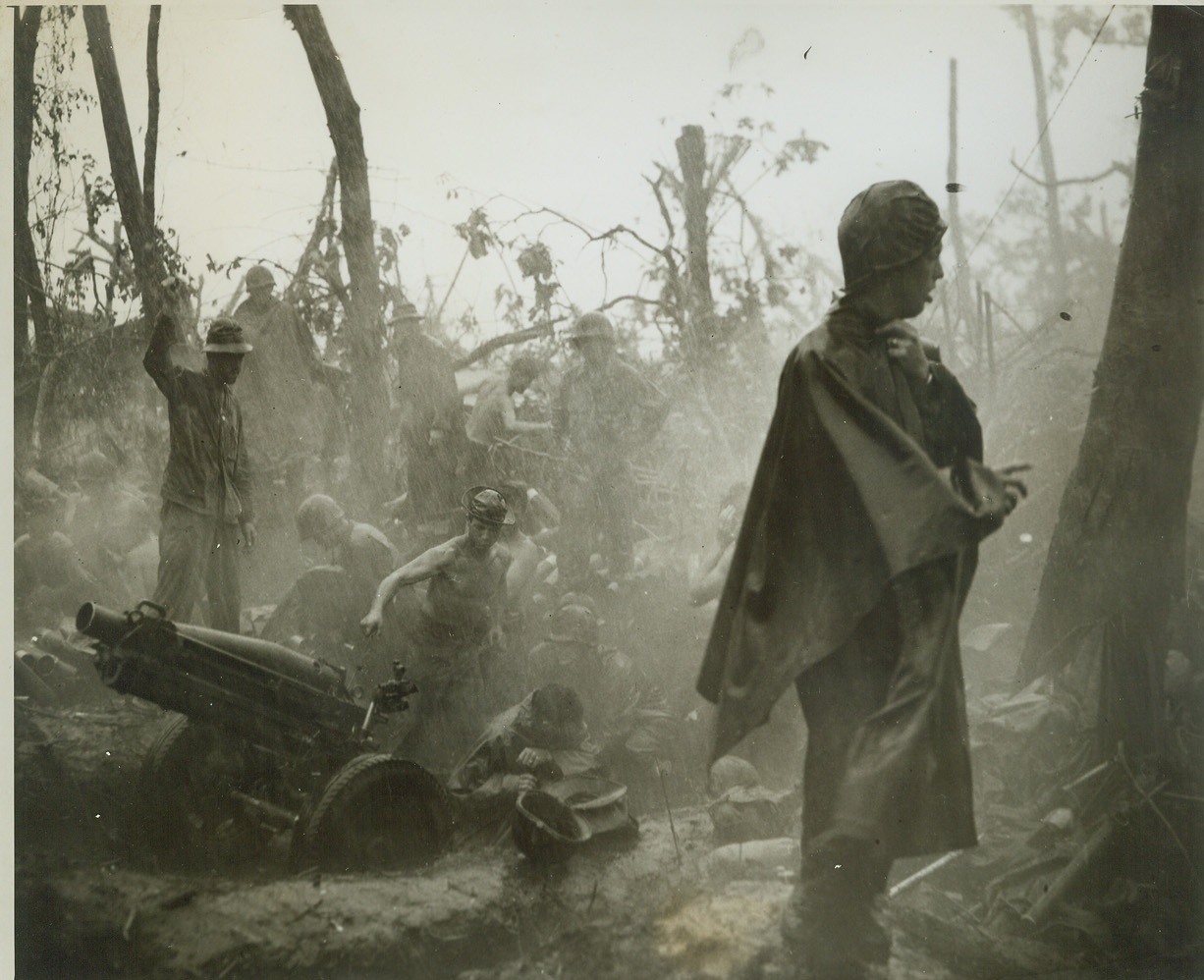
Fighting Through the Downpour, 1/18/1944. Cape Gloucester, New Britain – In spite of the tropical downpour that literally falls in sheets, drenching the fighters and their equipment, our Marines carry on in their battle for Cape Gloucester. His uniform plastered to his body, a Leatherneck gun crew member raises his hand to give the firing signal to men manning this 75mm Howitzer. Credit: -WP-(ACME Photo by Frank Prist, Jr., for the War Picture Pool);
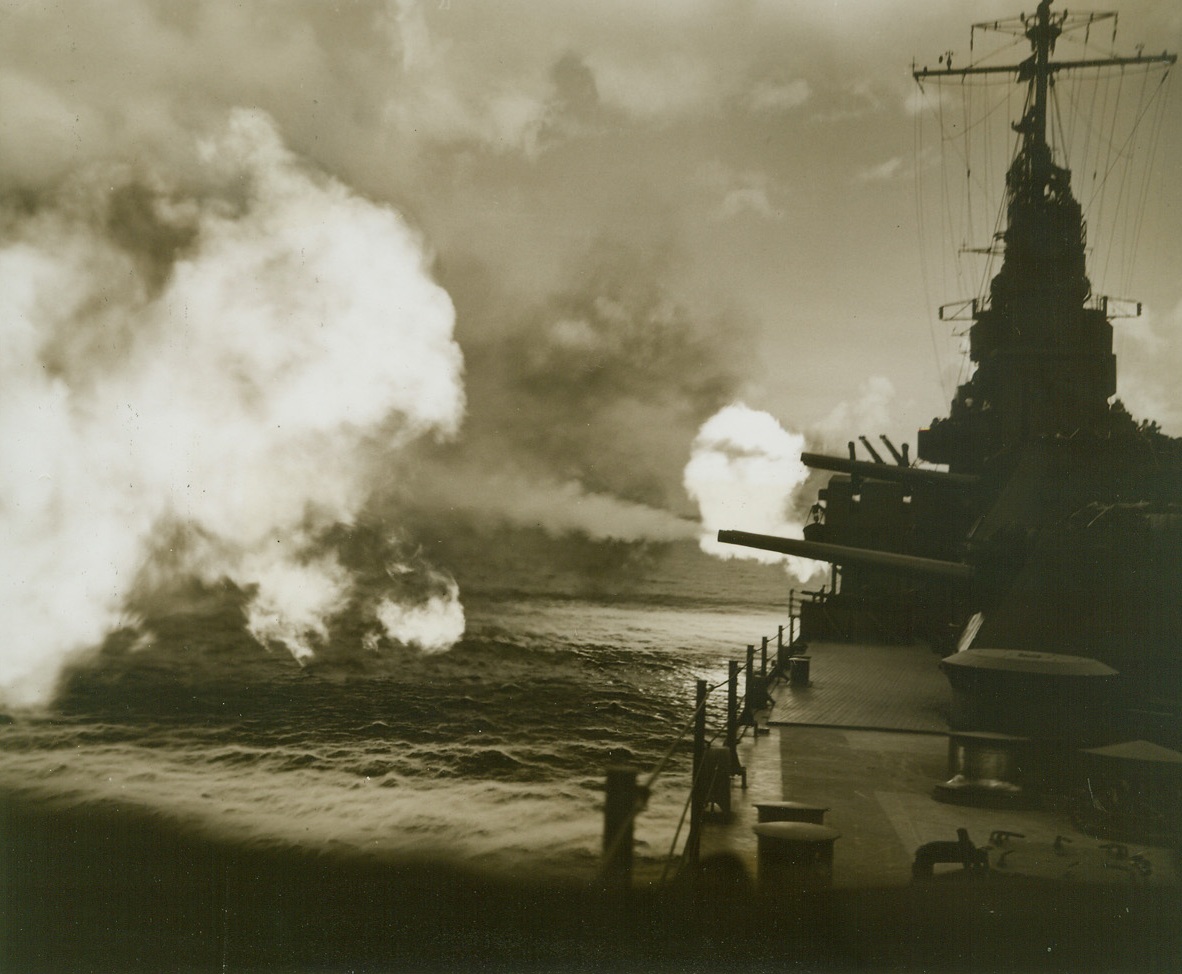
SHAKEDOWN CRUISE, 1/26/1944. AT SEA—A vital part of the training of men who fight at sea is the shakedown cruise, the run on which embryo sailors try their sea legs, get acquainted with their shipmates, and learn how to operate their ship. Here, six-inch guns blast forth in a cloud of smoke and flame, manned by Navy fighters making their shakedown cruise.Credit: Official U.S. Navy photo from Acme;

DANES SABOTAGE NAZI MACHINE SHOP, 1/20/1944. COPENHAGEN – Rebellious Danish workers slipped one over on their Nazi factory guards, and blasted out a large section of the Pindstoftes Machine Shop in Copenhagen. The three upper stories appear to be blasted out, in this photo passed by German censorship. Credit (ACME Radiophoto);
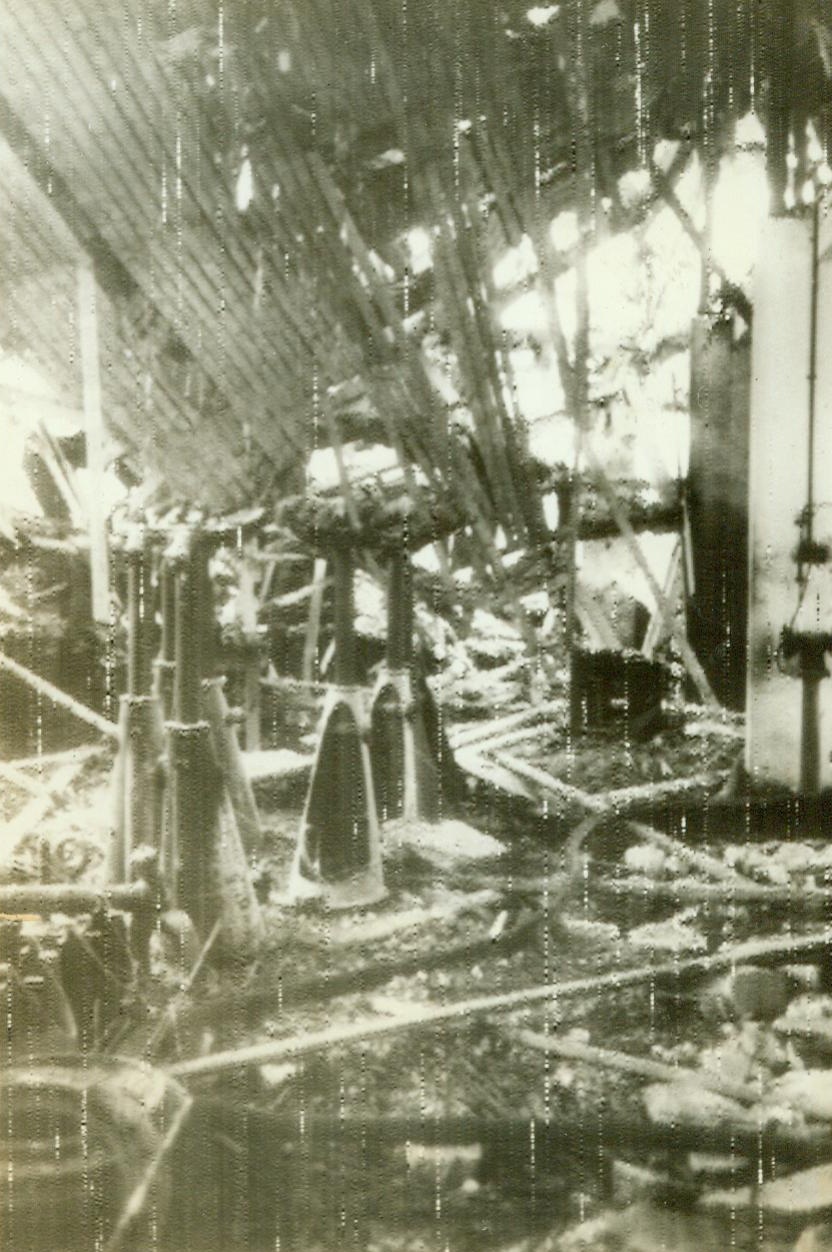
DANISH ANSWER TO NAZI RULE, 1/20/1944. COPENHAGEN – In an open rebellion against the Nazis, the Danes turned the inside of the Johannesen and Lund Machine Company, in Copenhagen, into shambles. German censorship permitted this photo of the destroyed war plant. Credit (ACME Radiophoto);
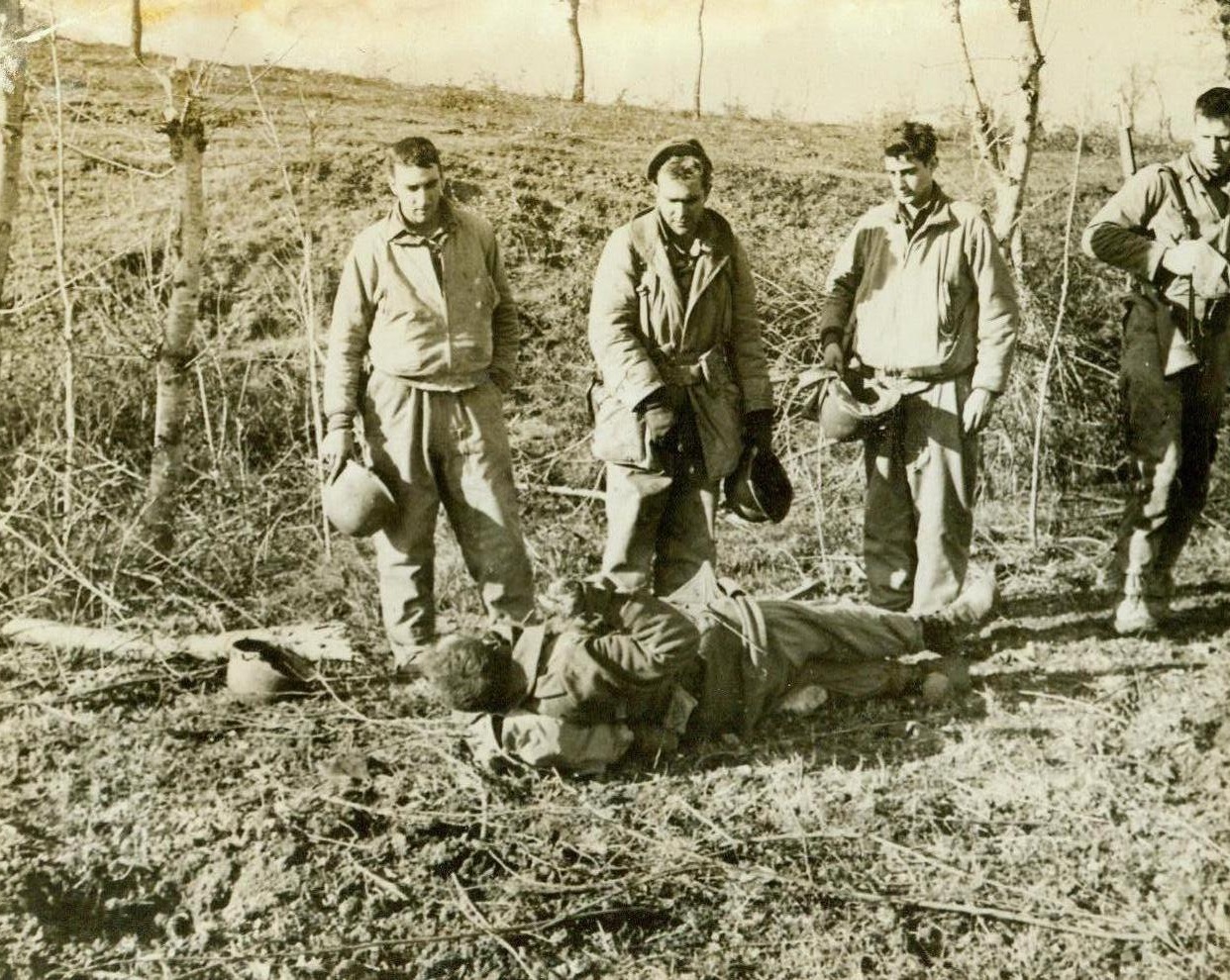
DEATH STRIKES THEIR BUDDY, 1/19/1944. ITALY – Fellow American soldiers doff their helmets before the dead body of an American engineer who was killed while removing a land mine. Note the hole in left foreground. He had been clearing a path through a mine field so that others could advance in safety. It exploded while he was working on it. Credit Line (ACME);
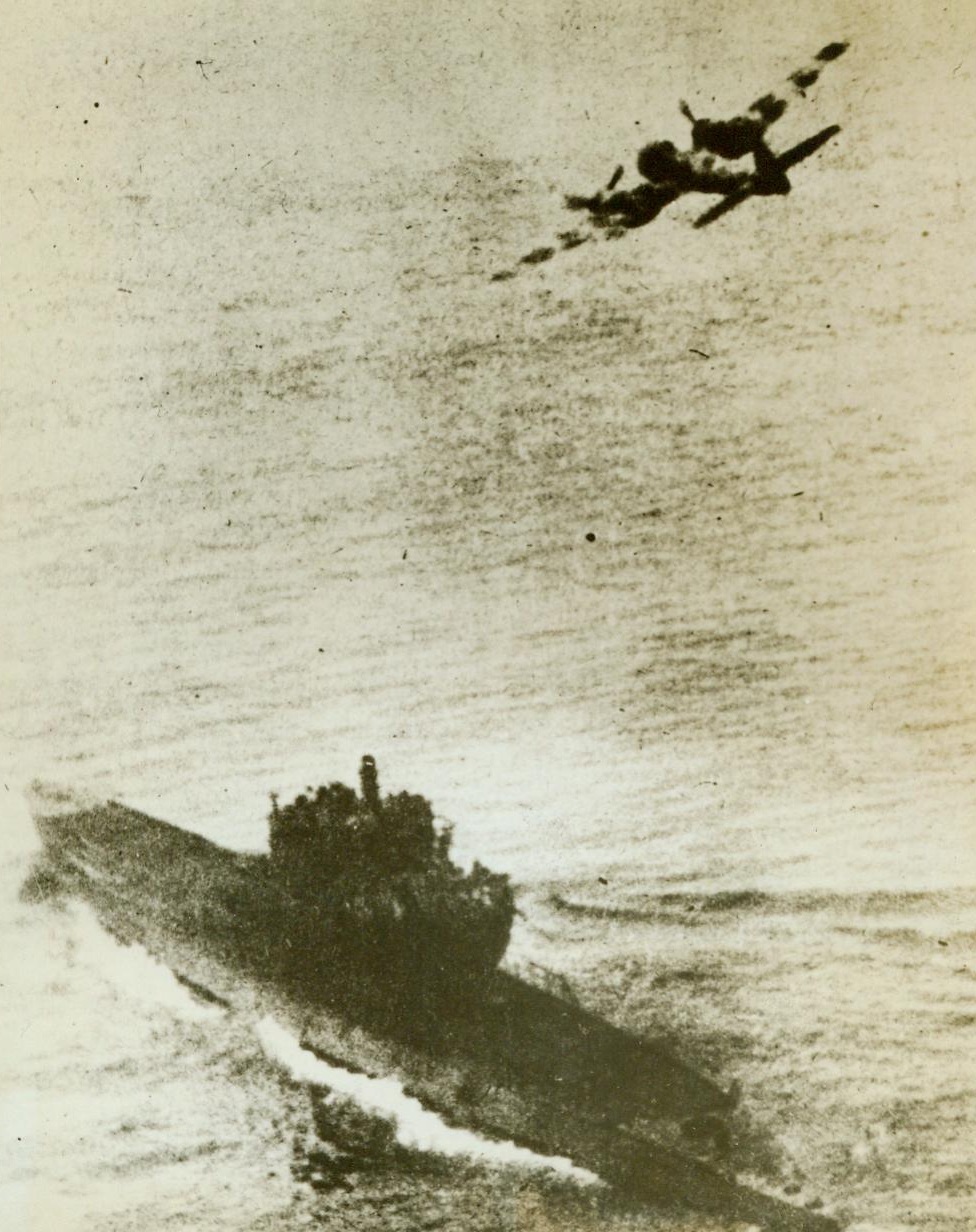
NAZI SEA RAIDERS RENDEZVOUS, 1/20/1944. A German long-range reconnaissance plane and a Nazi U-boat both on patrol raiding Allied shipping lanes, meet “somewhere in the Atlantic” in this photo just received from a neutral source. Credit Line (ACME);
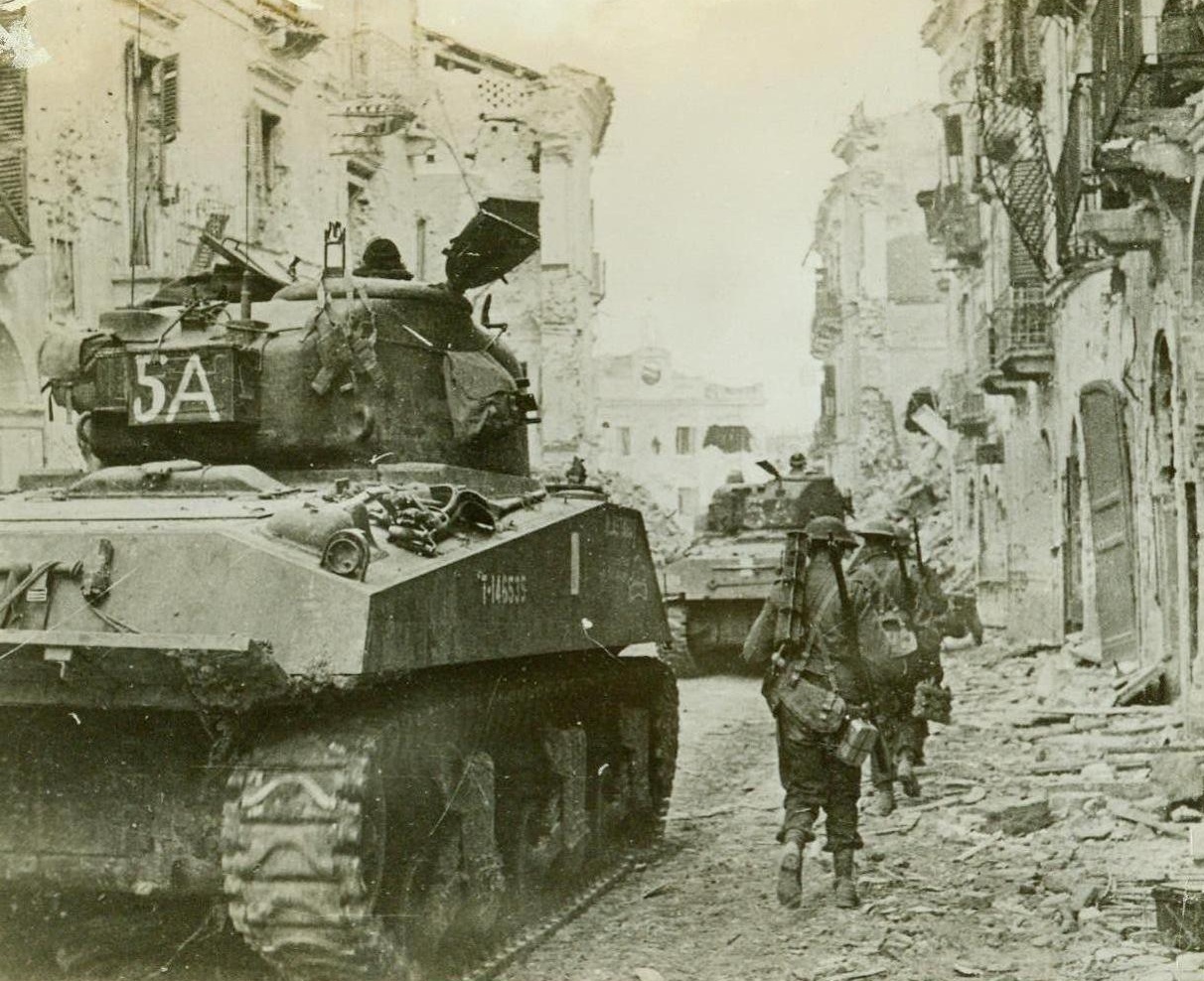
CANADIANS FINISH OFF NAZIS IN ORTONA, 1/20/1944. ORTONA, ITALY – Canadian tanks and infantrymen advance through the battered streets of Ortona, Italy, for the last phase of five days of bitter street fighting to wrest the Adriatic coastal town from German control. Dead Nazis, which littered the streets, were identified as belonging to enemy paratroop regiments. Credit Line (ACME);
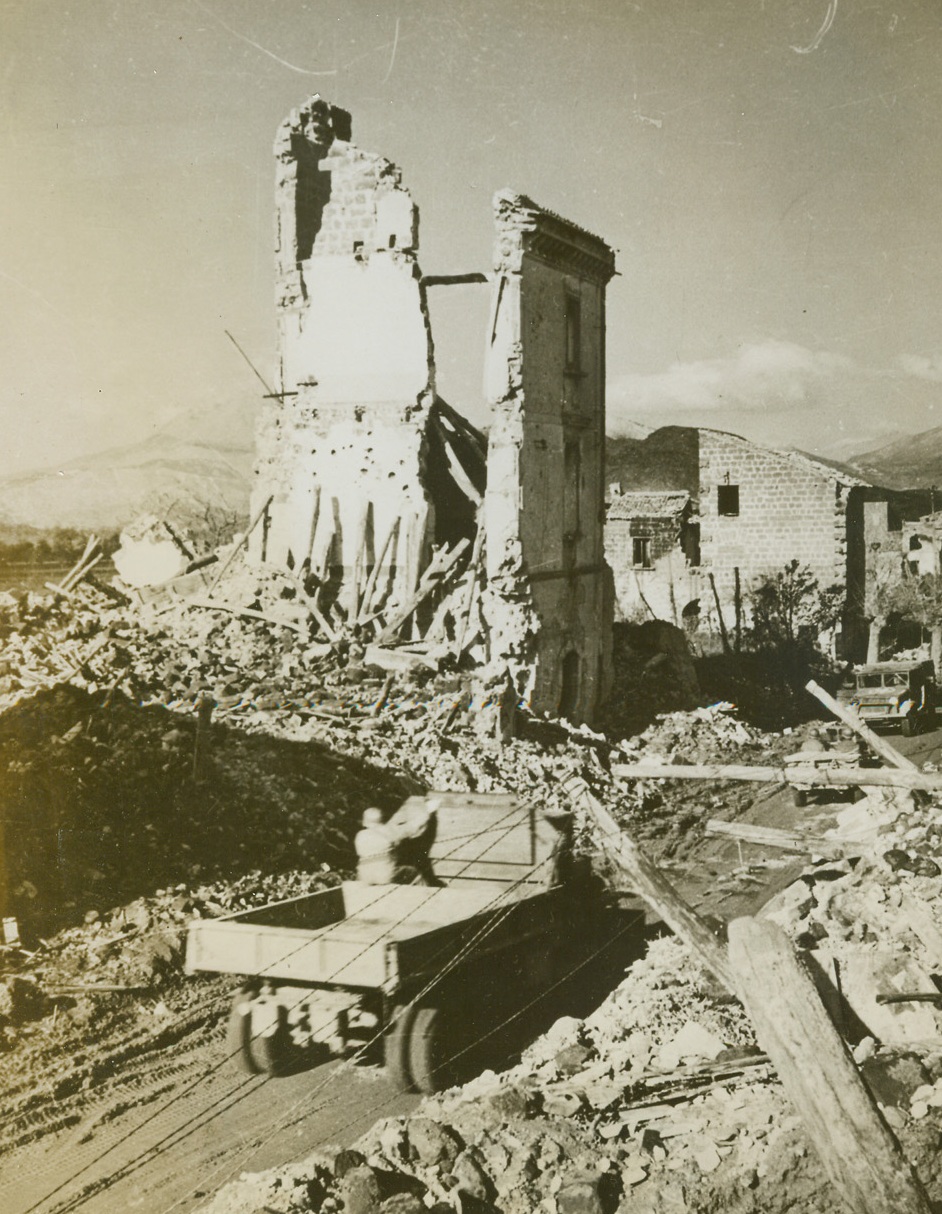
WAR HITS MIGNANO, 1/20/1944. ITALY—American units push their way forward over a blocked, devastated road in Mignano, Italy, now a mere remnant of a village on the way to Cassino. From the vantage point of the mountains in the background, the enemy keeps watch on our moves, and make fierce, brief counterattacks. Credit: Acme;
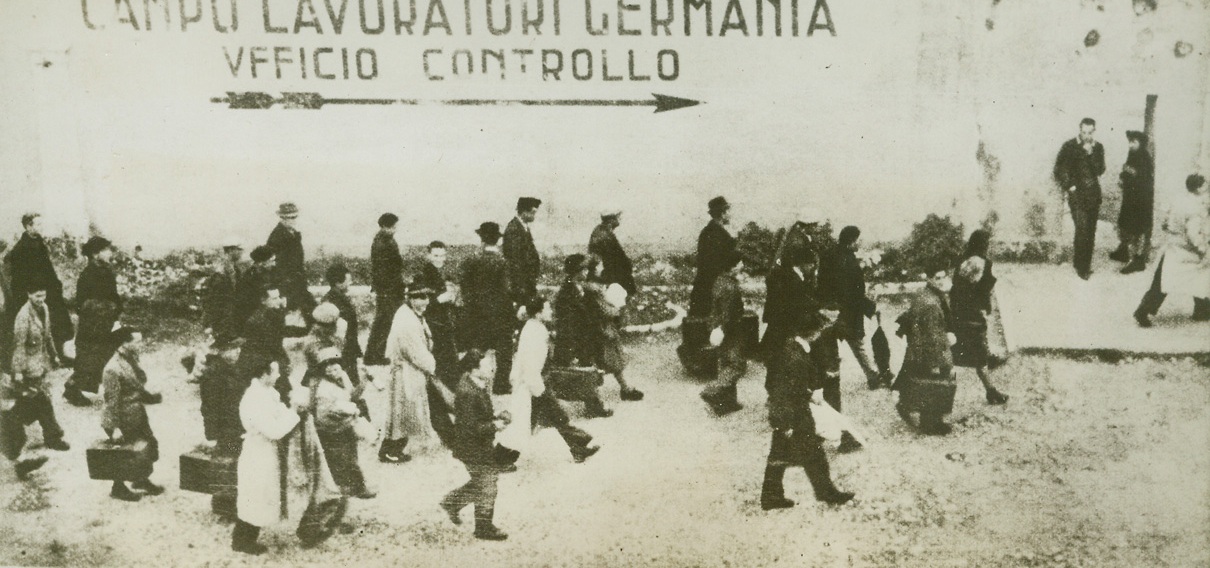
SLAVE LABOR FOR REICH, 1/20/1944. One of the first acts of the Germans after they had taken over in Northern Italy, was to collect thousands of able-bodied male and female Italians and to send them to the Reich to work in Nazi war plants. In this photo, received in New York from a neutral source today, a group of Italians setting out for German labor camps. Credit: Acme;
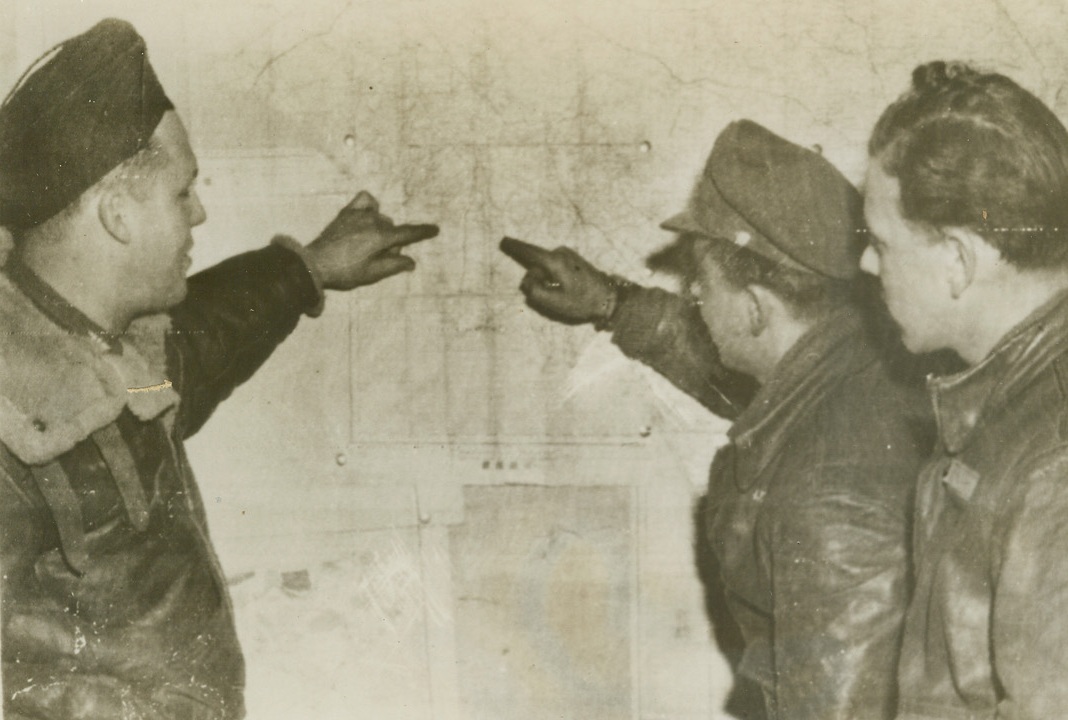
YANKS REPORT, 1/22/1944. WITH THE FIFTH ARMY IN ITALY—Just back from their dive-bombing mission in support of the new Allied thrust behind German lines south of Rome, two Yank airmen report to Col. D. E. Newton (left). The American airmen are: Lt. Frank David (center) and Lt. Fred Dorsch. Credit: U.S. Signal Corps photo via OWI from Acme;
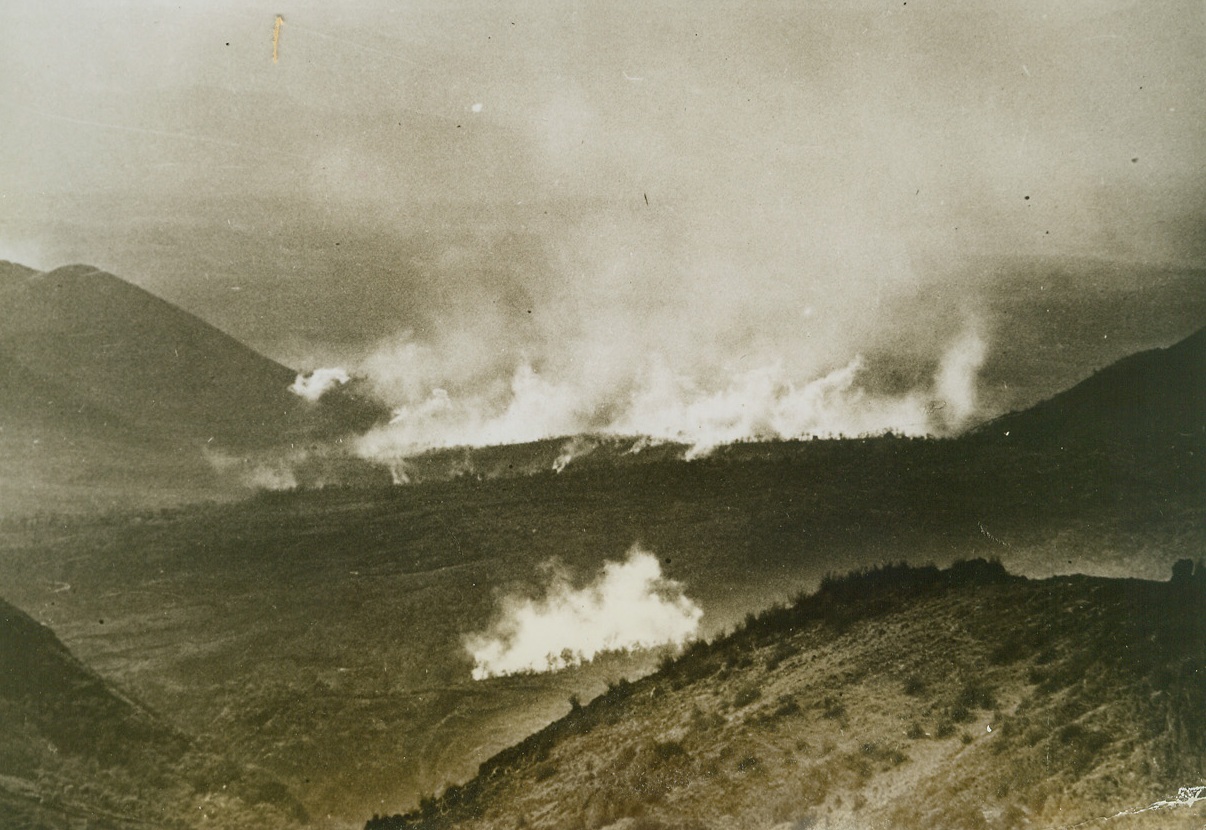
WAR-FILLED VALLEY, 1/22/1944. ITALY—German and Allied shellbursts fill the Ori Valley with smoke and deafening sound, as the Fifth Army battles toward Cassino. American dive-bombers added their explosives, at intervals, as we fought to wrest the territory from the Nazis. Credit: Acme;
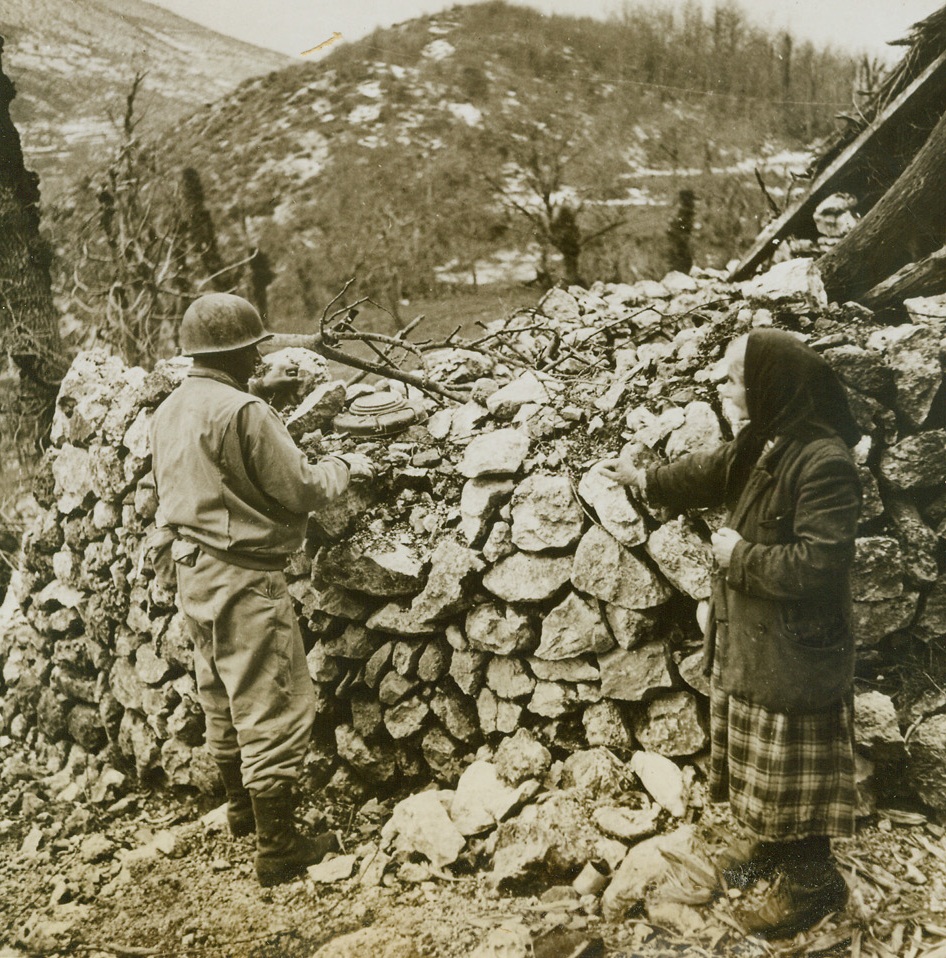
OLD ITALIAN WOMAN IS A VOLUNTEER SPY, 1/22/1944. ITALY—A wily old Italian woman who watched carefully as retreating Germans laid their mines in the village of Radicose, discloses the location of the deadly hidden weapons to Allied soldiers. Here, she point sout a mine carefully concealed in rocks. Credit: Acme;
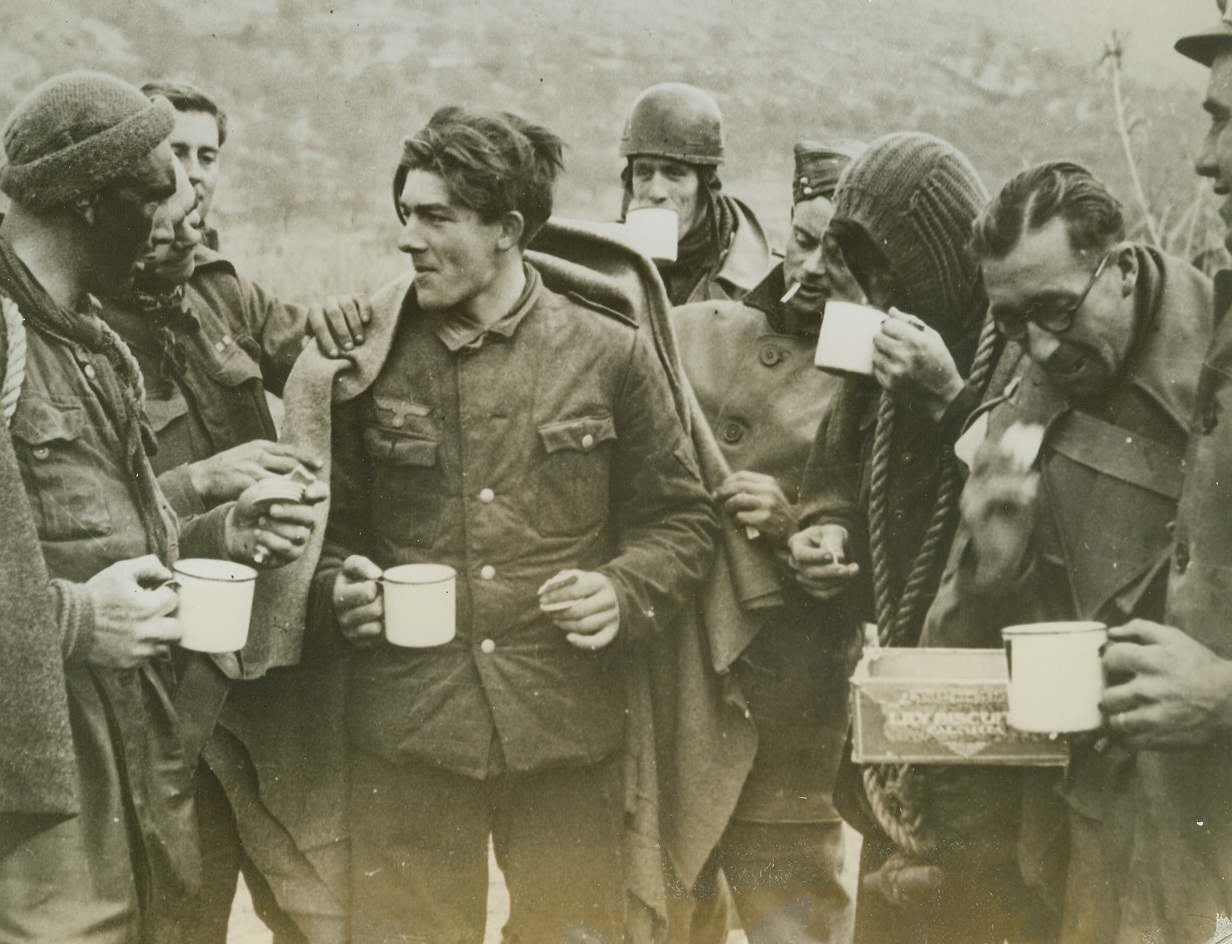
DRESS RHEARSAL FOR “ROME” INVASION, 1/22/1944. ITALY—After a surprise amphibious assault on German positions in Italy, black-faced Commandos share tea and biscuits with a German prisoner they brought back from the raid which was probably a test-rehearsal for the new Allied invasion behind enemy lines below Rome. British Commandos, Rangers, and Fifth Army troops are taking part in the present major assault to break enemy winter lines. Credit: Acme;
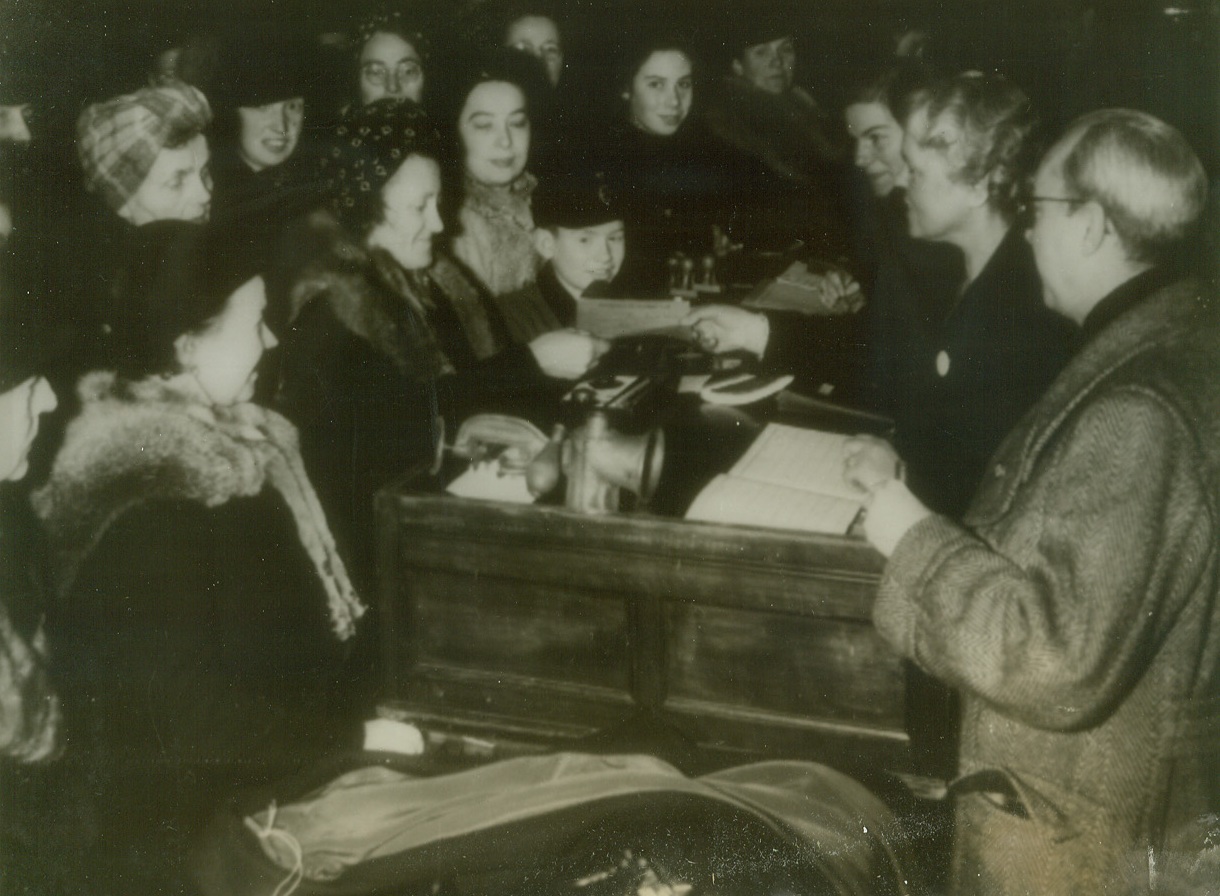
BERLIN HOUSEWIVES DO THEIR MORNING BARTERING, 1/22/1944. BERLIN—Striving to look cheerful for the photographer, Berlin housewives obtain estimates on the value of the articles they wish to barter, at one of the German capital’s 23 “exchange” centers. A meat grinder, coat, and shoes are seen among the possessions these bombed-out women wish to trade for articles they lack. The Nazis established the system to help out Berliners who have lost virtually everything from Allied bombings. (Photo radioed from neutral source.) Credit: Acme radiophoto;
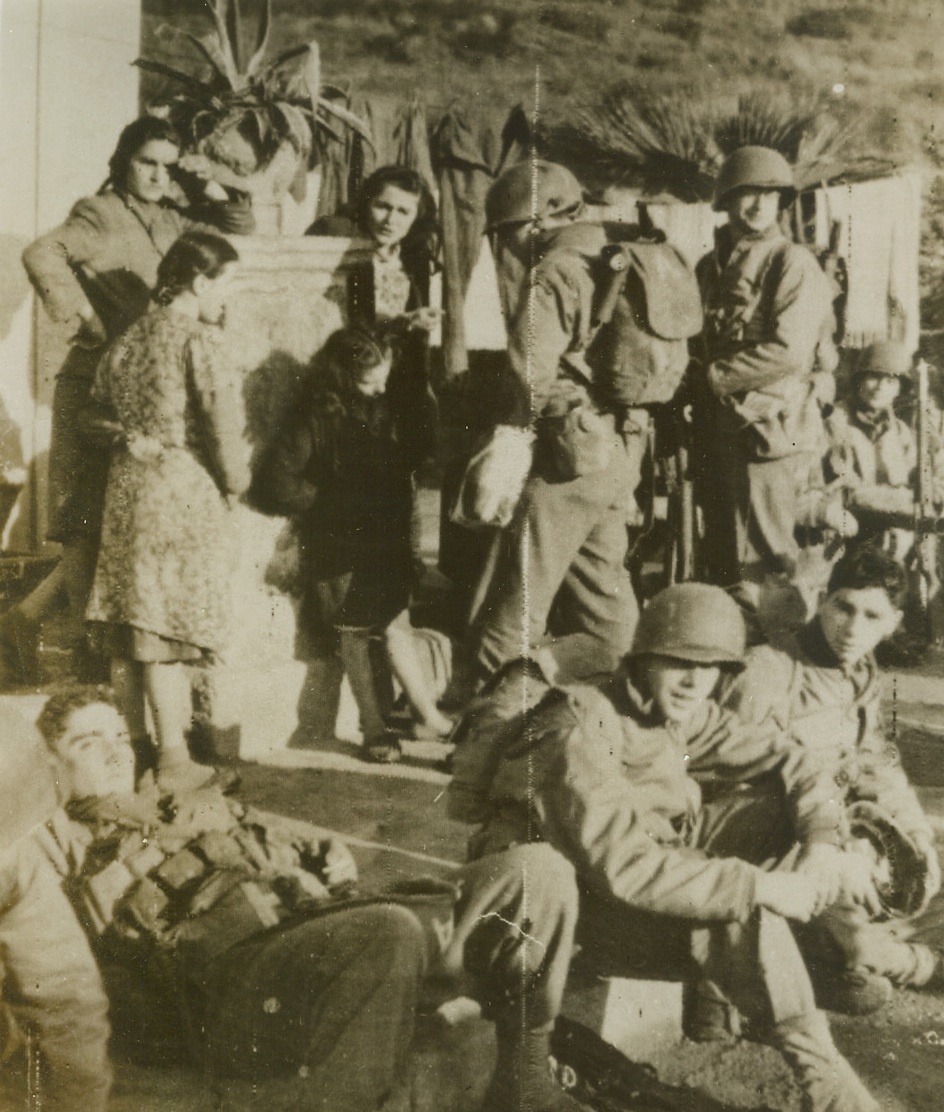
KISS THE BOYS GOODBYE, 1/22/1944. WITH THE FIFTH ARMY IN ITALY—Italian civilians bid farewell to members of the Yank assault forces that participated in the surprise landing behind German lines south of Rome, staged at dawn today (January 22nd). Resting as they await the order to embark, the Yanks were soon within thirty miles of home. Credit: OWI radiophoto from Acme;
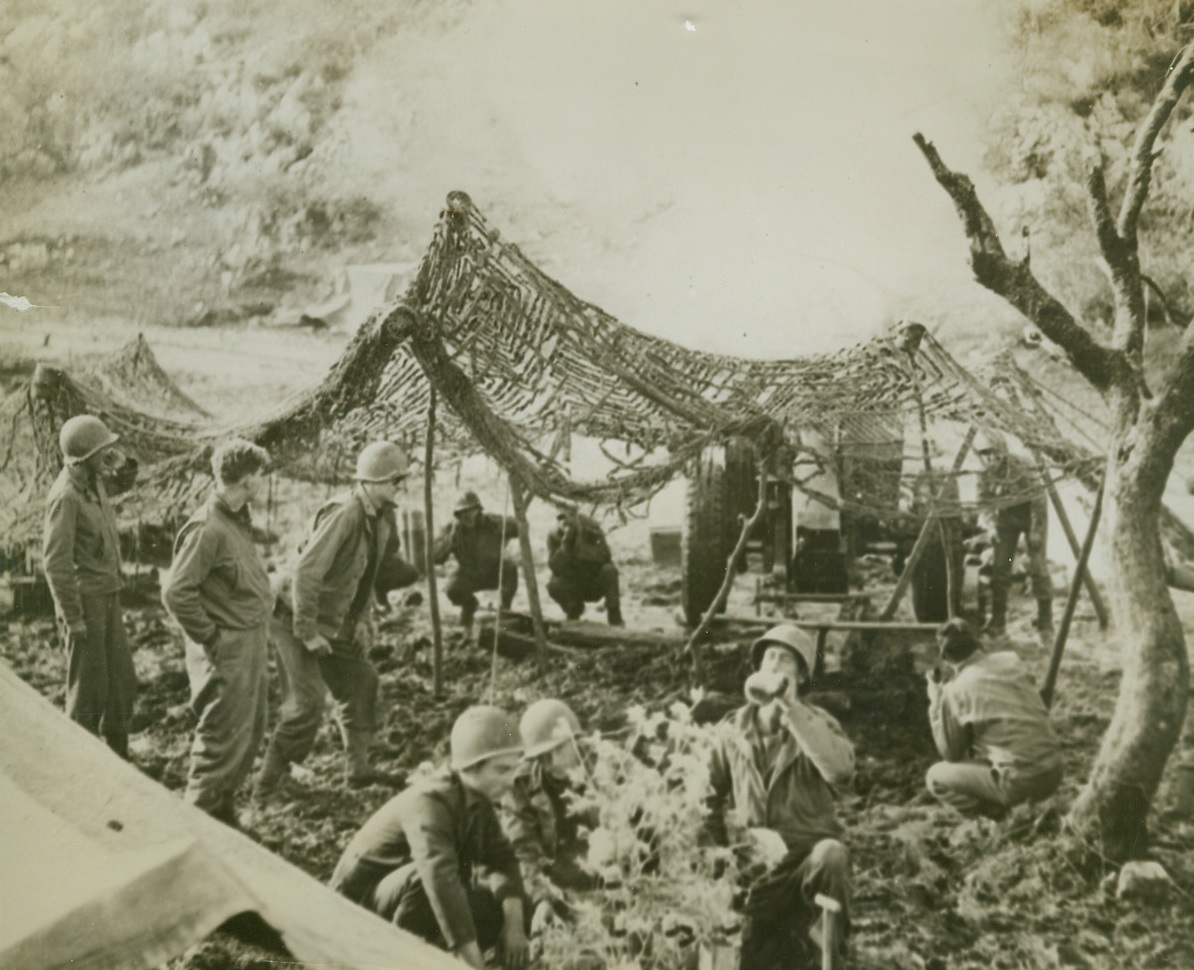
Wee Drop O’ Christmas Cheer, 1/12/1944. Somewhere in Italy—Refusing to be annoyed by the boom of big guns being fired on Nazi positions above San Vittore, members of this gun crew take turns at observing the Christmas holiday in the midst of the fight. In foreground, three Yanks gather around a make-believe Christmas tree, and one of them tilts the little brown jug for a wee bit of Yule cheer. In background, their buddies crouch and hold their ears as the gun goes off. This is an original of the radiophoto previously serviced. Credit: ACME.;
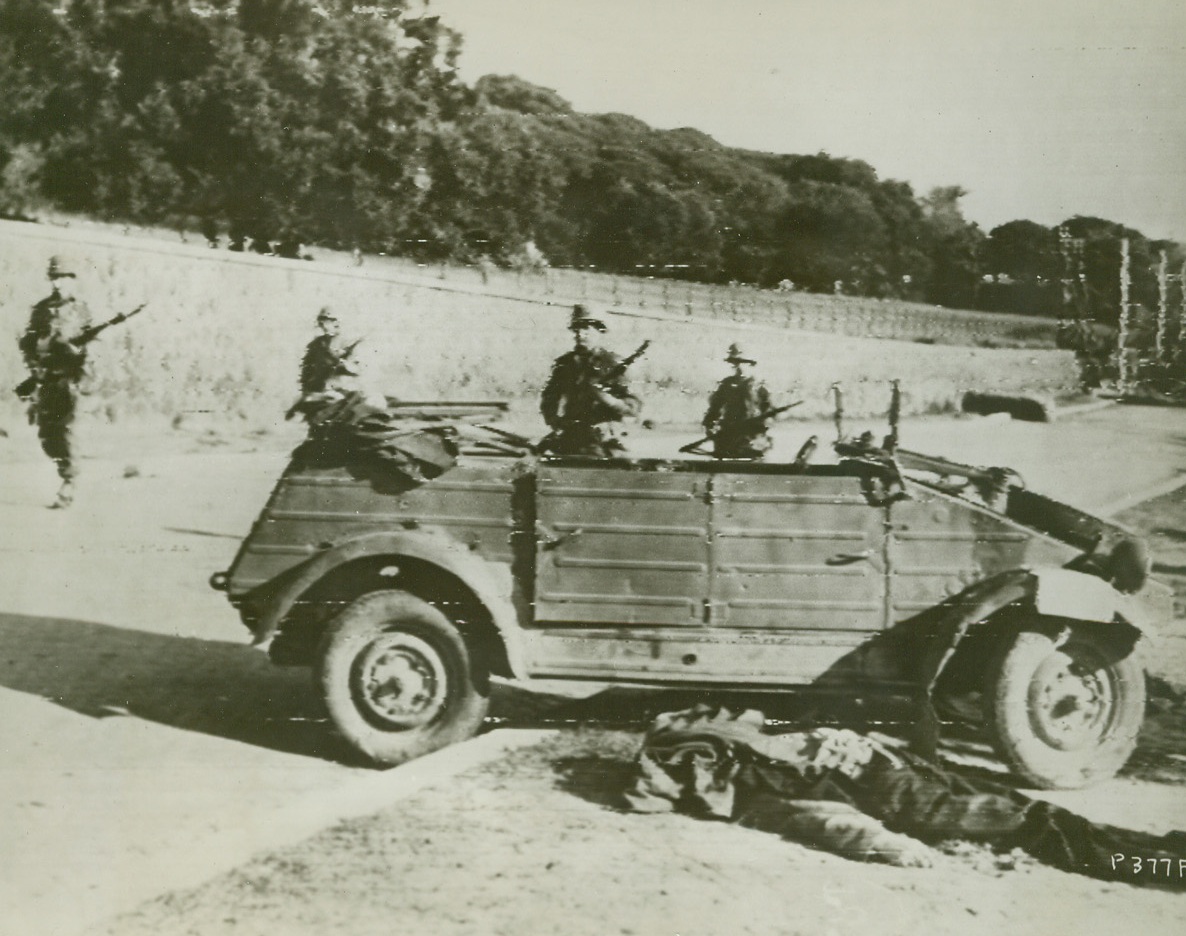
Yanks Advance Cautiously in Anzio, 1/27/1944. Anzio, Italy—Wary American soldiers, holding their guns ready for use in a split second, advance cautiously along a street in Anzio, after the Germans had been driven out by the invaders. A dead soldier lies before the German Jeep in the foreground. Credit: U.S. Signal Corps radiotelephoto-ACME.;
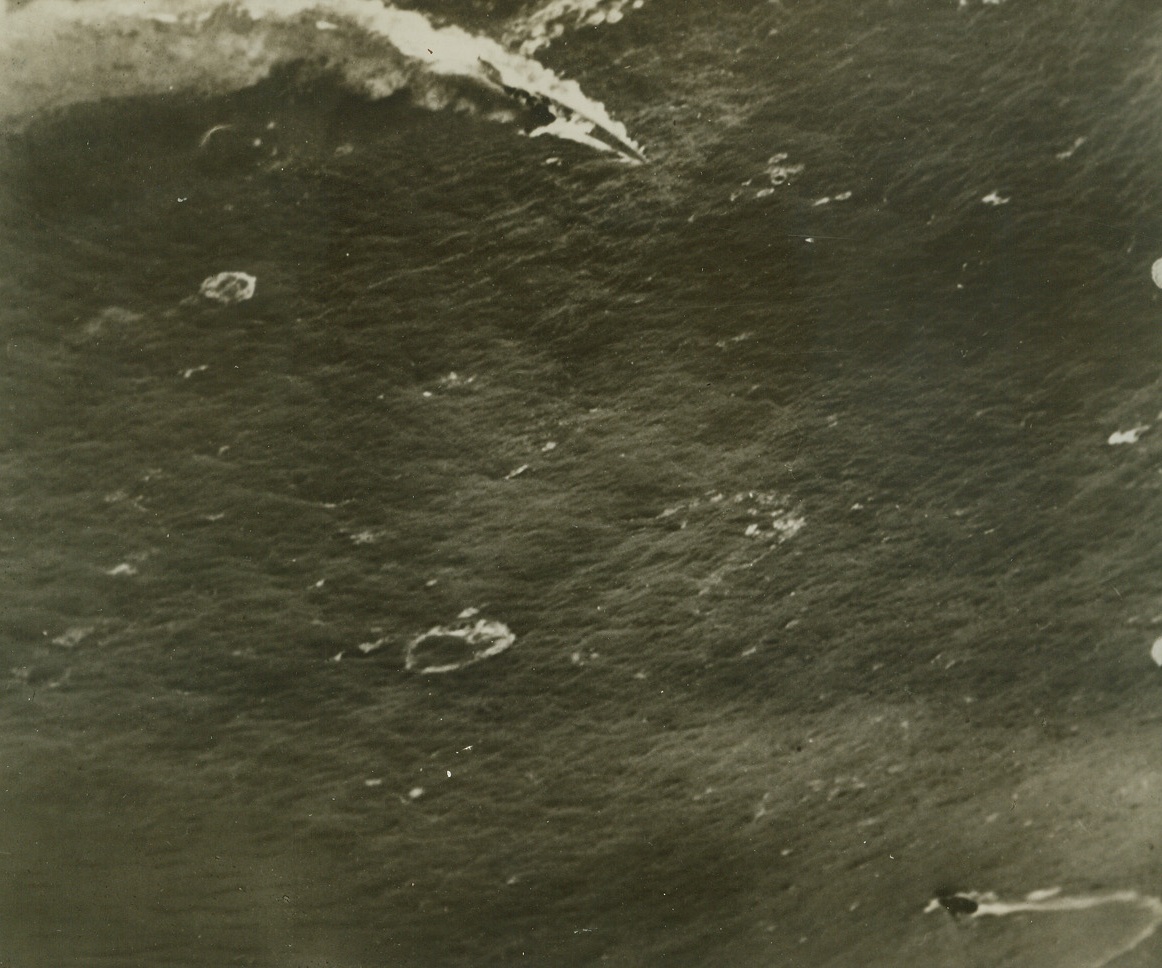
“Davy Jones” Gets Another Nazi Sub (#1), 1/27/1944. In a dramatic 27-hour battle “somewhere in the Atlantic, recently another German sub was blasted to the bottom by planes from a U.S. Navy escort carrier and three destroyers. It took 200 depth charges and considerable shell fire from the “tin-cans” to bring about the “kill.” Here, swinging about in a tight turn to avoid bombs and shells, the U-boat (bottom, center in photo) streams thick, black smoke from her conning tower from a shell hit. (Remainder of caption is illegible).;
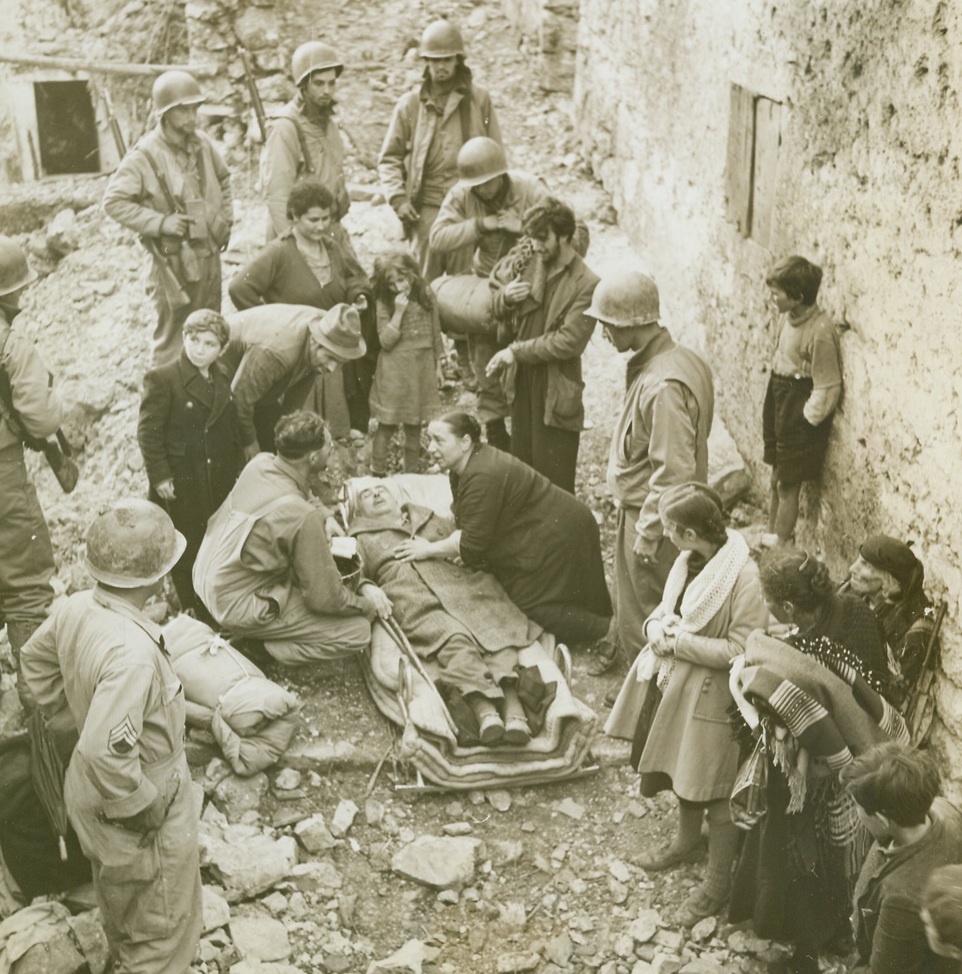
No Title. LAGONE, ITALY—Scene of many days of bitter fighting, the tiny mountain town of Lagone fell to the warriors of Lt. Gen. Mark Clark’s fifth Army, and the smoke of battle had hardly ceased before hundreds of natives flocked down from the hills to return to their homes. The pathos of their tragic homecoming to the wrecked, blasted buildings is recorded in this series, made by ACME correspondent Bert Brandt for the war picture pool. Non-combatants all, these men, women and children find that war is a very personal experience that has left them with a deep, grim hatred for the Germans. New York Bureau An old man, who was beaten by the Germans when he protested against being driven from his home, lies on a stretcher after being carried from the hills. His wife leans over the 65-year-old Italian, telling American Soldiers that her husband will never walk again. Credit: ACME photo by Bert Brandt, War Pool correspondent.;
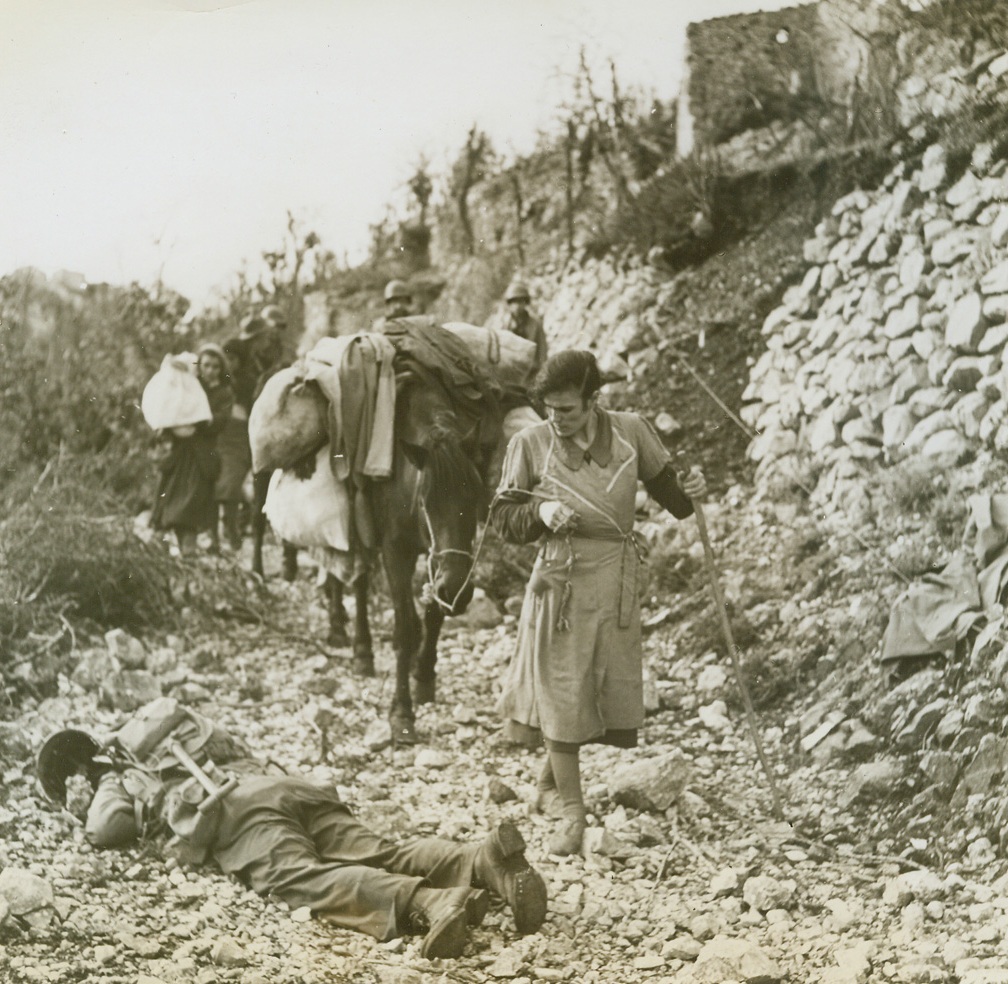
Return of the Natives, 1/1/1944. LAGONE, ITALY—Coming down from the hills in which they hid while war raged about their homes, these natives find a dead Nazi soldier in their path. Leading a mule laden with her belongings, her face distorted with hatred, an Italian woman carefully avoids fallen Nazi. Credit: WP (ACME photo by Bert Brandt, War Pool Correspondent);
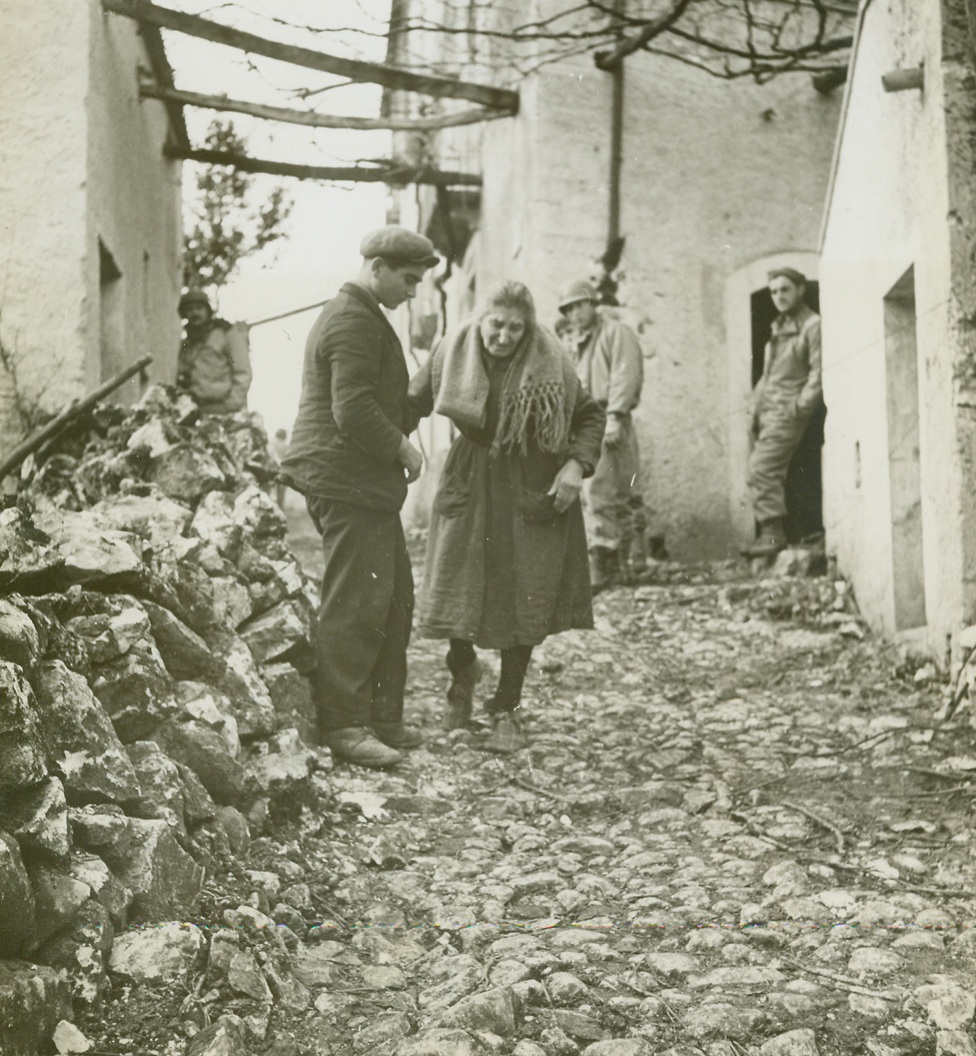
Return of the Natives, 1/1/1944. LAGONE, ITALY—An Italian boy helps his feeble grandmother along the rocky, rubble-strewn street that leads to their bomb-wrecked home, which was completely destroyed by the retreating Nazi forces. Credit: ACME photo by Bert Brandt, war picture pool correspondent.;
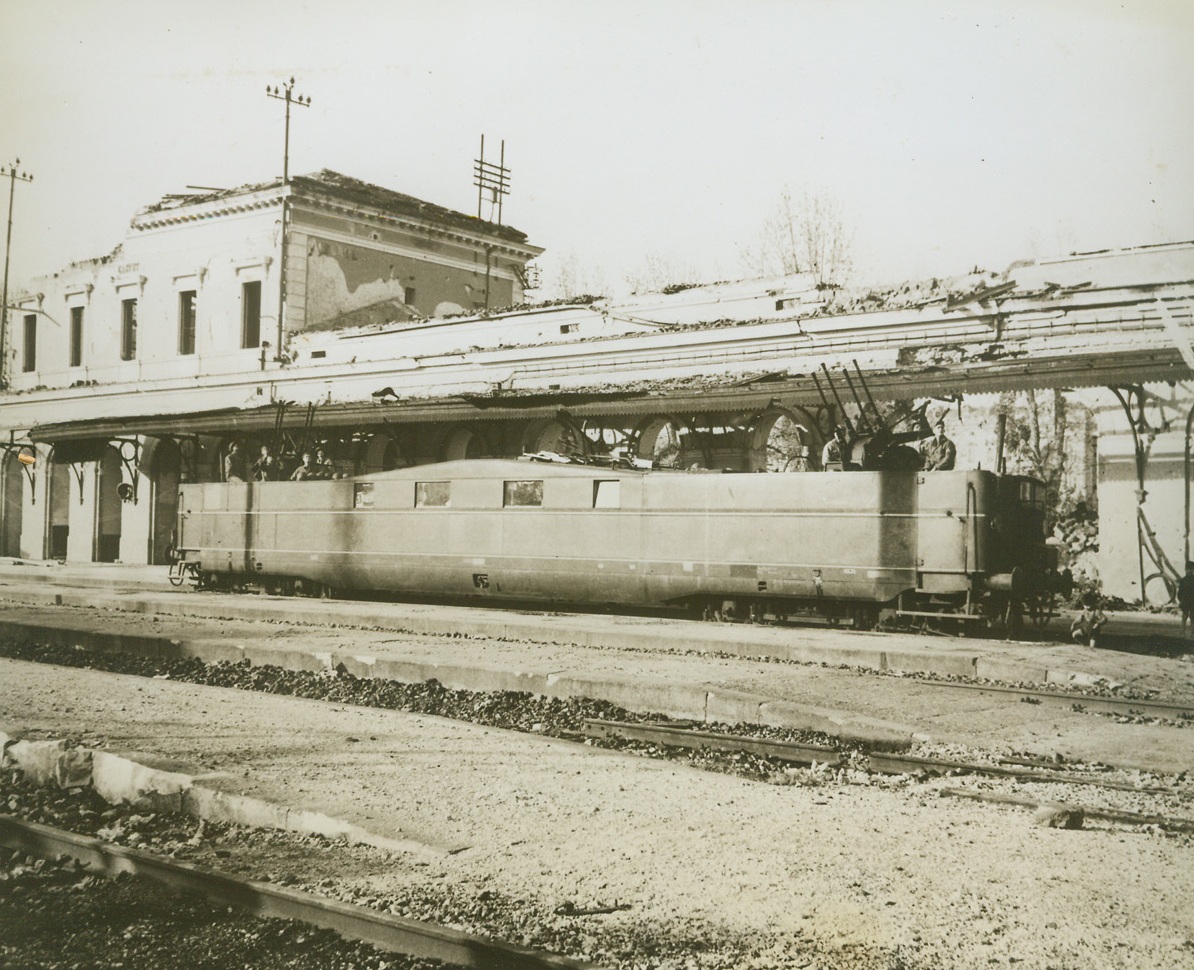
Yanks Get Musso’s Armored Car, 1/25/1944. NAPLES, ITALY—This deluxe, super-armored and armed railway was presented to Mussolini by Hitler, (In the “Good, Old Days”, of Course!). Germans tried to wreck it when the Allies chased them out of the Naples area—but the Yanks were too fast for them and nabbed the “battle-proof Pullman”. It has been put to use as a mobile anti-aircraft gun mount and an American crew of 10 lives in the luxurious quarters meant for Mussolini. Here, Yanks man the quadruple gun mounts at each end of the car during a practice alert. Credit: U.S. SIGNAL CORPS PHOTO FROM ACME.;
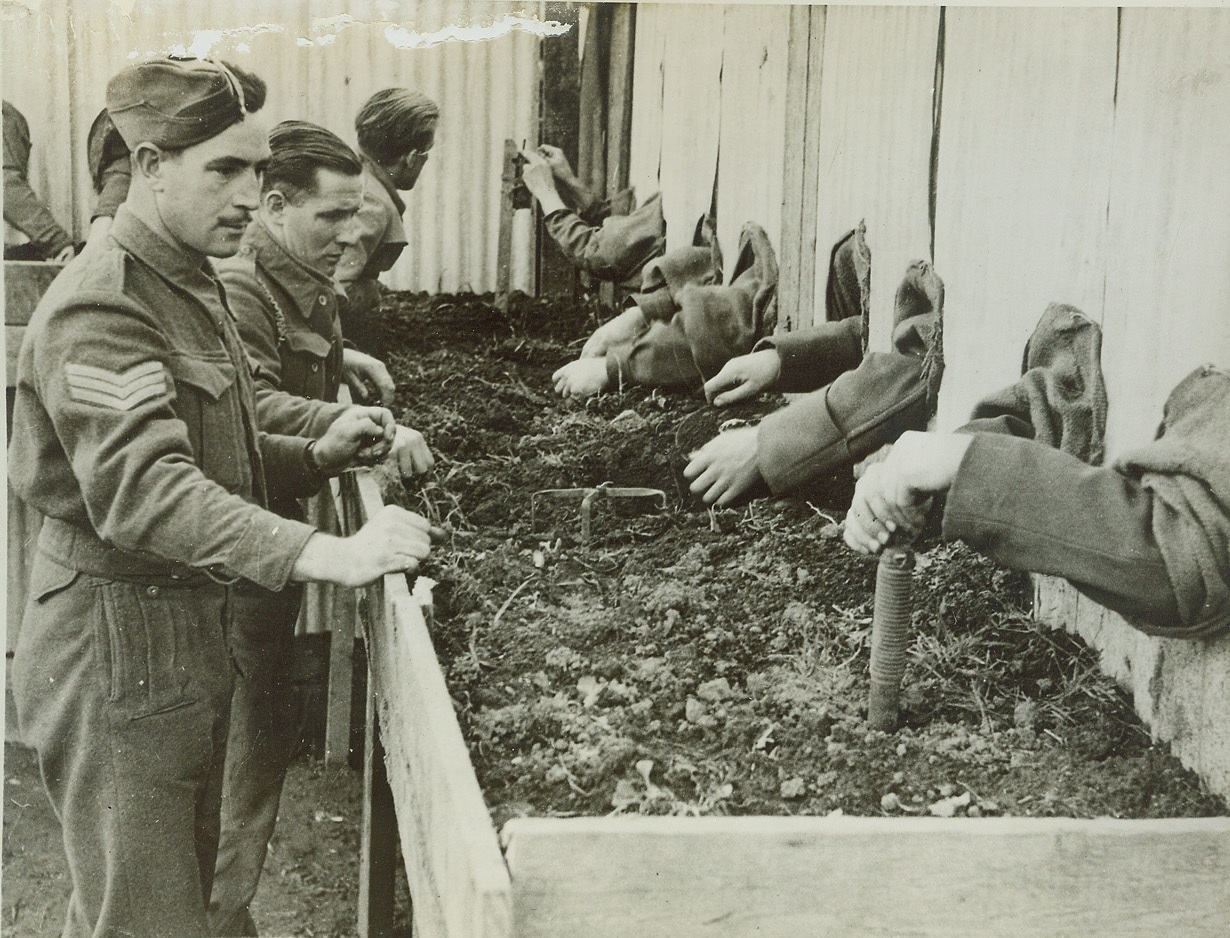
British Practice “Blind” on Enemy Mines, 1/20/1944. Italy – A device called the “Moascar Stocks” – a fence with burlap-shielded holes for arms – enables British fighters to “get the feel” of enemy mines they might have to dissemble in the dark. Instructors watch the hands of their students of the four-day school in Italy. Credit: (ACME);
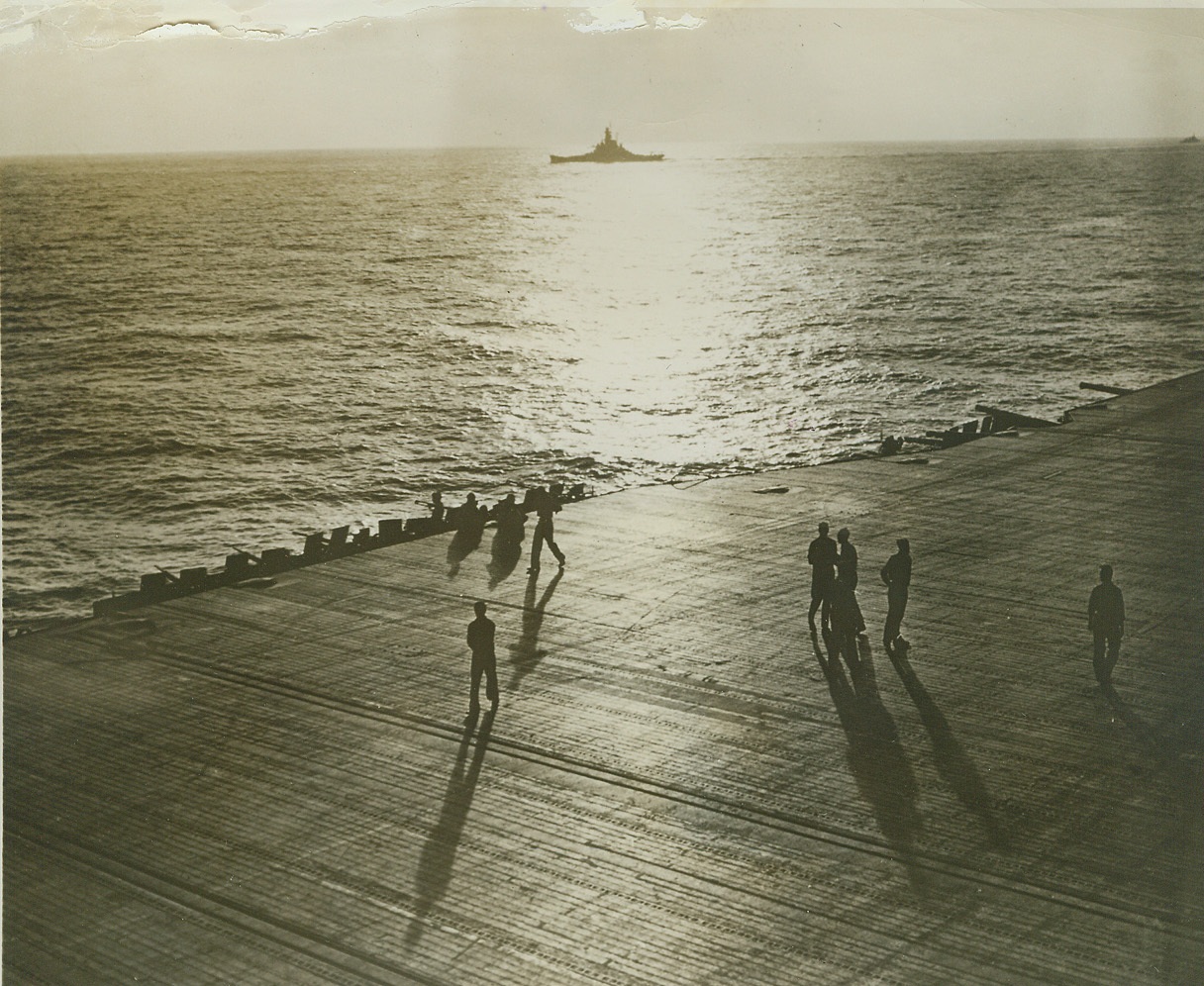
Champion Team of the Sea, 1/28/1944. Late afternoon sunlight slants across the flight deck of a 25,000-ton Essex Class aircraft carrier while, in the distance, a modern U.S. Navy battleship of the 35,000-ton South Dakota Class steams along on a task force mission somewhere in the Central Pacific. For the first time, the Navy has released combat pictures of the powerful new combat teams of carriers and battleships which are seeking out the Jap enemy. Credit (Official U.S. Navy Photo from ACME);
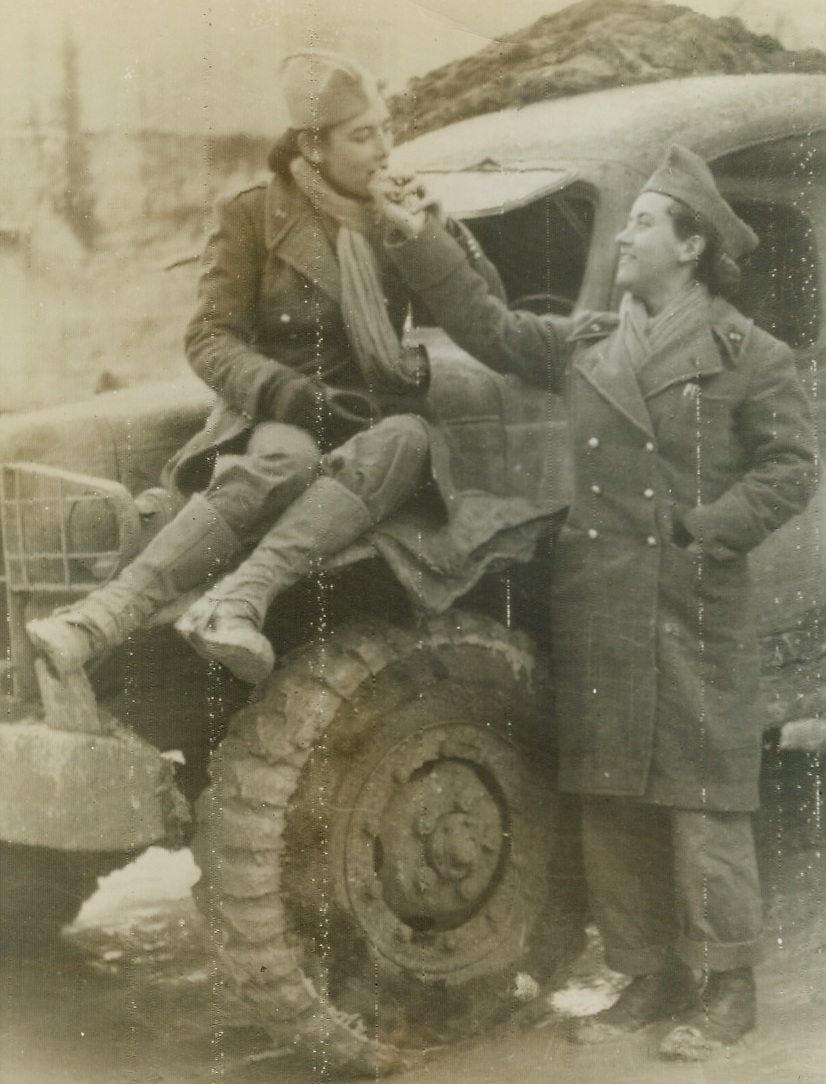
Frenchwomen at the Front, 1/1/1944. Frenchwomen at the FrontON THE ITALIAN FRONT -- Wearing clothing that isn’t much different than the togs sported by these women are ambulance drivers on the Fifth Army front in Italy. Both daughters of France, Naneu Calas (left) and Cecille Gedgeon stop to munch a chocolate bar in an Italian village. Photo radioed to New York January 1st from Algiers. Credit: OWI RADIOPHOTO FROM ACME.;
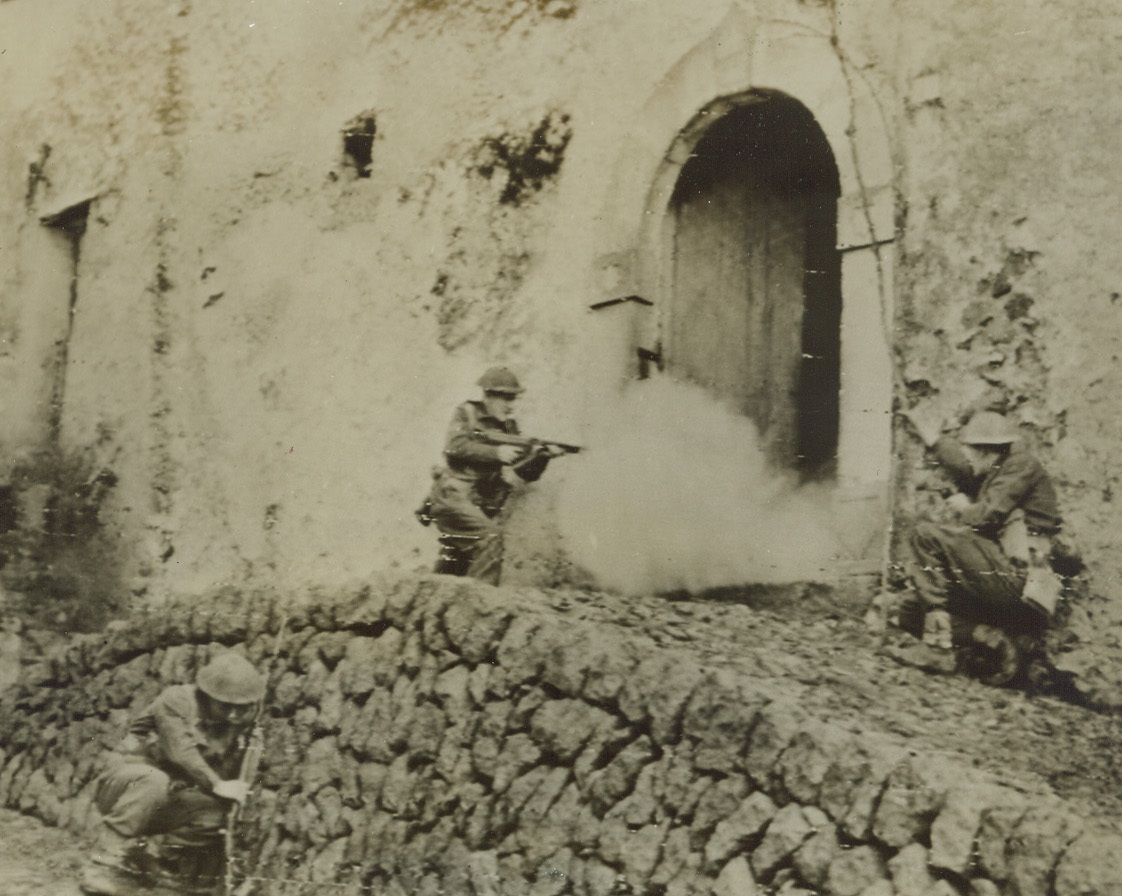
Taking No Chances, 1/28/1944. British soldiers have a “surprise party” in store for any Nazi snipers who may be hiding in this building, “somewhere in Italy.” Their guns on the ready, the Tommies creep up to the doorway, one remaining behind a stone wall in the foreground. Credit: ACME.;
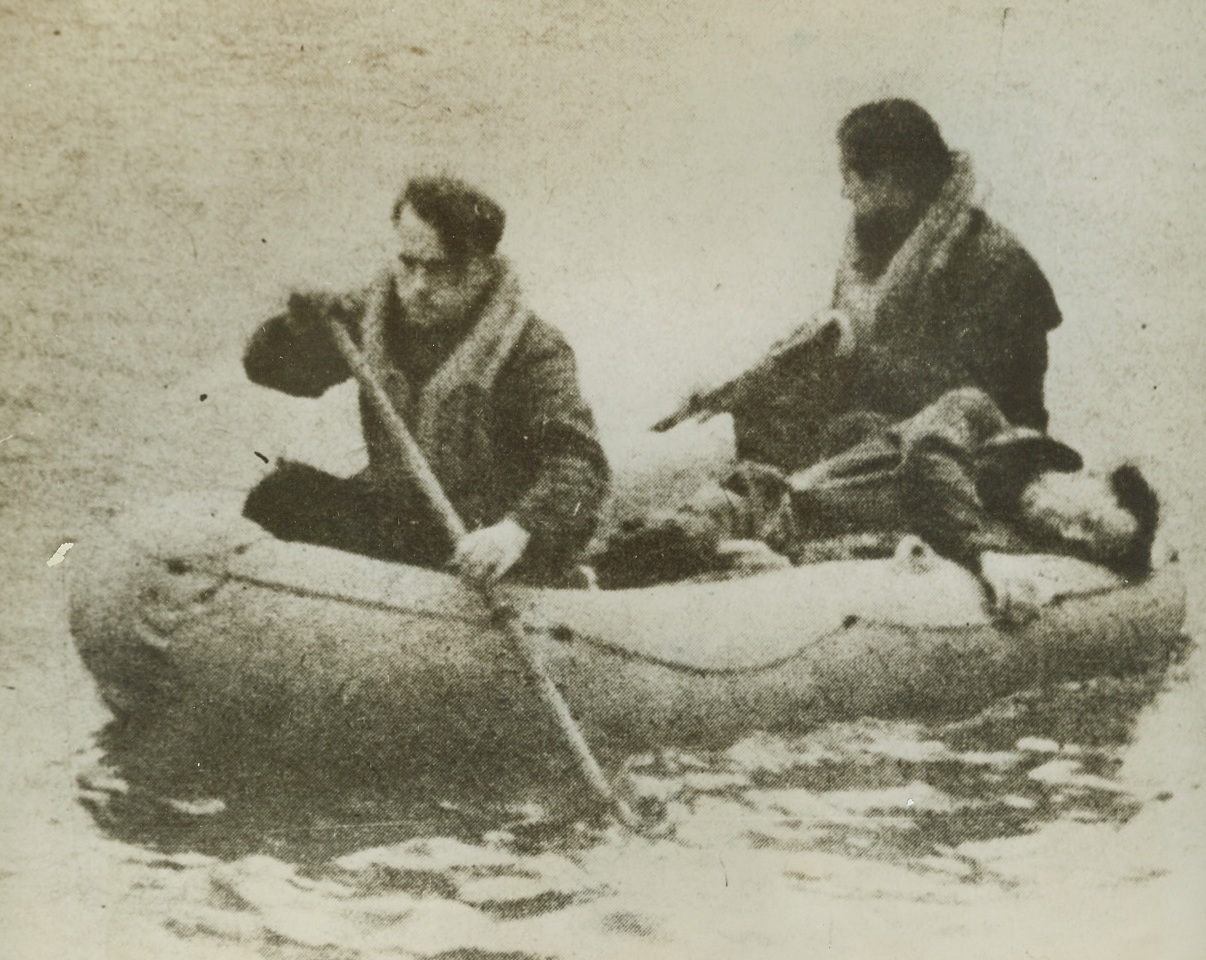
Channel Victims Claimed by Nazis, 1/27/1944. Two American fliers man their rubber raft in which a fellow crewman lies wounded, according to the German caption on this photo received through a neutral source. The Nazis say the U.S. plane was shot down in the English channel and these men were taken prisoner. Credit: ACME.;
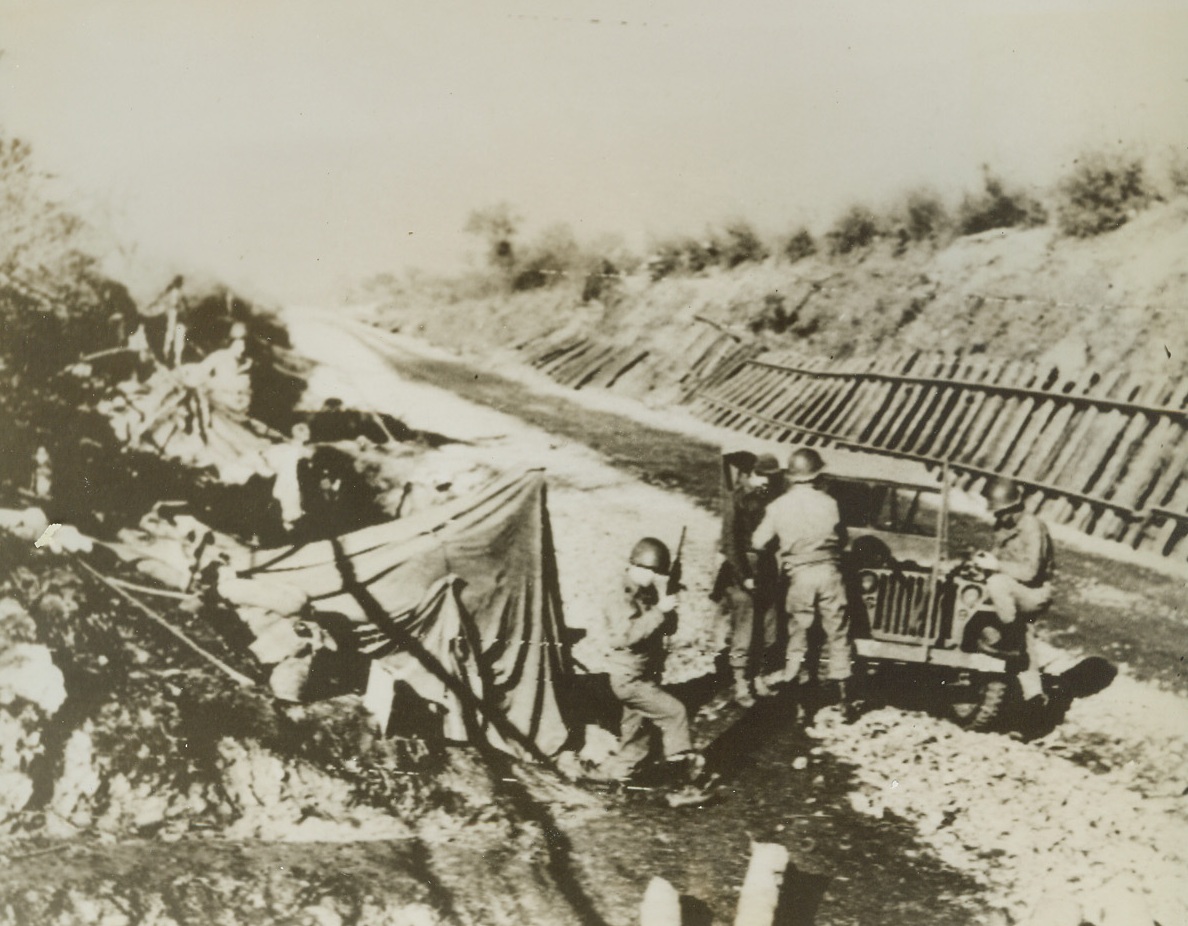
Taking the “Rail” Out of "Railroad”, 1/19/1944. ITALY—Allied Engineers ripped this railroad up and built a road for the advance against the German at Mt. Porchia and Mt. Trocchio. Here, American troops utilize dugouts built by the Germans. Rails and ties from the railroad lie along the right bank. Today, the Allies crossed the vital Garigliano River setting up a strong bridge head on the North bank. Credit: U.S. SIGNAL CORP RADIOTELEPHOTO from ACME.;
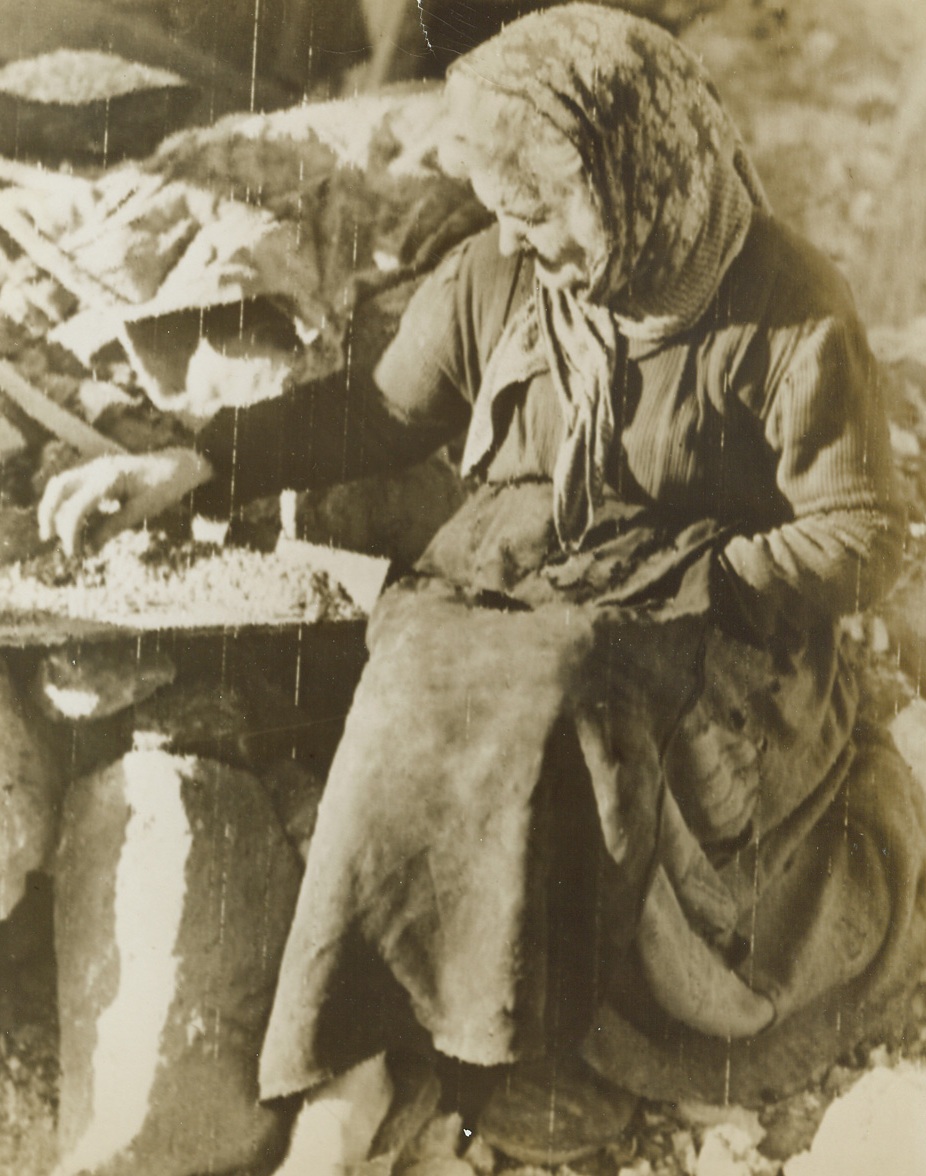
Bits of Food – Her Dinner, 1/19/1944. SAN PIETRO, ITALY—An aged Italian grandmother beated amid the ruins of her home in San Pietro, separates bits of food from dust and rubble, trying to gather enough for a meal. San Pietro was the scene of some of the bloodiest fighting of the whole Italian campaign. Today, Allied troops have crossed the Garigliano River and have set up a solid bridgehead on the north bank. Credit: ACME PHOTO by Bert Brandt for the War Picture Pool via Army Radiotelephoto.;
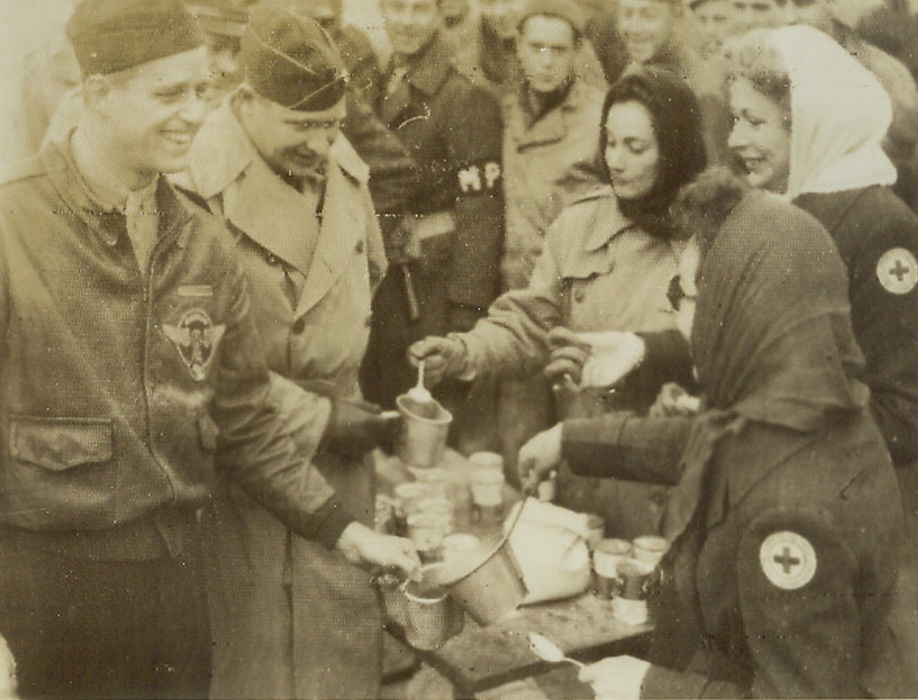
Doughnuts for a Roosevelt, 1/19/1944. ITALY—Col. Elliott Roosevelt, (far left), son of President Roosevelt, is served doughnuts and coffee near the front in Italy by American Red Cross girls. Credit: RED CROSS PHOTO thru OWI RADIOTELEPHOTO.;
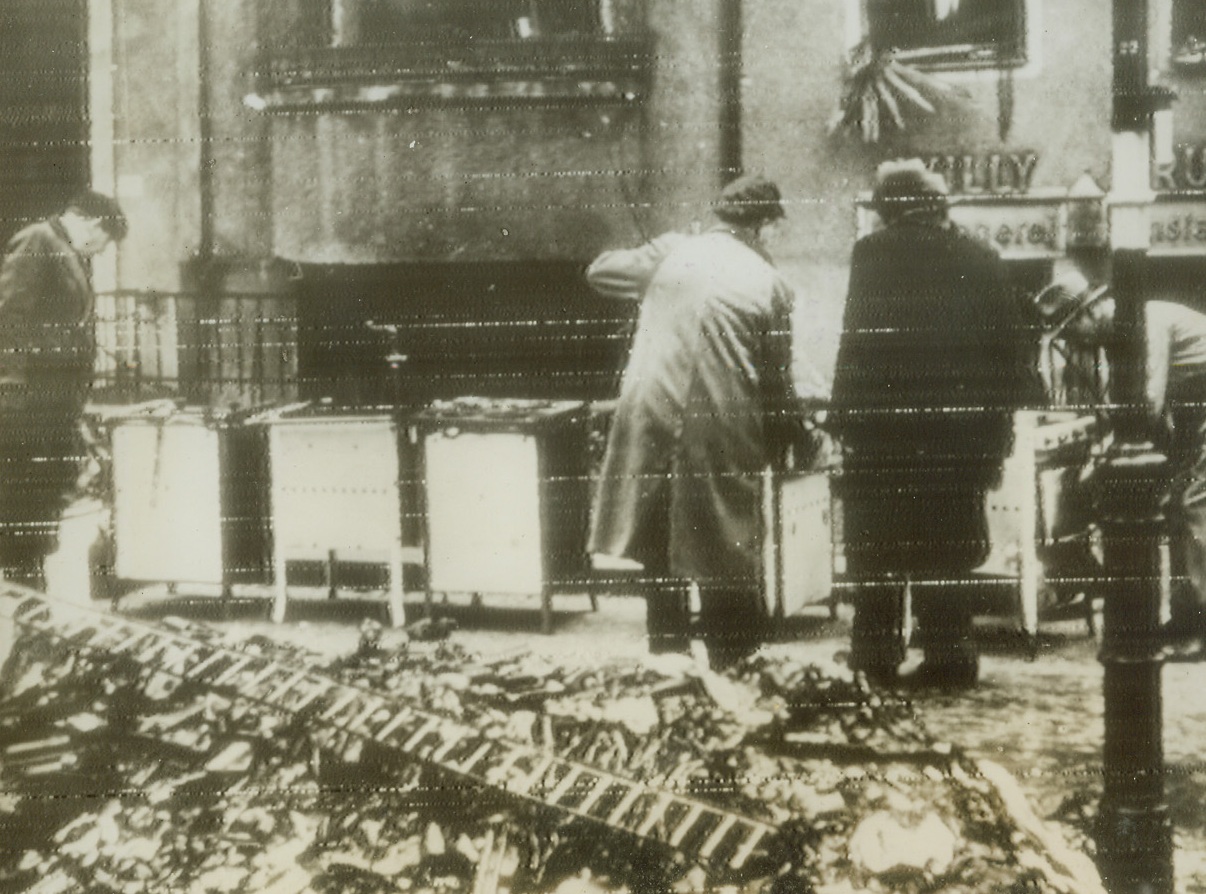
Scavenger Hunt, 1/19/1944. BERLIN—Residents of Berlin are trying to salvage everything possible from the bombed ruins of the German capital. According to German caption accompanying this photo, radioed from Stockholm this morning, the salvagers concentrate on doors, windows, iron beams, bathtubs, washtubs, furnaces and stoves which can be used in repairable houses or as scrap. Here a group of Berliners are looking over a batch of salvaged stoves. Credit: ACME RADIOPHOTO.;
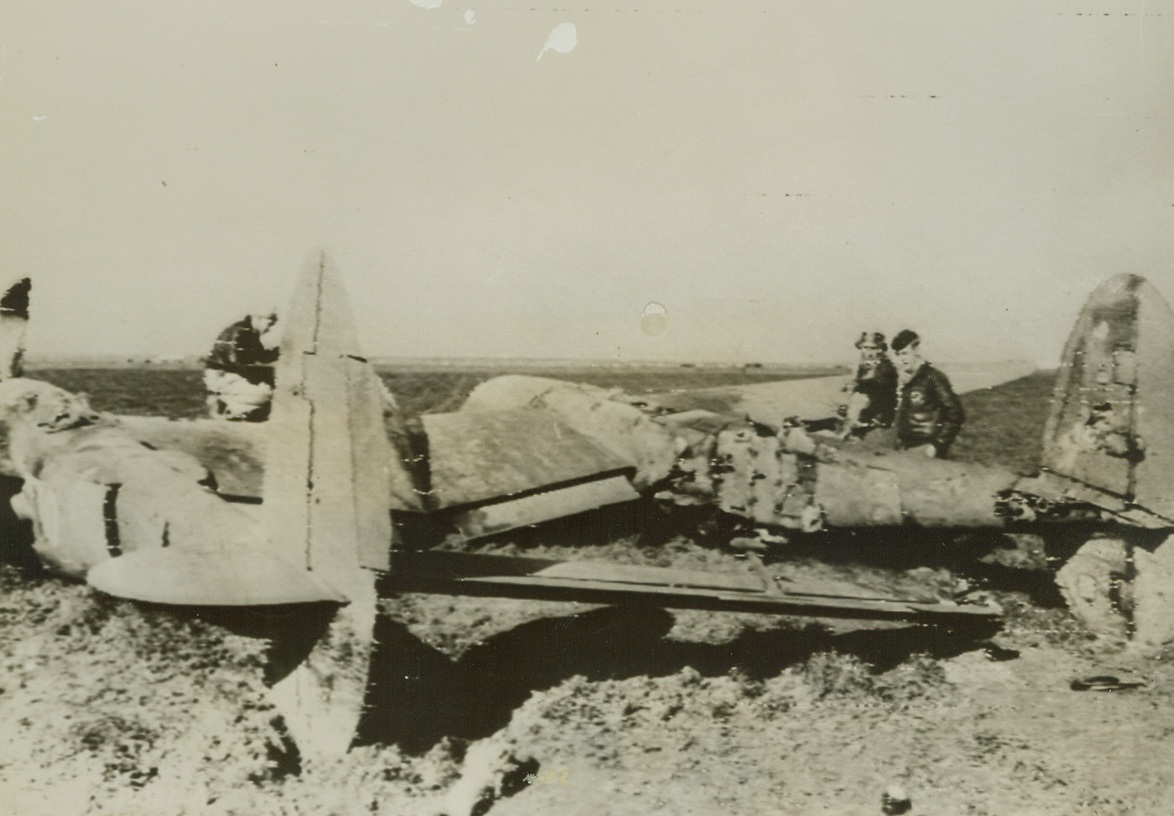
Collides with Nazi in Mid-Air, 1/28/1944. First Lt. Thomas Smith, of Madera, Calif., explains a few breath-taking facts to his flight leader, 1st Lt. Robert L. Highsmith, of Lombard, Ill. Piloting his P-38 Lightning, he collided in mid-air with a Nazi fighter plane, scraping the right engine and setting it afire and slicing the tail boom in two. After two hours in the air, when the second engine failed, Lt. Smith landed the battered plane in a wheatfield adjoining his base. Credit: SIGNAL CORPS RADIOTELEPHOTO FROM ACME.;
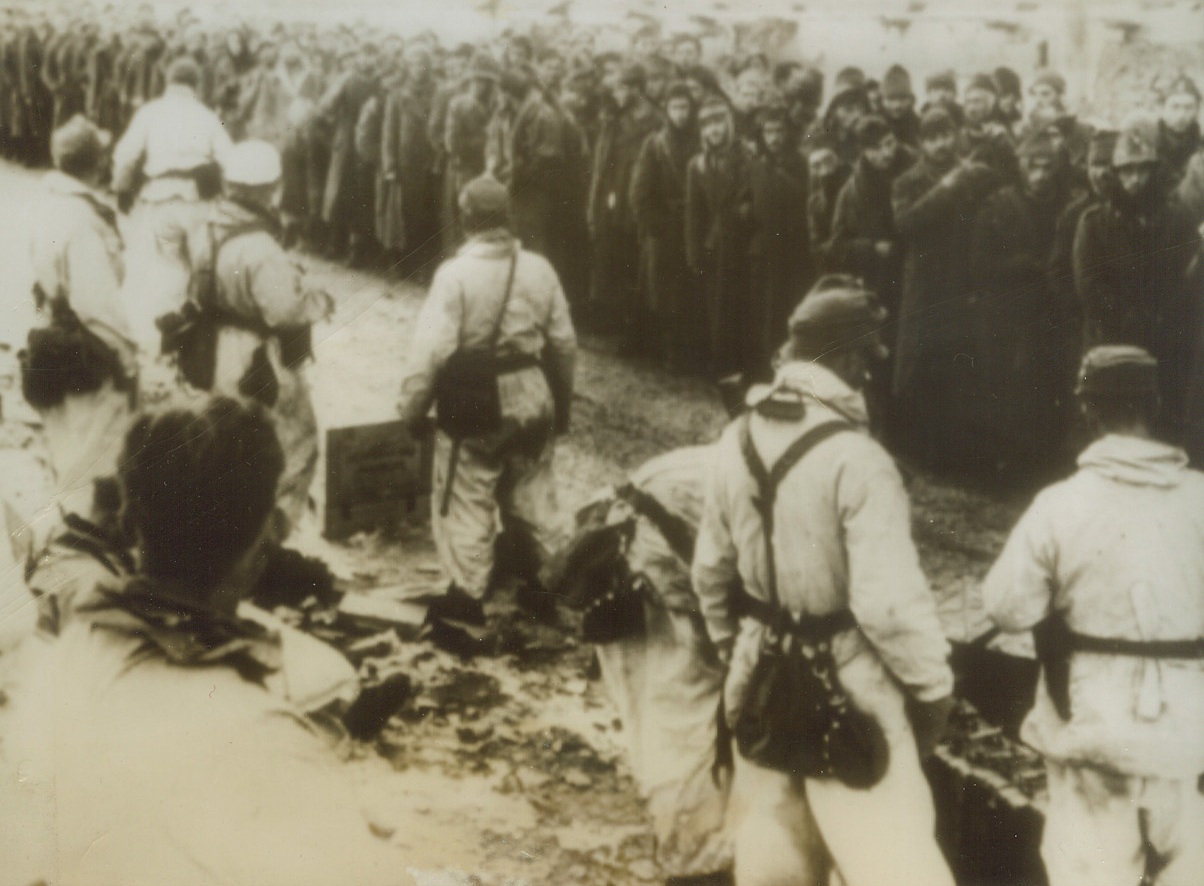
Italian’s Prisoners of Germans, 1/5/1944. BOSNIA—Several months ago we stopped seeing pictures of Italian prisoners taken by Allies when their country capitulated and joined forces with us. Now Italians are being taken prisoner by their former Allies, the Nazis. Here, according to the German caption, is an assembly station of Badoglio troops who were taken prisoner in Bosnia. Photo radioed from Stockholm. Credit: ACME RADIOPHOTO.;
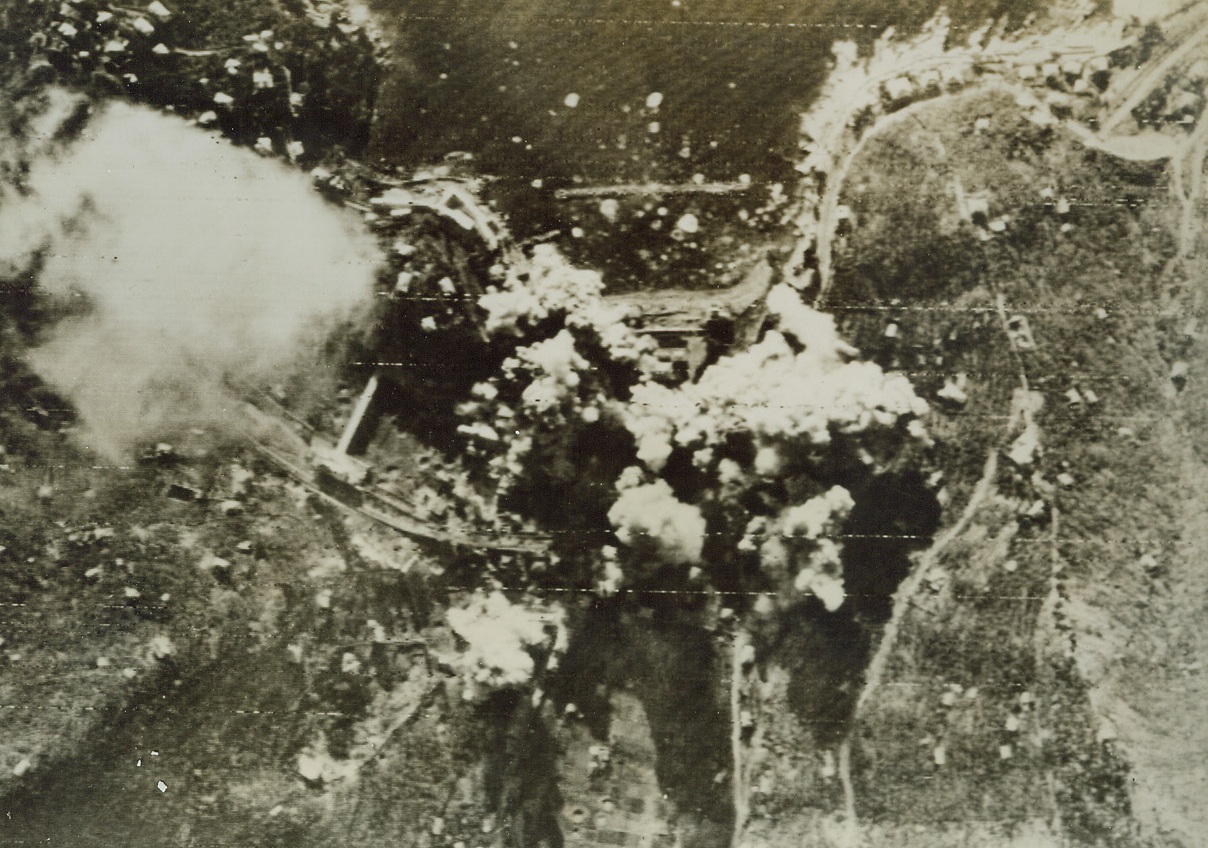
We Destroy Nazi Viaduct in Italy, 1/4/1944. ITALY—American bombs smash apart an important Nazi rail link at Recco, Italy, as U.S. Army on a viaduct. The resulting shambles caused long delays in the German transportation of essential material for the battle for Rome.Credit: U.S. SIGNAL CORPS RADIOPHOTO FROM ACME.;
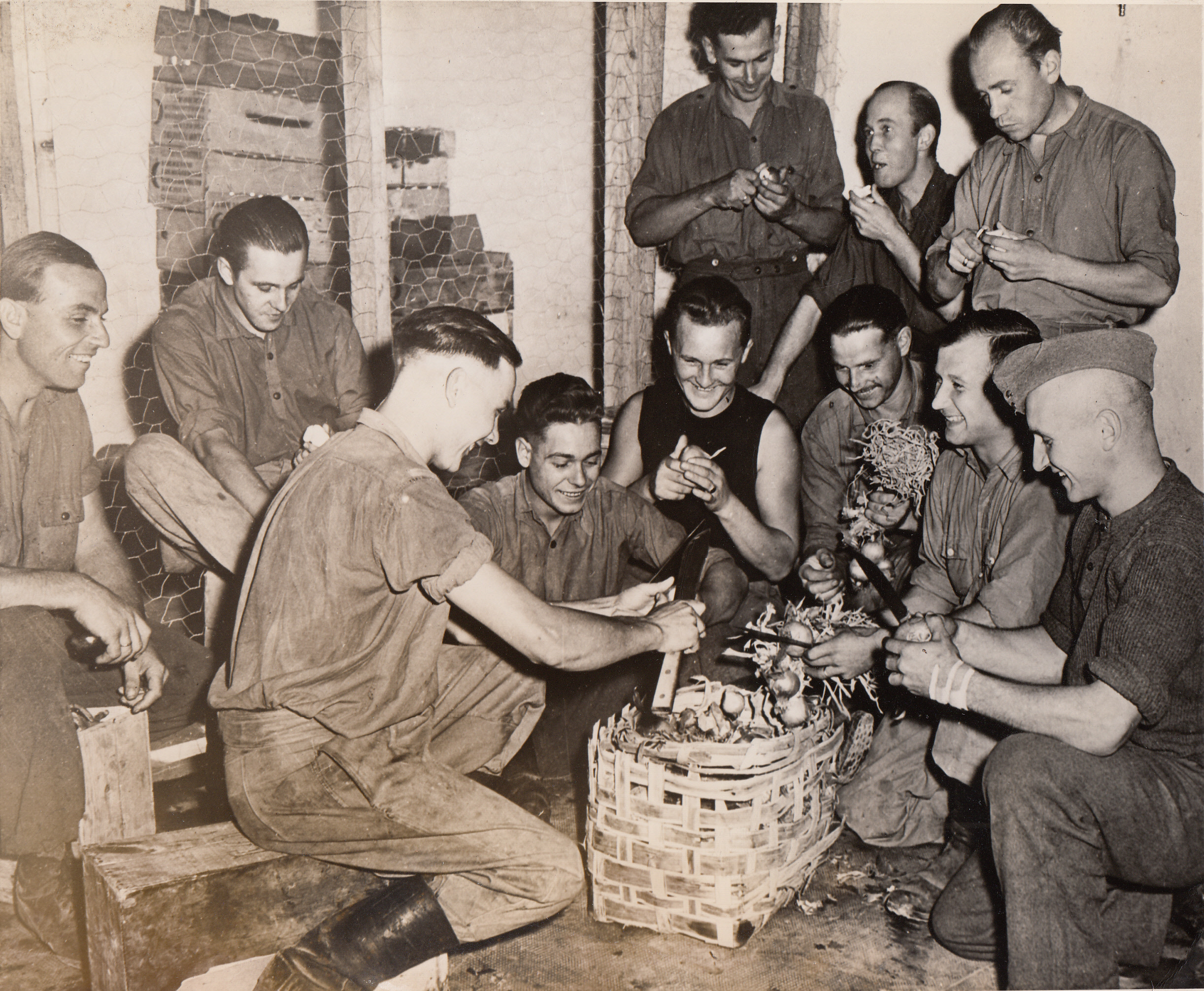
Onions Bring No Tears to German Eyes, 1/4/1944. ITALY—Behind the battle lines in Italy, Nazi prisoners of war do K.P. duty with a smile, even though they are peeling onions for soup. Many of the captured German soldiers arrived at the prison camp bearing leaflets, fired from Allied guns, which described the excellent treatment they would receive on surrender.;
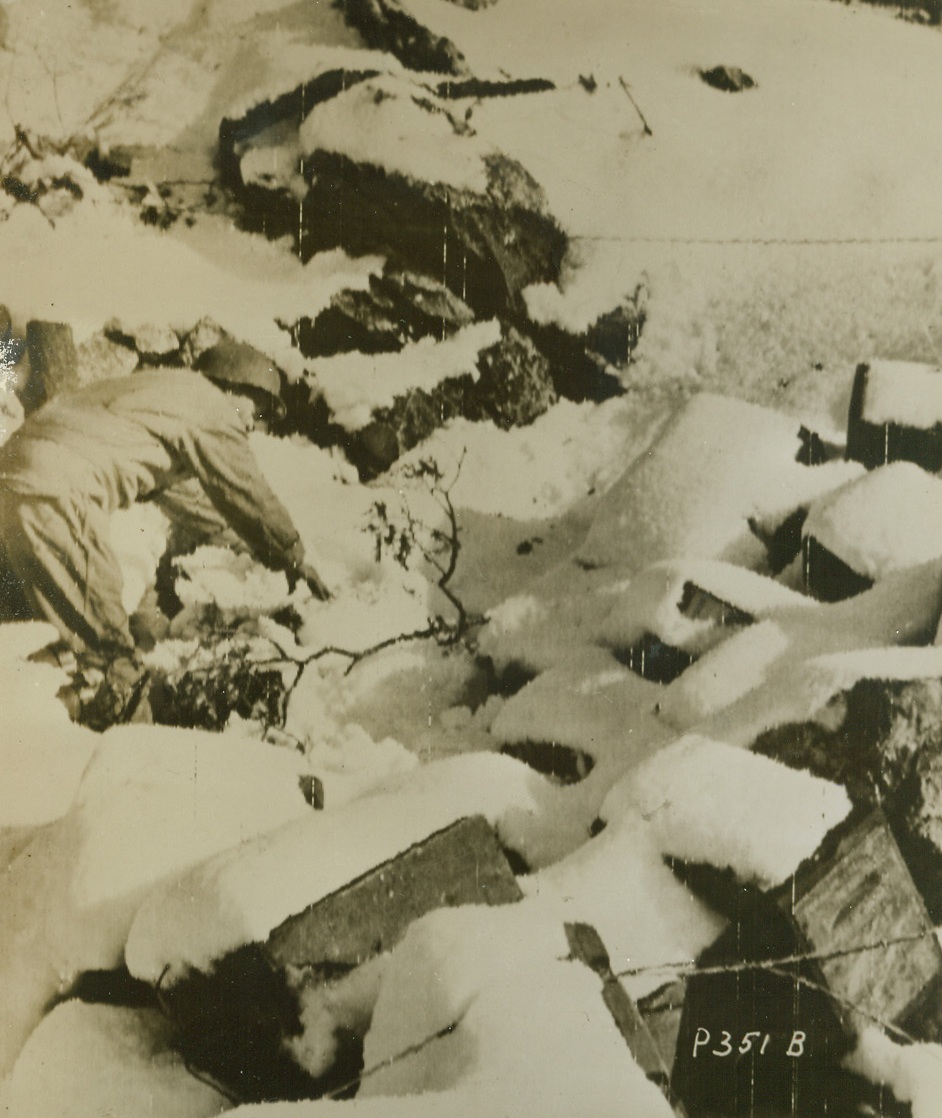
Camouflage, 1/6/1944. SOMEWHERE IN ITALY—Heavy snowfall provides camouflage at the Italian front as Pfc. Charles P. Nelson of Caldwell, N.J. brushes snow from shells in a dump in Pozzili area. Credit: SIGNAL CORPS RADIOTELEPHOTO from ACME.;
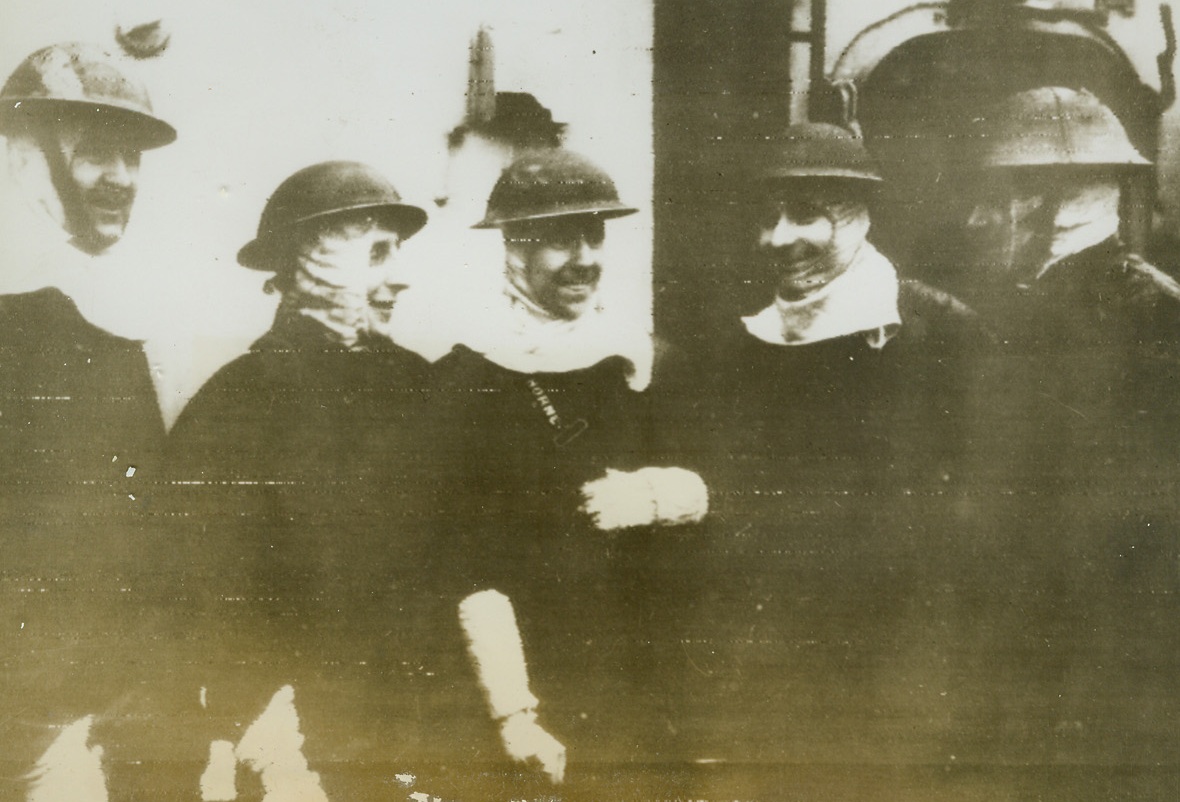
They Sent the Death Blow, 1/3/1944. These five smiling torpedo men are members of the crew of the H.M.S. Jamaica, British Vessel that sent the final torpedo into the stricken Nazi battleship Scharnhorst, during the sea battle off the northern coast of Norway last week. Photo radioed to New York from London January 3, 1944. Credit: ACME RADIOPHOTO.;
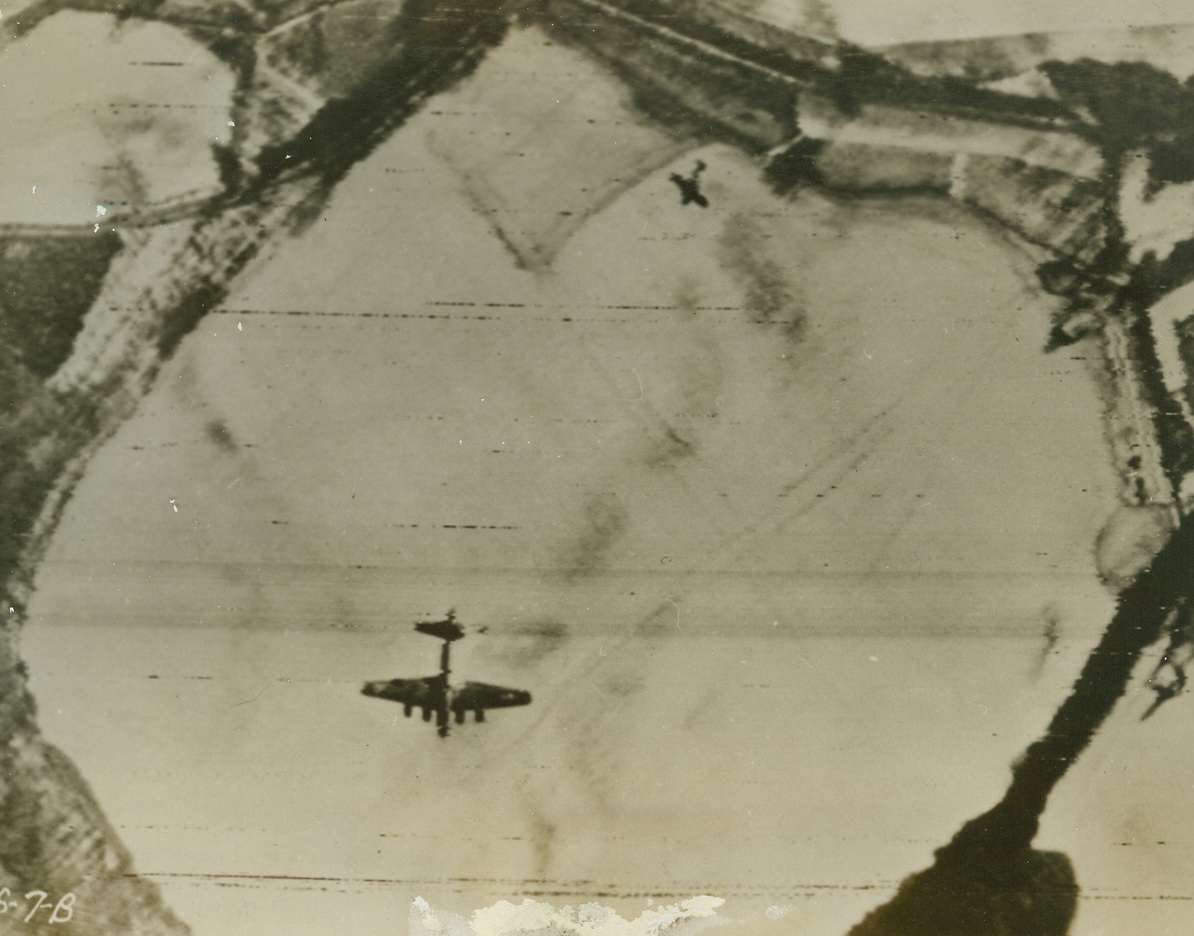
Personal Revenge, 1/14/1944. Probably this FW190, viciously attacking a blazing Flying Fortress (center, bottom), was assembled in the plane plant at Oschersleben, where the B-17 just laid its eggs. The Nazi fighter plane goes in for the kill, as the smoking bomber goes down, during the spectacular January 11th raid when we virtually obliterated three fighter plane assembly plants. Credit: U.S.A.A.F. photo via SIGNAL CORPS TELEPHOTO from ACME RADIOPHOTO.;
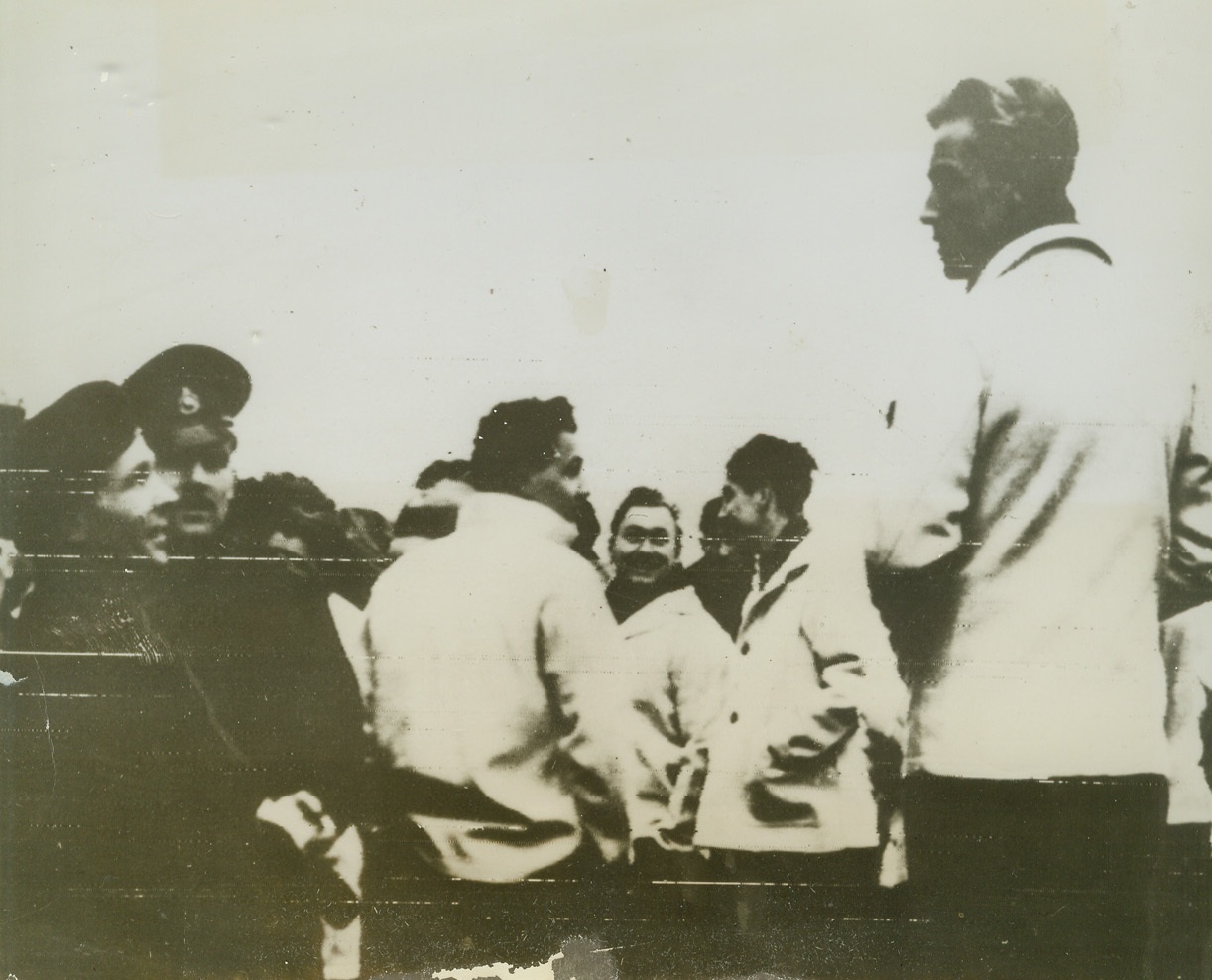
Scharnhorst Survives, 1/3/1944. Just plucked out of the sea by the crew of H.M.S. Duke of York, these Nazi sailors (center, hatless) don’t look very mournful over the loss of their ship, the German battleship Scharnhorst. They are among the very few Nazi seaman who survived the shelling, torpedoing and sinking of the Vessel. Photo radioed to New York from London today, January 3, 1944. Credit: ACME RADIOPHOTO.;
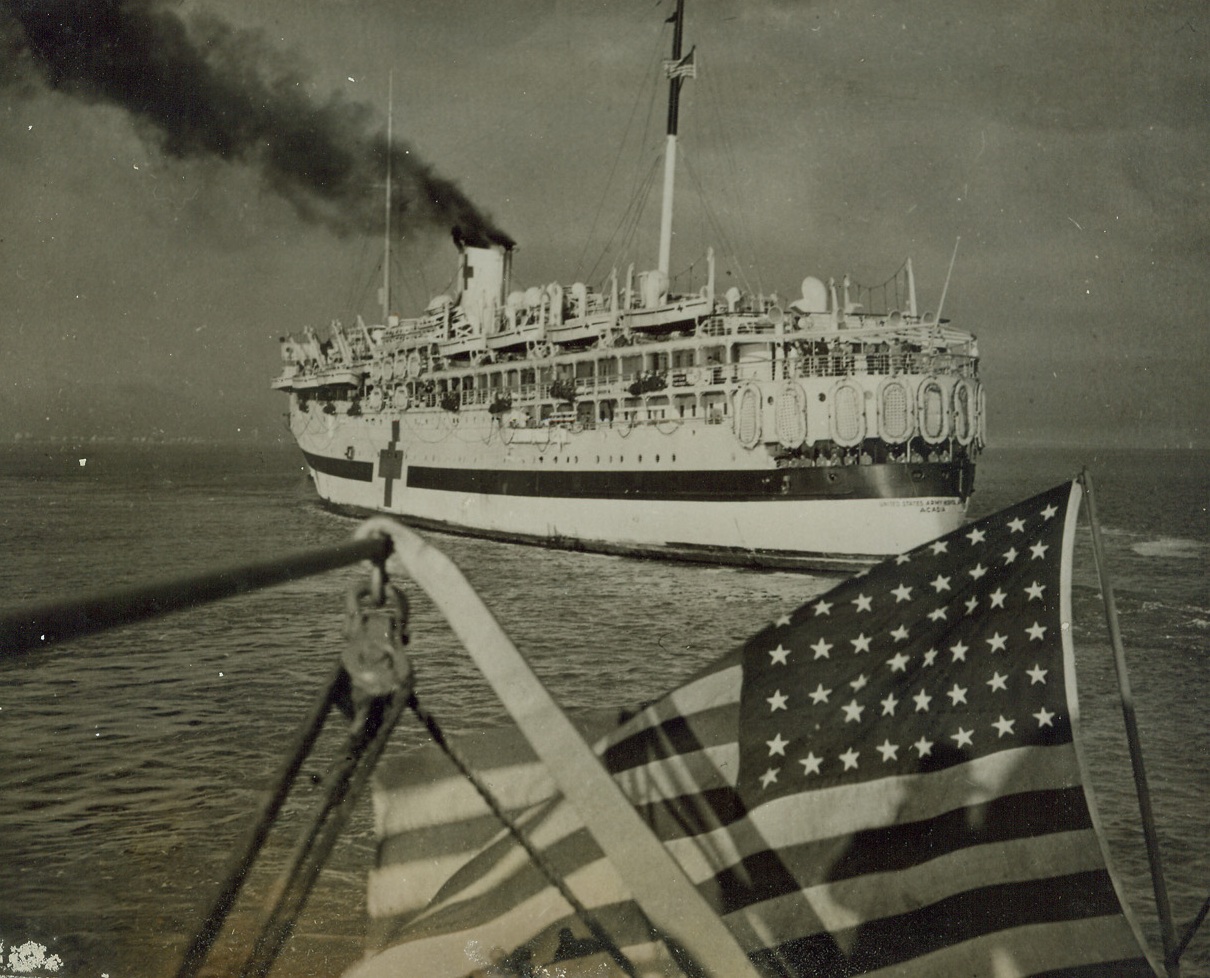
She Brought Happy Warriors Home, 1/8/1944. AT AN EAST COAST PORT -- Steaming into an East coast port with her precious cargo on January 5th, the U.S. Army hospital ship Acadia brings a batch of wounded, but happy Yanks back to their homeland. The vessel carried casualties from North Africa, Italy and Europe, who were sent to Hospitals for treatment as soon as they debarked. Credit: ACME.;
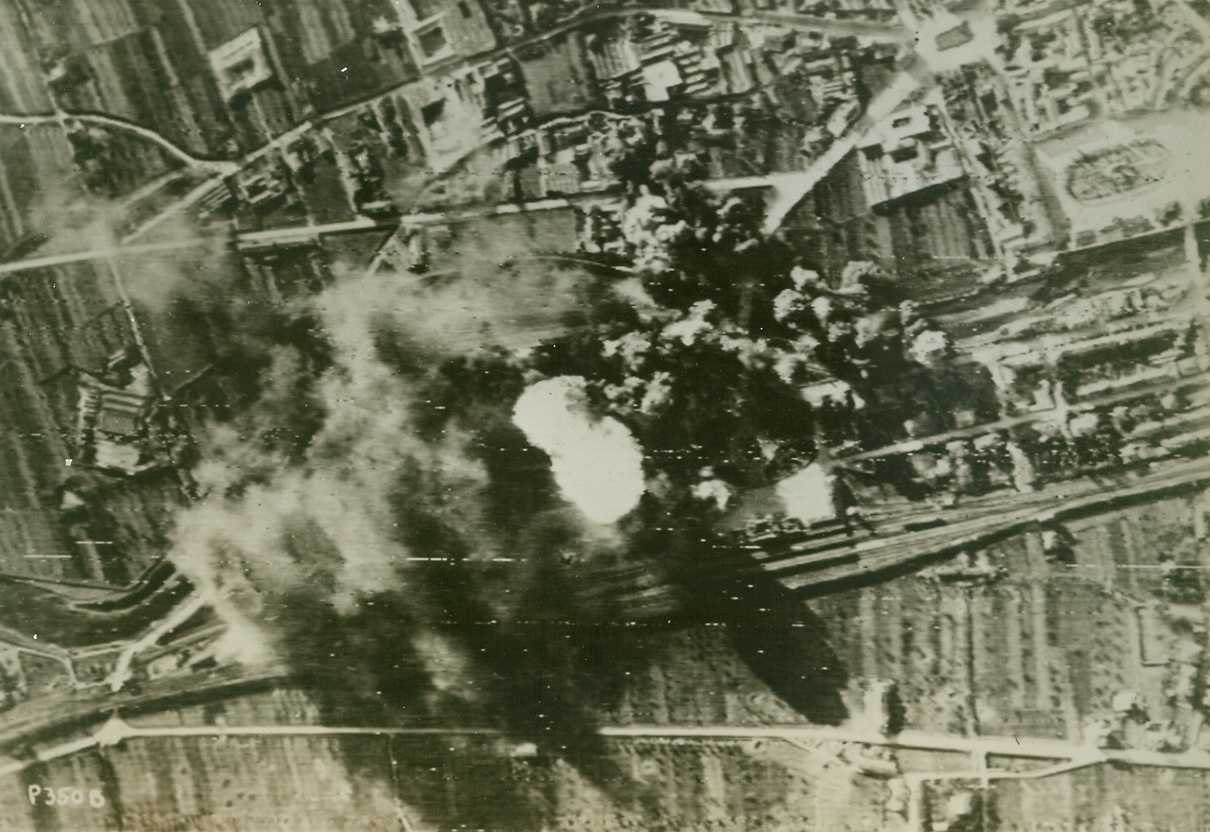
Prato Yards go up in Smoke, 1/5/1944. PRATO, ITALY—As high explosives of raiding American B-26 bombers find their mark, an axis oil dump and the marshalling yards at Prato go up in a mass of smoke and fire came so high that he thought it would reach “right up to meet us at 10,000 feet.” Credit: SIGNAL CORPS RADIOTELEPHOTO from ACME.;
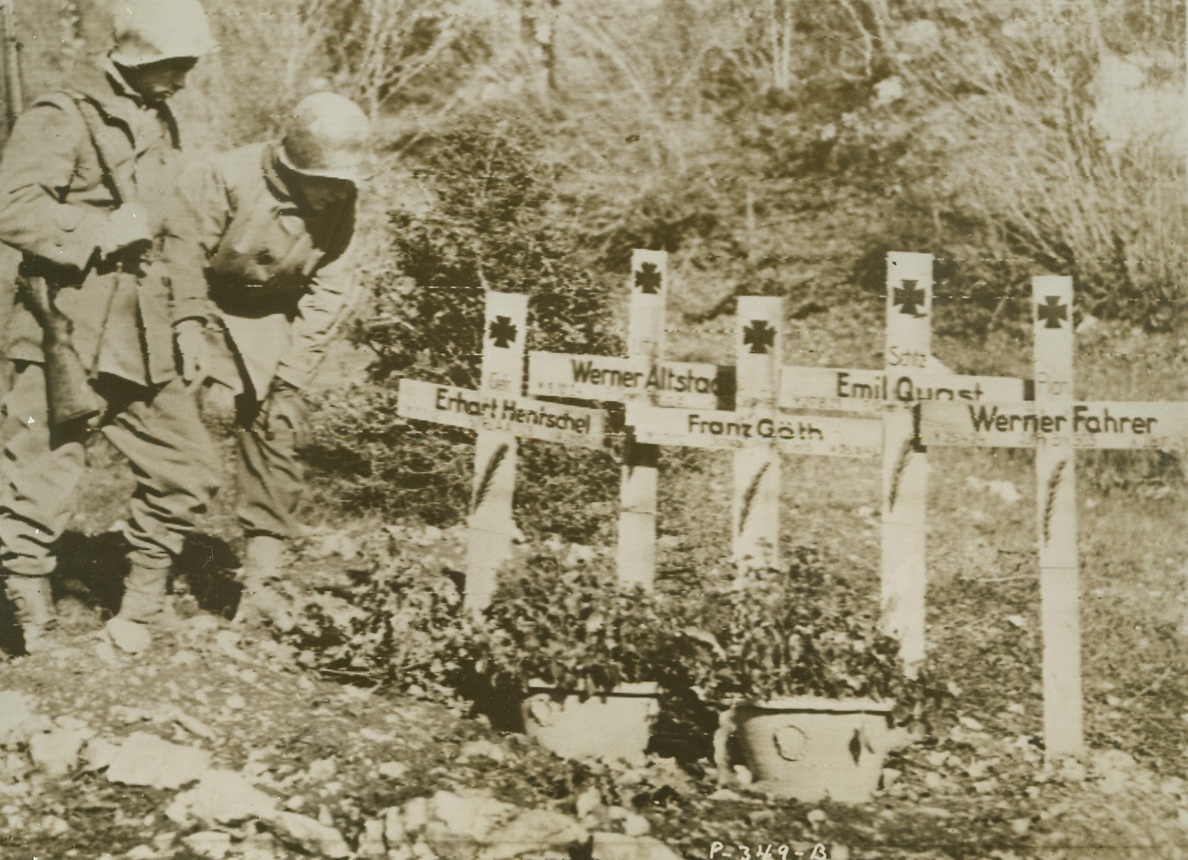
Five Graves on Rome Road, 1/5/1944. VANAFRO, ITALY—Crowded together, five crosses mark the final resting place of Nazi warriors who died on the road to Rome, in an attempt to stem the Allied advance on Venafro. Two American soldiers stop to inspect the graves. Left to right: Pvt. Reno F. Fiate of Bristol, Conn.; and M/Sgt. Robert Heller of New York City. Credit: U.S. SIGNAL CORPS RADIOTELEPHOTO-ACME.;
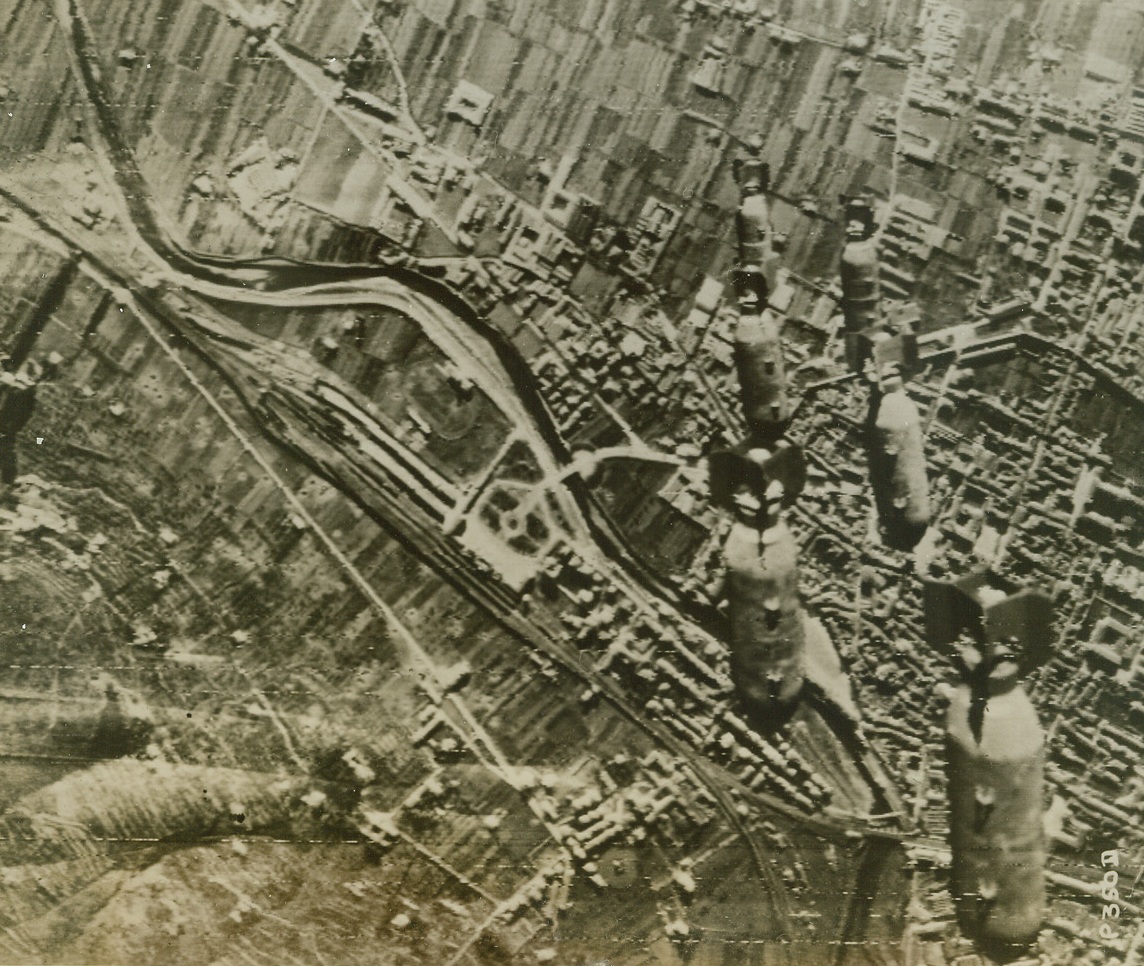
Bombs Away, 1/5/1944. PRATO, ITALY—Hurtling through Italian skies, the bombs from American B-26 medium bombers raiding Prato zooms toward that town’s marshalling yards. A few moment’s later, as our explosives found their Axis target, smoke and flame covered the entire area. Credit: SIGNAL CORPS RADIOTELEPHOTO from ACME.;
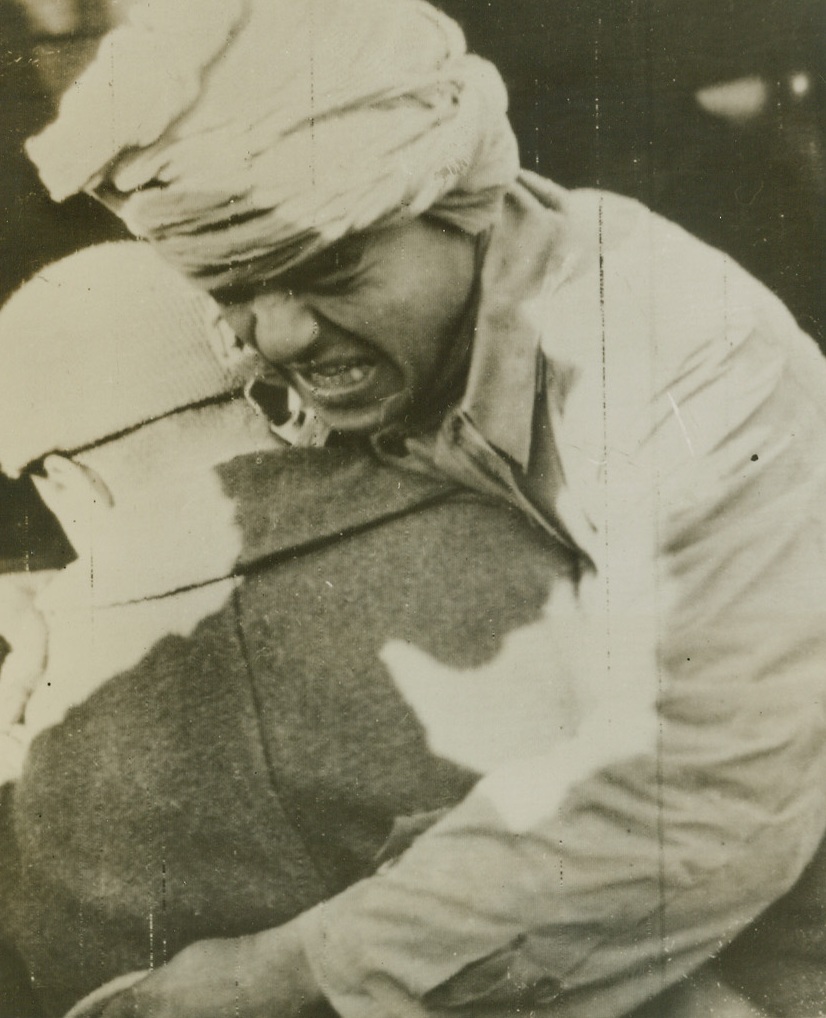
Pain, 1/5/1944. WITH THE FIFTH ARMY -- Wounded while fighting with the Allied Fifth on the Italian front, a French Goumier grimaces with pain as he is carried from an ambulance to an emergency dressing station close behind the lines. Photo radioed to New York from Algiers Jan. 5, 1944. Credit: STARS AND STRIPES PHOTO via OWI-ACME.;
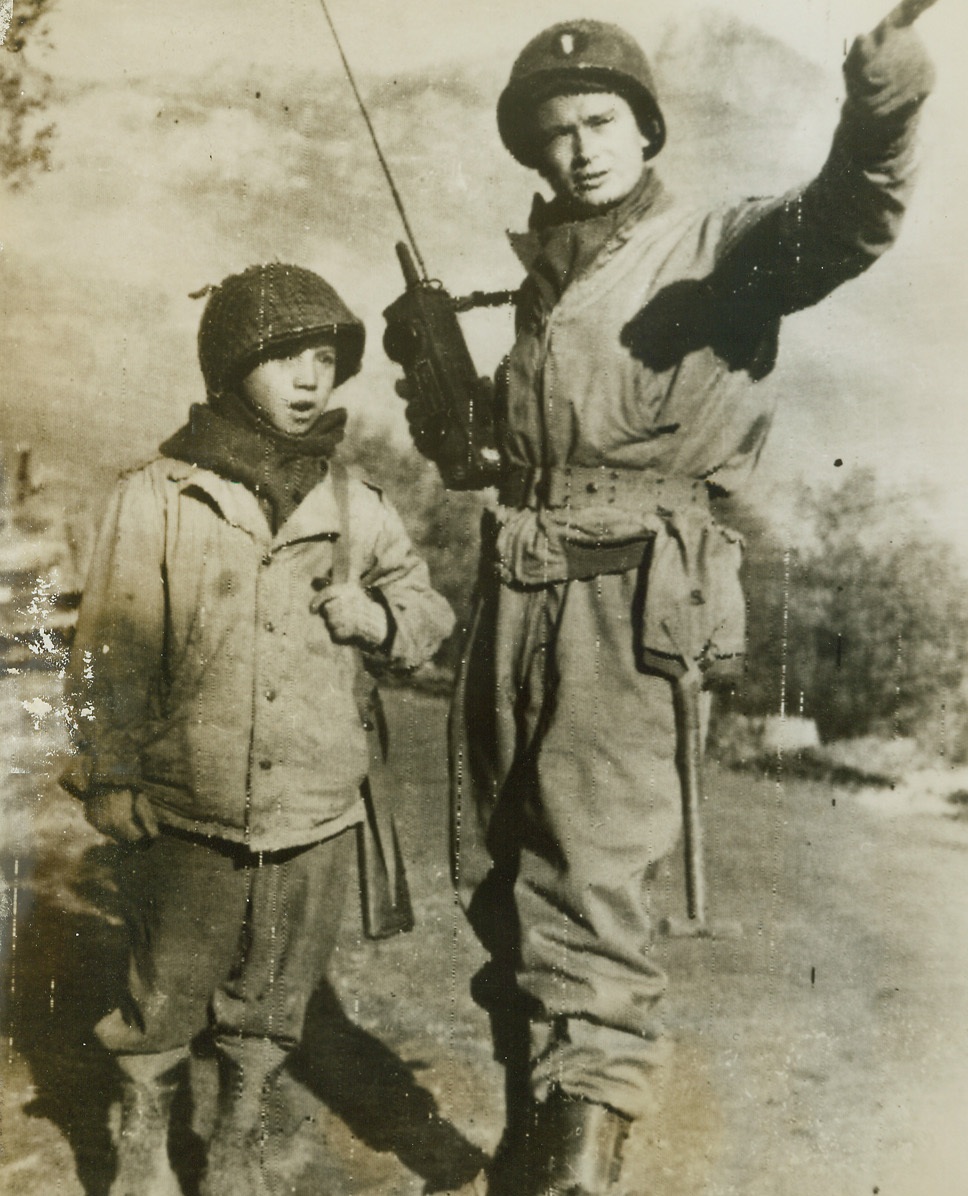
Mascot of the Yanks, 1/5/1944. ON THE FIFTH ARMY FRONT -- The only member of his family who survived the bombing of Avaline, ten-year-old Tony Mao has been adopted by Yanks of the Fifth Army. Strictly “G.I.” in clothing and conversation, the little boy gets directions for an errand from Lt. Anderson Smith of Barnesville, Ga. Credit: OWI RADIOPHOTO from ACME;
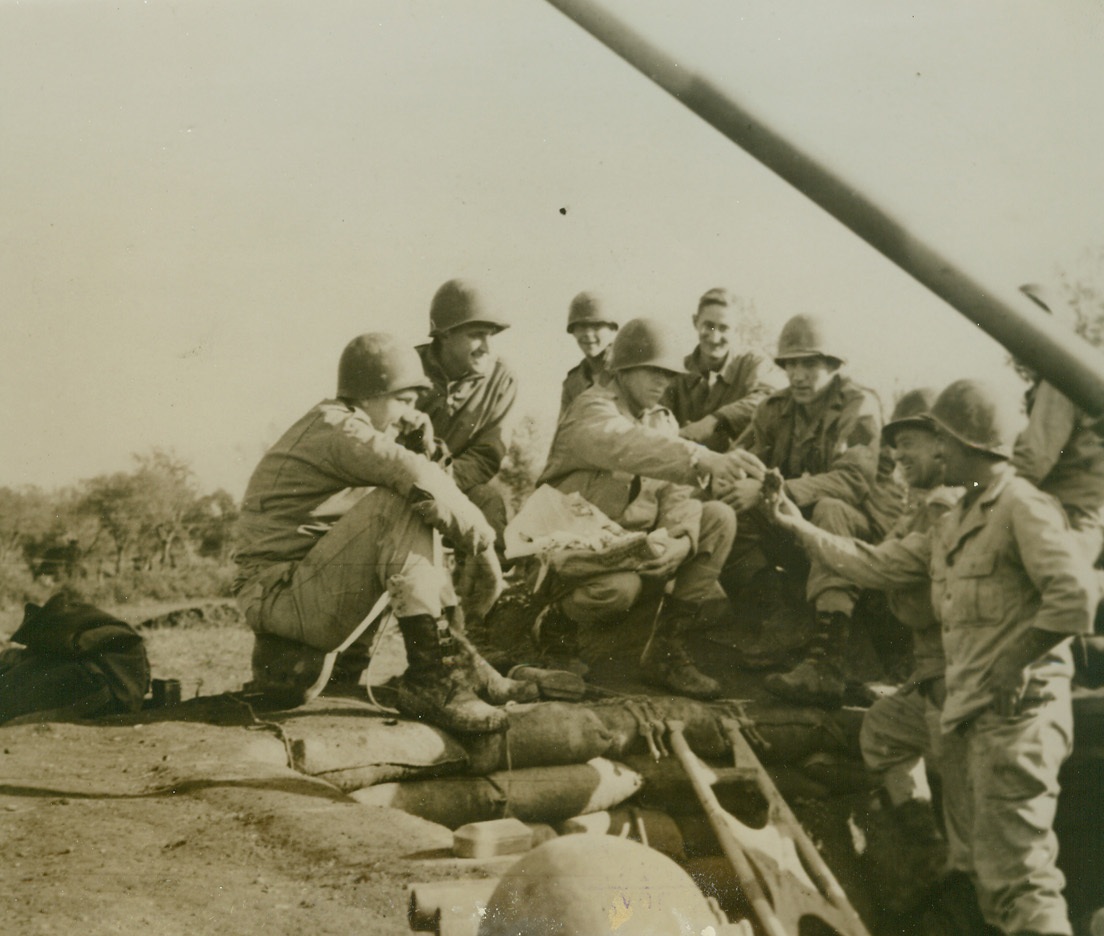
Sharing His Luck, 1/5/1944. ON THE ITALIAN FRONT -- Pfc. Paul Sugalski of Glen Lyon, Pa., shares a Christmas fruit cake, fresh out of the mail bag, with his U.S. Fifth Army buddies. Left to right: Pfc. Walter Samerdek, Central Falls, R.I.; Cpl. Walter Hammer, Brooklyn, NY; Pfc. George Denmeade of Struthers, Ohio; Pfc. Sugalski; Pfc. Arthur Smith, Providence, R.I.; Sgt. Jeff D. Dermid, Jr., Asheville, N.C.; Pvt. Leonard Hickey, Glen Falls, NY; Pfc. Vincent Cavallario, Watertown, N.Y.; and partly hidden by the gun at far right, Clead Fitzpatrick of Ganado, Texas. Credit: ACME;
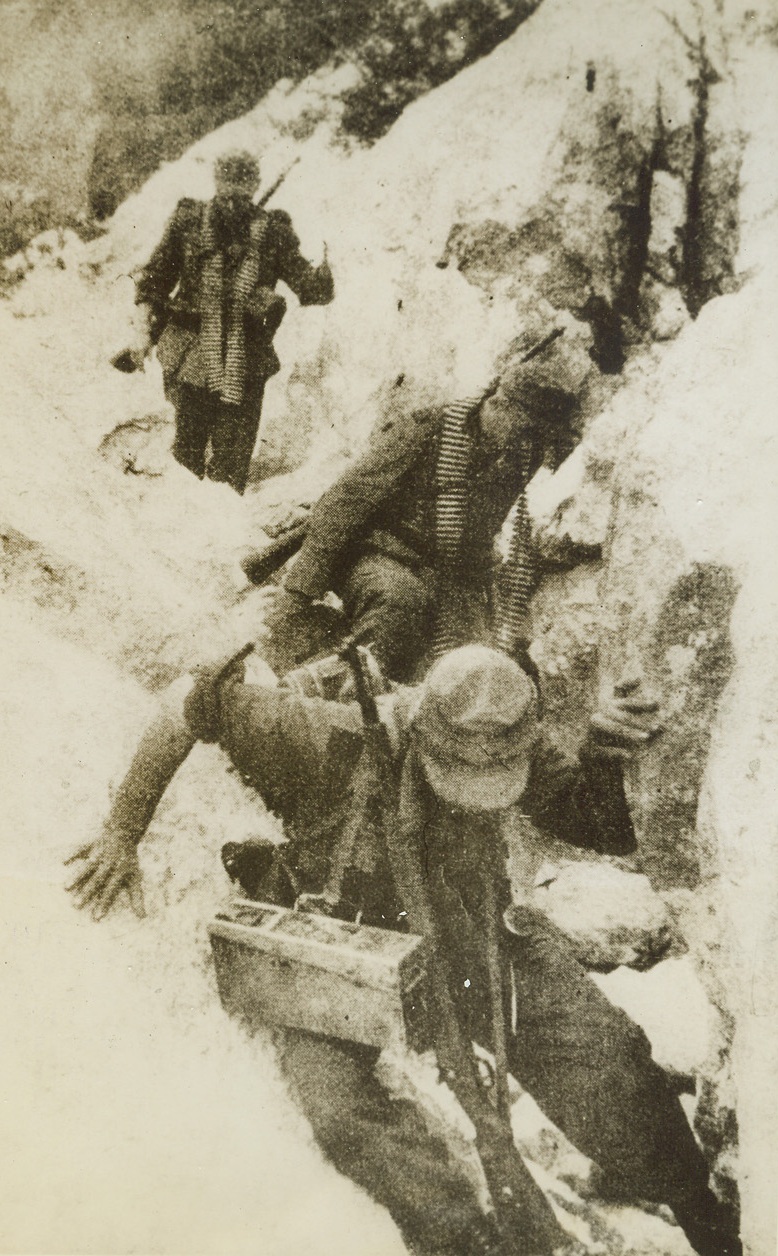
Mountain Climbing Nazis, 1/16/1944. YUGOSLAVIA—Making a shabby showing against the Yugoslav partisan forces led by General Tito, these Nazi warriors are having plenty of trouble with the terrain in which the Guerillas force them to fight. It’s a slippery dangerous trip for these Germans, as they stumble through the snowy mountains of Montenegro photo was obtained through a neutral source. Credit: ACME.;
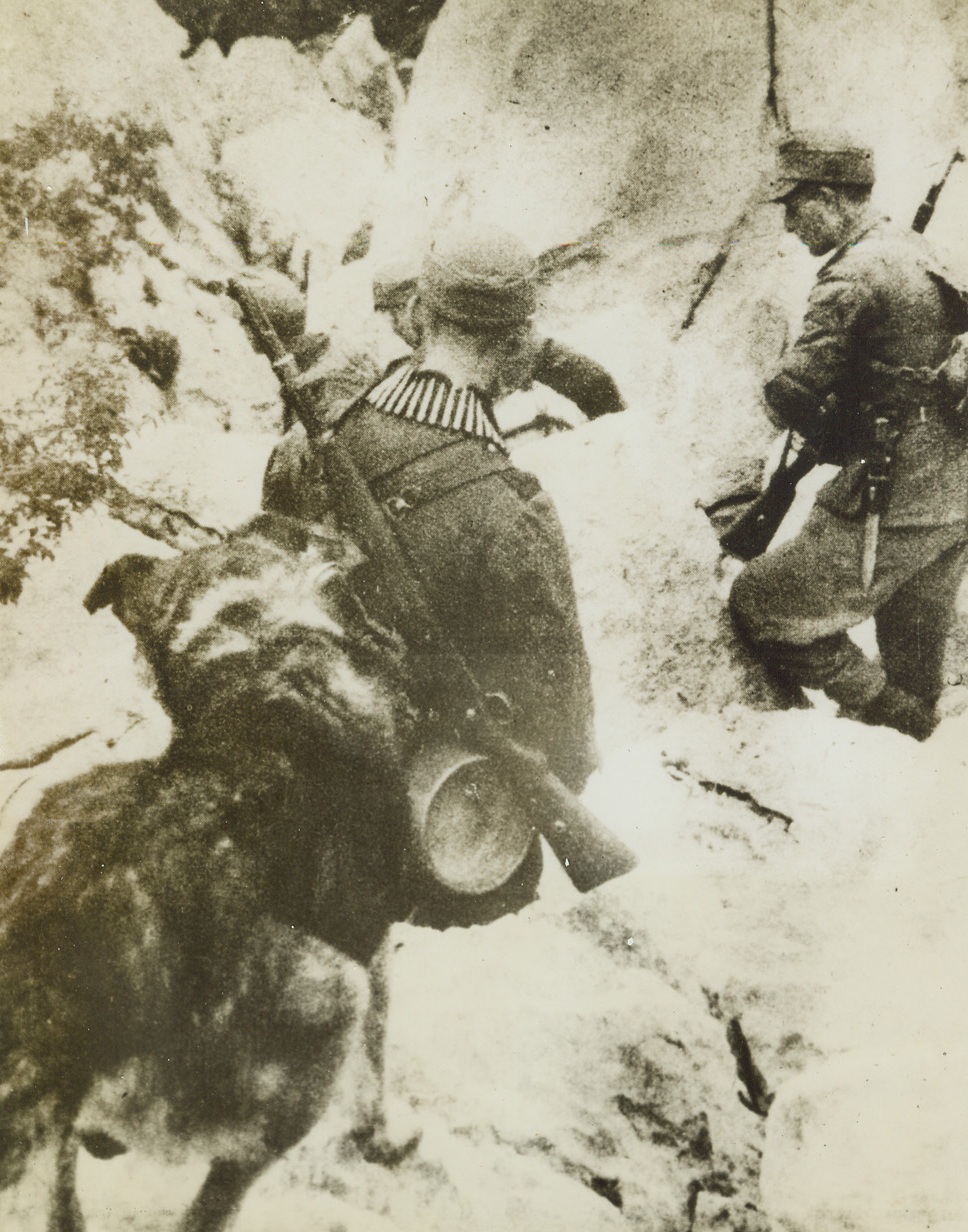
Slippery Trip for Nazis, 1/16/1944. YUGOSLAVIA—Slipping and sliding over the snowbound rocks, a German scout dog follows his Nazi masters as they make their way across the heights of Montenegro, where General Tito’s guerilla forces are making things mighty hot for the Fascist forces. Photo obtained through a neutral source. Credit: ACME.;
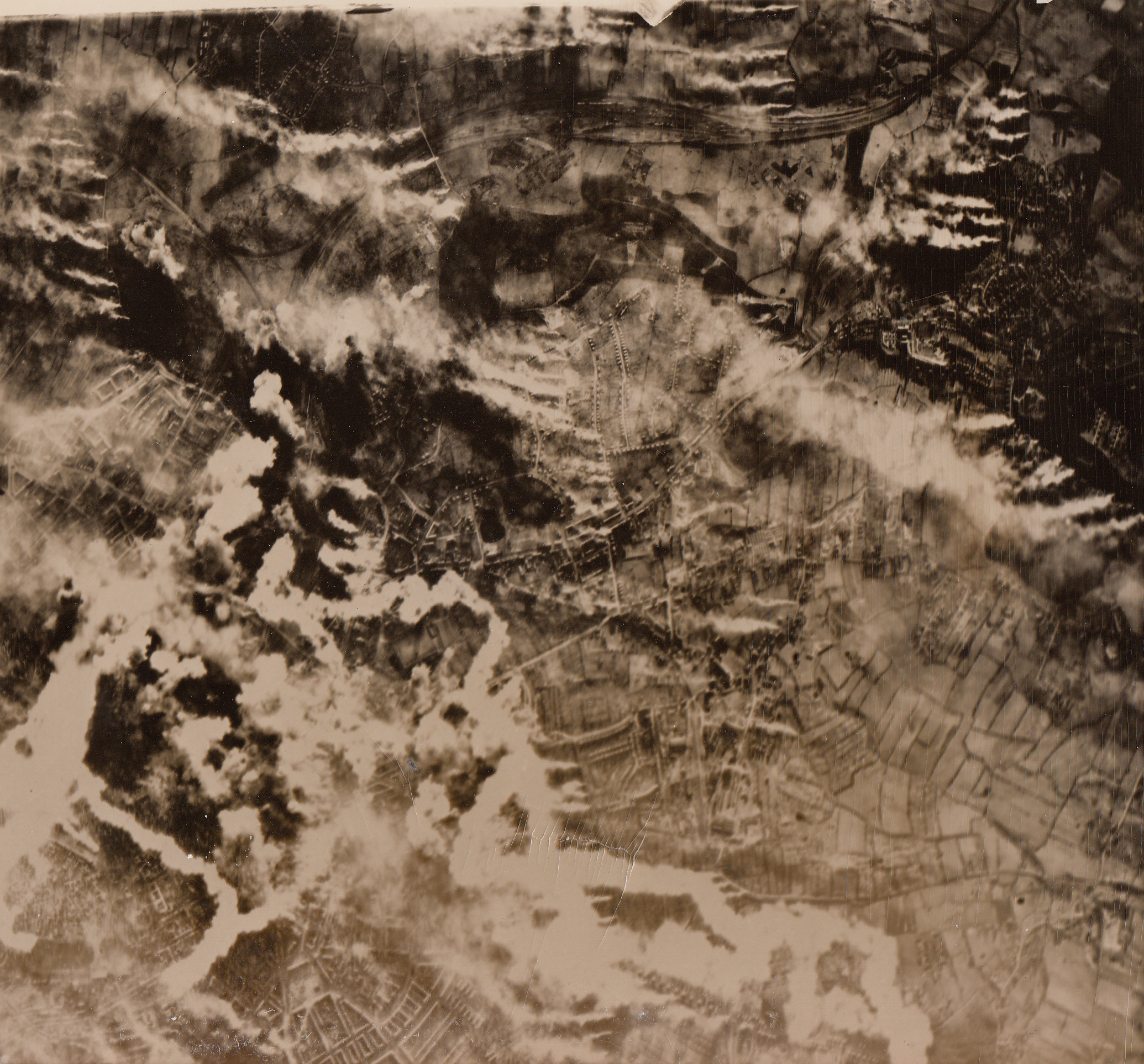
Kiel Raided, 1/17/1944. GERMANY—Swirling, billowing clouds of smoke rise from bomb battered Kiel as Eighth Air Force Flying Fortresses and Liberators rained thousands of fire bombs down on the German U-boat and shipyard center during an attack on the 5th of January.;
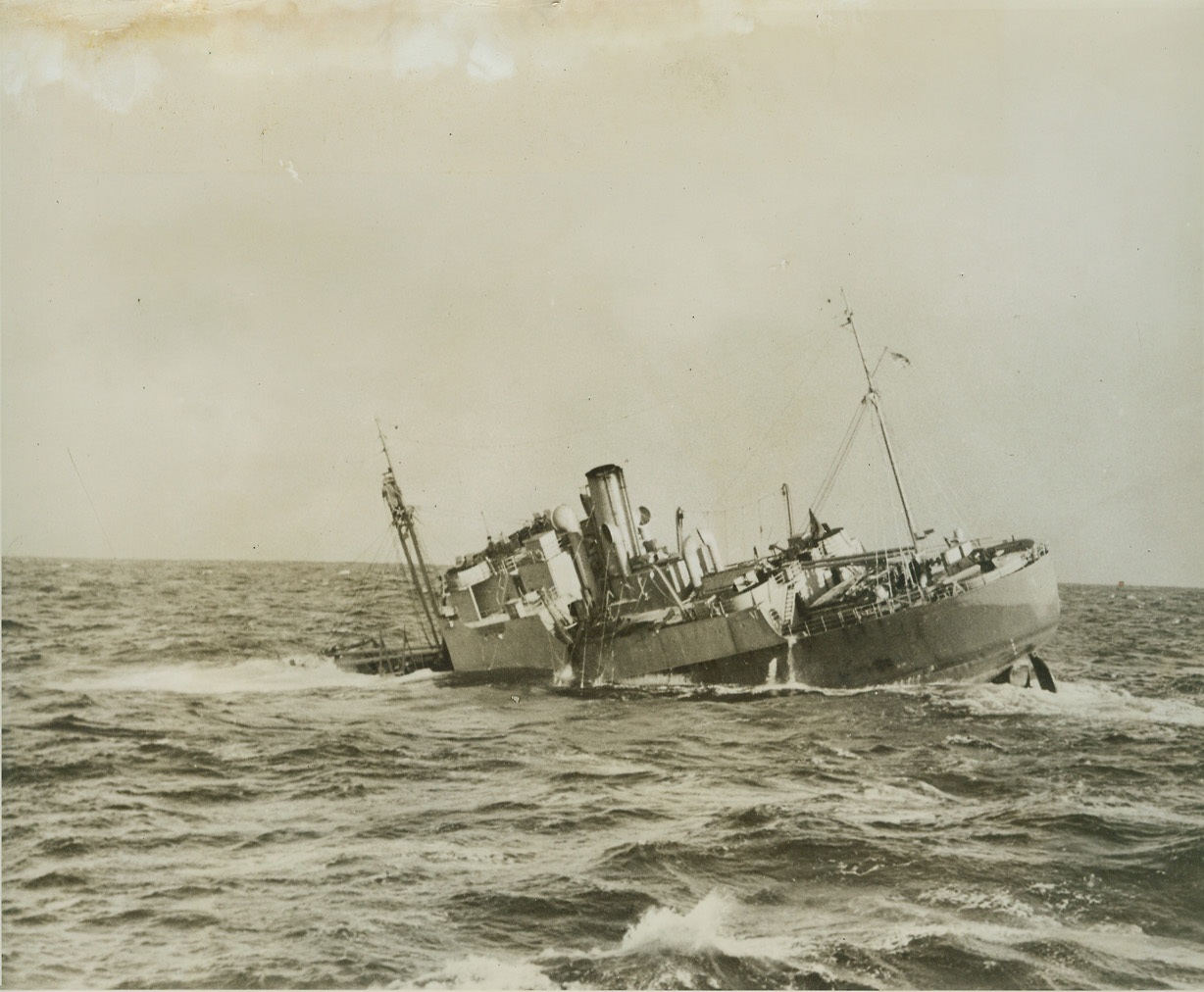
Headed For Davy Jones' Locker, 1/19/1944. NORTH ATLANTIC -- Here is the Army freighter Nevada, pictured during her last few moments from the deck of the Coast Guard Cutter Comanche. The Comanche managed to rescue 29 survivors from the sinking ship which went down during a violent gale off the North Atlantic Coast last month. Thirty-four men were lost, including the Nevada's commanding officer, Captain George P. Turiga of Beacon, N.Y. Credit: (Official Coast Guard Photo - ACME);
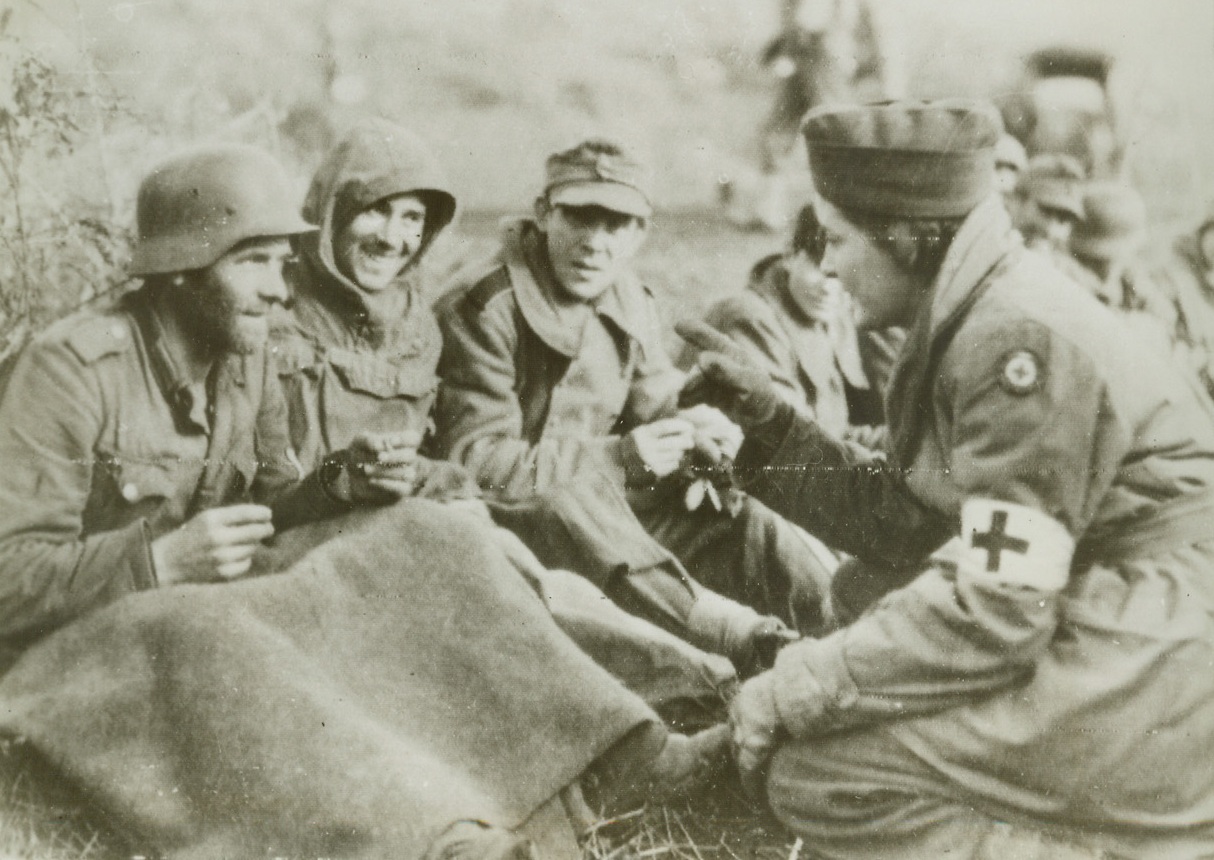
PRISONERS SMILE, 1/18/1944. SOMEWHERE IN ITALY—A French girl ambulance driver, serving with the Fifth Army in Italy, wins a smile from these captured German warriors taken by French troops. Forsaken by their comrades, the Nazis appreciate the kind treatment given them by Allied mercy workers. Photo radioed from Algiers today (Jan. 18th).Credit: Acme Radiophoto;
![COVERING ALLIED BEACHHEAD NEAR ROME, 1/25/1944. An [sic] plane of the U.S. Army Air Forces flies protectively over the spot south of Rome where Allies have made new landings bypassing German forces in the Cassino area. Far below can be seen craft landing American and British supplies and reinforcements. Today, the Germans abandoned Cassino to the Allies.Credit: Acme photo by Charles Seawood for the War Picture Pool via Army Radiotelephoto;](/media/13932/77091692.jpg)
COVERING ALLIED BEACHHEAD NEAR ROME, 1/25/1944. An [sic] plane of the U.S. Army Air Forces flies protectively over the spot south of Rome where Allies have made new landings bypassing German forces in the Cassino area. Far below can be seen craft landing American and British supplies and reinforcements. Today, the Germans abandoned Cassino to the Allies.Credit: Acme photo by Charles Seawood for the War Picture Pool via Army Radiotelephoto;
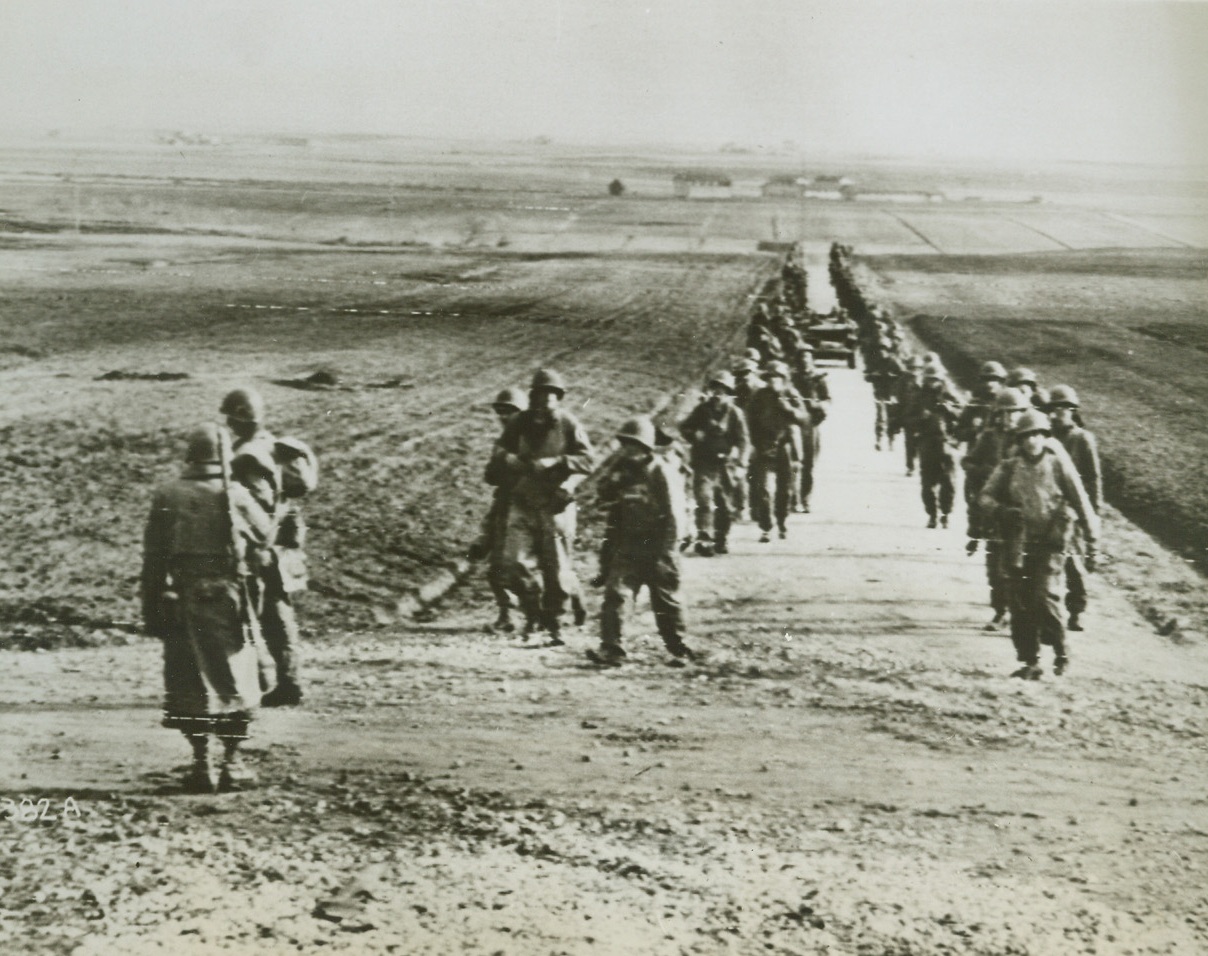
WIDE OPEN AND PLENTY DANGEROUS, 1/29/1944. NETTUNA, ITALY—Fifth Army troops move a few miles inland from their beachheads established near Nettuno, on the road to Rome. Flat level plains are the battlegrounds where the Allies are making slow but sure progress toward their goal.Credit: Acme photo by Bert Brandt, via Signal Corps Radiotelephoto;
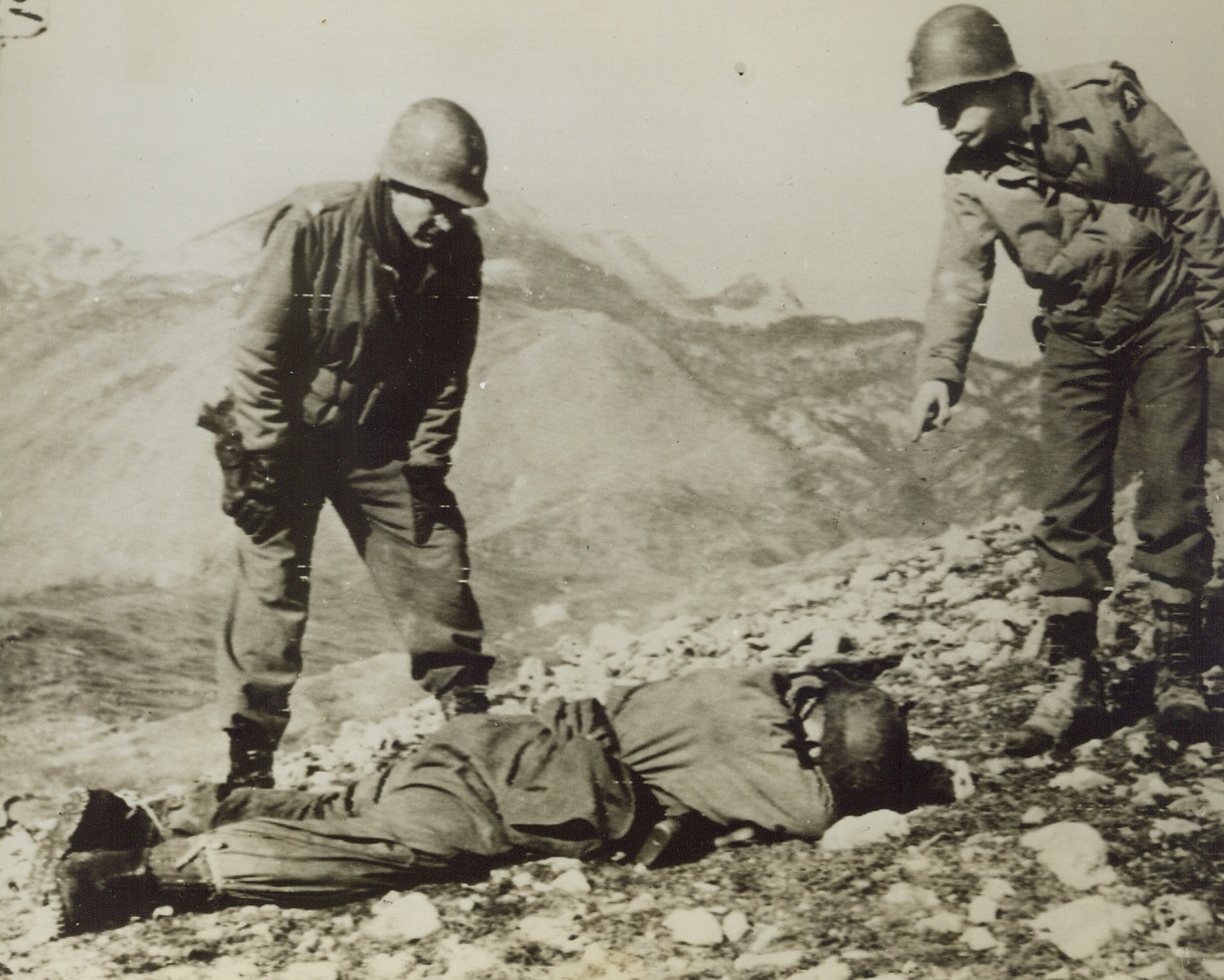
DEATH ON THE ROAD TO ROME, 1/18/1944. CERASUOLO, ITALY—His fleeing comrades left this German soldier to be buried by the Allies, as the Nazis beat a hurried retreat in the Cerasuolo area. The dead German was found by Lt. Col. H. I. Ketchum (left) of Abbottsford, Wisc., and Captain R. L. Johnson, of a field artillery battalion, who were on a reconnaissance mission.Credit: Signal Corps Radiotelephoto from Acme;
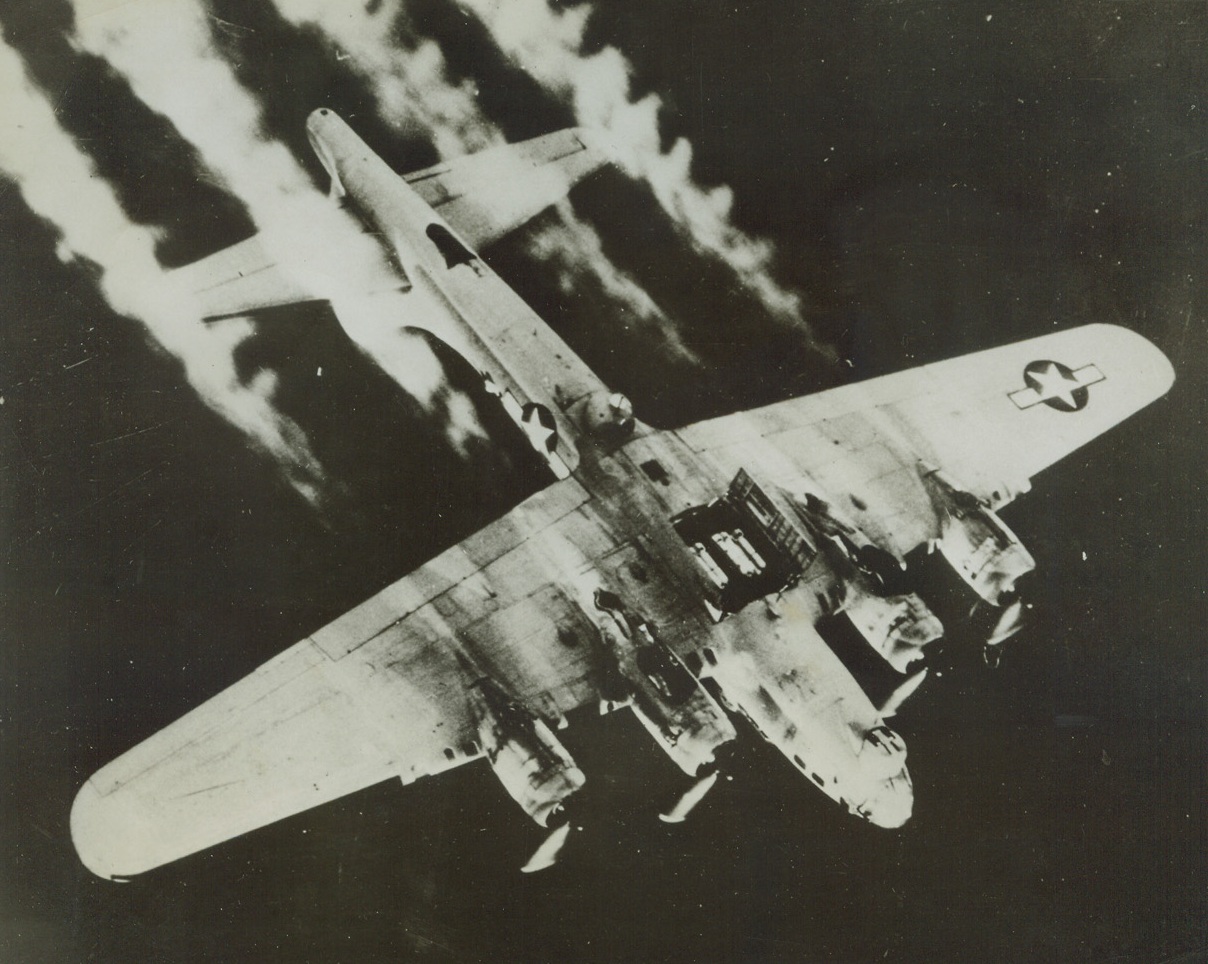
CLOSE-UP OF HITLER’S HEADACHE, 1/9/1944. GERMANY—With its bomb bay doors open, a Flying fortress streaks somewhere over Germany ready to drop its load of death and destruction on Hitler’s war-producing territory. A few second after this photo was taken, the bombs went whistling earthward to sound another note in Hitler’s death march. This remarkable picture was taken during a recent raid by U.S. Eighth Air Force Liberators and Forts.Credit: Acme;
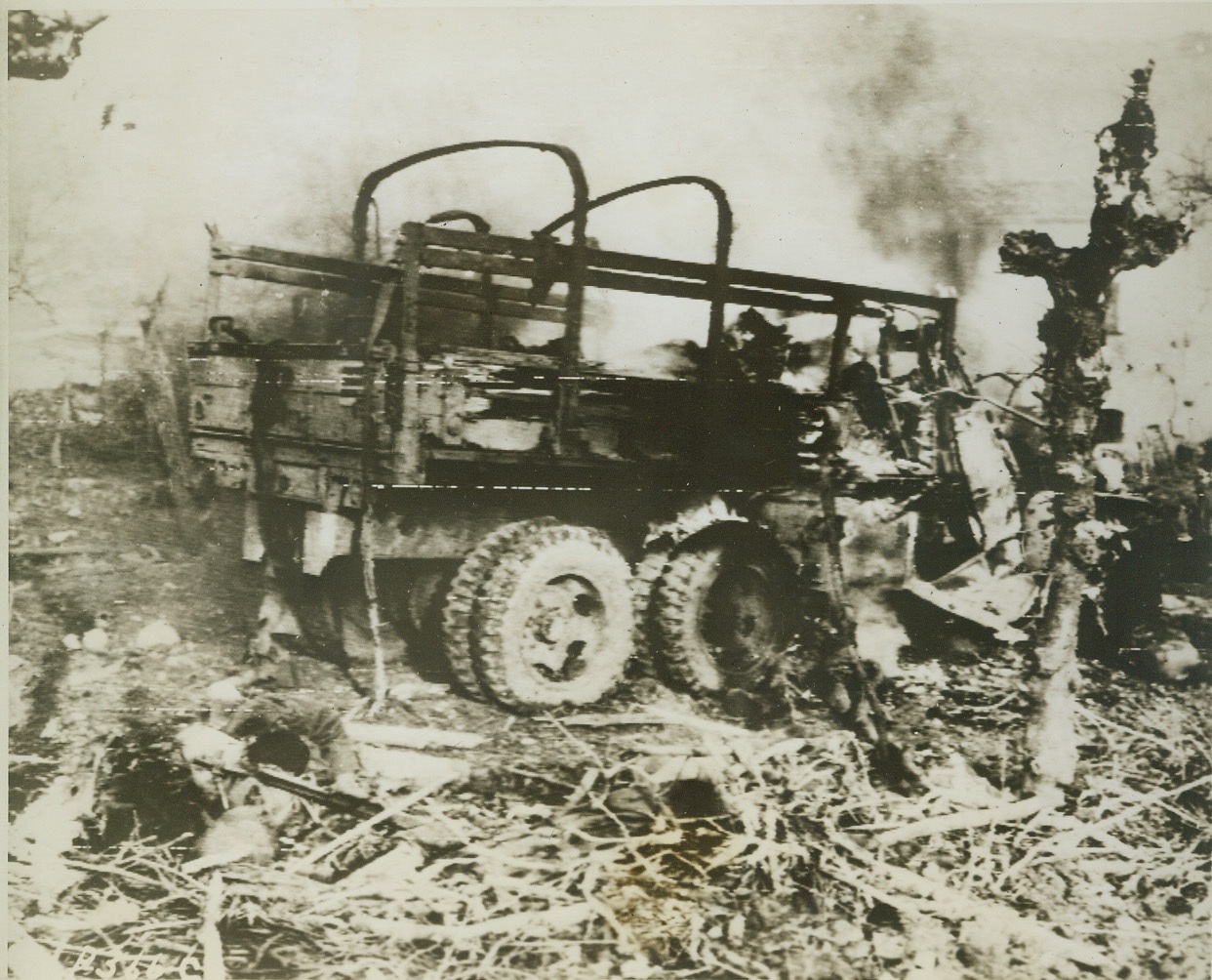
Funeral Pyre for Prisoners, 1/18/1944. SOMEWHERE IN ITALY -- This burning truck became a funeral pyre for German prisoners of war, who were riding into captivity when the truck was bombed and strafed by Nazi planes. The body of one of the prisoners who tried to escape from the flaming truck can be seen at lower left. Credit (U.S. Signal Corps Radiotelephoto - ACME);
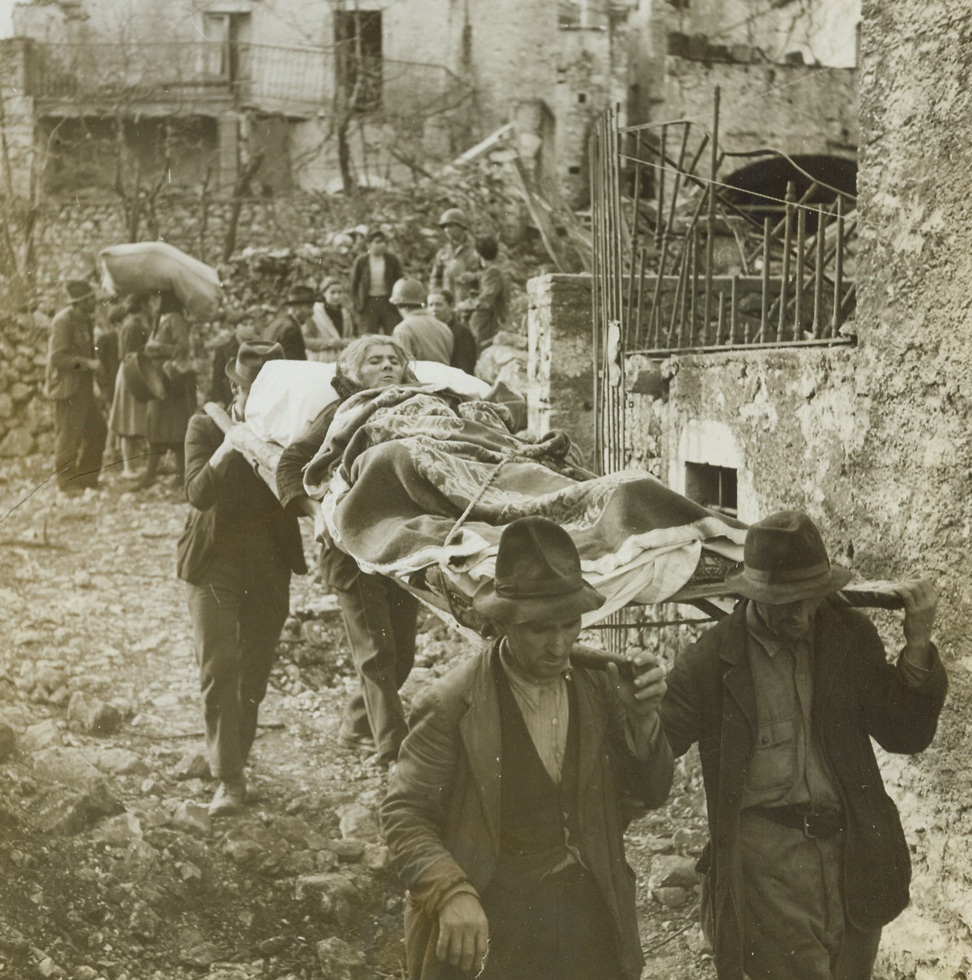
Return of the Natives, 1/1/1944. LAGONE, ITALY -- Scene of many days of bitter fighting, the tiny mountain town of Lagone fell to warriors of Lt. Gen. Mark Clark's Fifth Army, and the smoke of battle had hardly cleared before hundreds of natives flocked down from the hills to return to their homes. The pathos of their tragic homecoming to the wrecked, blasted buildings is recorded in this series, made by Acme correspondent Bert Brandt, for the War Picture Pool. Non-combatants all these men, women and children find that war is a very personal experience nevertheless: an experience that has left them with a deep, grim hatred for the Germans. New York Bureau Members of her family carry an old woman down from the hills on a crude stretcher. The woman's face mirrors the agony that the bumpy journey caused her. Credit - WP - (Acme Photo by Bert Brandt, War Pool Correspondent);
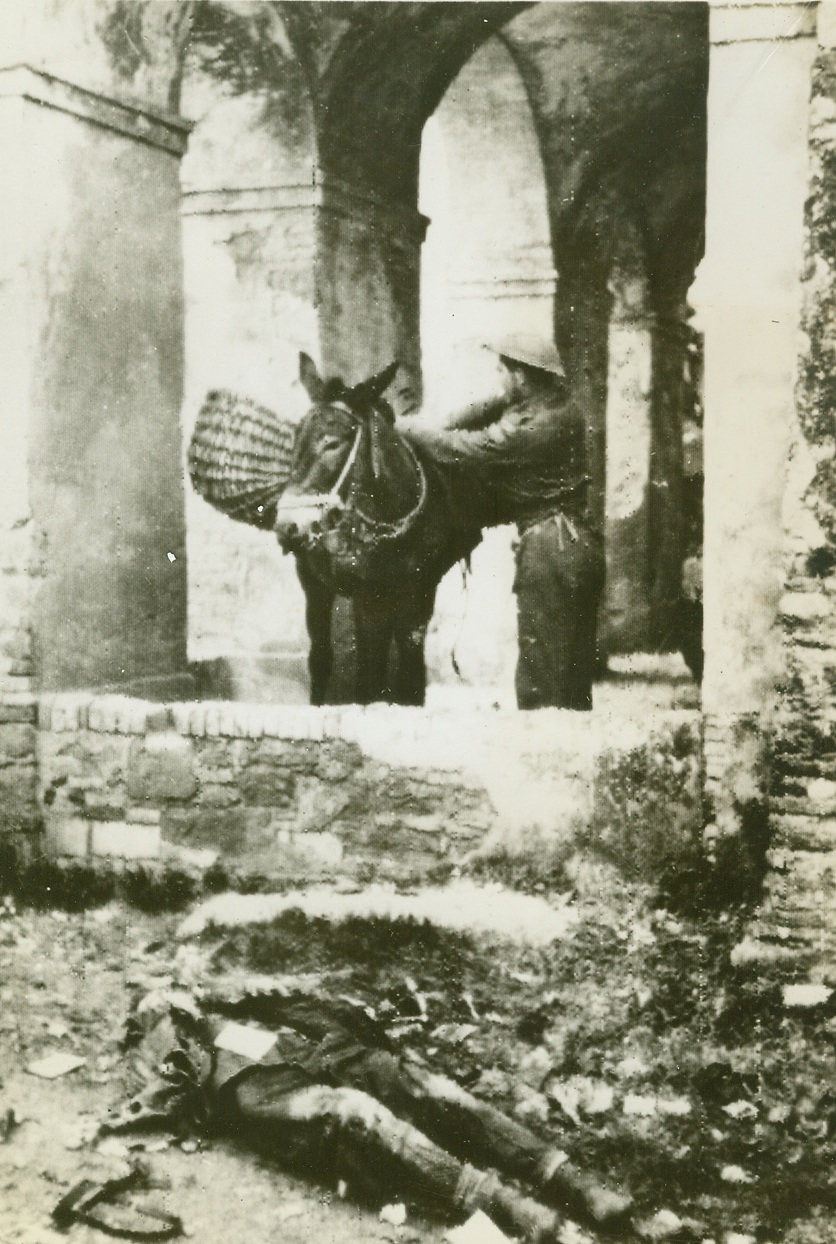
What’s Death to a Mule? 1/3/1944. Ortona, ITALY – With nonchalance only a mule can muster, this Italian beast of burden gazes at the body of a German corporal. Also indifferent to death is Pvt. G.M. Dodds., of Middleville, Ont., who harnesses the animal on the portico of a church in Ortona, Italy, the Adriatic coastal town wrested from the Germans after eight days of bitter house to house fighting.Credit (OWI Radiophoto from ACME);
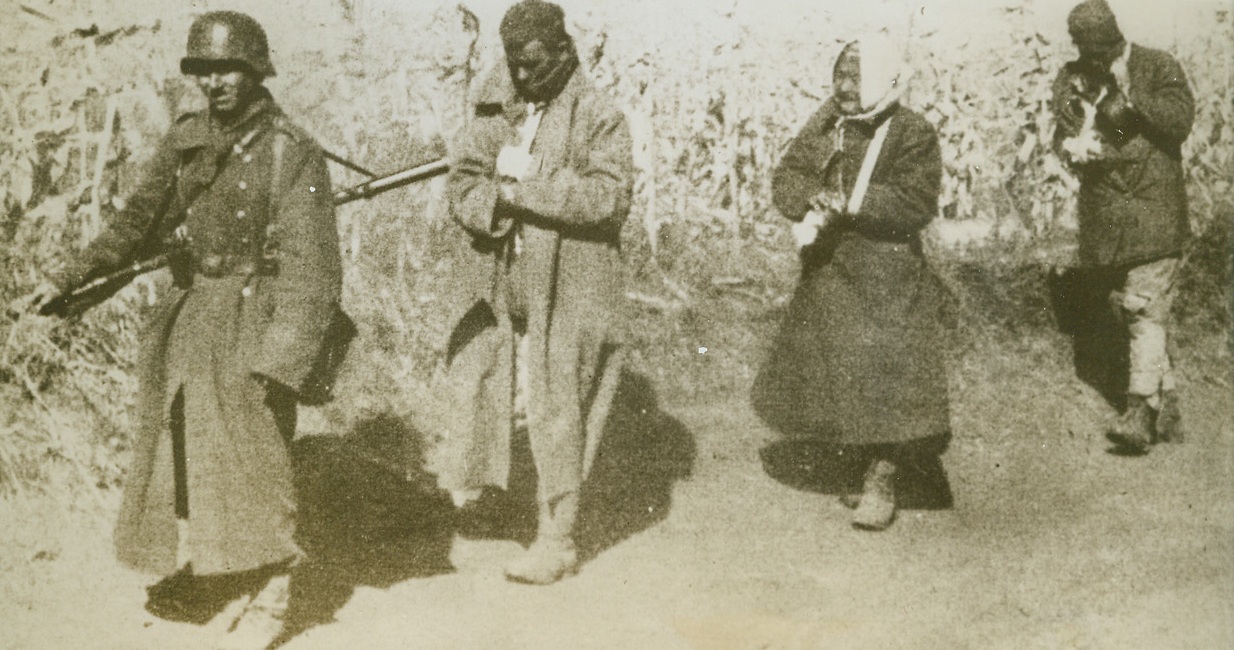
Prisoners of the Germans, 1/16/1944. SOMEWHERE IN RUSSIA – Two Soviet partisans, and one old woman rounded up with them, trudge wearily behind their Nazi captor, who takes them to headquarters for “questioning”. All badly wounded during fighting as the rear of German lines, the prisoners know that they can expect no mercy from Hitler’s men, who wince at the mere mention of Soviet guerillas. Photo obtained through a neutral source.Credit Line (ACME);
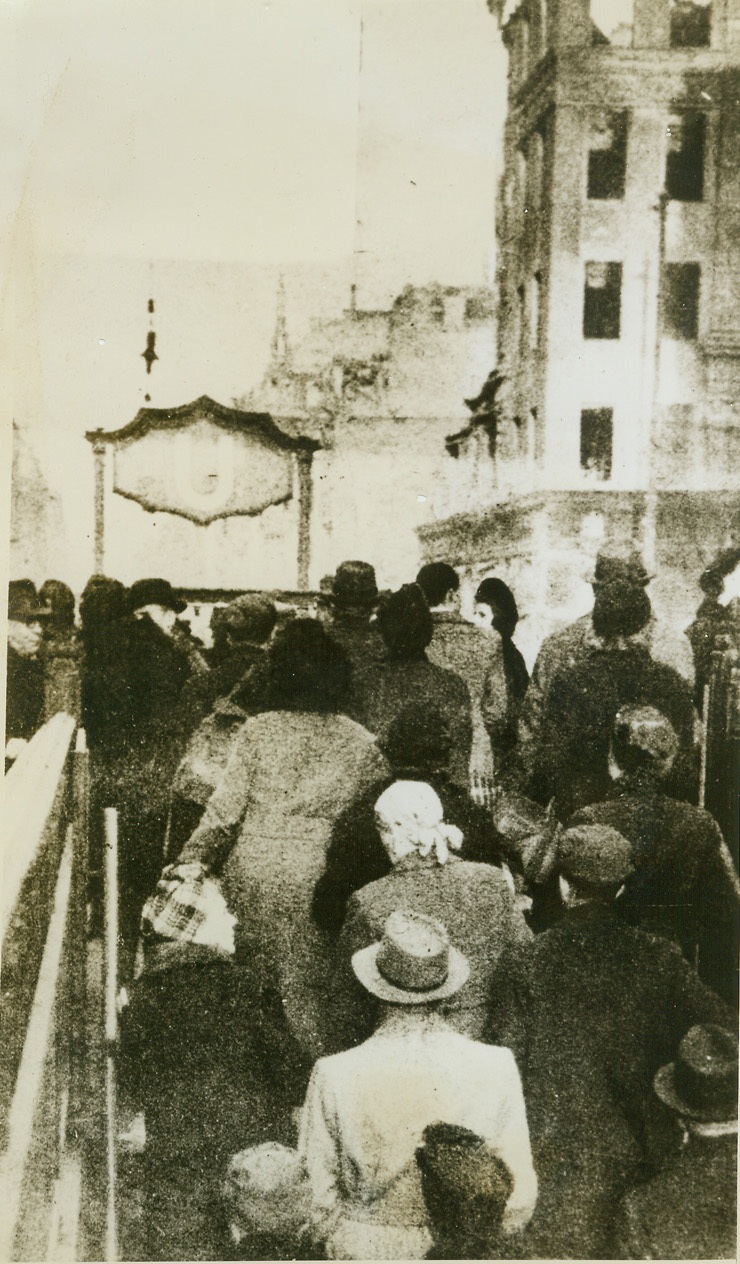
Out into the Daylight, 1/16/1944. BERLIN – Glad to find themselves alive after another heavy night-time pounding of Berlin, civilians climb wearily from air raid shelters into the chilly, bleak morning. Hurrying through the shattered streets, none will breathe easily until they reach their homes, which may have been leveled by Allied bombs. Photo obtained through a neutral source.Credit Line (ACME);
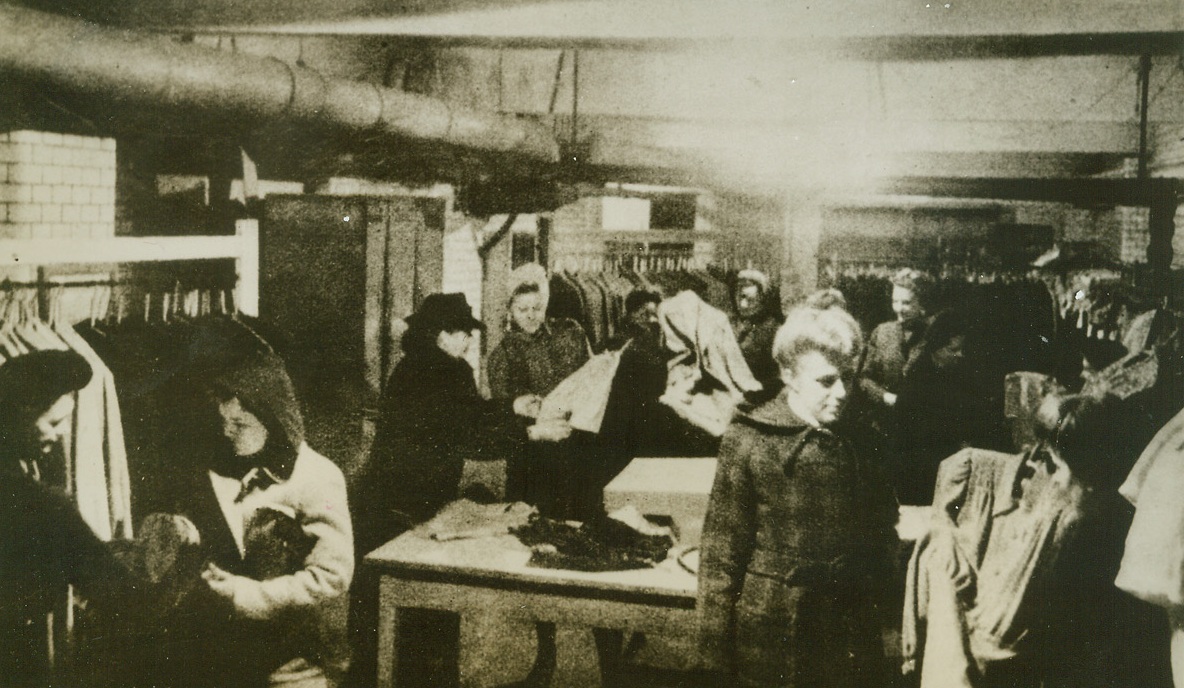
Cellar Shoppers, 1/16/1944. BERLIN – Shopping in the basement of a Berlin store, these German women aren’t bargain-hunting. It’s just about the only place they can shop in the bomb-blasted city. Retail store owners salvaging what they could from the piles of bombed shops, have moved to their cellars, where they still sell to a limited number of customers. Credit Line (ACME);
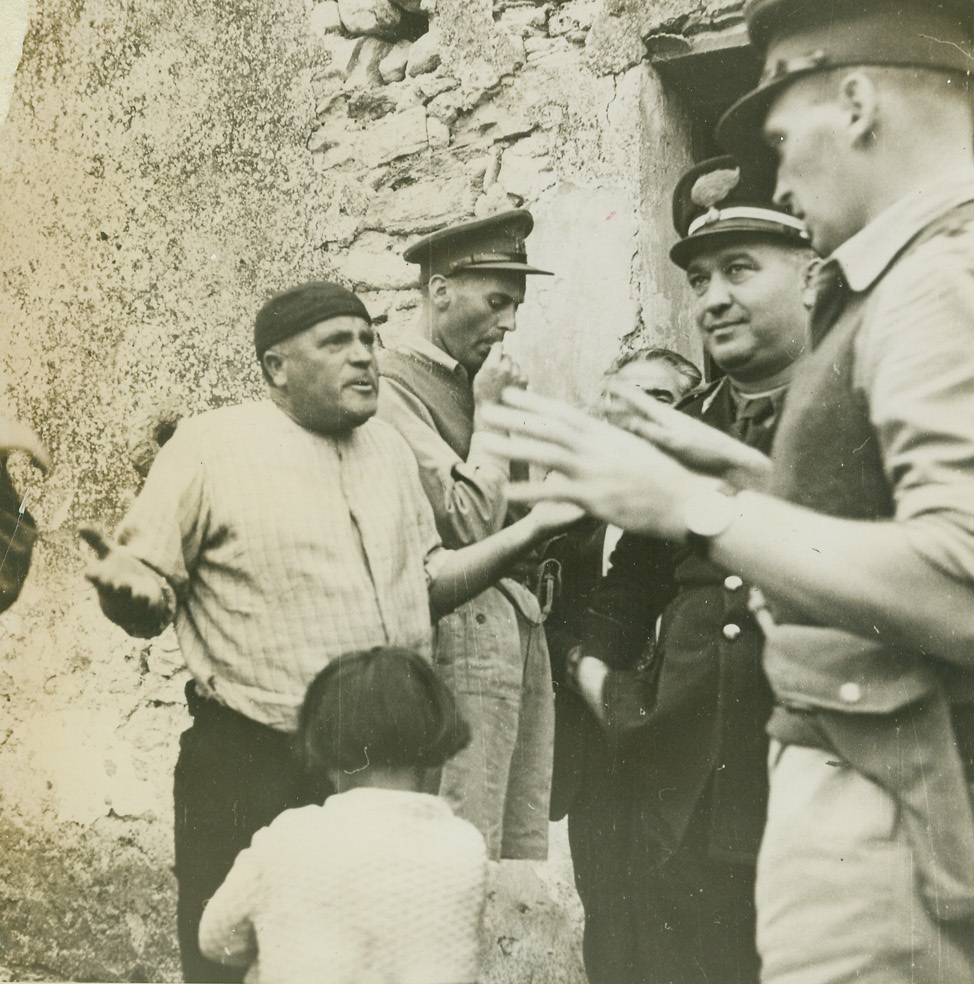
Suspected Hoarded, 1/15/1944. PALERMO, ITALY – Suspected of hoarding wheat, this Sicilian land owner vehemently protests an inspection of his storage bins by officials of the Allied Military Government in Palermo. But, the AMG, whose job it is to distribute food equally among civilians in occupied territories, went ahead and searched—to find that the suspect had declared only one-third of his wheat supply. The wheat was confiscated and hauled to a central storage bin. Later, a jury found the owner guilty of hoarding and the confiscation became permanent.Credit Line –WP – (ACME);
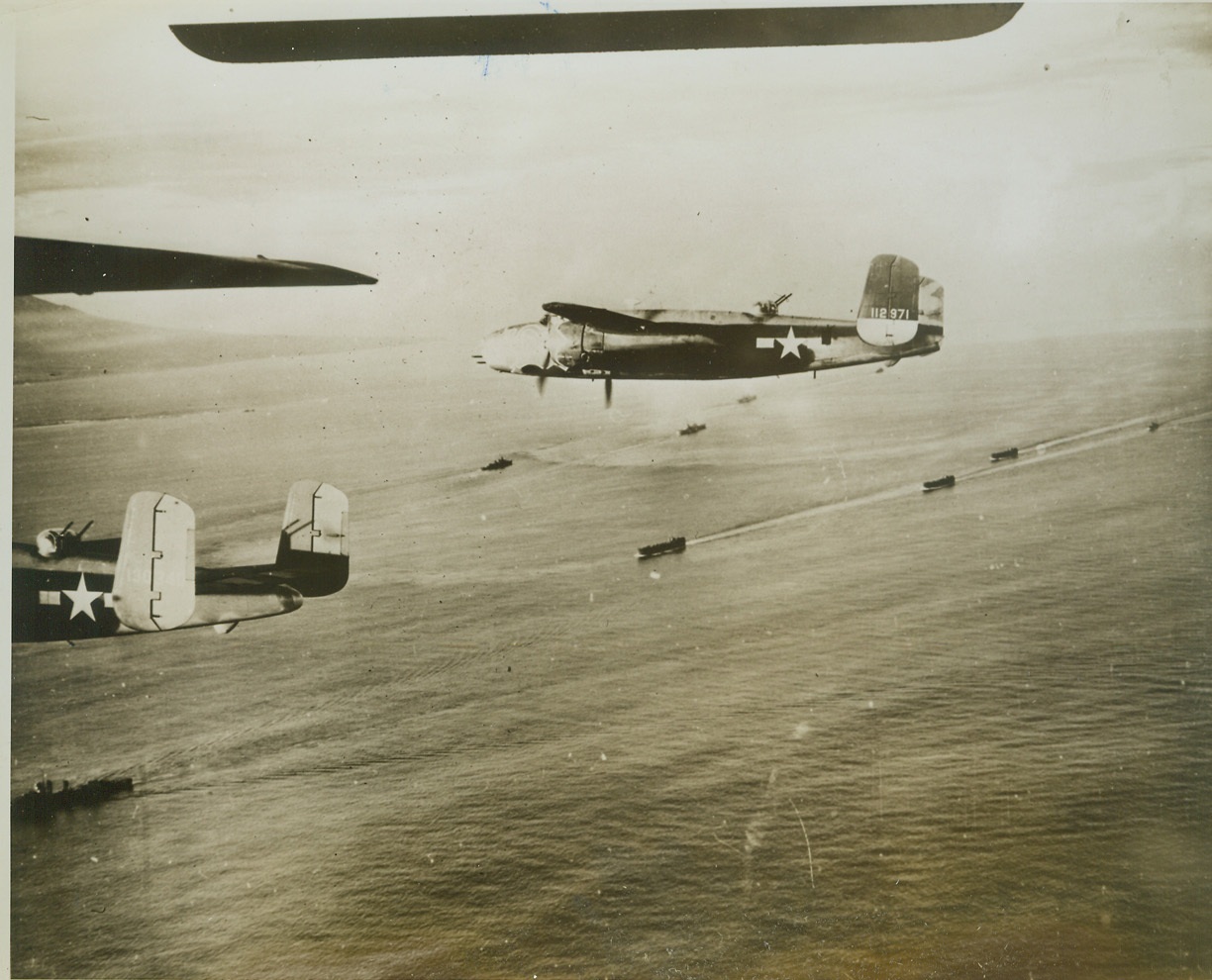
Mitchells Cover Gloucester Landing, 1/26/1944. This photo, released today in the U.S. shows B-25 Mitchell bombers of the U.S. Army 5th Air Force, covering Allied landing boats as they headed for a landing at Cape Gloucester on New Britain Island in the Southwest Pacific, Allied forces, after having neutralized Rabaul, important base on the island, are gradually closing in on the Japs there. Credit: (U.S. Army Air Force Photo from ACME);
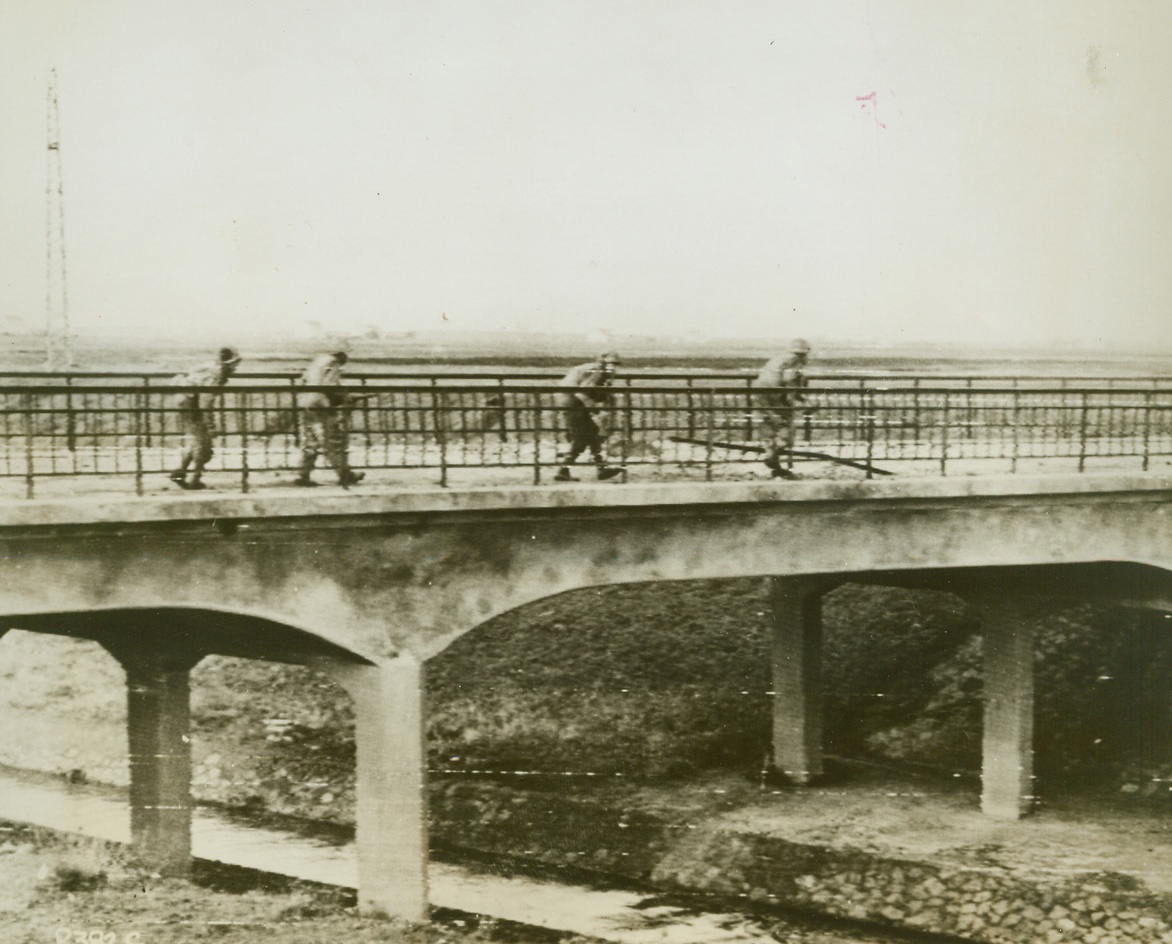
A treacherous bit of Road Toward Rome, 1/29/1944. NETTUNO, ITALY – With good reason, a Fifth Army infantry patrol feels alone and unprotected as it crosses a bridge over Mussolini Canal that leads into German territory. It’s a bit of action that may never go down in history but these men will remember it all their lives. Credit (Acme Photo by Bert Brandt, via Signal Corps Radiotelephoto);
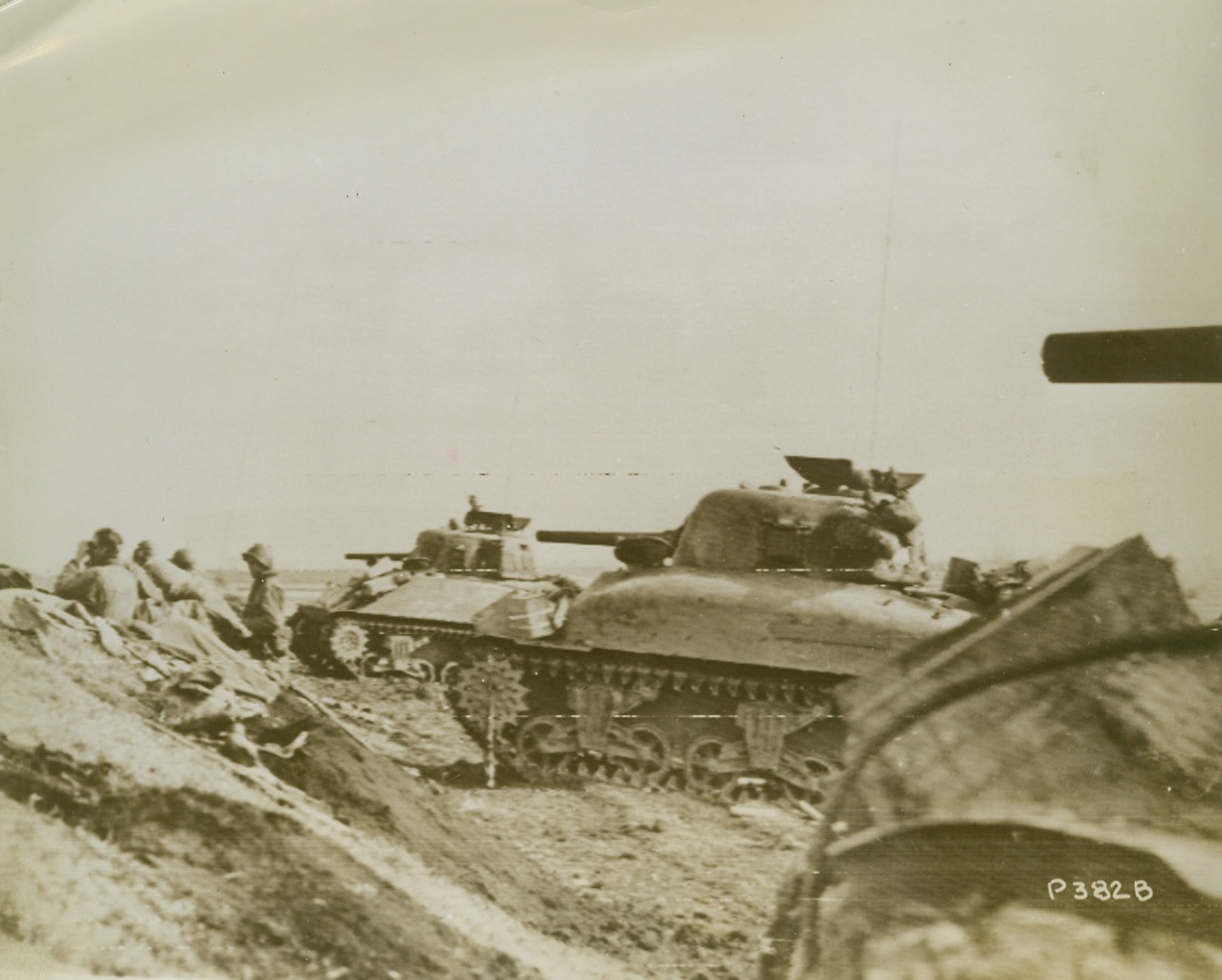
Keeping Track of the Nazis, 1/29/1944. NETTUNO, ITALY – Before advancing, Fifth Army tankmen leave their armored vehicles to scan the plains near Nettuno, Italy, for any signs of the enemy who were completely surprised by the Allied amphibious landings south of Rome. They park their war machines in a ravine in the Mussolini Canal sector of the new front.Credit (Acme Photo by Bert Brandt, via Signal Corps Radiotelephoto;
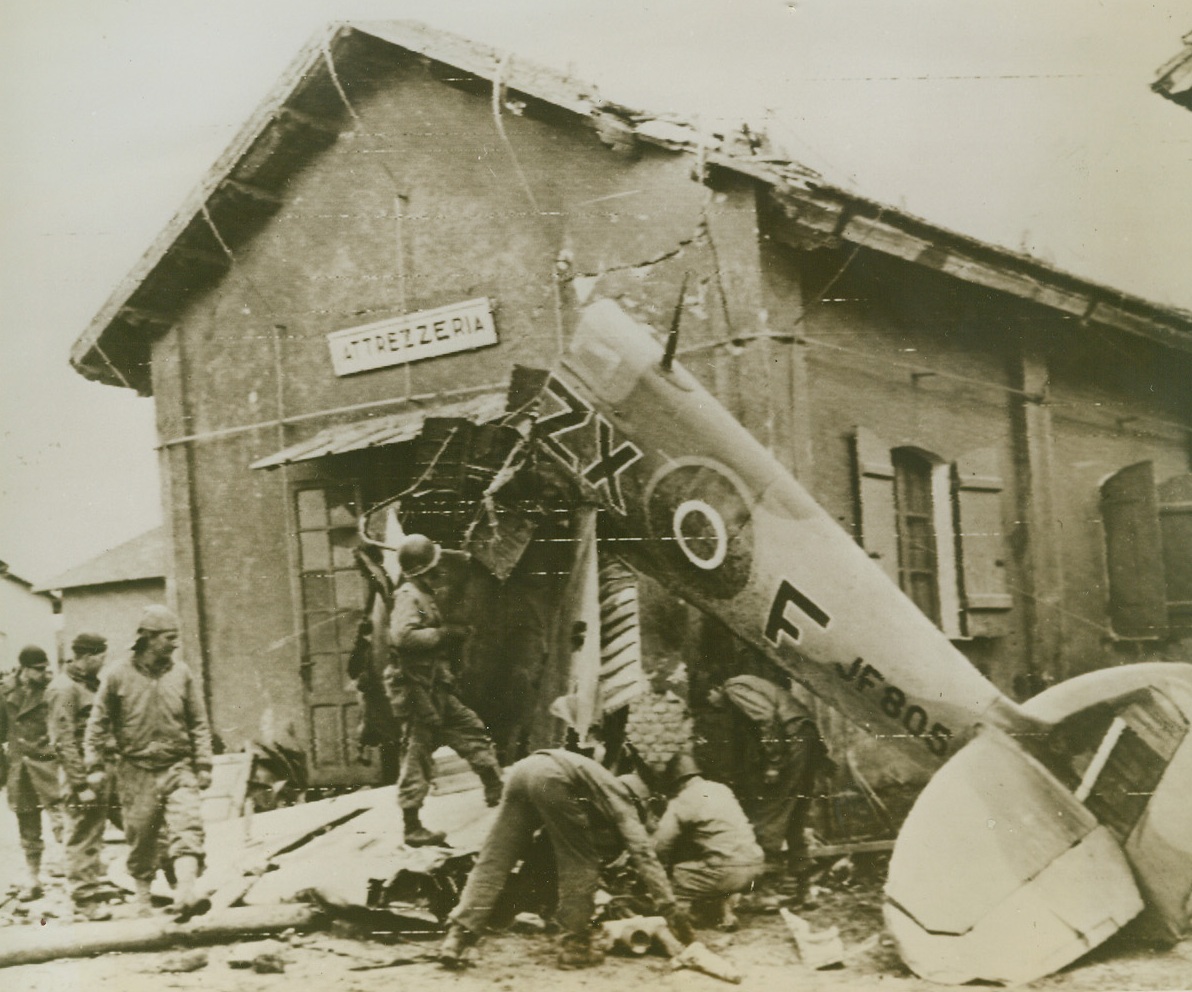
One of our Losses, 1/31/1944. WASHINGTON, D.C. – American soldiers examine the wreckage of a Spitfire which had crashed into a small building in the town of Attresseria, near Anzio, Italy.Credit (U.S. Army Signal Corps Radiotelephoto from Acme);
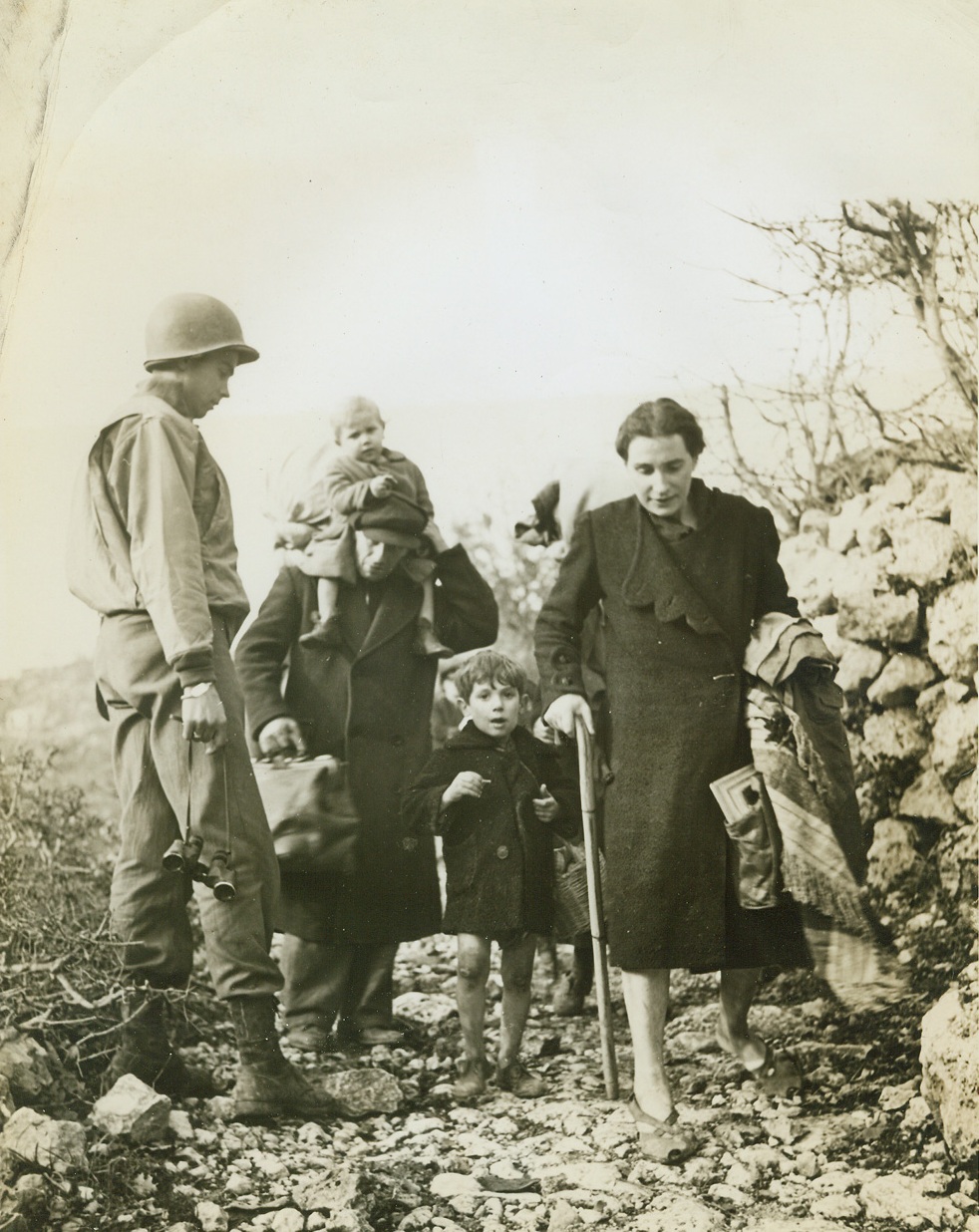
Return of the Natives, 1/1/1944. LAGONE, ITALY – Scene of many days of bitter fighting, the tiny mountain town of LaGone fell to warriors of Lt. Gen. Mark Clark’s Fifth Army, and the smoke of battle hardly cleared before hundreds of natives flocked down from the hills to return to their homes. The pathos of their tragic homecoming to the wrecked, blasted building is recorded in this series, made by Acme correspondent Bert Brandt for the War Picture Pool. Non-combatants all these men, women and children find that war is a very personal experience nevertheless: an experience that has left them with a deep, grim hatred for the Germans.New York BureauA tiny tot rides atop his father’s shoulders, and his mother walks with a cane as this family returns from the hills. At left is Lt. Harry McKinnon of Charlotte, N.C., who is in charge of a group of combat engineers.;
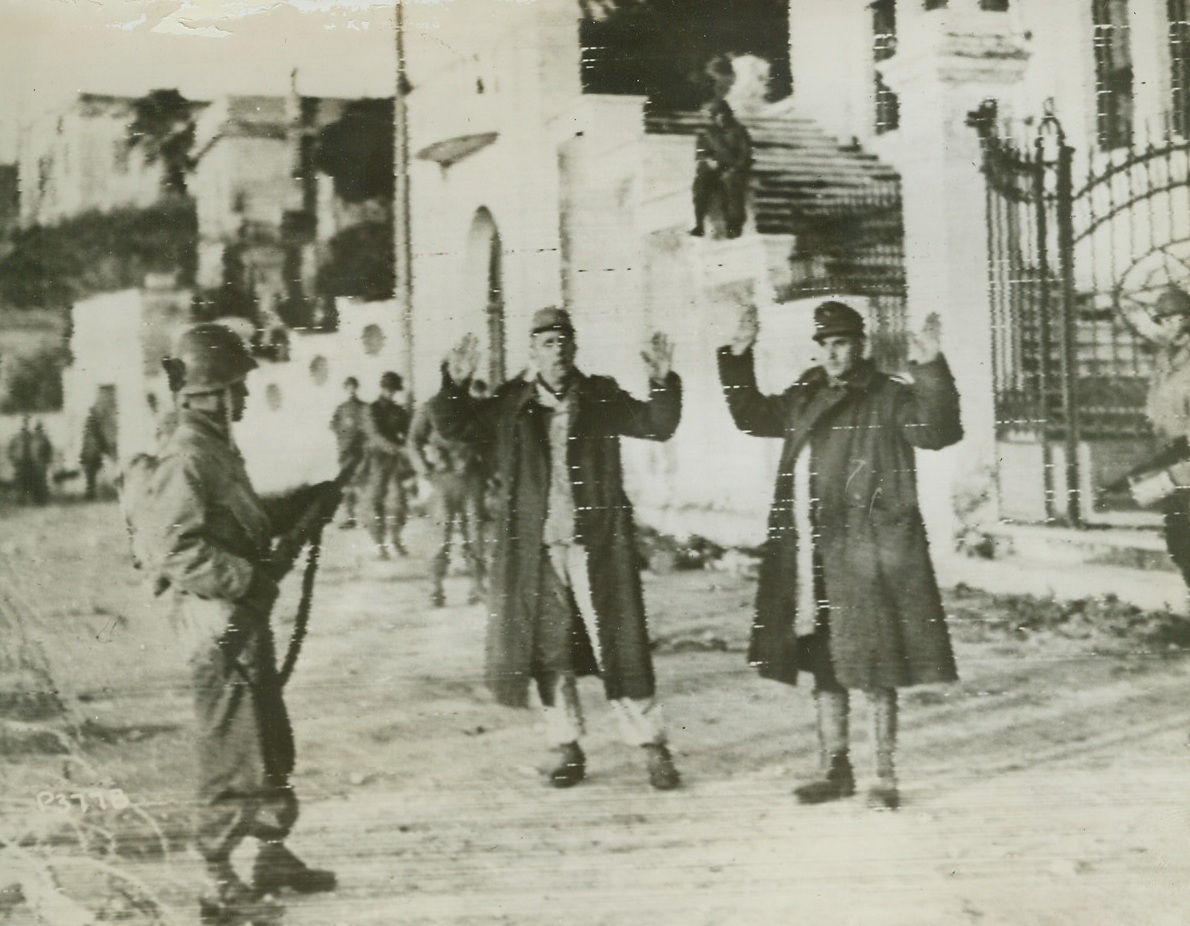
NAZIS SURRENDER, 1/27/1944. NETTUONO, ITALY—Holding their hands high, a pair of Nazis surrender to Fifth Army men in Nettuono. Our fighters reached the town shortly after making their surprise landing at Anzio, Italy. Credit: U.S. Signal Corps radiotelephoto from Acme;
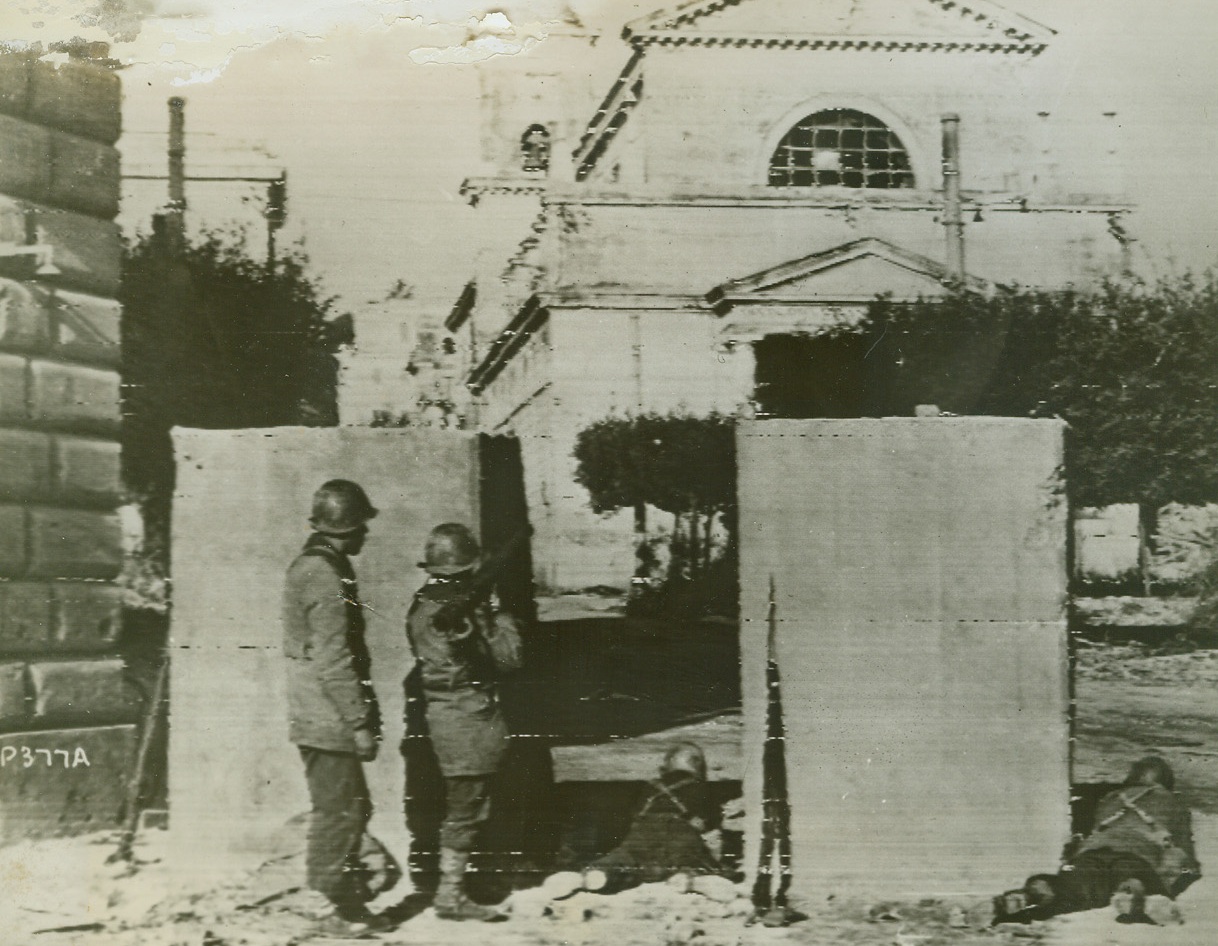
CONCRETE SHELTER, 1/27/1944. ANZIO, ITALY—Retreating Germans erected these concrete blocks to tie up roads in Anzio, but they served the American troops well as our fighters entered the town. The blocks provided cover for Yanks firing on the Nazis. At right, one soldier mans a bazooka gun. Credit: U.S. Signal Corps radiotelephoto from Acme;
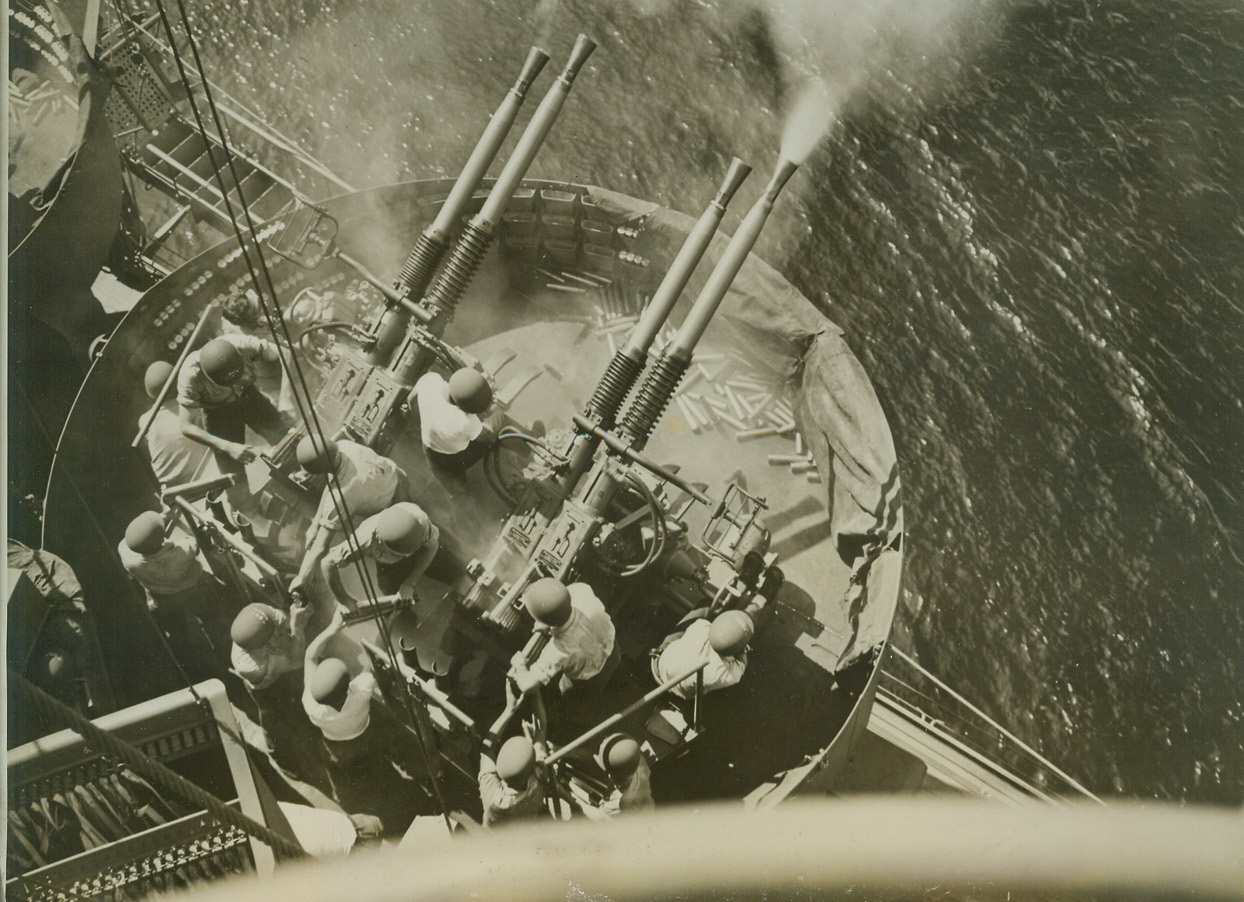
Shakedown Cruise, 1/31/1944. AT SEA -- A vital part of the training of men who fight at sea is the shakedown cruise, the run on which embryo sailors try their sea legs, get acquainted with their shipmates, and learn how to operate their ship. A 40mm gun crew, composed of Navy fighters making their shakedown cruise, goes into action against a make-believe enemy in this dramatic photo. Credit: (Official U.S. Navy Photo from ACME);
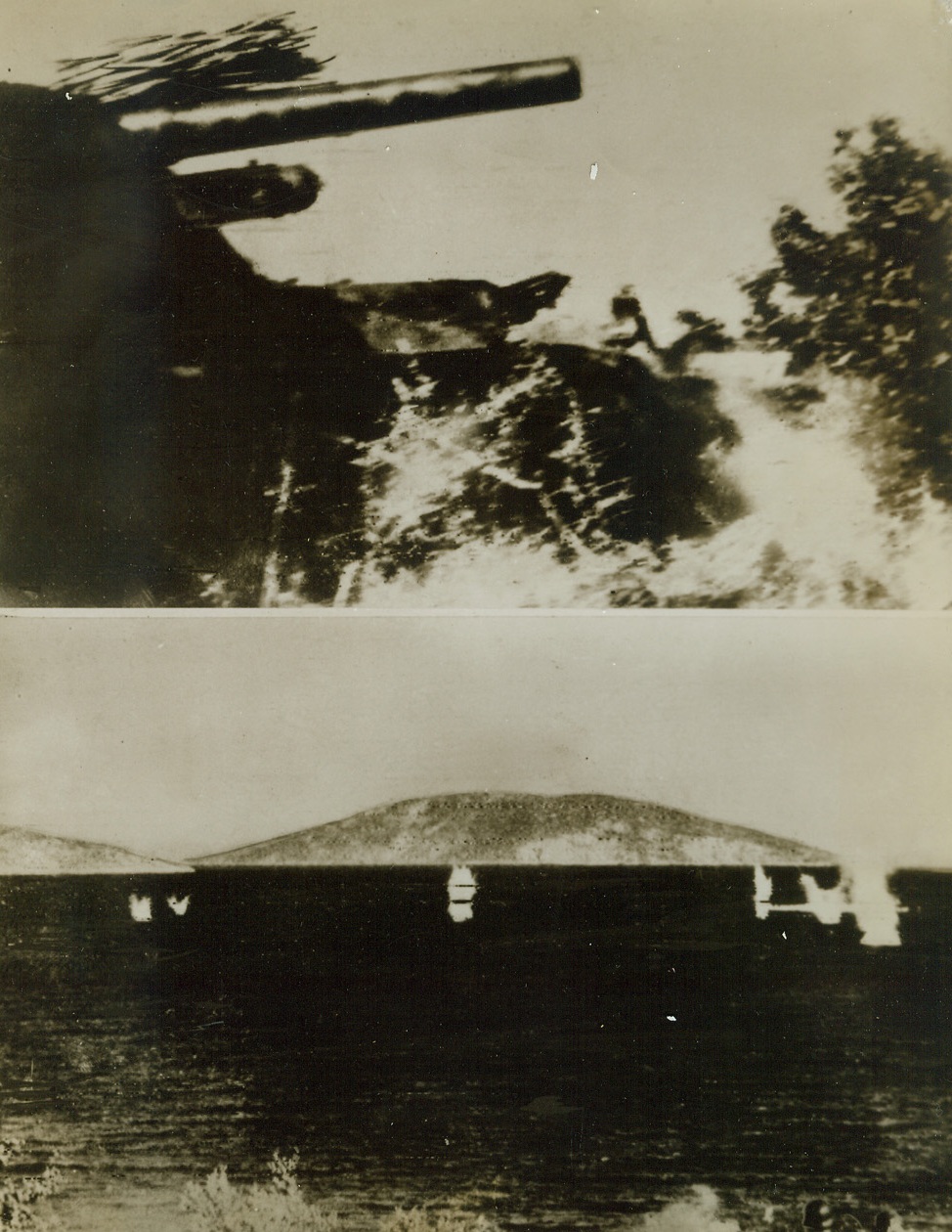
HITLER'S HUMMEL-HUMMEL GUN, 1/7/1944. IN THE SOUTH-EASTERN BALKANS—From a neutral source comes this pair of photos, showing the Nazis’ new Hummel-Hummel gun, just installed on the coast of the Southeastern Balkans, and (below) the gun’s shells are fired at water level. The shells then ricochet across the surface, bounding toward enemy landing craft.;
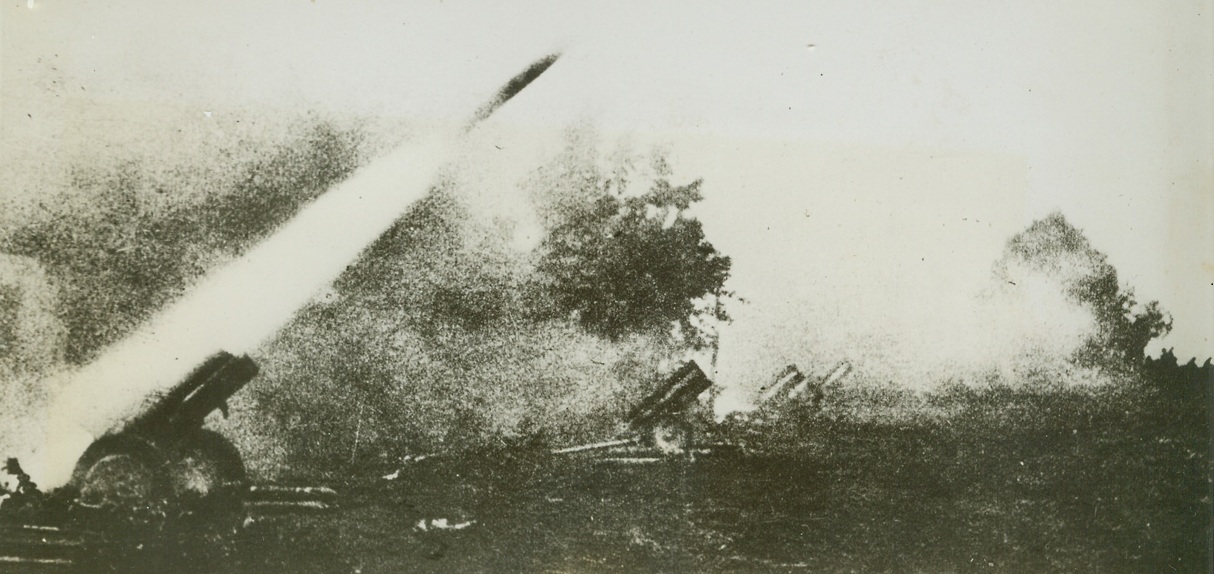
NAZI “ROCKET” BATTERY IN ACTION, 1/20/1944. An incendiary rocket shell leaves the barrel of an electrically-operated triple purpose gun, one of a battery of the German pieces “somewhere on the Russian Front.” Three other “rocket” guns can be seen in the background of the photo just received from a neutral source. Today, in spite of stiff German resistance, Soviet forces have captured Novgorod in the North and are still advancing in the Ukraine. Credit Line (ACME);
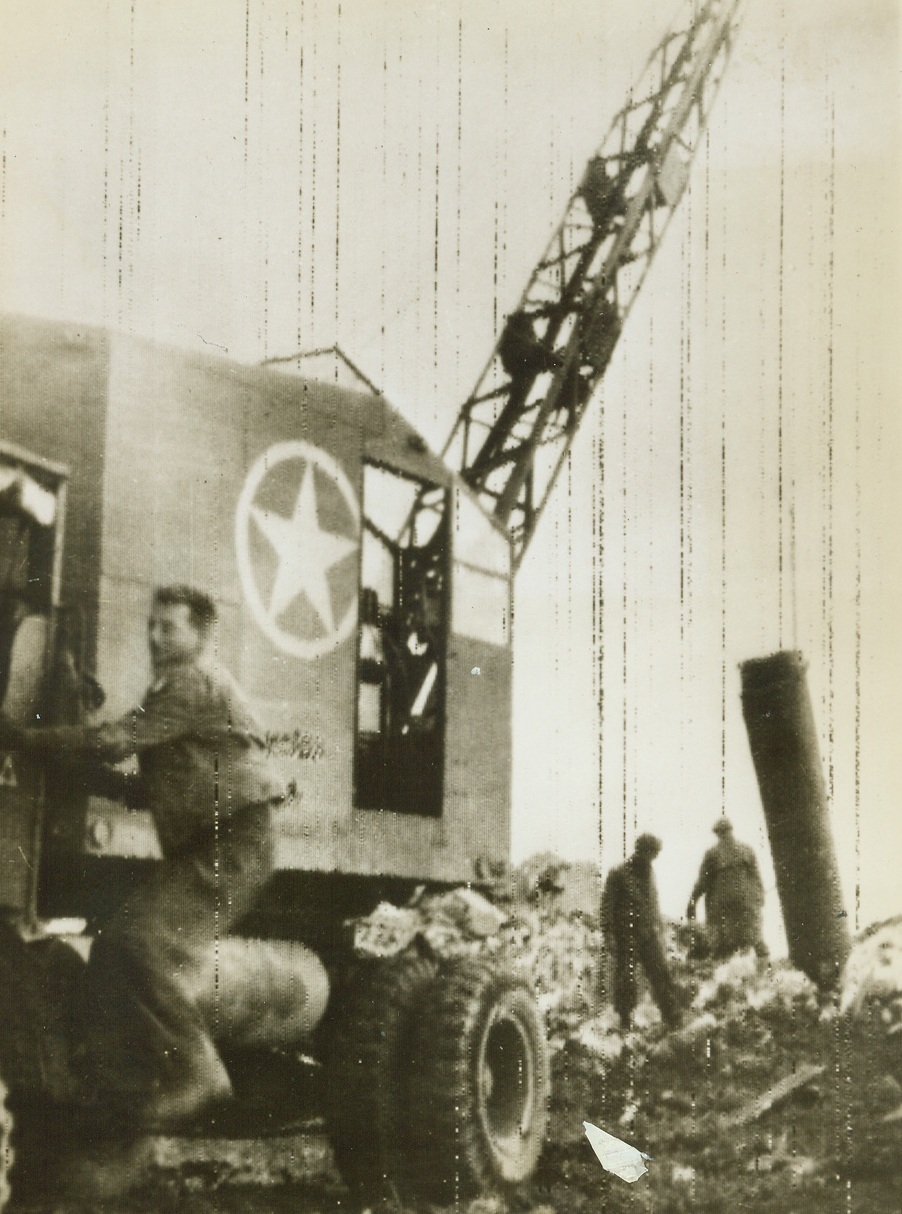
Cleaning up on Road to Rome, 1/26/1944. Anzio, Italy – An American Army crane hoists a 300-pound Tronite demolition charge from the spot on the beach at Anzio, where it had been planted by the Germans who hoped to kill Allied invaders with it. Now, streams of men and material are pouring ashore at Anzio and at other bridgeheads south of Rome and the Allies are pushing inland to cut lines of retreat of Nazis trapped to the South. (Passed by Censors) Credit: Stars and Stripes photo via OWI Radiophoto from ACME;
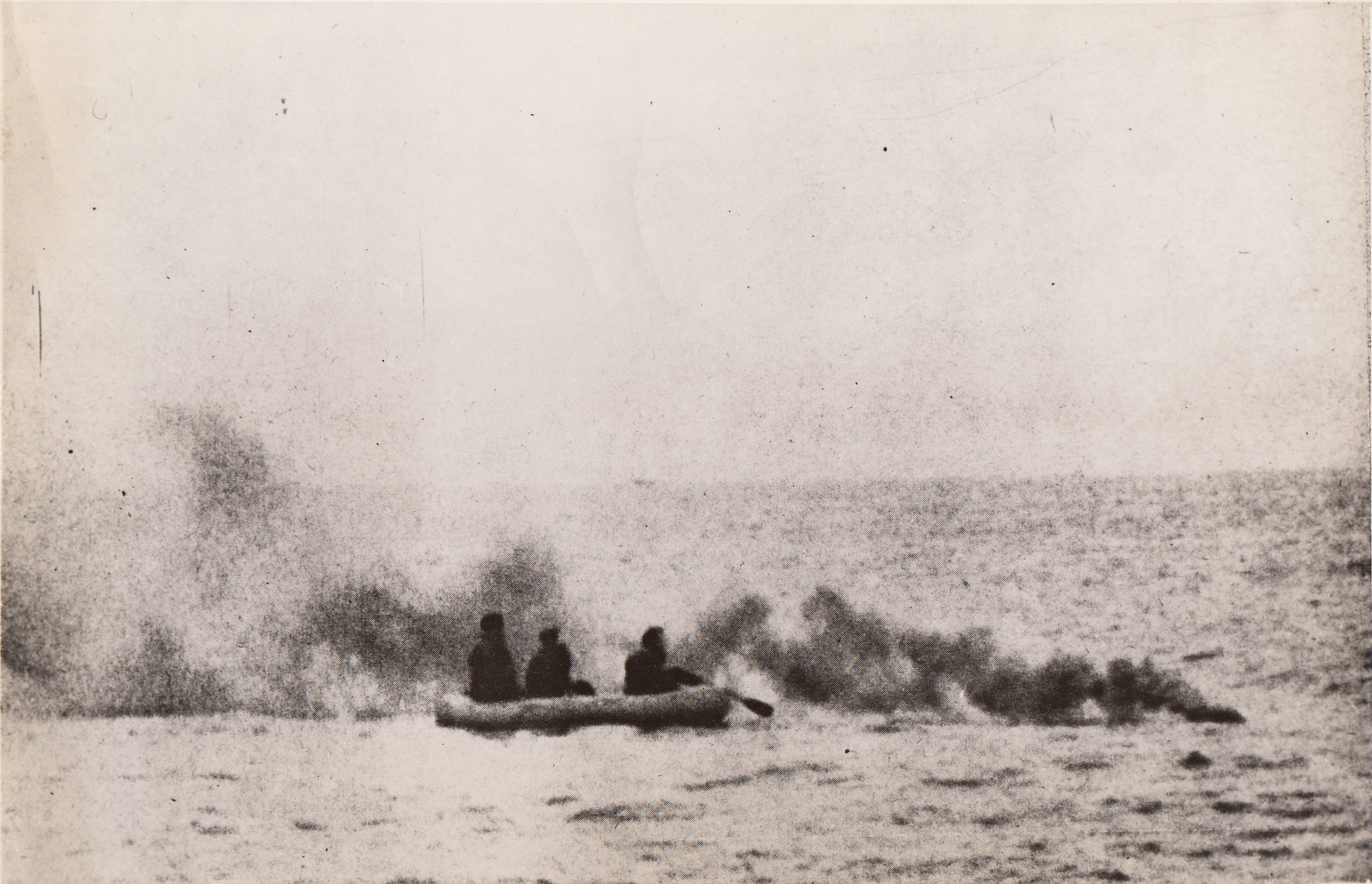
Yanks, Say the Nazis, 1/27/1944. At Sea—The German Caption, accompanying this photo received through a neutral source, says these men (?) a life raft are American Airmen rowing away from the burning wreckage of their sinking plane. Shortly afterward, they were picked up by a Nazi seaplane.;
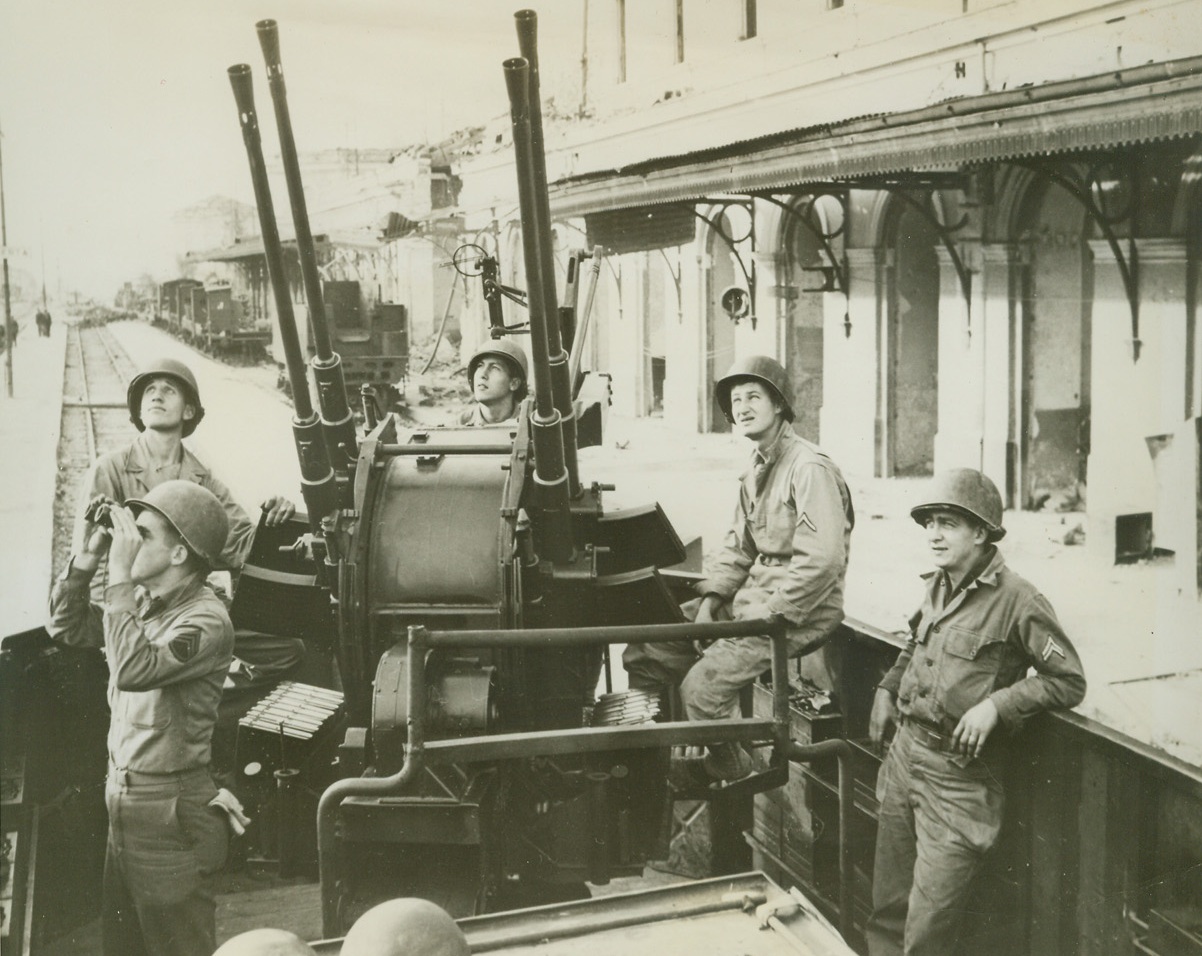
Triple Play—Hitler, To Musso, To Yanks, 1/25/1944. Naples, Italy—This deluxe, super armored and armed railway car was presented to Mussolini by Hitler (P.S.: In the “Good Old Days”). It was built in Germany, has luxurious living quarters in the center of the car and quadruple gun mounts at each end. As the Germans were chased out of the Naples area, they tried to destroy it but the Yanks were too quick for them. Now it is a mobile anti-aircraft gun mount and is manned by an American crew of 10, who live in the fancy quarters meant for Mussolini. Here (Left to Right, clockwise around gun), are: Sgt. John T. Adams, of ST. Louis, MO; Pvt. Joseph N. Schan, Pardeesville PA.; S. Lolrich, Denver, CO; and Cpl. Albert E. Nickel of Chicago, ILL. The men show here during a practice alert, all members of an airborne machine gun battalion. Credit: OWI Radiophoto via U.S. Signal Corps from ACME;
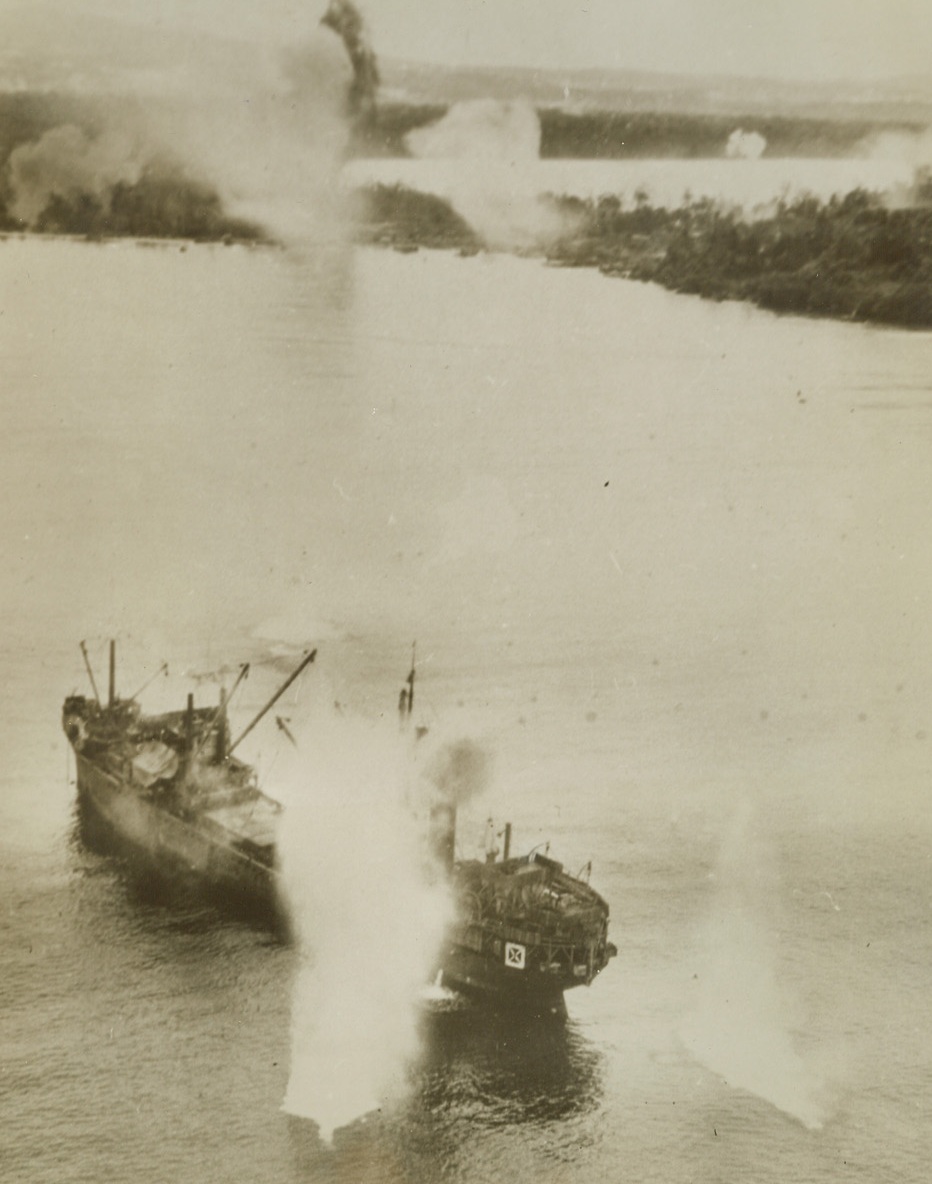
Cold Turkey, 1/27/1944. Two bombs from a plane of the U.S. Army 5th Air Force, bracket the stern of a 3,000-ton Japanese freighter caught anchored in Wewak Harbor, on the North Coast of New Guinea, during a recent raid on the Nip base. Other bomb hits can be seen along the shore installations (top of photo). American planes sank an enemy transport and a freighter in the attack. Credit: U.S. Army Air Force photo from ACME;
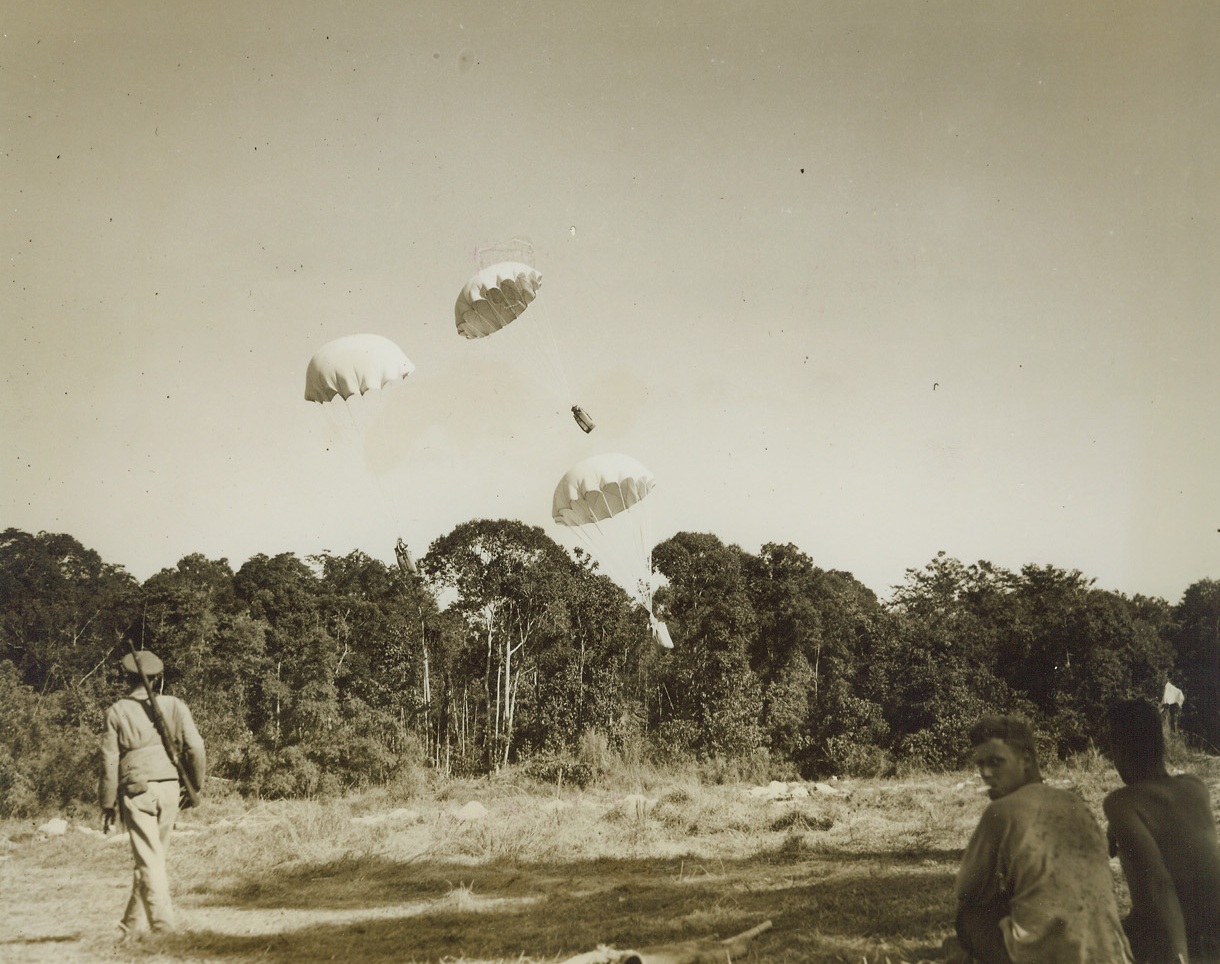
Rice for Chinese Fighters in Burma, 1/31/1941. Burma – Parachutes with large containers of rice for American-trained Chinese troops fighting on the Burma front drop from a transport plane. Note large number of chutes on the ground. (Passed by censors.) Credit: ACME photo by Frank Cancellare for the War Picture Pool;
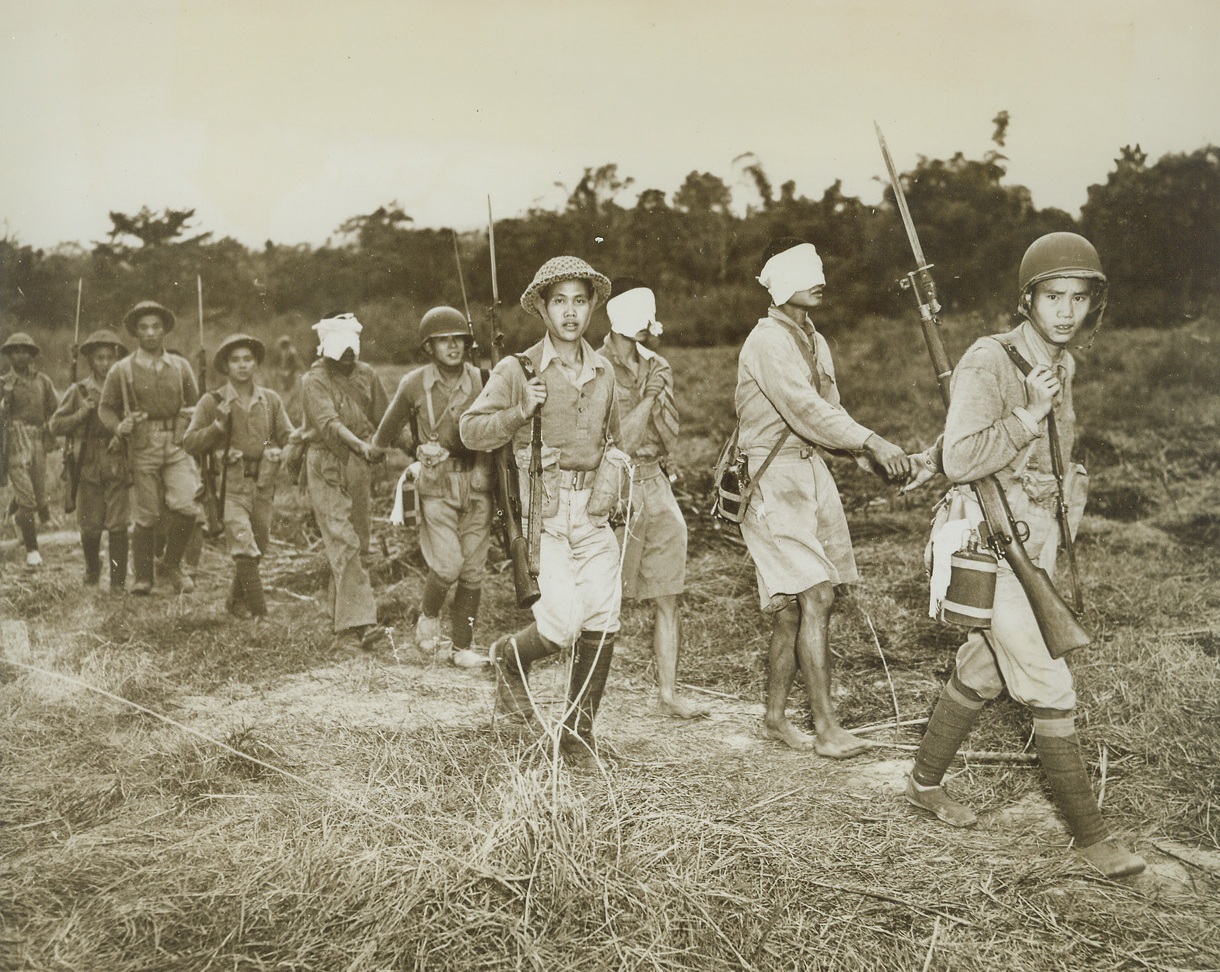
Nips Captured by Chinese in Burma, 1/31/1944. Burma – Three blindfolded Japanese are led to the rear by Chinese soldiers after their capture on the front in Northern Burma, where American trained and American equipped Chinese troops are fighting the Japs. Note modern U.S. combat helmets on soldiers (at right and fifth from right). (Passed by censors.) Credit: ACME photo by Frank Cancellare for the War Picture Pool;
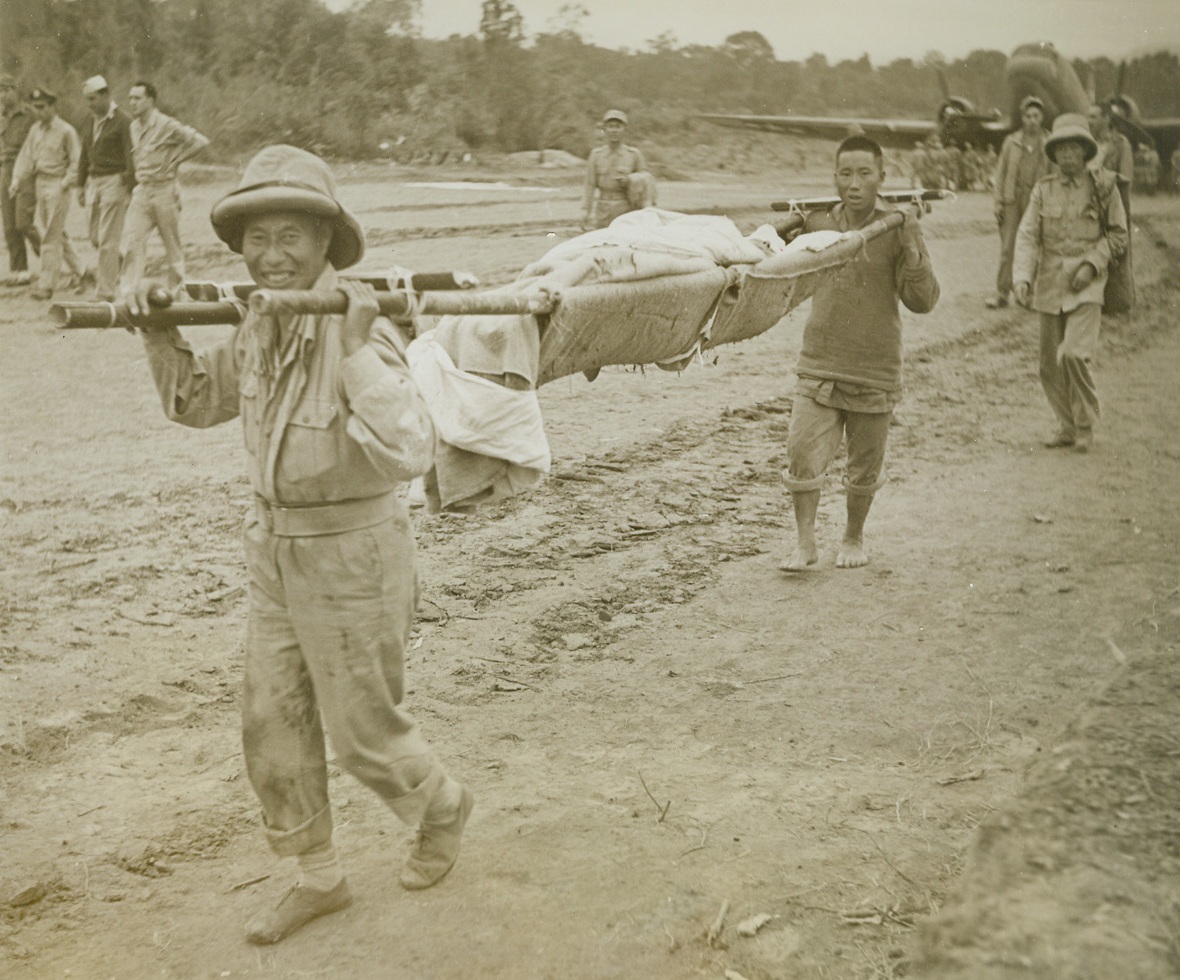
Chinese Wounded on Burma Front, 1/31/1944. Burma – Two Chinese carry a wounded companion to a dressing station on a crude stretcher made of bamboo poles “somewhere on the Burma front.” Note huge American-built transport plane in background. (Passed by censors.) Credit: ACME photo by Frank Cancellare for the War Picture Pool;
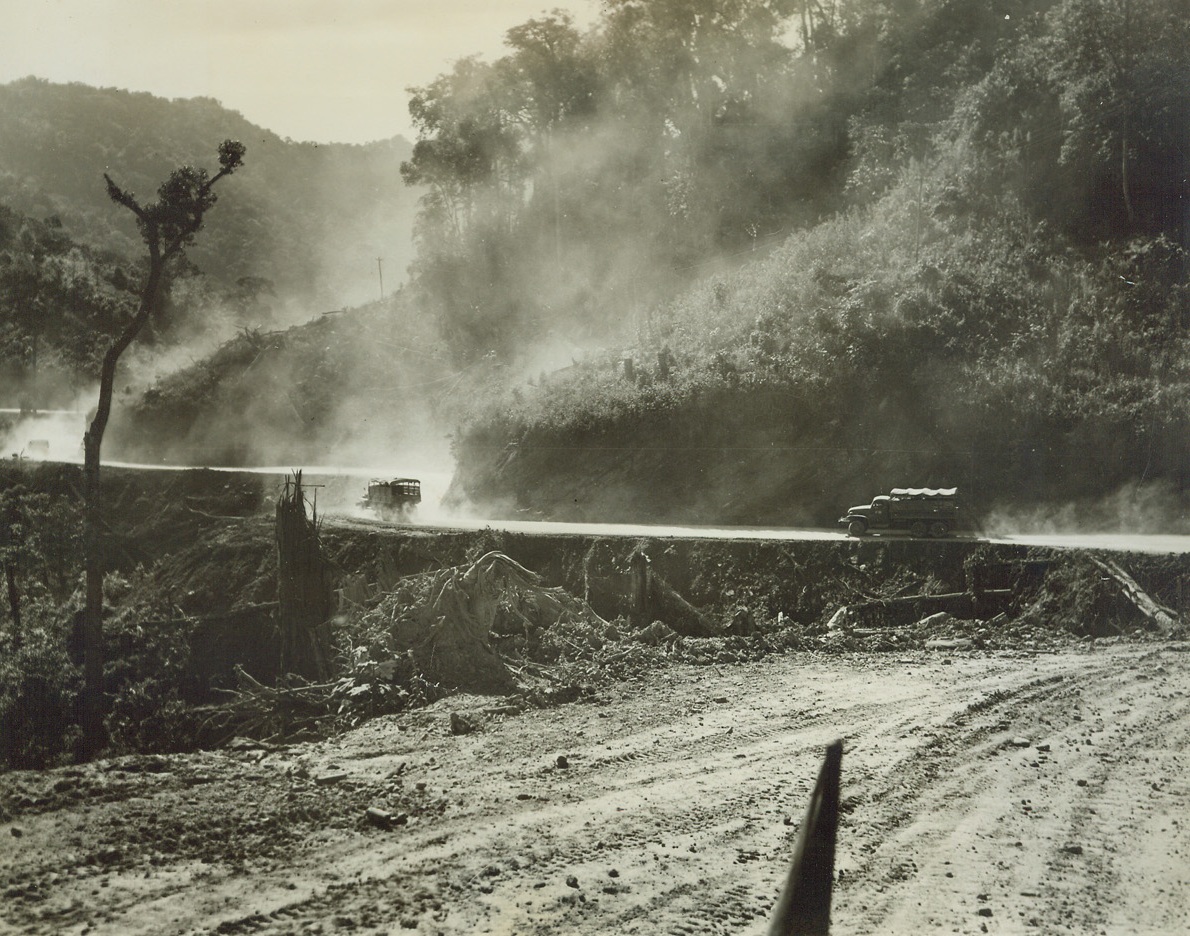
No Concrete Highways Lead to China, 1/25/1944. Burma – Torturous curves, blinding dust and sheared-off embankments plague drivers winding their way into Burma by way of the Ledo Road, “highway” being pushed by American Engineers as fast as Yank and Chinese soldiers can clear the area of Japs. On the offensive since December 26th, Stilwell’s troops are pushing the enemy toward Taihpa Ga. Credit: ACME photo by Frank Cancellare, War Pool Correspondent;
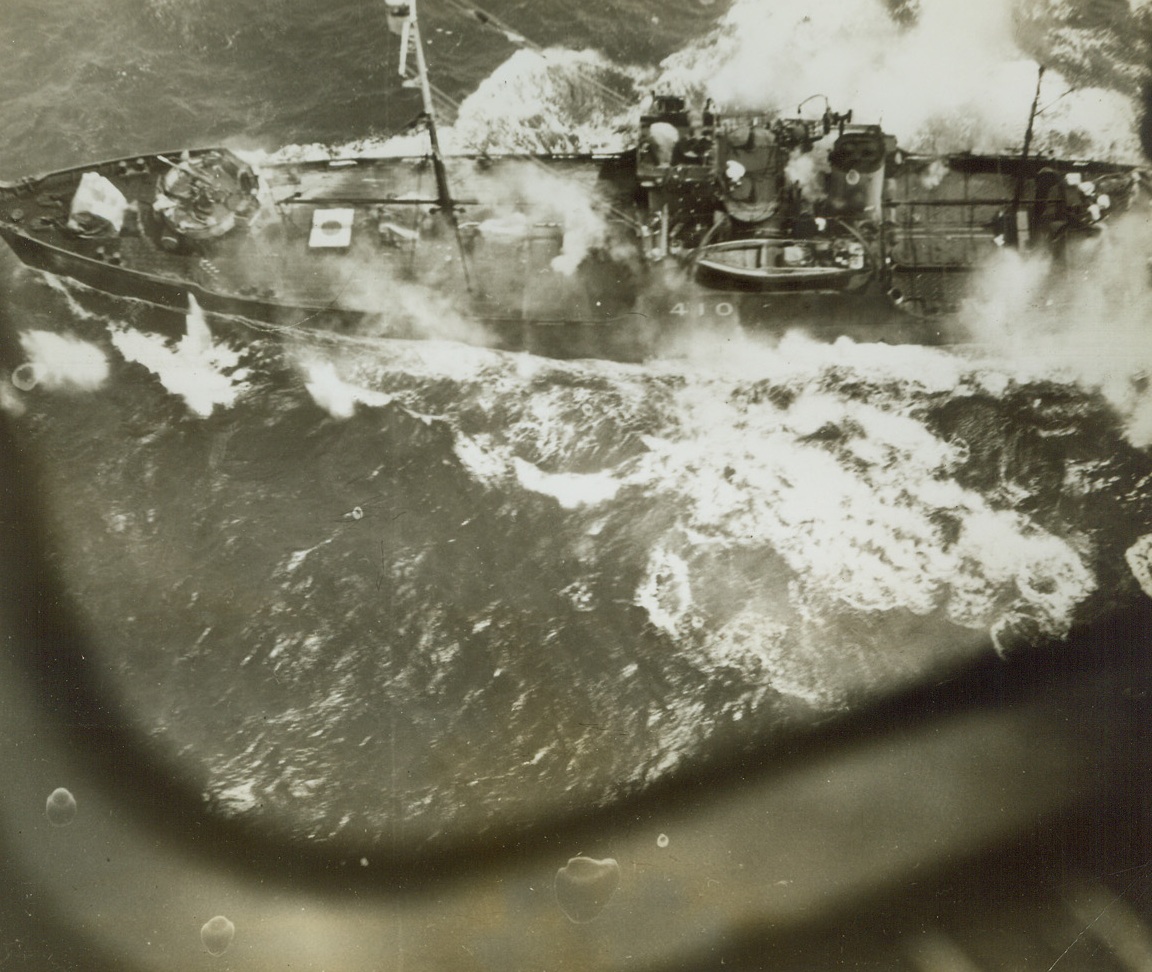
Carrier Downs Jap Torpedo Plane, 1/1/1944. A billowing cloud of smoke marks the grave of a Japanese torpedo plane, brought down by the ack-ack fire of a U.S. Navy carrier. The vessel, of the 25,000-ton Essex class, was attacked by low-flying Jap torpedo planes, after the U.S. raid on the Marshalls on December 4, 1943. Credit: U.S. Navy photo from ACME;
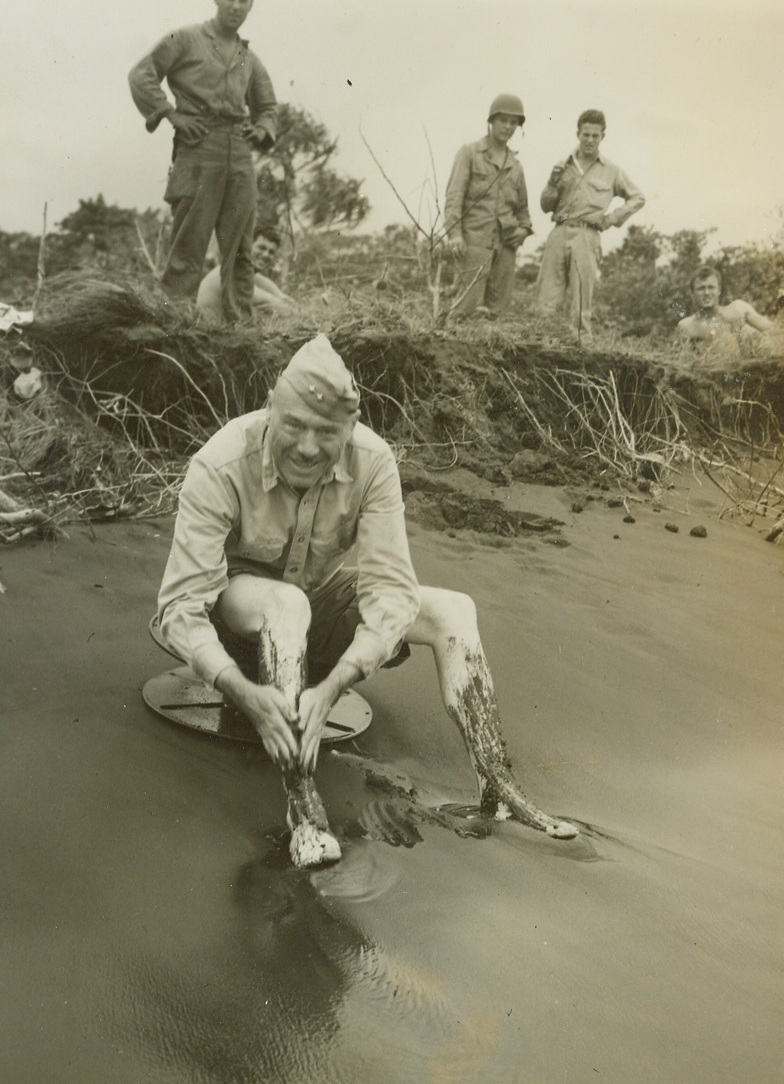
General Cools his Dawgs, 1/18/1944. New Britain – Major General W.H. Rupertus has a sure-fire cure for aching feet. After a hard day of tramping about the New Britain front with his troops, he treats his barking dawgs to a cool sea water bath – getting rid of the mud he collected on his tour.Credit Line –WP—(ACME photo by Frank Prist, Jr for the War Picture Pool);
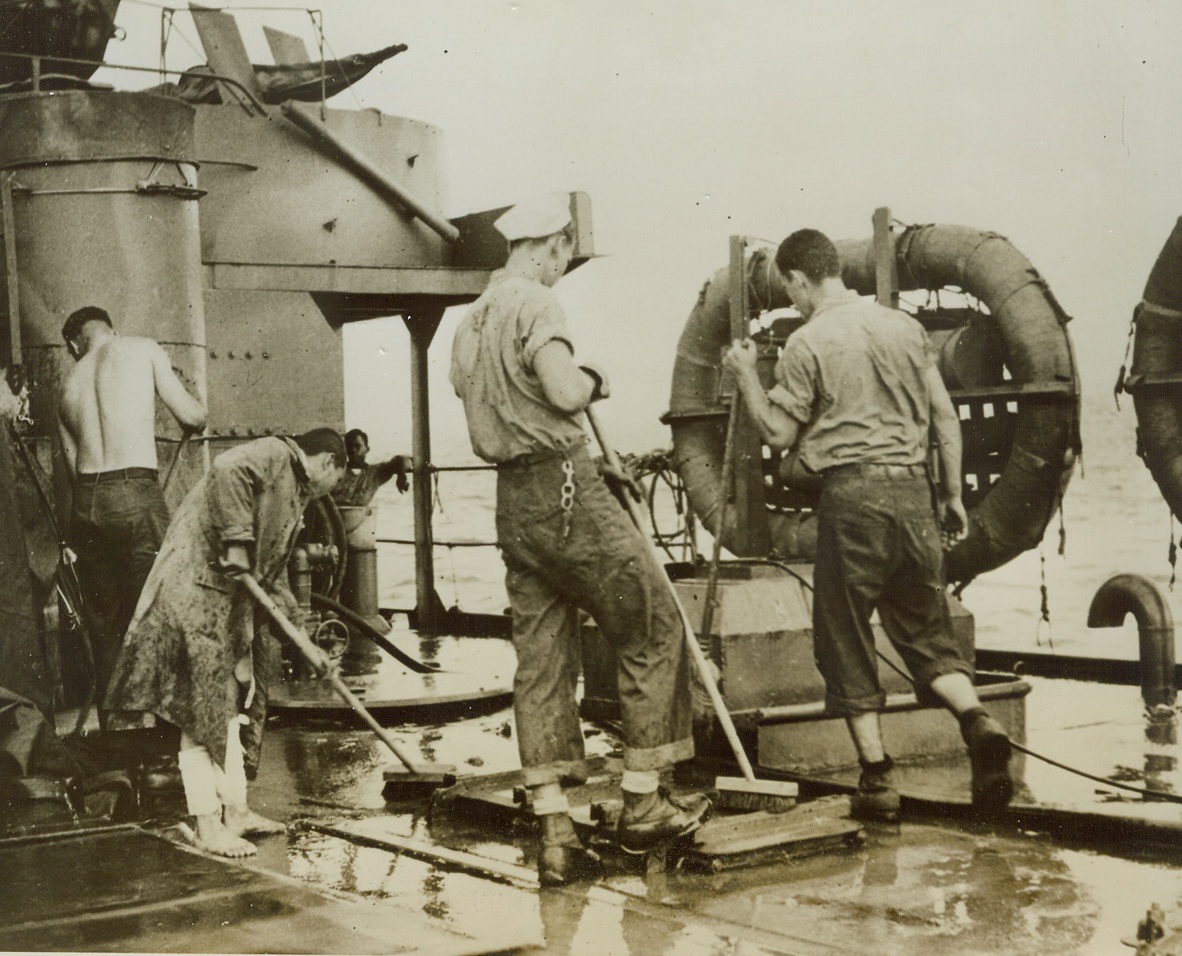
Earning His Keep, 1/26/1944. Washington, D.C: A captured Jap helps Coast Guardsmen swab down the deck of an LST during the invasion assault at Cape Gloucester, New Britain. He is being taken to a base camp.Credit (U.S. Coast Guard photo from ACME);
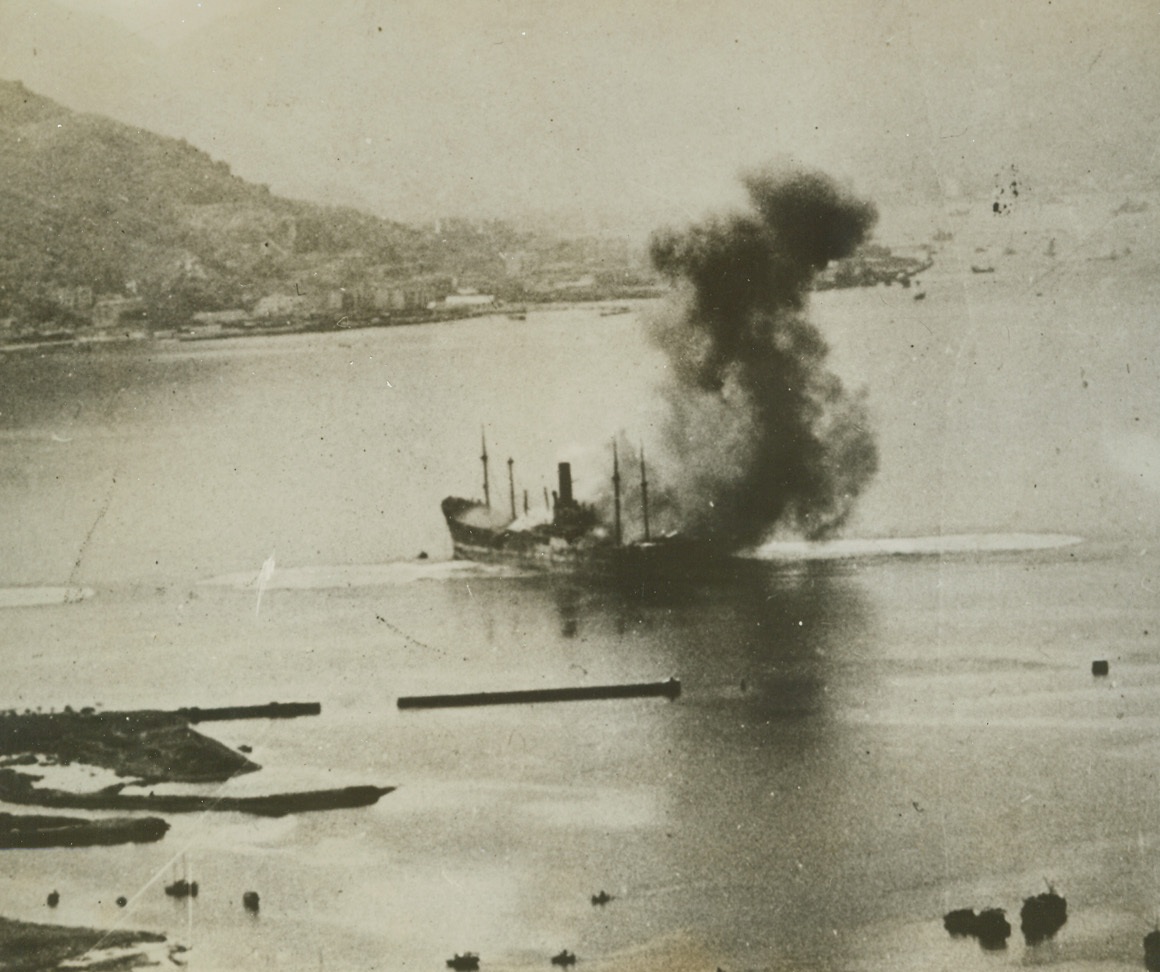
Jap ship burns in Hong Kong harbor, 1/21/1944. Hong Kong, China – Burning amidships and spouting smoke both fore and aft of the bridge, this 520-foot vessel of Japan’s rapidly dwindling merchant fleet was a victim of a 14th U.S. Air Force raid on Hong Kong harbor. The ship was shattered by hits from B-25 Mitchells.Credit (U.S. Army Air Forces photo from ACME);
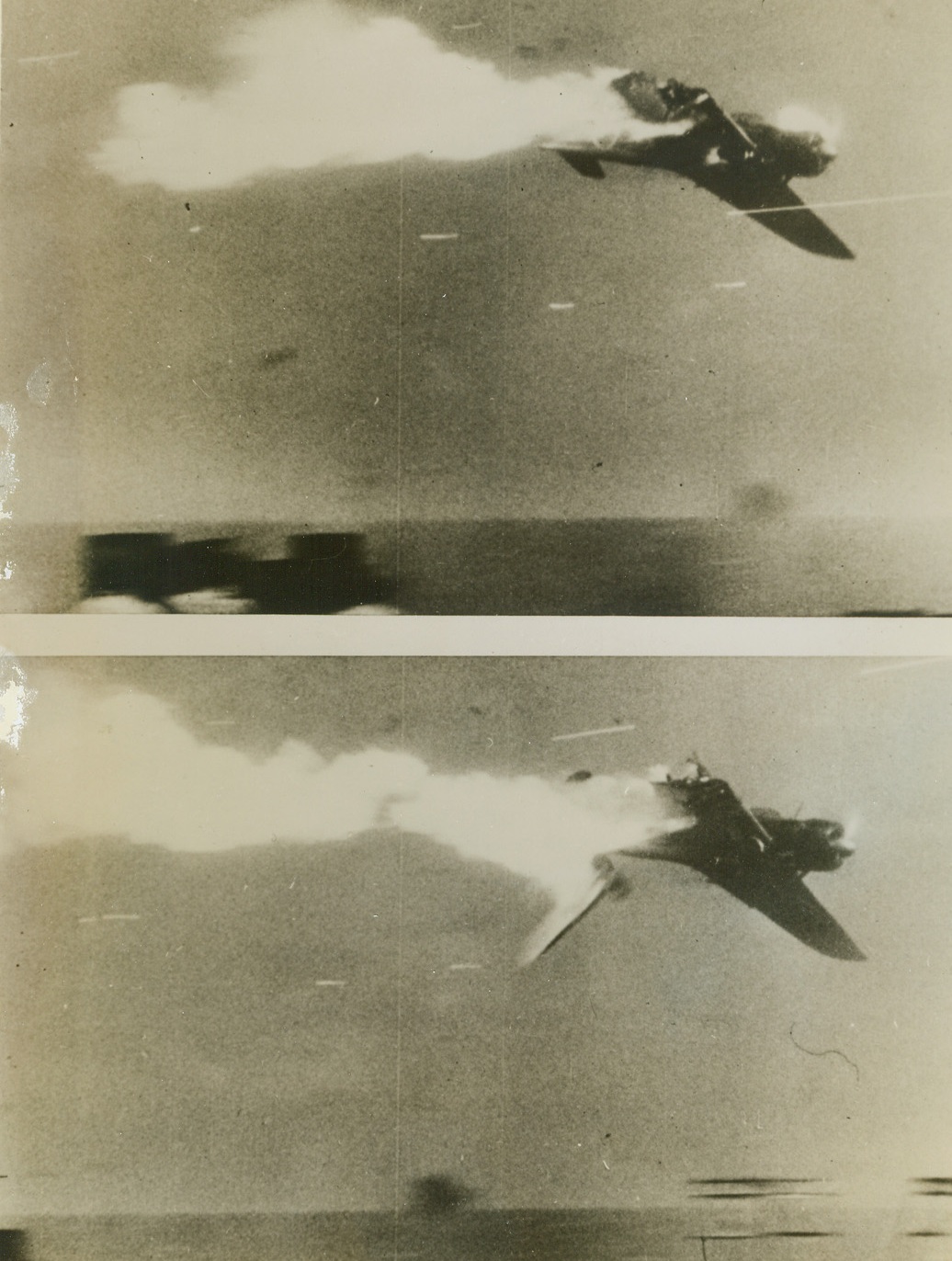
Attack, 1/4/1944. Roaring overhead on their deadly mission, six bloodthirsty Jap Torpedo planes were attacking a U.S. carrier during the December raid on the Marshall Islands when this sensational series was made. Enlargements from a movie film made by U.S. Navy cameramen, this sequence tells what happened when one of the six attackers made her pass at the American flattop.New York BureauScoring at last, the carrier’s ack-ack crew finds a vulnerable spot, hitting the enemy attacker on the wing, the crew sees a sheet of flame stream from the plane. In bottom photo, the Torpedo bomber yaws and its wing drops off.Credit Line (Official U.S. Navy photo from ACME);
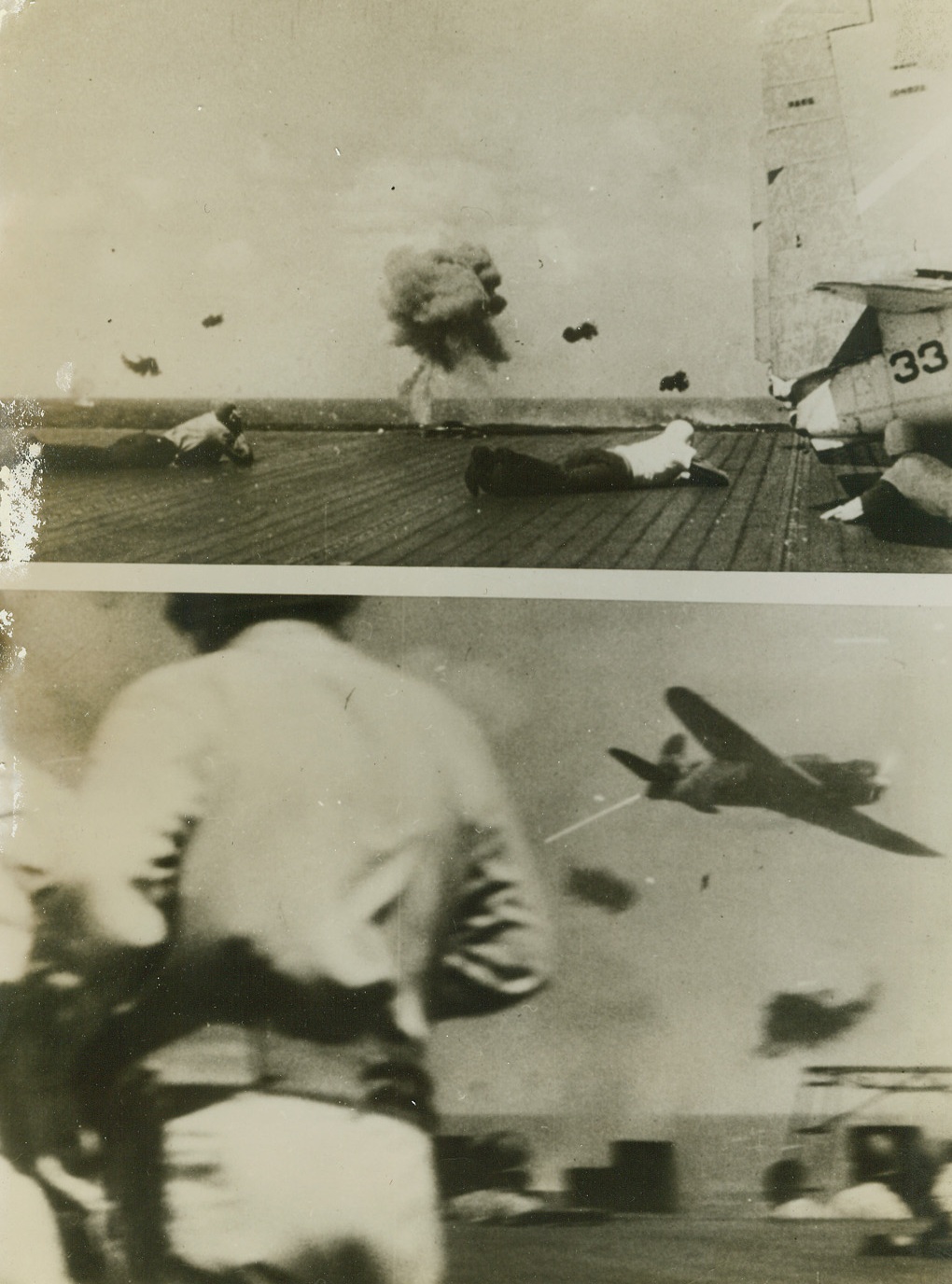
No Title. 1/4/1944. Roaring overhead on their deadly mission, six bloodthirsty Jap Torpedo planes were attacking a U.S. carrier during the December raid on the Marshall Islands when this sensational series was made. Enlargements from a movie film made by U.S. Navy cameramen, this sequence tells what happened when one of the six attackers made her pass at the American flattop.New York BureauScoring at last, the carrier’s ack-ack crew finds a vulnerable spot, hitting the enemy attacker on the wing, the crew sees a sheet of flame stream from the plane. In bottom photo, the Torpedo bomber yaws and its wing drops off.Credit Line (Official U.S. Navy photo from ACME);
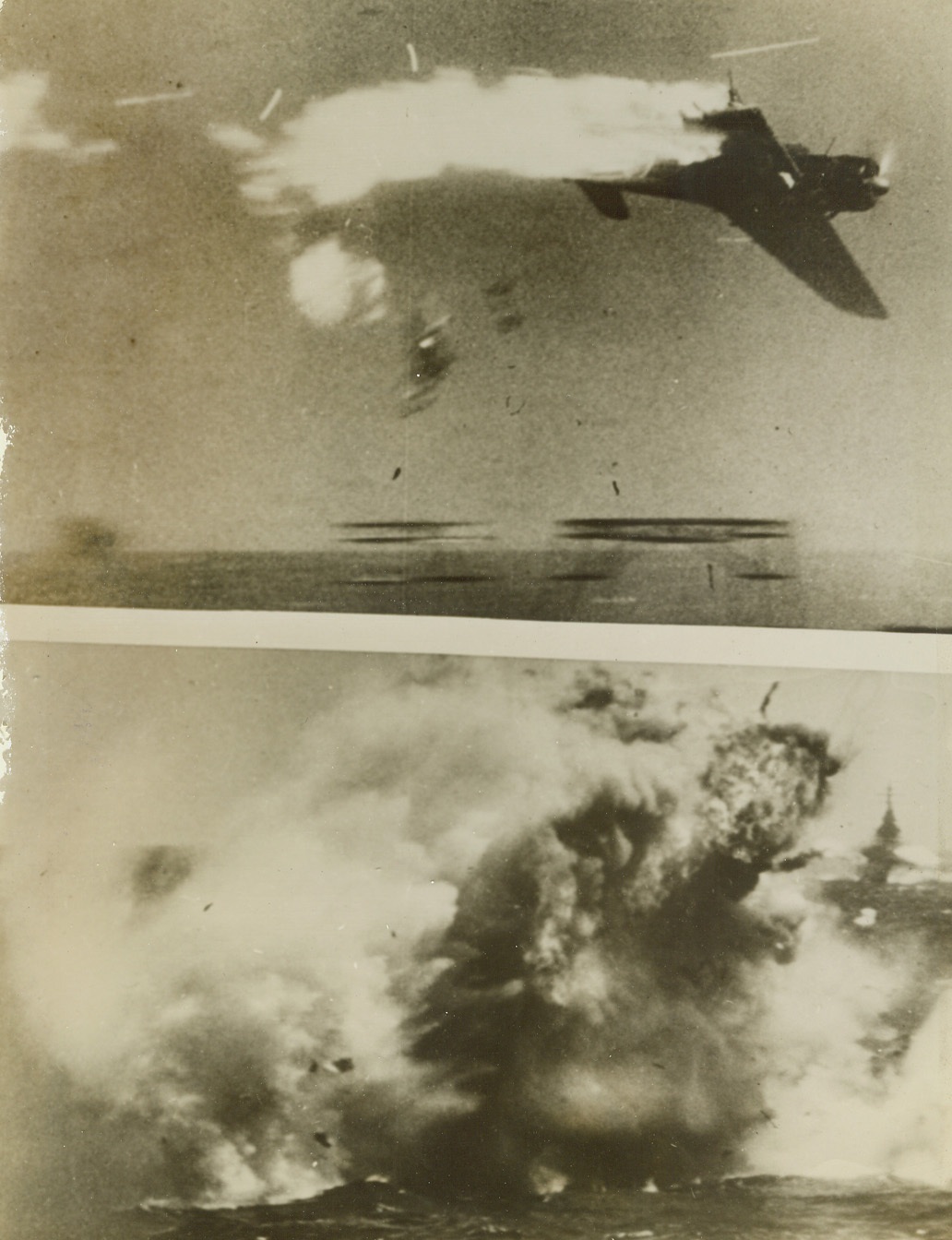
No Title. 1/4/1944. Blazing a trail of flame across the sky, the stricken airship, minus one wind, noses down toward the sea. In bottom photo, the bomber has disappeared into the water, leaving only a thick, black cloud of smoke to mark its grave. In the background a U.S. destroyer speeds to the scene of the plane’s end.Credit Line (Official U.S. Navy photo from ACME);
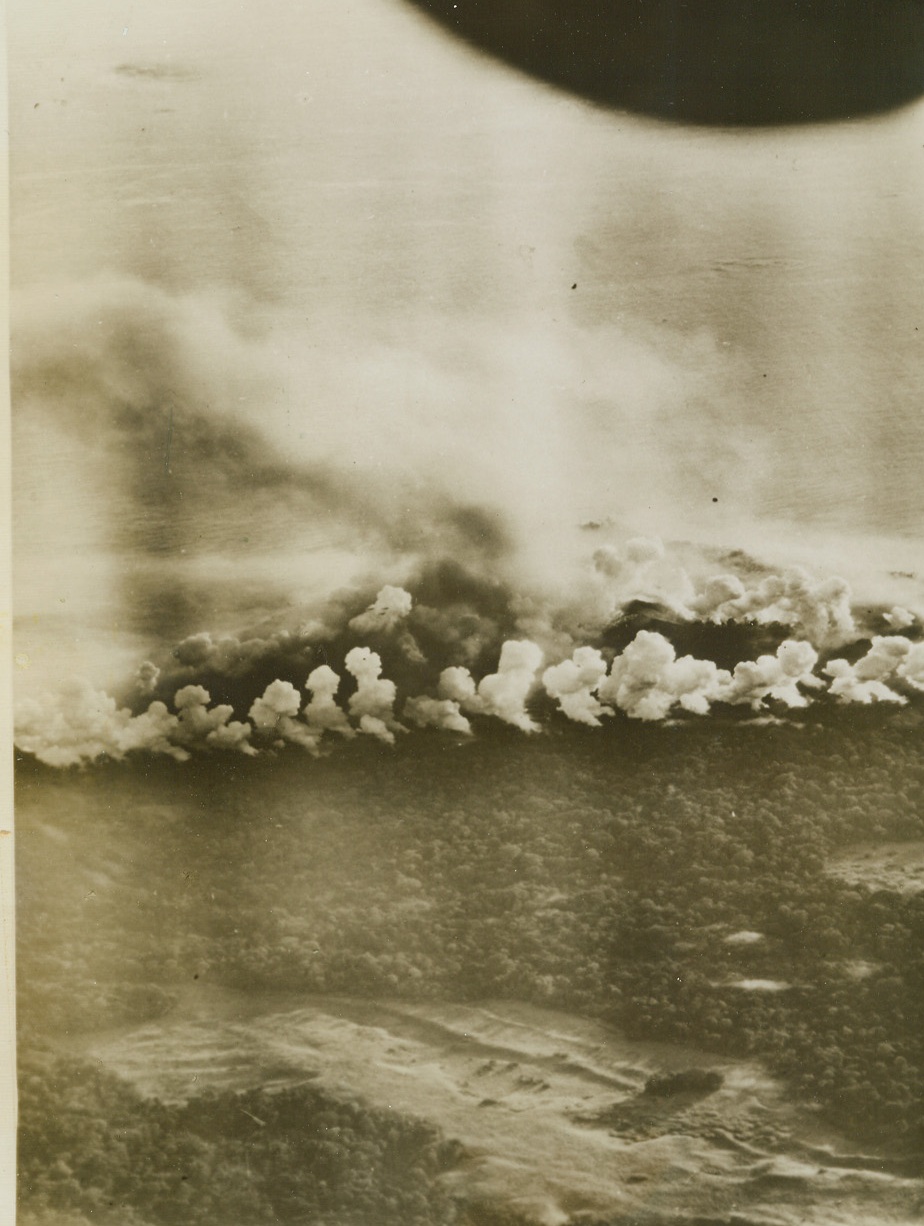
The Japs Don’t See the “Beauty” of it, 1/21/1944. New Britain – Almost perfectly aligned white blobs of smoke tell a success story of precision bombing by U.S. Army Fifth Air Force B-24’s and B-25’s who smack Cape Gloucester as the Marines move in. The milky columns of smoke have a background of flame and darker smoke which shrouds the Pacific shore line.;
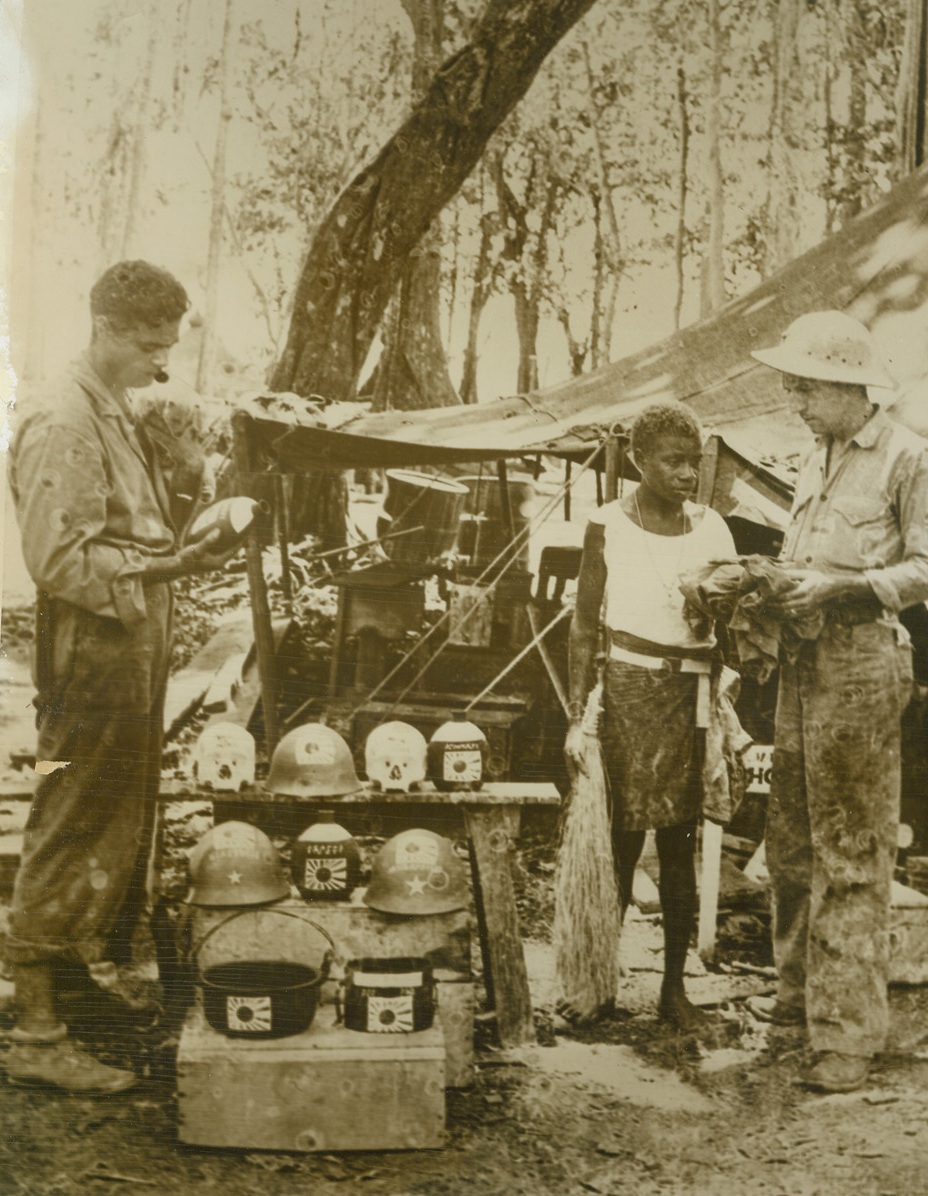
Jungle Novelty Shop, 1/6/1944. Guadalcanal – Jap soldiers unwittingly provided the “novelties” for this unique trading shop run by a Marine on Guadalcanal. The proprietor, Cpl Robert A. Weeks (right) of Urbana, Ill., decorates the trophies he picked up on the battlefields with Jap flags, Jap characters, etc. He is shown bargaining for a souvenir with a native boy as Cpl Joseph F. Andrejka, Chicago, Ill., examines a decorated Jap canteen. Barely discernible on Cpl Andrejka’s shoulder is “Coco”, a variety of possum which is found on the island and is very easily tamed.;
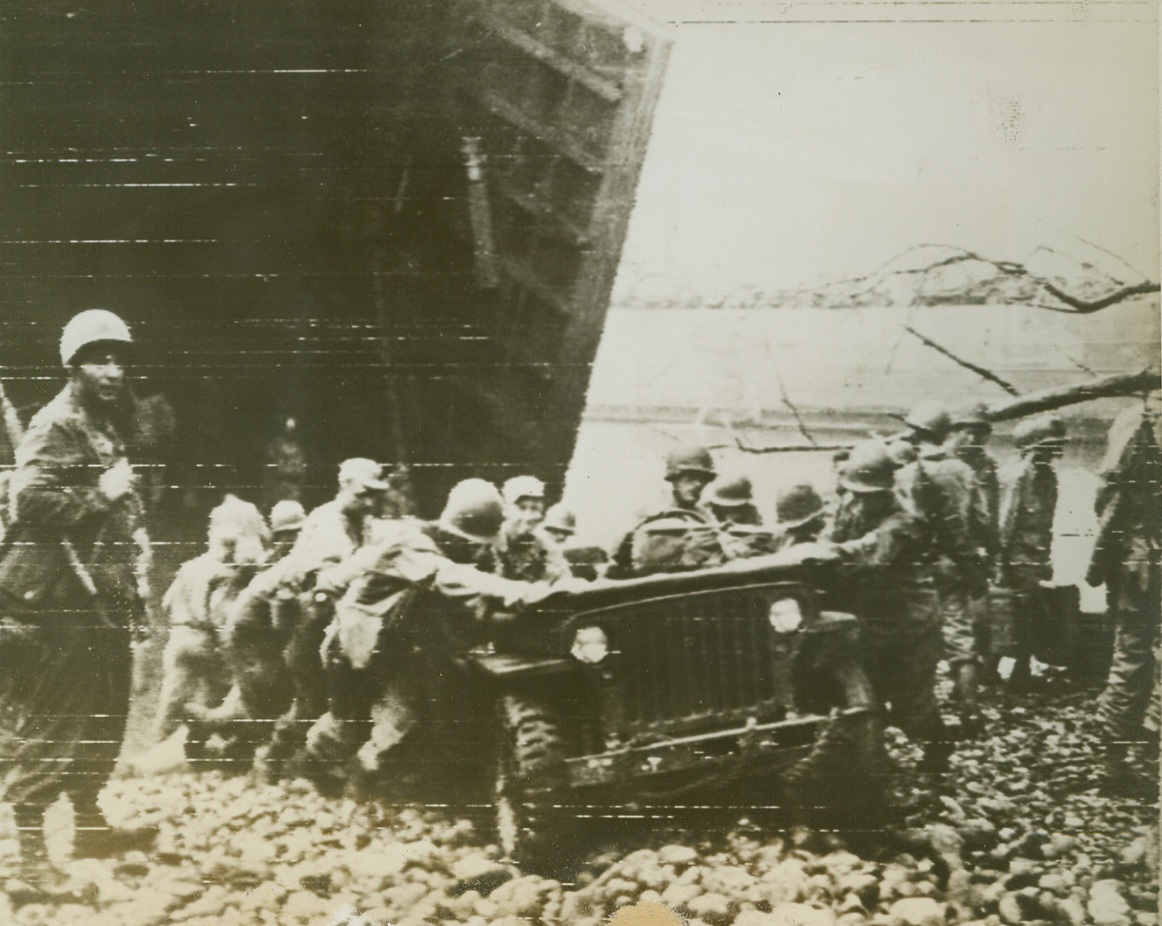
Heave – Ho, 1/6/1944. Saidor, New Guinea -- Fresh off an LST, this jeep makes a bumpy trip up the beach at Saidor, New Guinea. Just landed, a group of American soldiers escorts the tiny car over the rough path to newly-laid road mats.Credit (Signal Corps radio telephoto from ACME);
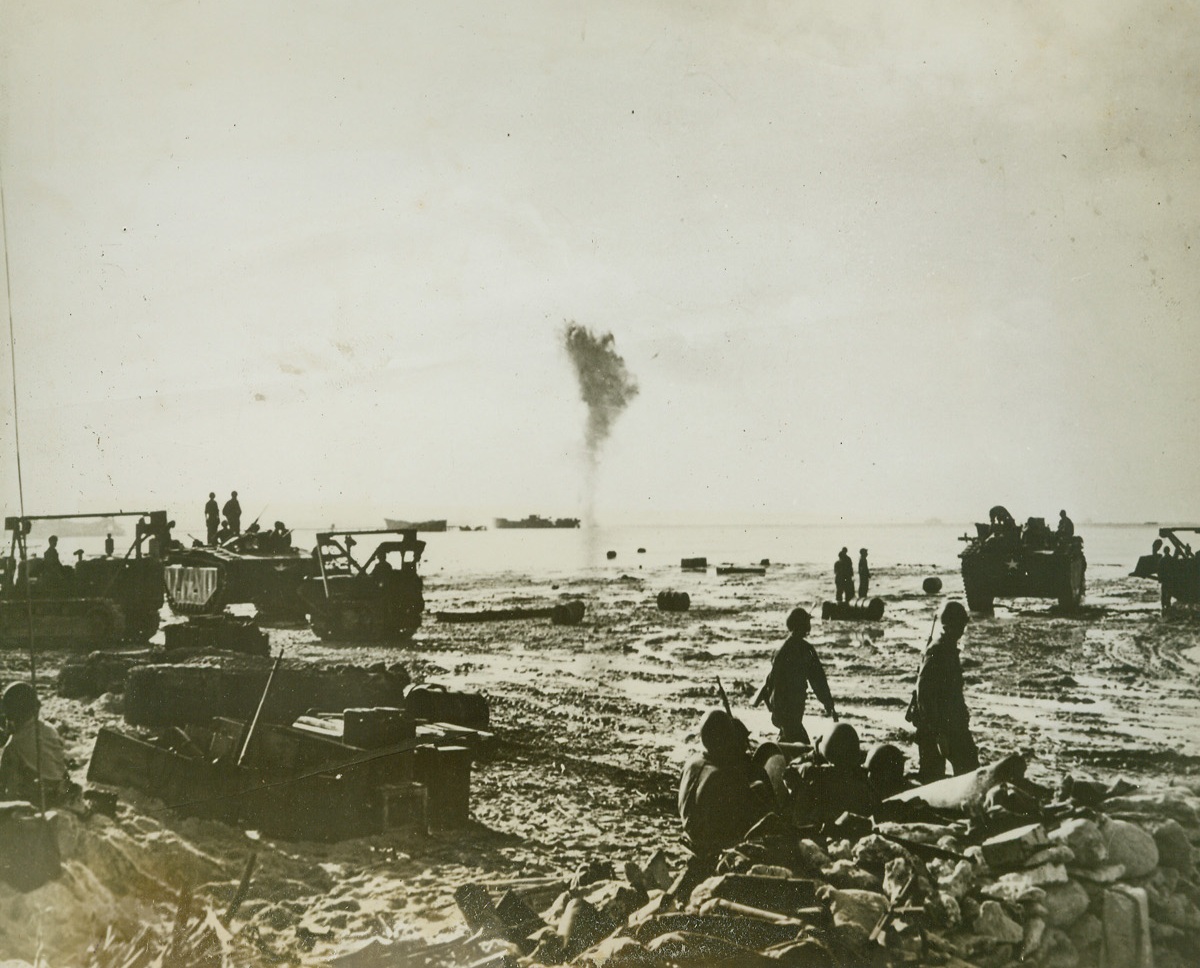
Major Operation, 1/6/1944. Makin Island --- In operations designed to destroy all Jap machine gun nests, Navy dive bombers drops loads of explosives on two old hulks of ships off Ah Chongs Wharf, Butaritari Lagoon, Makin Atoll. Column of smoke rises from one of the ships. Makin was occupied by units of the 165th infantry, 27th division, formerly the fighting 69th of New York.Credit (Signal Corps photo from ACME);
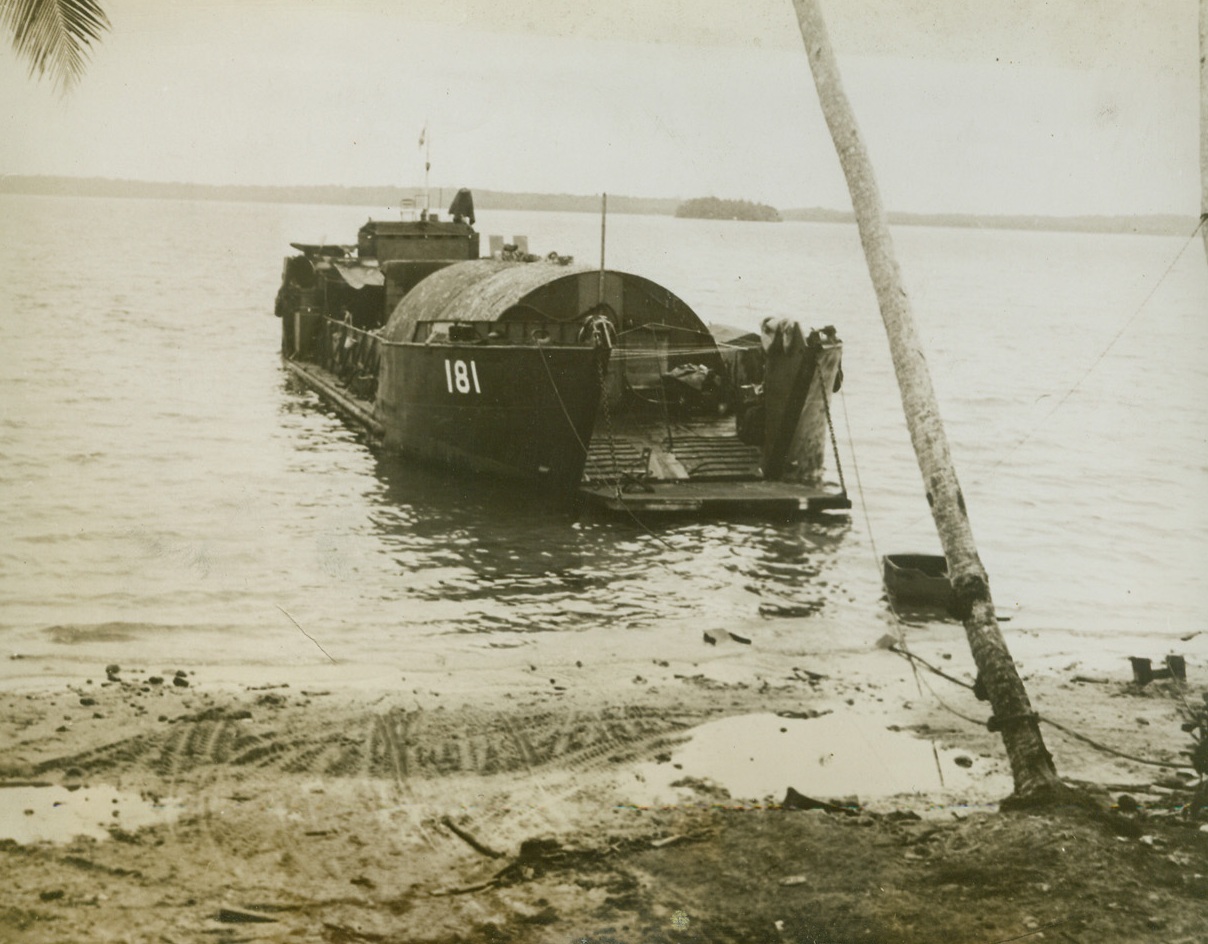
Floating Repair Shop, 1/4/1944.
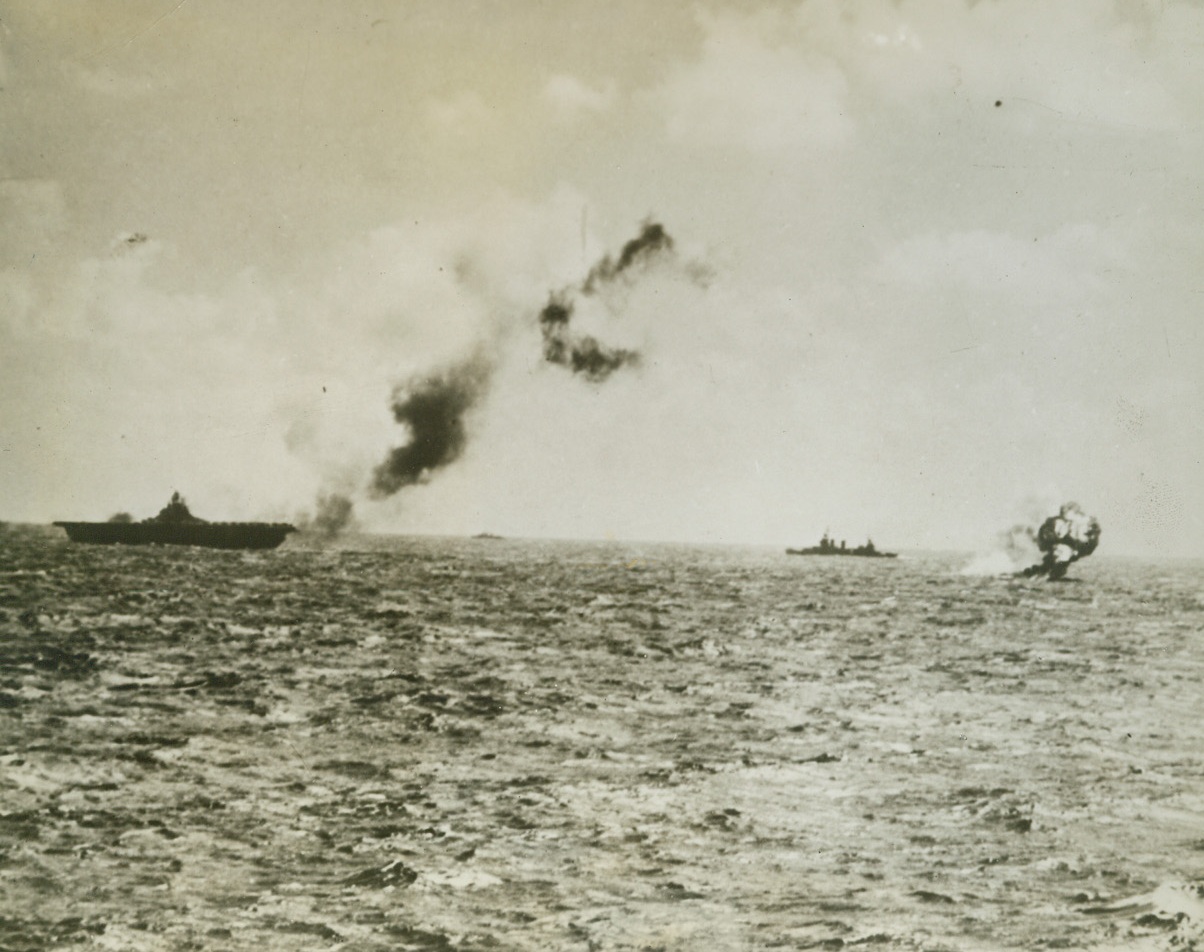
Attack on Jap Cargo Ship, 1/1/1944. A Navy photo-reconnaissance plane returned to its base with this photo as evidence of its attack on a Jap cargo ship in the Marshall Island area. Only 100 feet above the hull and carrying no bombs, the Liberator riddled the freighted with 50 caliber guns. Note that the forward gun of the vessel is not manned, indicating that the plane caught the crew by surprise.Credit Line (Official U.S. Navy photo from ACME);
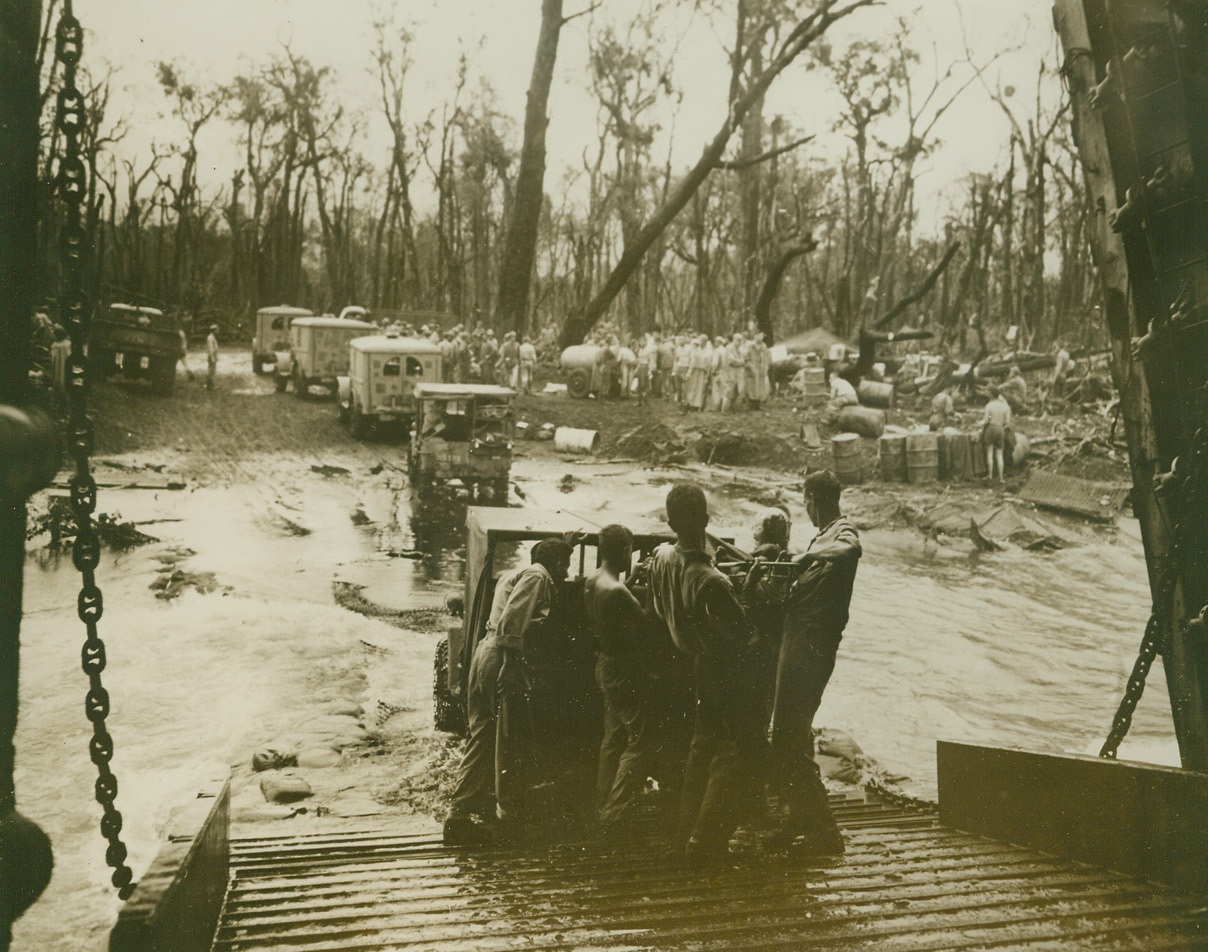
Load Cape Gloucester Wounded, 1/19/1944. New Britain - - U.S. Coast Guardsmen, who’ve just finished the bow doors of this Coast Guard manned LST (Landing Ship, Tanks) beached at Cape Gloucester, New Britain, now loan wounded onto the ship from ambulances backed up to the loading ramp. The LST’s officers’ wardroom was converted into an emergency hospital.Credit (U.S. Coast Guard photo);
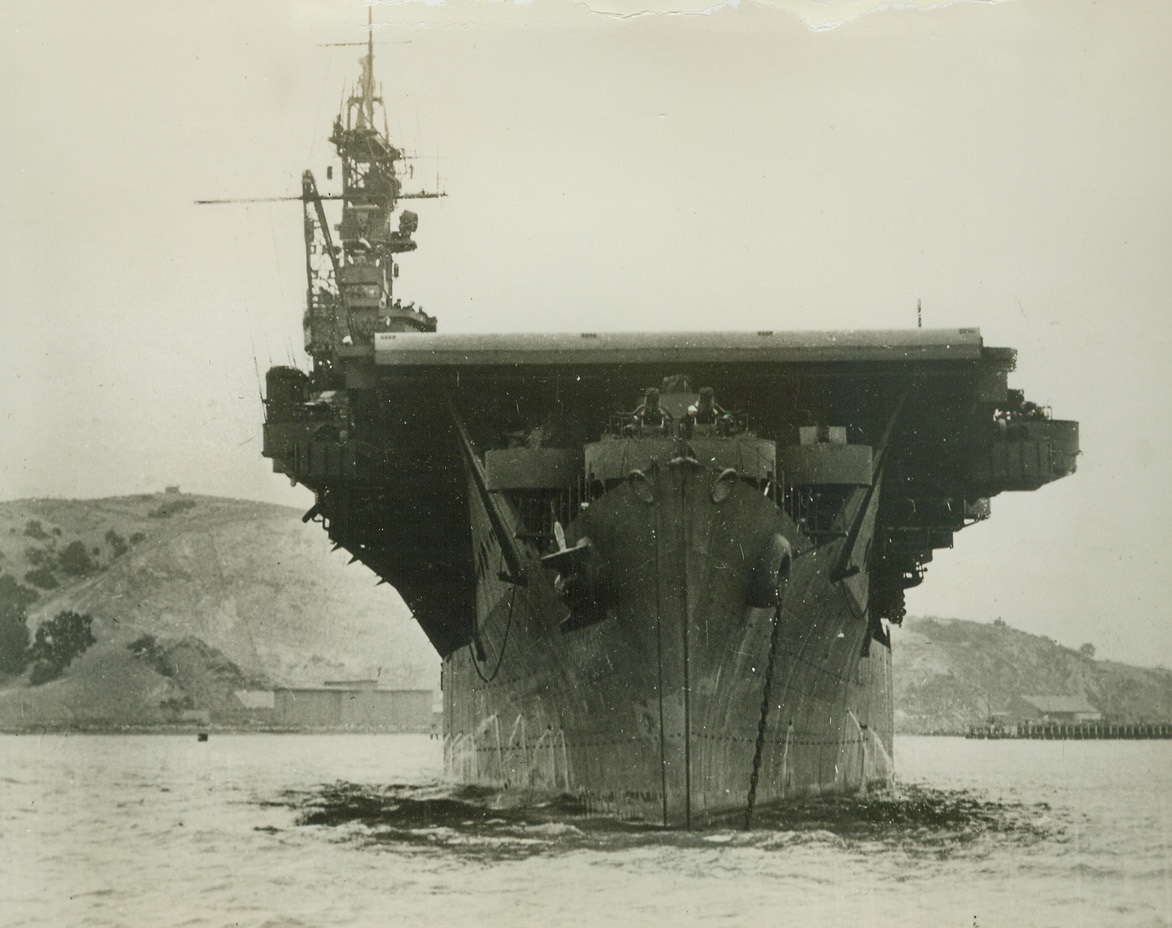
Our Newest Flattop, 1/13/1944. There’s a bow-on view of the latest addition to our Navy’s expanding flattop fleet – one of nine 10,000-ton converted cruiser carriers of the Independence class. Combining the speed of cruisers with the deadly striking power of modern carriers, they add another hard-hitting unit to the U.S. Navy forces now blasting the enemy, and have recently delivered smashing blows to Jap bases from Wake to Rabaul.Credit Line (Official U.S. Navy photo from ACME);
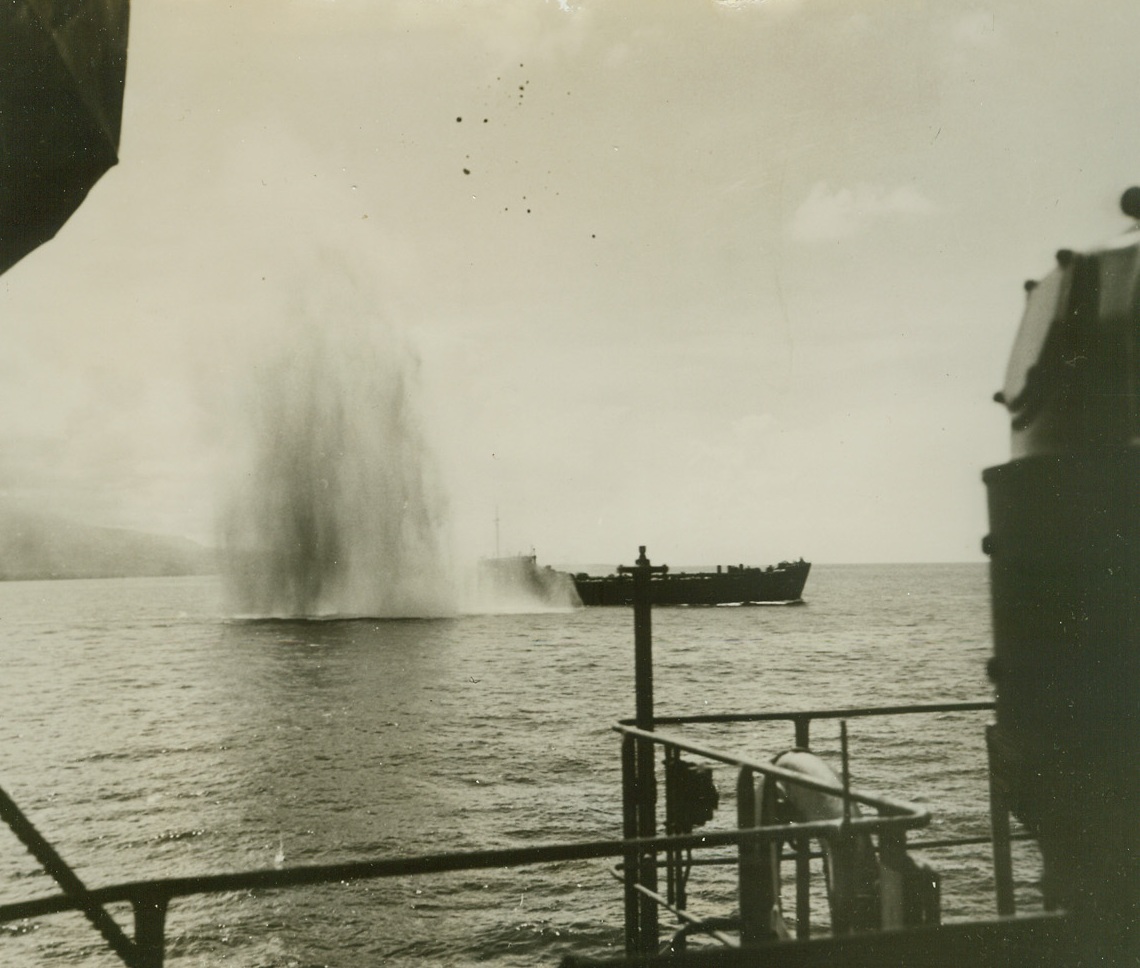
Close, But no U.S. Landing Ship, 1/10/1944. The crews of two coast guard-manned ships heave a relieved sigh as a Jap bomb plunges between the pair of vessels aiding in the invasion of Cape Gloucester, New Britain. The ships are packed with Marines and equipment, both ready for the push ashore.Credit (U.S. Coast Guard photo from ACME;
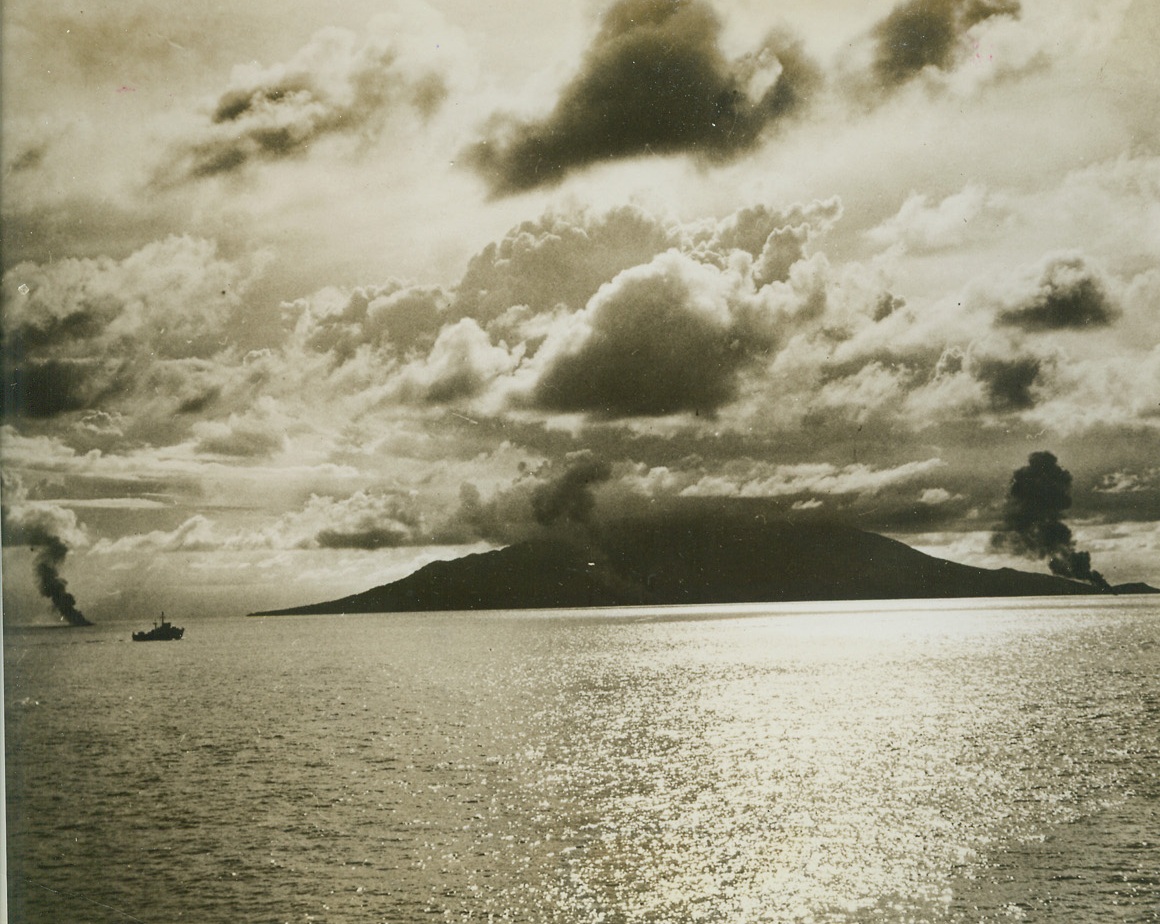
Jap Warbirds Crash at the Cape, 1/8/1944. Cape Gloucester, New Britain – Only thin columns of black smoke remain of three Jap planes that attempted to attack Coast Guard and Navy-manned LSTs invading Cape Gloucester. The pyres burn at extreme left, center, and extreme right of photo, marking the spots where the ill-fated attackers plunged into the sea.Credit Line (U.S. Coast Guard photo from ACME);
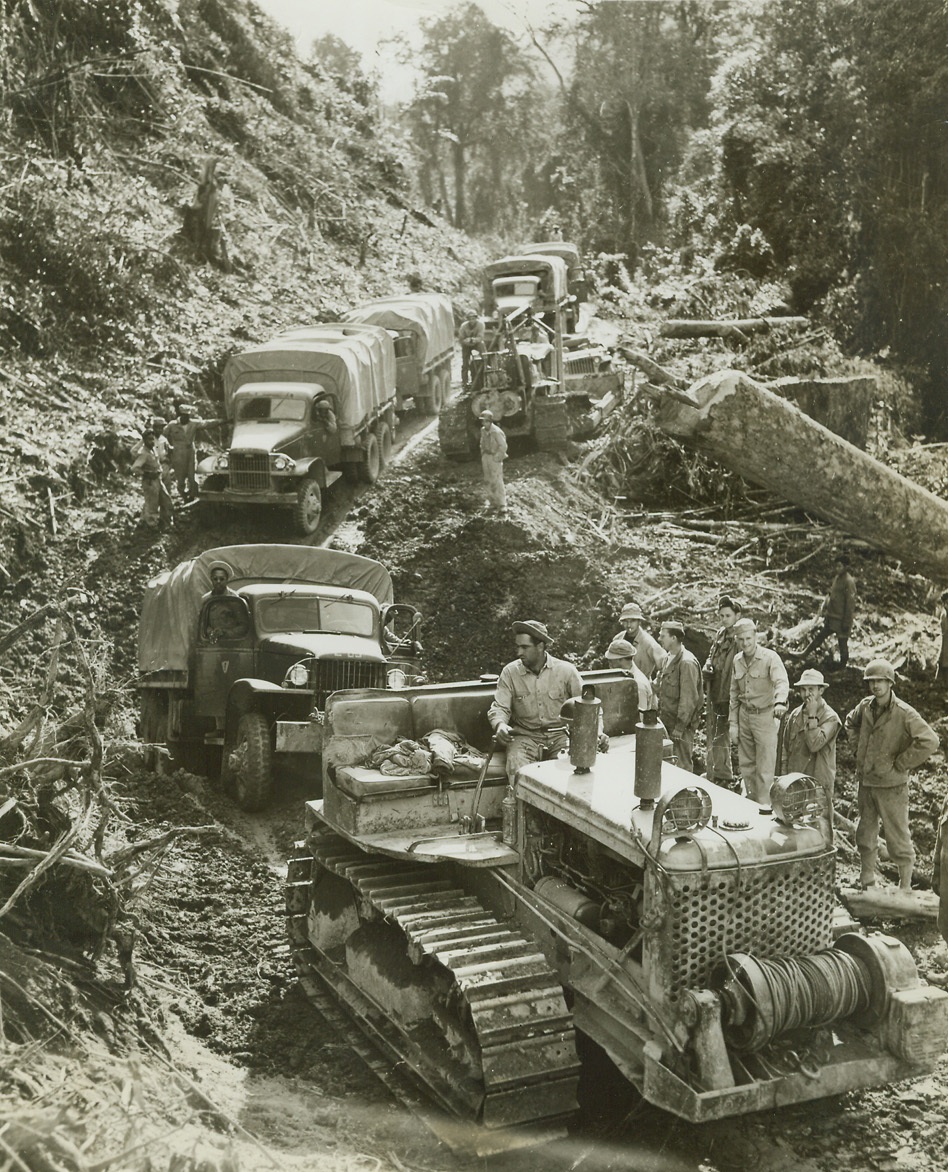
Inexperienced Drivers Need Not Apply, 1/25/1944. Burma – The lead car of a convoy bogs down on what drivers call a “tough spot” on the Ledo supply road to China, and a caterpillar comes to the rescue of the caravan. The bumpy, twisty road is being built by American engineers, and up to now it is a “dead end” trail with Japs as a road block.Credit (ACME photo by Frank Cancellare, War Pool Correspondent);
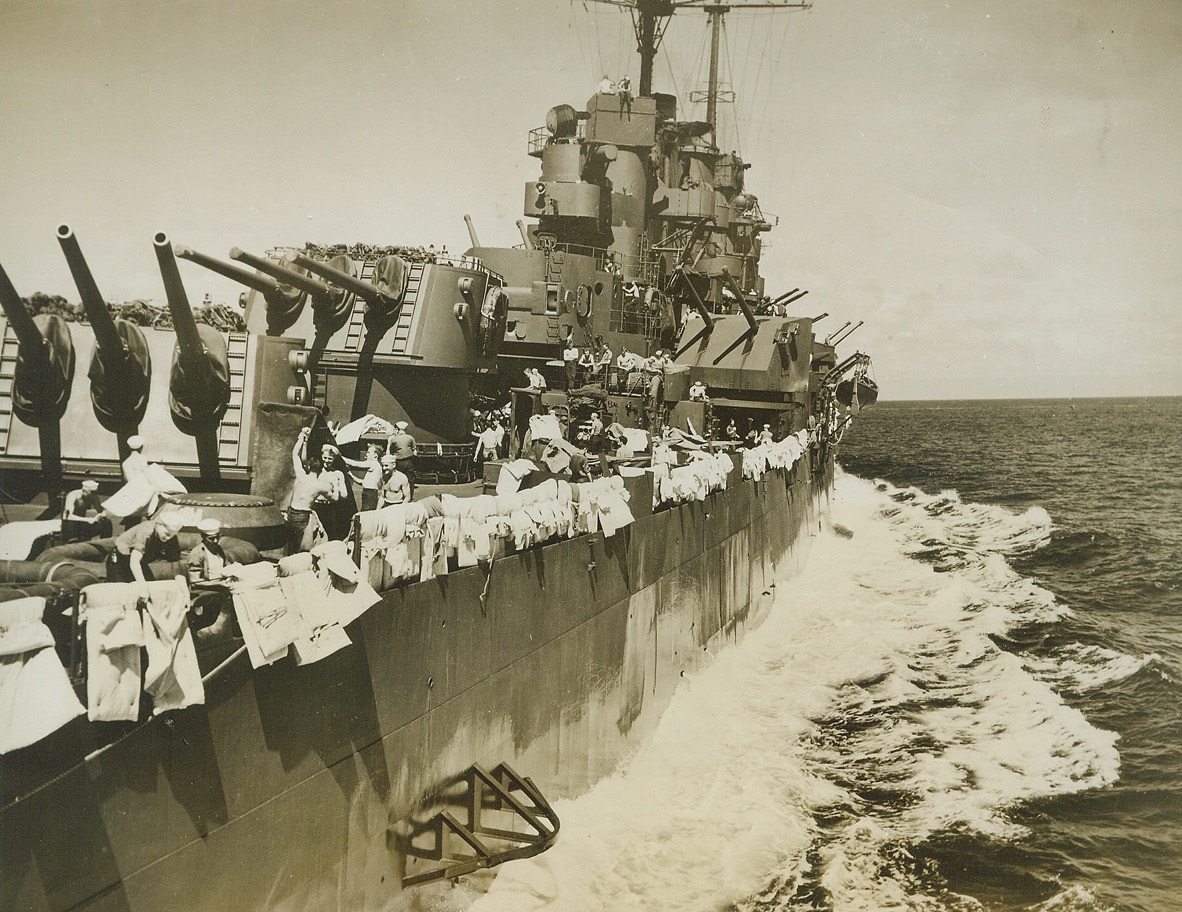
Shakedown Cruise, 1/26/1944. AT SEA -- A vital part of the training of men who fight at sea is the shakedown cruise, the run on which embryo sailors try their sea legs, get acquainted with their shipmates, and learn how to operate their ship. Navy regulations insist that bedding be aired once a week, and gobs on their shakedown cruise comply with the rules, stringing their bedding along the side. Credit: (Official U.S. Navy Photo from ACME);
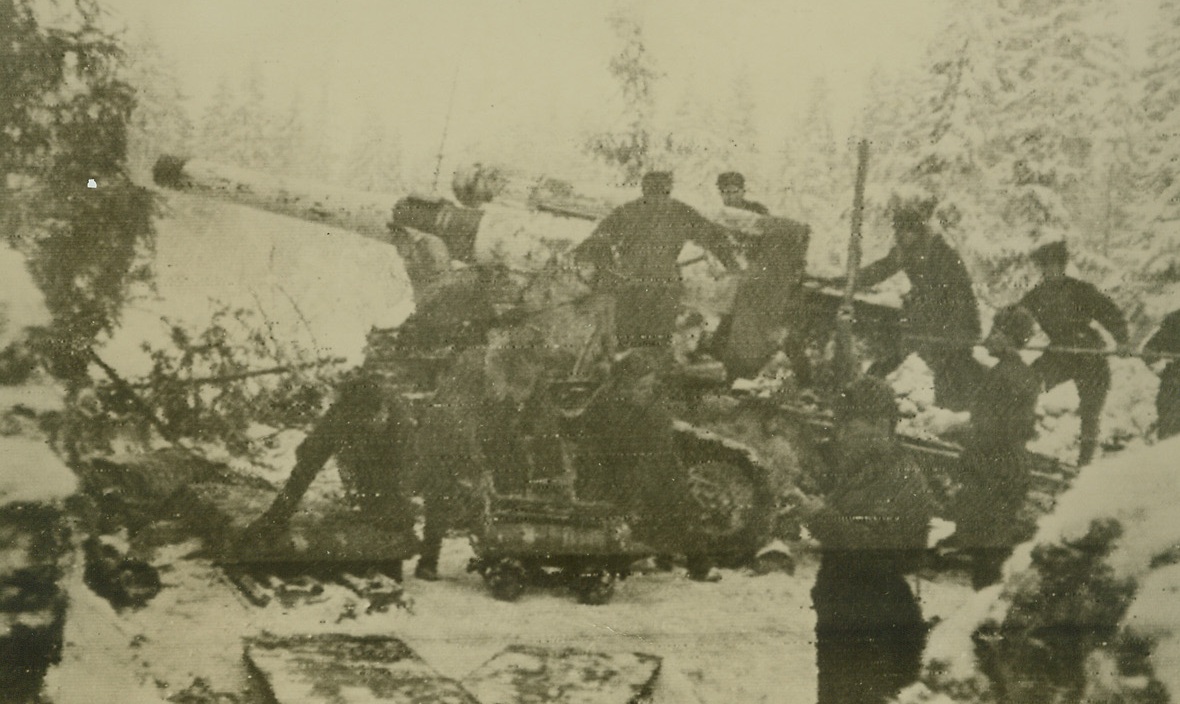
Shelling Nazis, 1/17/1944. ON THE RUSSIAN FRONT—Shelling enemy communication lines, a heavy Soviet gun makes things hot for the Nazis in the Vitebsk area, as the Russians fight in a snowbound forest. Photo radioed to New York today (January 17th) from Moscow.Credit: ACME Radiophoto;
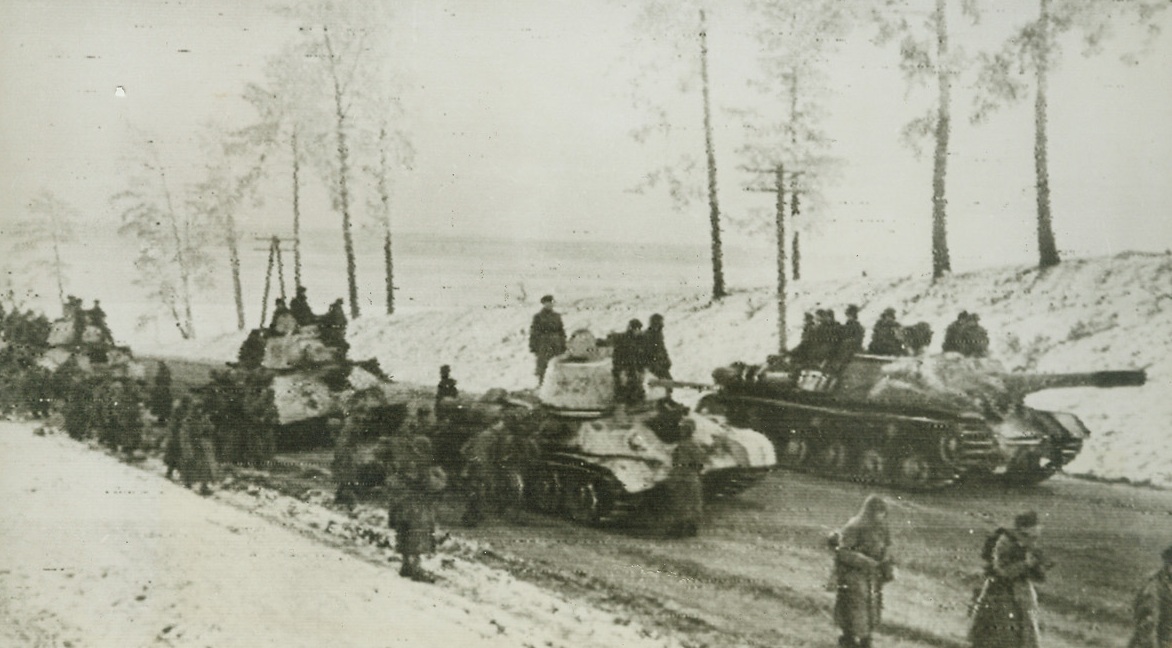
Speeding Toward Nazi Lines, 1/17/1944. UKRANIAN FRONT—Carrying tankborne infantry toward the front, Soviet self-propelled guns and tanks speed along a snow-banked Ukranian road as they chase the fleeing Nazis. Photo radioed to New York today (January 17th) from Moscow.Credit: ACME Radiophoto;
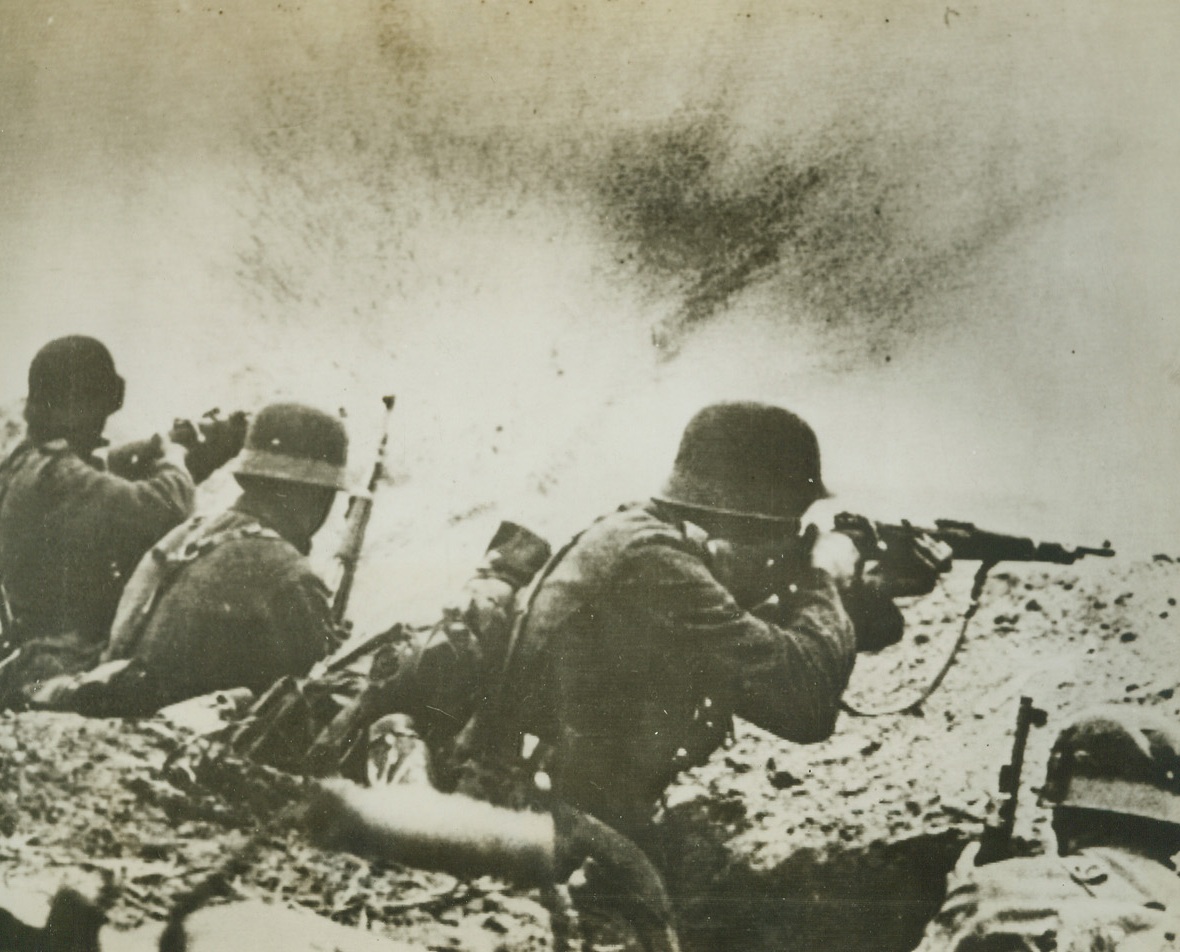
A “Hot One” for Fritz, 1/20/1944. A Russian shell bursts on the parapet of a German trench “somewhere in the South Russian front,” in this photo just received from a neutral source. Nazi soldier, in foreground, ducks the shower of dirt and shell fragments, while his comrades keep firing their rifles. Today it was announced that the key city of Novgorod in North Russia has been captured from the Germans, while the Soviet advance in the south continues. Passed by censors.Credit: ACME;
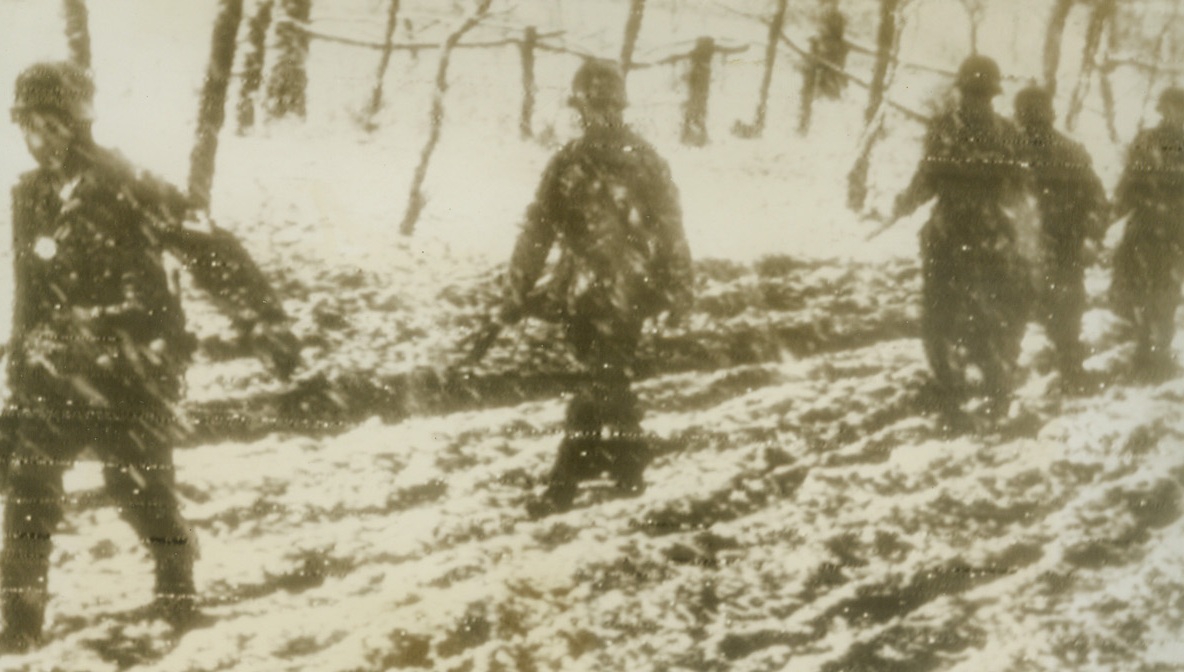
”To the Rear—Slosh” for the Nazis in Russia, 1/4/1944. RUSSIA—Although news dispatches describe the Nazis as “reeling” backward before the Russians, actually the German soldiers are slogging and sloshing their way in retreat to the west. Here, enemy infantry troops wade ankle-deep in cold, cold mud with a mechanized wake of Russians. Photo radioed from Stockholm to New York today.Credit: ACME;
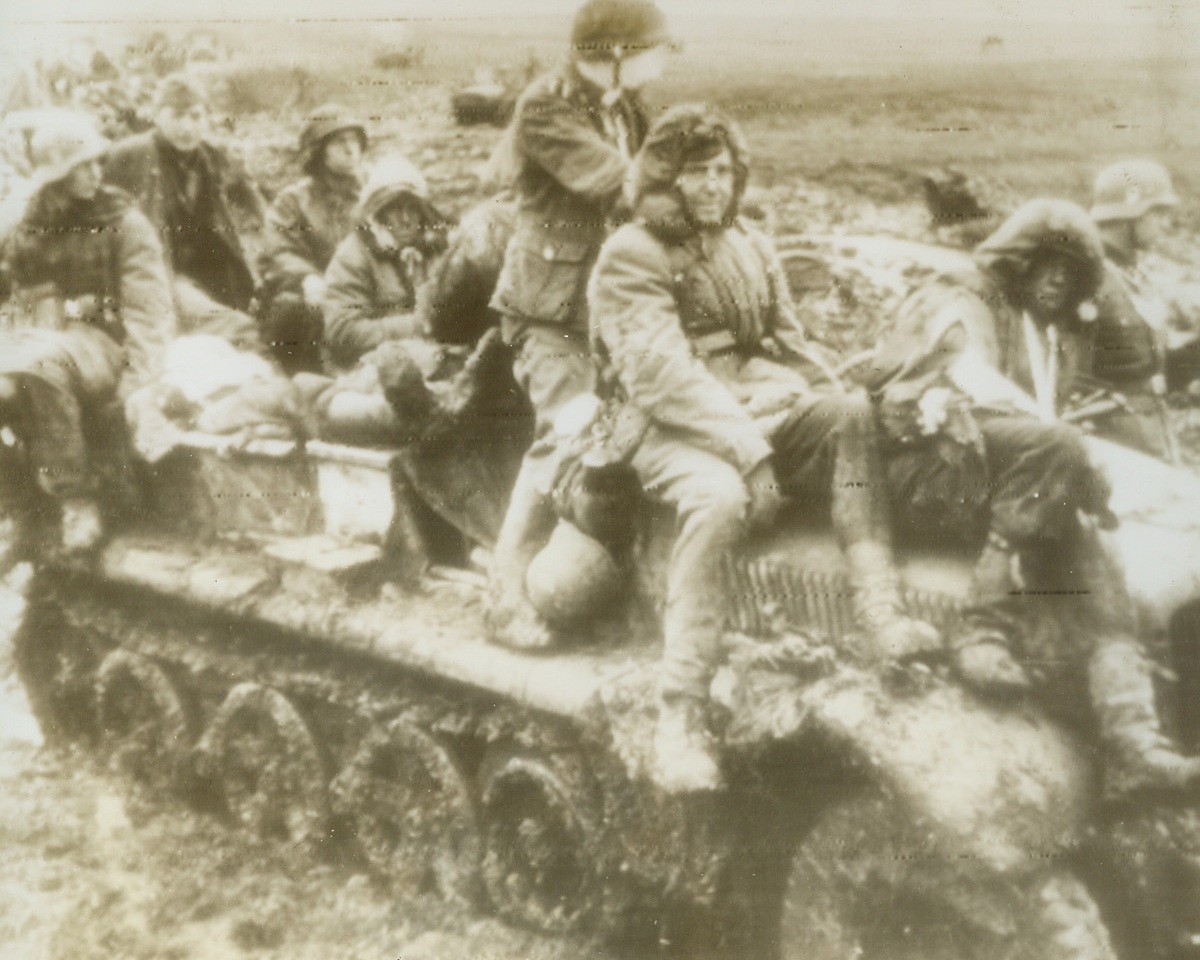
”Show Me the Way to Go Home”, 1/4/1944. RUSSIA—Wounded, exhausted Nazi SS troops sprawl on a half-track that is headed for rest quarters on the bloody Russian front. They have just been relieved by other war-weary fighters, and every day brings more miles of retreat. Photo radioed from Stockholm to New York today.Credit: ACME;
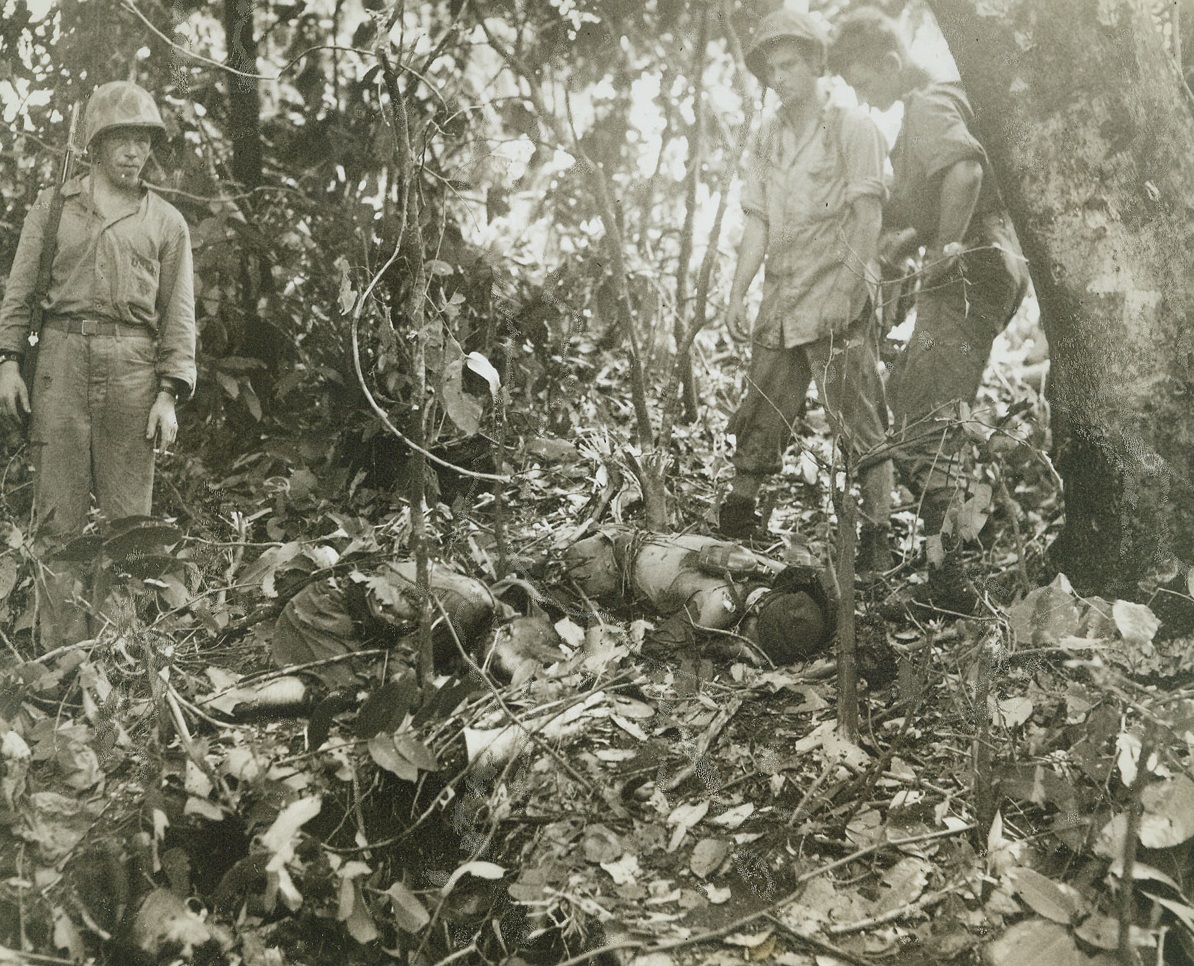
Well, They Tried…., 1/18/1944. NEW BRITAIN – A group of leathernecks looks down at the bodies of Jap soldiers who tried to hold their pill box at all cost in the battle for Cape Gloucester. The enemy fighters were made to pay the price by our convincing 75mm Howitzers. Credit: ACME photo by Frank Prist Jr. for the War Picture Pool;
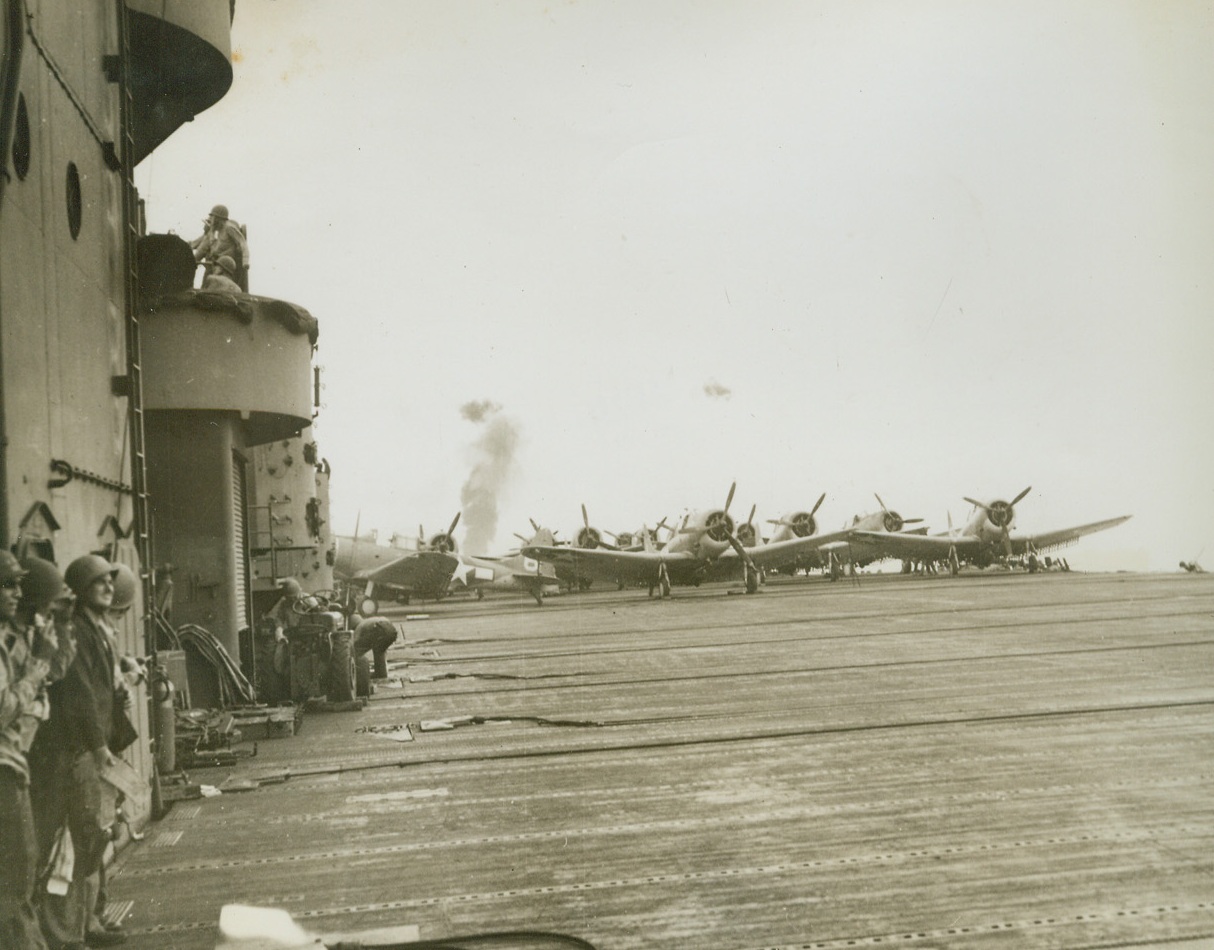
Another Zero Bites the Dust, 1/18/1944. At Sea – Ack-ack scored another hit when an attacking Jap zero missed its American target and was sent down to a watery grave. Only a thin column of smoke in the distance is left of the enemy war bird, one of 63 downed by a carrier task force in the American assault on Rabaul on November 11, 1943. Credit line (Official U.S. Navy photo from ACME);
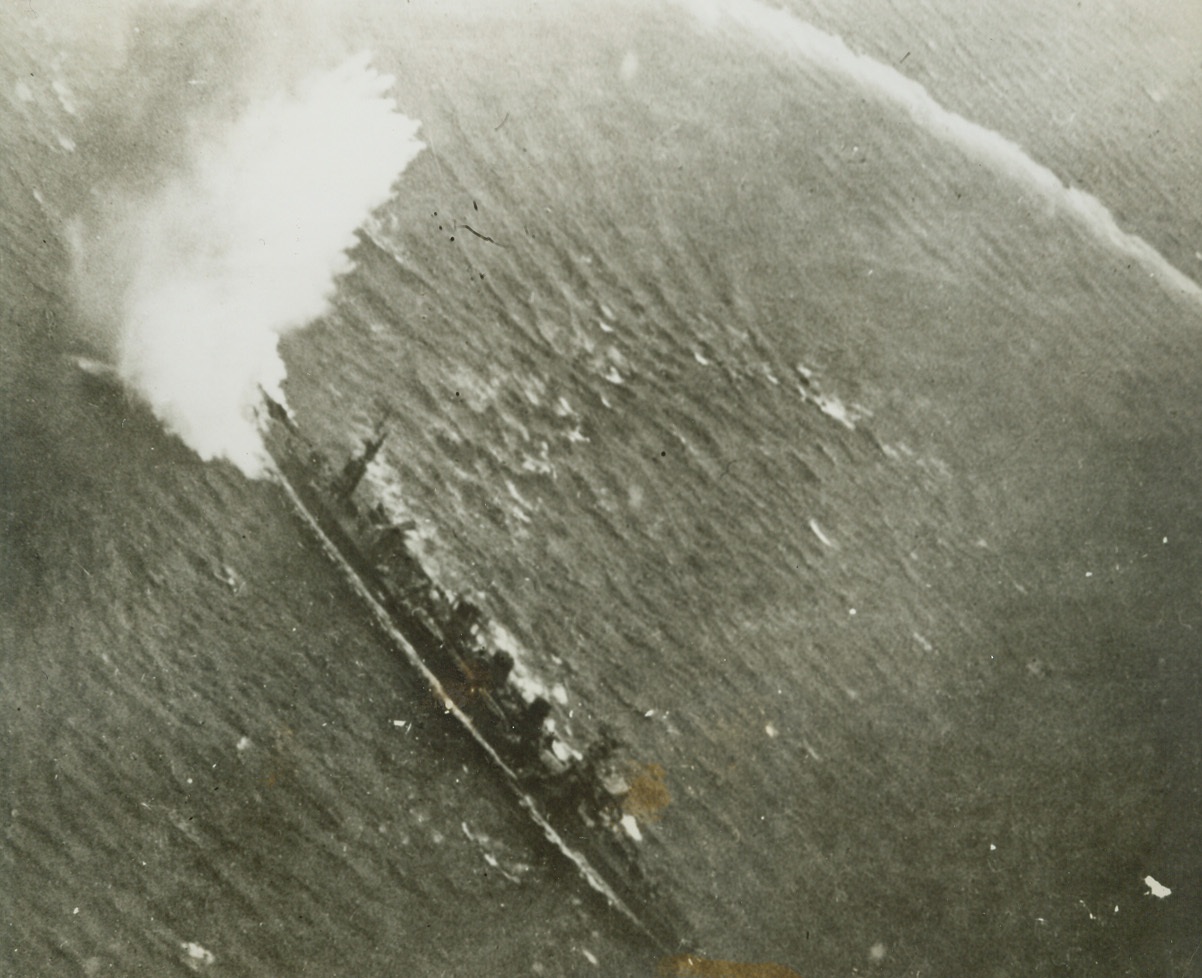
Death Dance of a Jap Cruiser, 1/28/1944. Marshall Islands – Round and round she goes, with the white line at the right marking her swirling wake, but a Yank torpedo gets the Jap cruiser with a clean hit. A Grumman avenger released the tin fish that sank the wildly-maneuvering enemy ship at Kwajalein Atoll in the Marshalls, December 4, where a U.S. Navy task force left death and destruction. Credit (Official U.S. Navy photo from ACME);
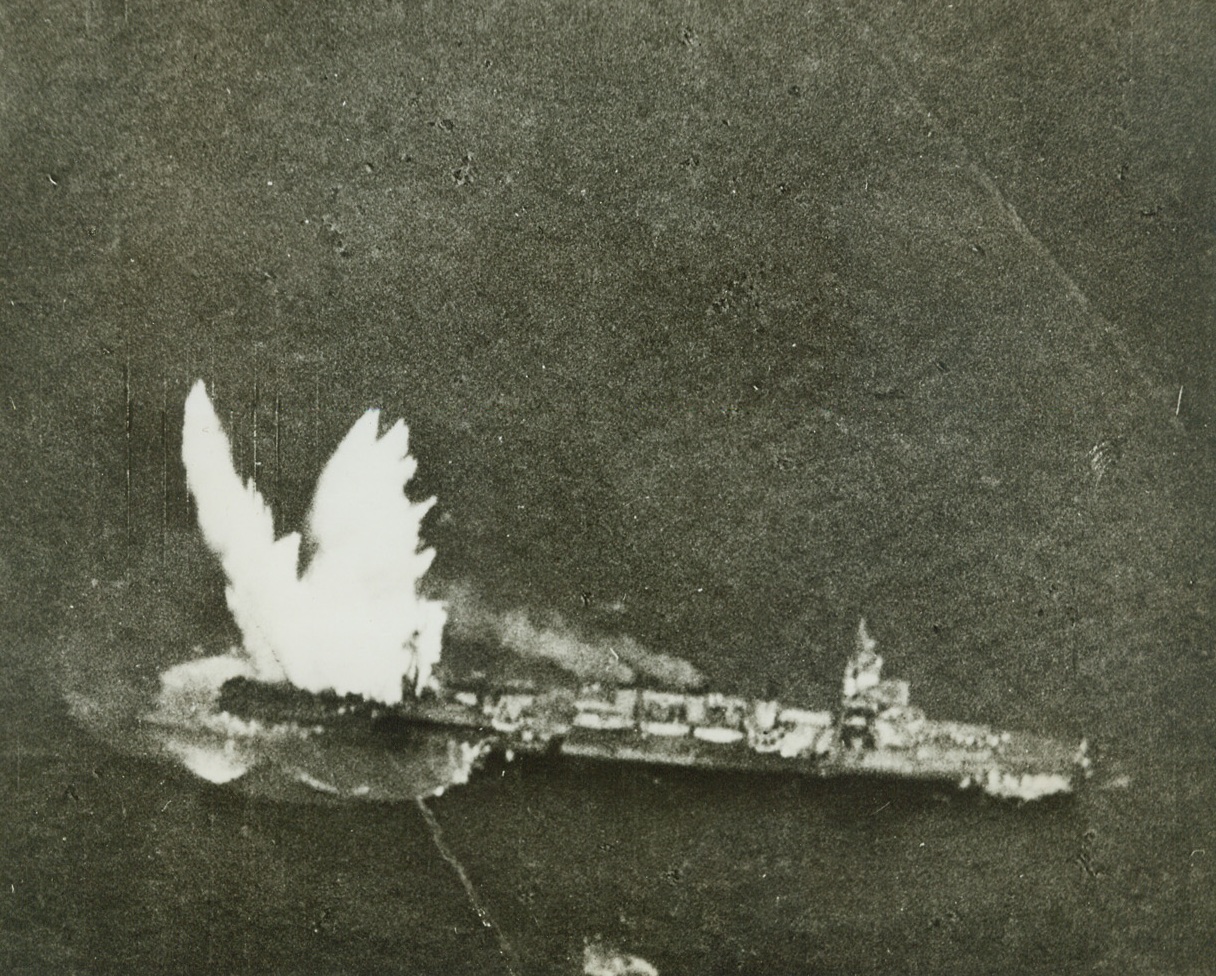
“Dive Bombers Paradise, Japanese Hell” – 2, 1/28/1944. Marshall Islands – A towering plume of white shoots far over the stern of a Japanese light cruiser of the Kuma class as an American torpedo strikes home while (upper right) the wake of another torpedo released by a Grumman avenger is clearly seen. The second torpedo plowed harmlessly past the bow of the ship, one of two light cruisers sunk in the December 4, 1943 Navy task force raid on Kwajalein Atoll in the Marshalls where the enemy lost 72 planes, two light cruisers, three cargo vessels and a large tanker. Four other cargo ships sustained direct hits and were left smoking by our carrier-based dive bomber, torpedo and fighter planes. Credit (Official U.S. Navy photo from ACME);
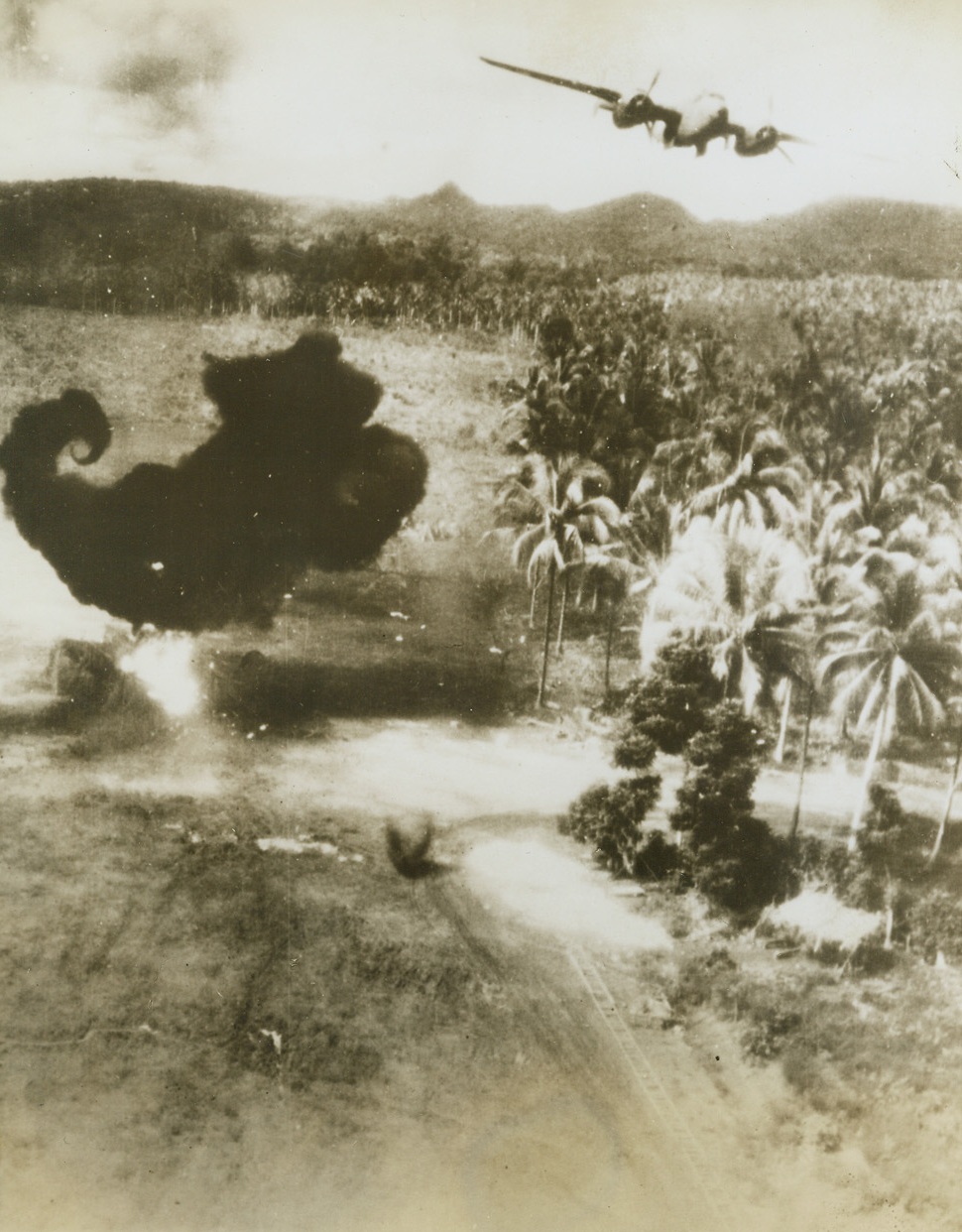
Treetop “Call” for Japs, 1/25/1944. A B-25 Mitchell bomber of the U.S. Army 5th Air Force, comes in at treetop level to blast installations, while a Jap plane burns fiercely (left) on the fighter strip at Alexishafen, above Madang on the North coast of New Guinea, during a recent raid. Credit line (U.S. Army Air Force photo from ACME);
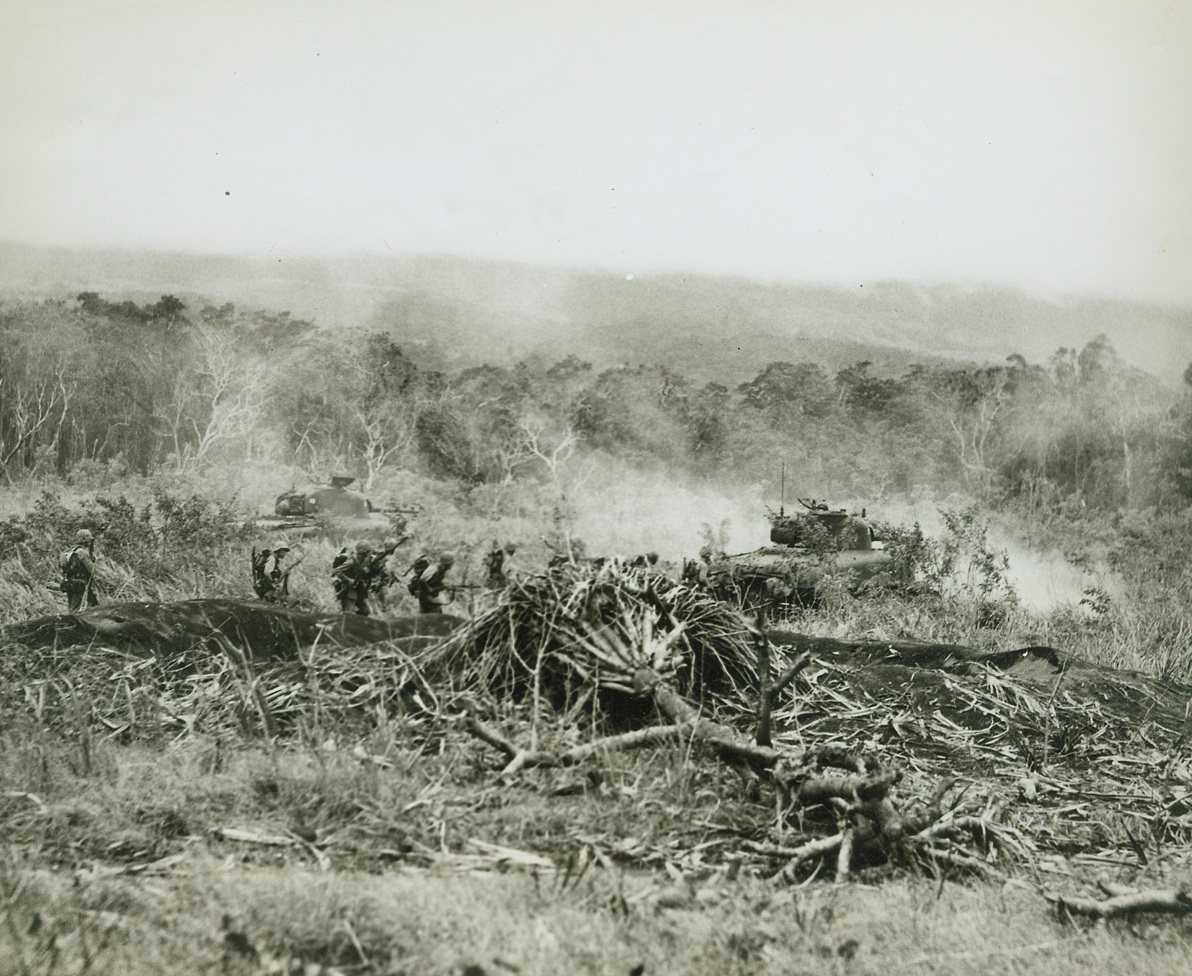
Tanks Lead the Way, 1/18/1944. New Britain – With their tanks spitting fire as they lead our fighters into the babble for Cape Gloucester airfield, hunched Leathernecks follow close behind to take care of all Jap snipers who might be in nearby trees. Battle smoke begins to cloud the fighting field as the boys creep past a large bomb crater made by our raiders before the big push. Credit line –WP- (ACME photo by Frank Prist, Jr for the War Picture Pool;
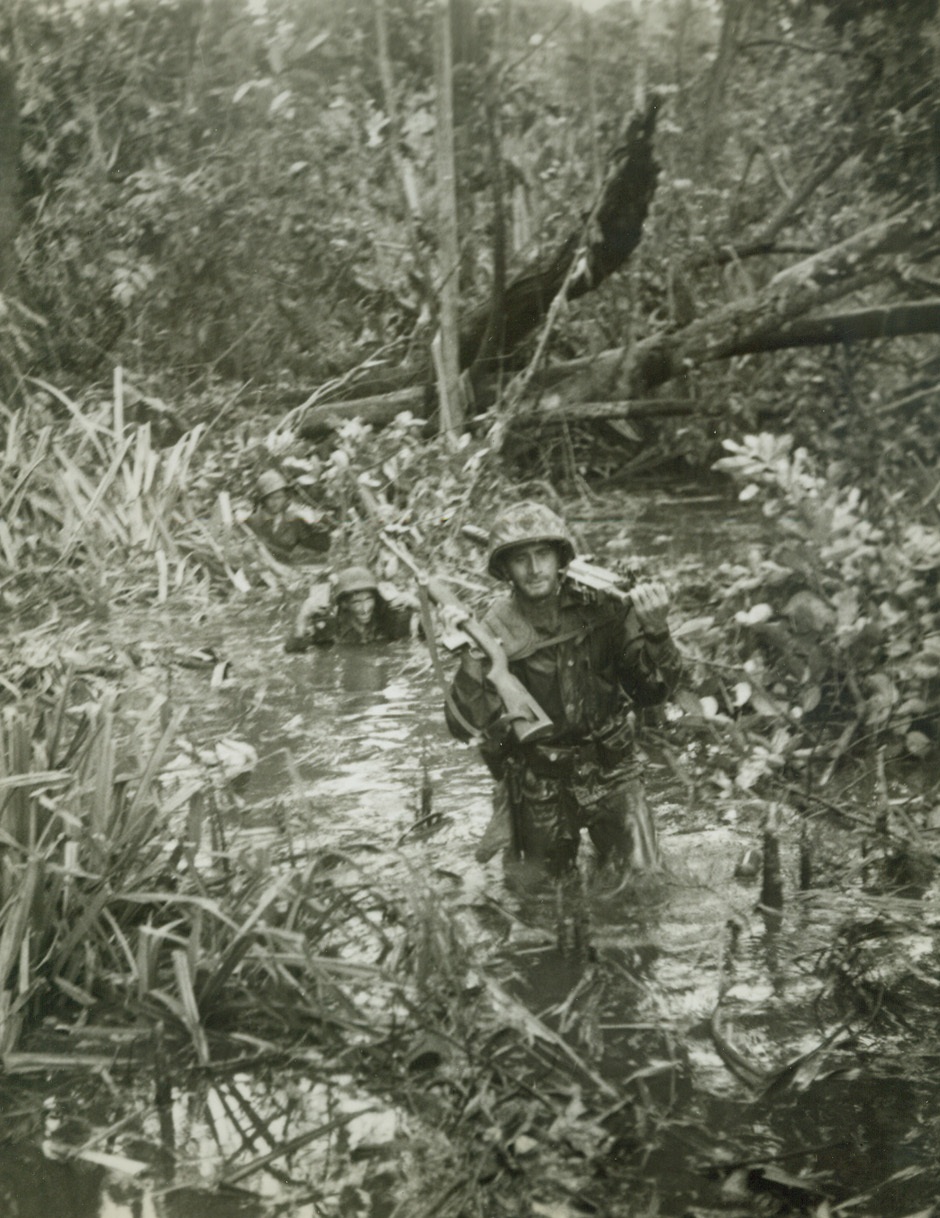
Sloppy Trip, 1/18/1944. Cape Gloucester, New Britain – Only their rifles and ammunition stay dry as these Marines push ahead through Cape Gloucester’s jungle swamps and streams. Making their way to the front lines after landing at the Cape, the fighting Leathernecks had to take miles and miles of this sloppy terrain in their stride before their job was done. Credit line is not shown;
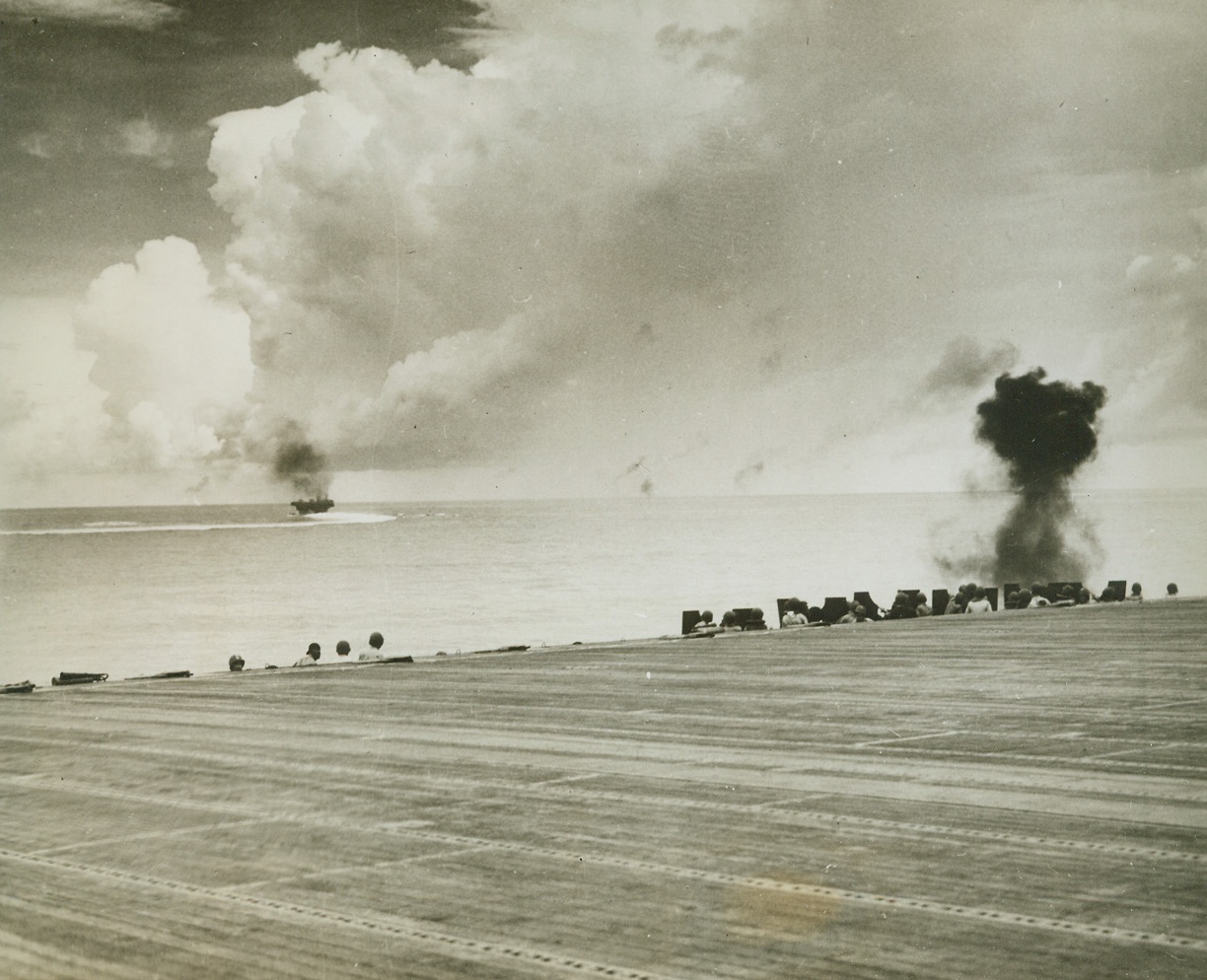
Bye, Bye, Zero, 1/18/1944. At Sea – One puff of thick black smoke marks the watery grave of a Jap zero, shot down along with 63 other enemy planes during a savage counter attack on the U.S. task force that raided Rabaul on November 11, 1943. Destroying that great number of war birds, our carrier task force demonstrated its power – proving that outfits of this kind pack a tremendous wallop. Credit line (Official U.S. Navy photo from ACME);
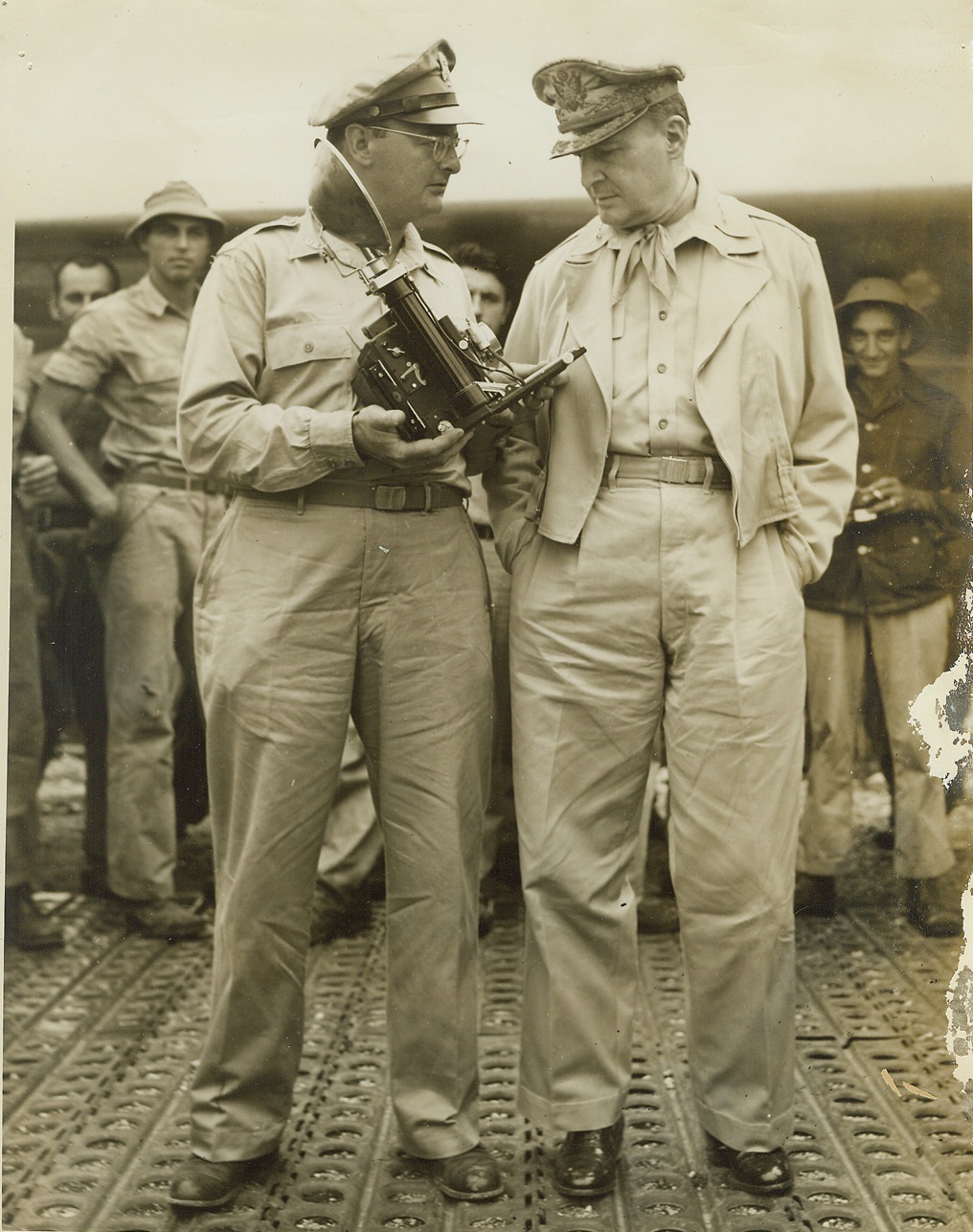
ACME Correspondent With MacArthur, 1/11/1944. NEW GUINEA -- Ware Correspondent Thomas L. Shafer, (left), Photographer for ACME Newspictures, Inc. is shown with Gen. Douglas MacArthur, Supreme Allied Commander in the Southwest Pacific, as Shafer explains the workings of a Speed Graphic Camera. Credit: ( ACME Photo by Thomas L. Shafer for the War Picture Pool);
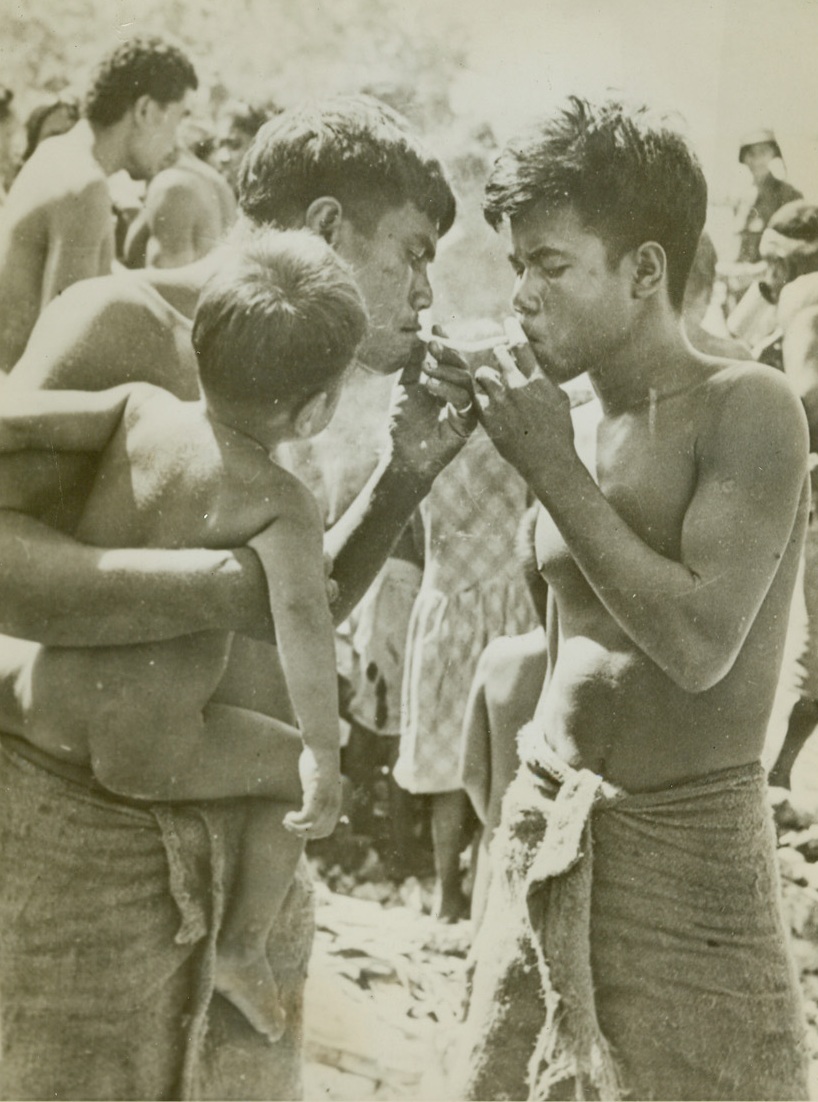
Lighting Up, 1/7/1944. Butaritari Island, Makin – Holding his naked son, a Makin native is about to enjoy the luxury of an American cigarette as he grubs a light from one of his neighbors. This crowd of natives, huddled on rocky Red beach, is about to be evacuated from the area by Americans who hold the beach. Credit line (U.S. Signal Corps photo from ACME);
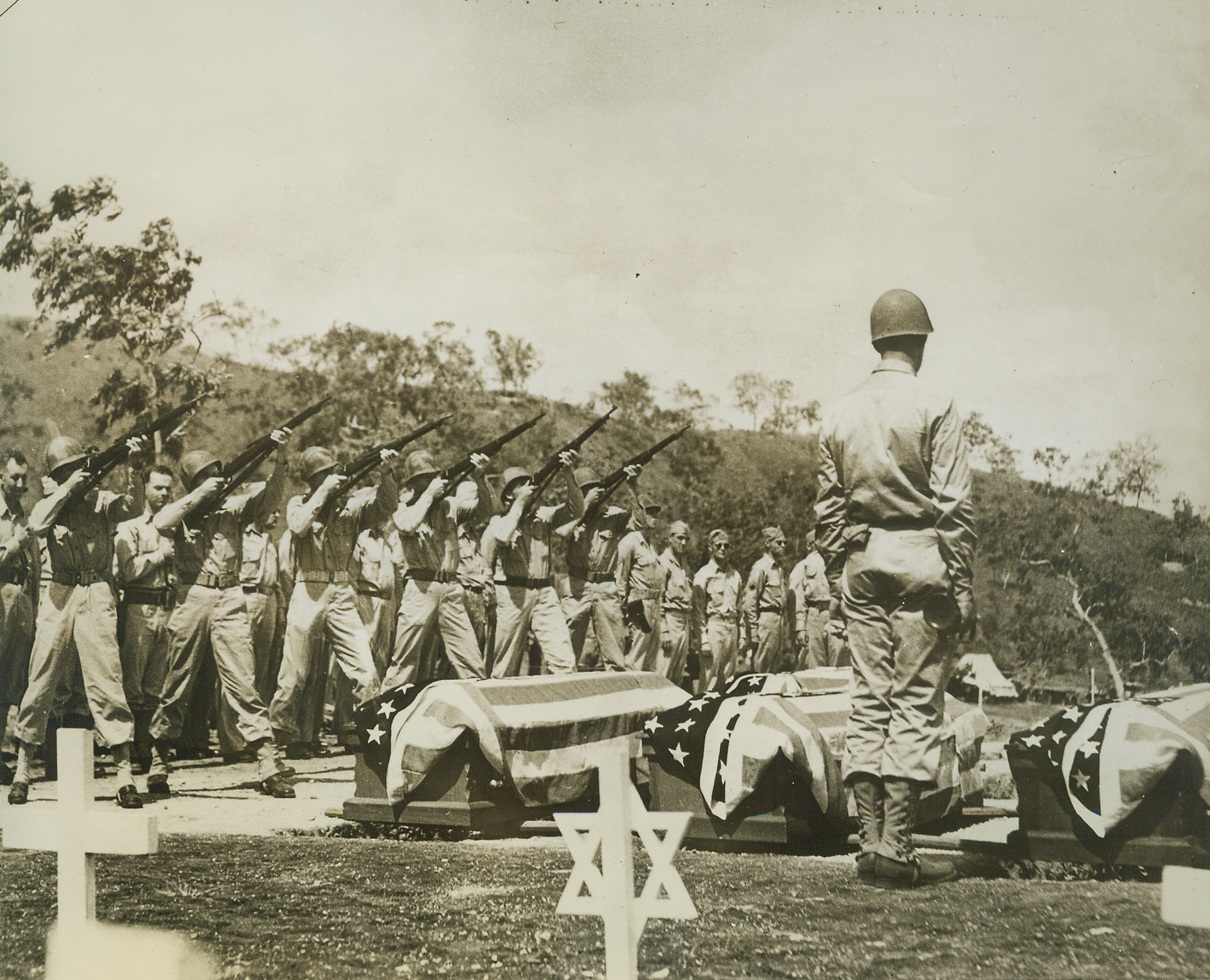
Military Funeral for Officer and Correspondent, 1/11/1944. New Guinea – A firing squad salute precedes the burial of an American officer, UP war correspondent Brydon Taves, and Harry Poague, another war newsman, who were killed in an airplane accident in New Guinea. They are buried in the American military cemetery near Port Moresby. Credit (Official U.S. Army photo from ACME);
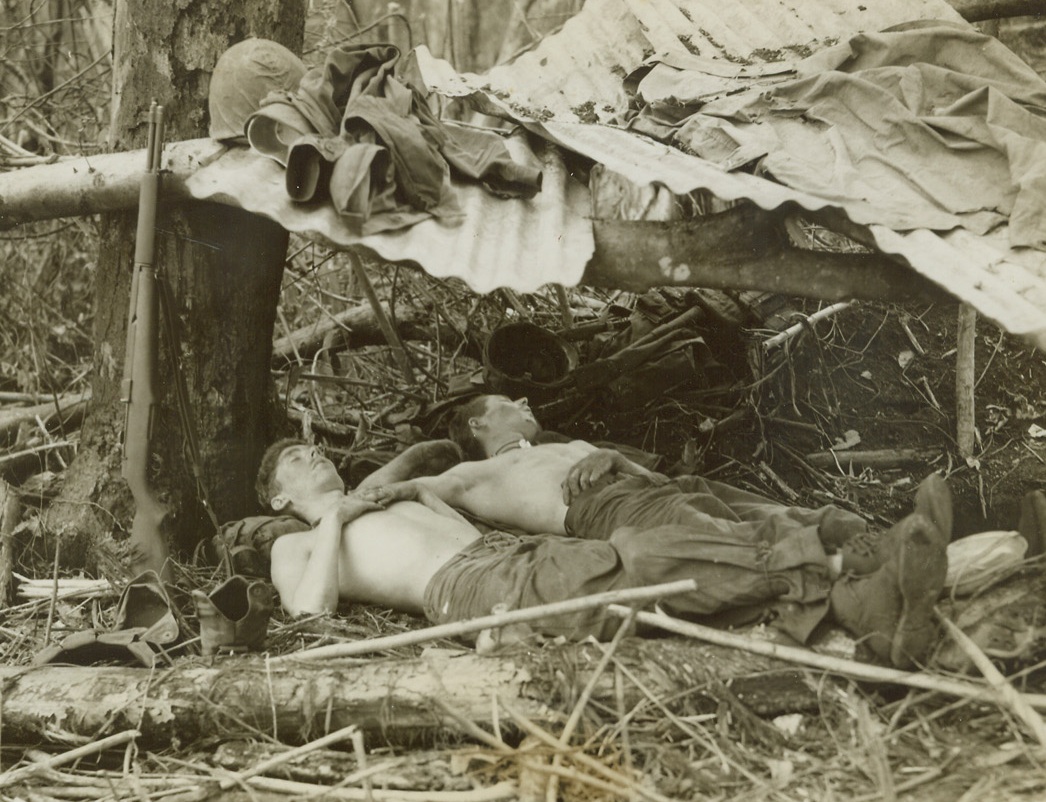
Babes In the Woods, 1/31/1944. Cape Gloucester – These two U.S. Marines were quick to take advantage of a lull in the fighting at the base of Hill 660, vital strongpoint in the Jap defense line near Cape Gloucester, to “hit the sack”. Here, they sleep peacefully under a crude shelter to keep out the heavy rains, on the 18th day of the fighting for the hill, which eventually fell to the fighting U.S. Leathernecks. Credit line (ACME photo by Thomas L. Shafer for the War Picture Pool);
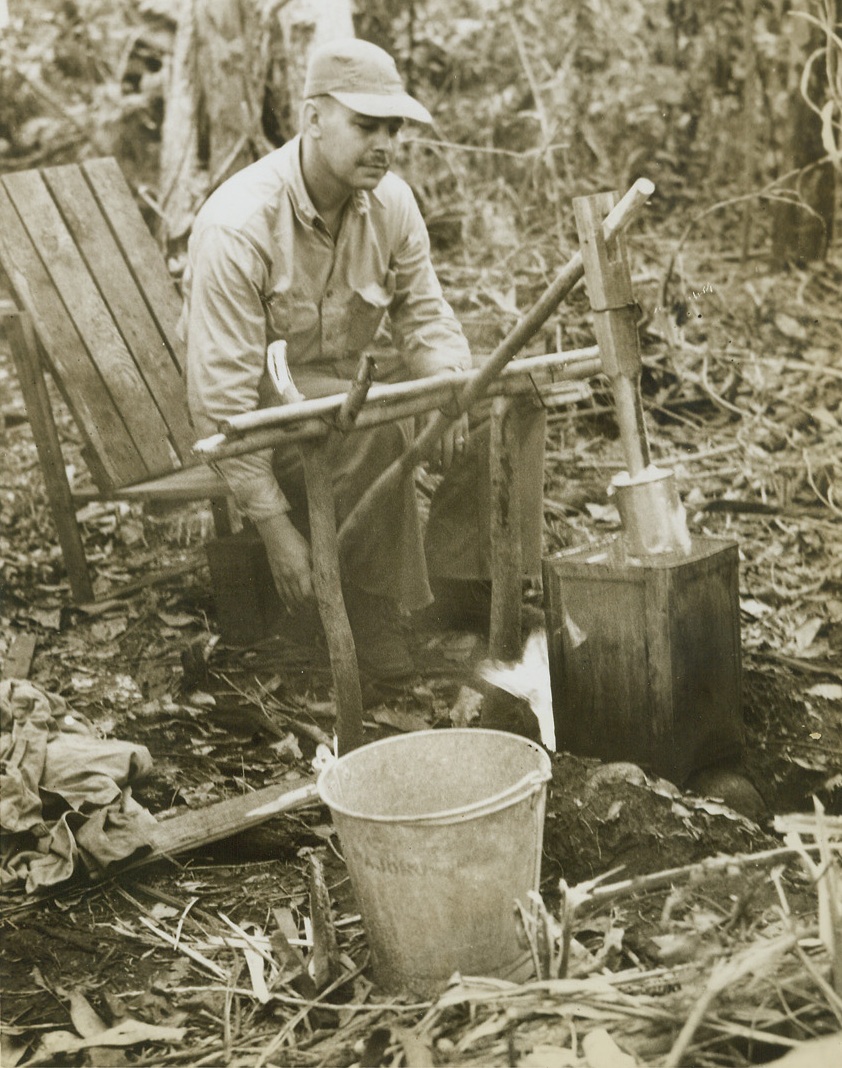
Wash Day in New Britain, 1/31/1944. New Britain – Major H.R. Kolp, USMC, of Akron, Ohio, does his washing in a homemade “washing machine”, made of a 10 gallon fruit can placed over a fire built in a pit. An agitating plunger—a can at the end of a piece of wood—the clothes. Credit line (ACME photo by Thomas L. Shafer for the War Picture Pool;
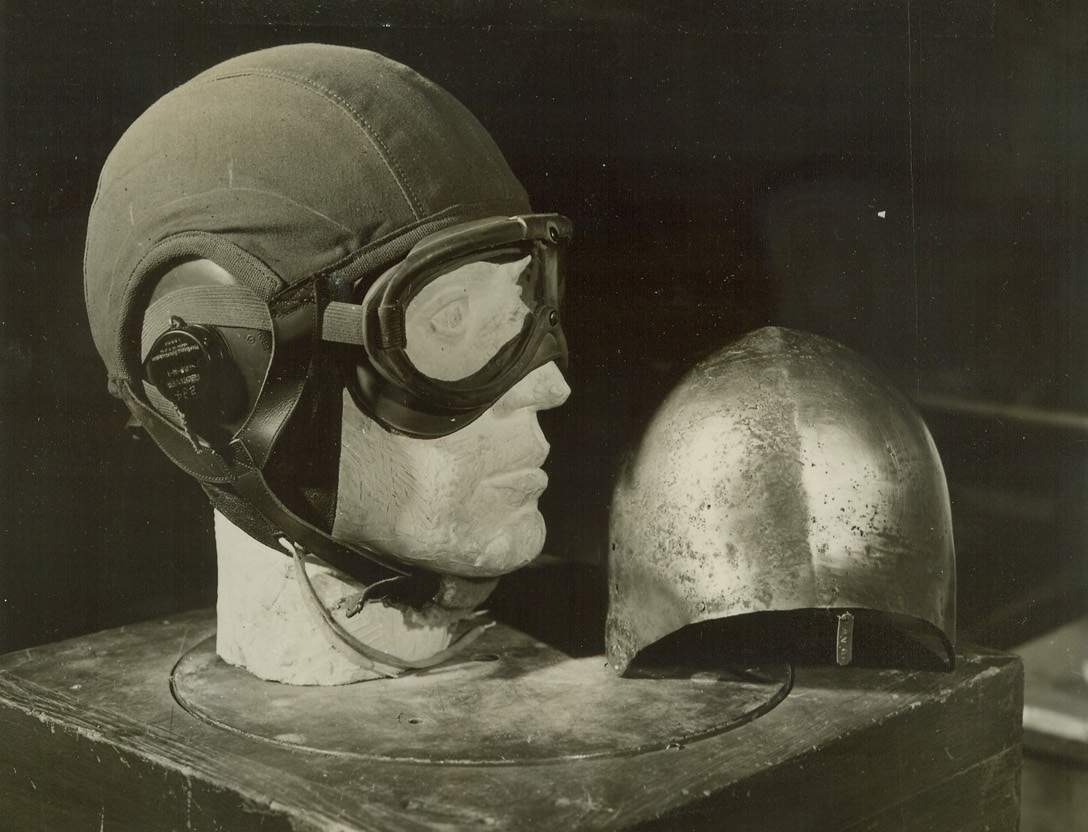
Ancient Museum Tools Make Modern Armor – 2, 1/14/1944, New York City – Tools, hundreds of years old and part of a display in the Metropolitan Museum of Art in New York city, are now being used by armorers at the museum to create body and head armor for American fliers of World War Two. The Metropolitan Museum was chosen for this work, which began last August, because it boasts the largest collection of ancient armorer’s tools in the world. The work of experimentation and improvement of body armor and helmets worn by aircraft crews goes on behind a steel door, in strictest privacy. Here is the skull cap of cloth, which is worn under the modern aviator’s helmet developed by the museum. At right is an Italian helmet of first half of the fifteenth century. Credit line (ACME);
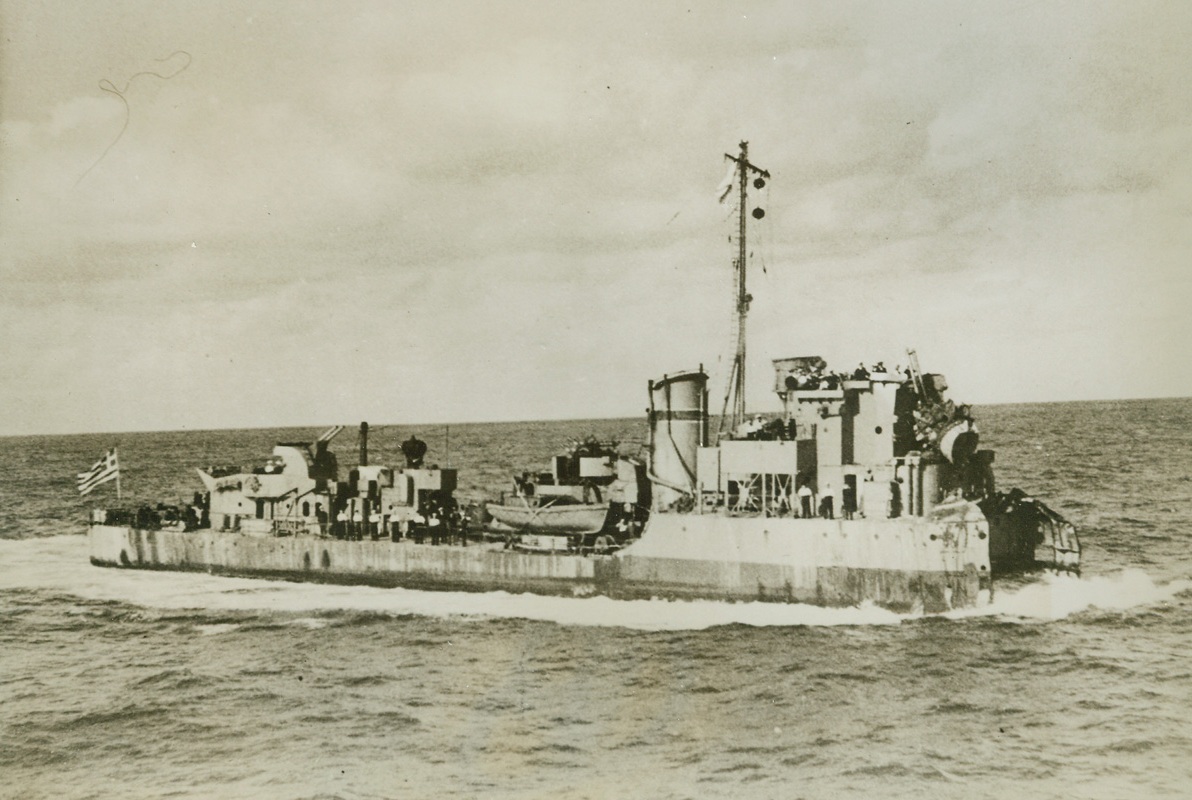
Bowless Ship Plows Home, 1/27/1944. Alexandria, Egypt – With her bow blown off by a mine in the Aegean, the Greek destroyer “Adidas” comes into Alexandria at a speed of eight knots. Formerly the British hunt class destroyer “Border,” the “Half a Ship” raveled for over 500 miles through dangerous enemy waters. Credit line (ACME);
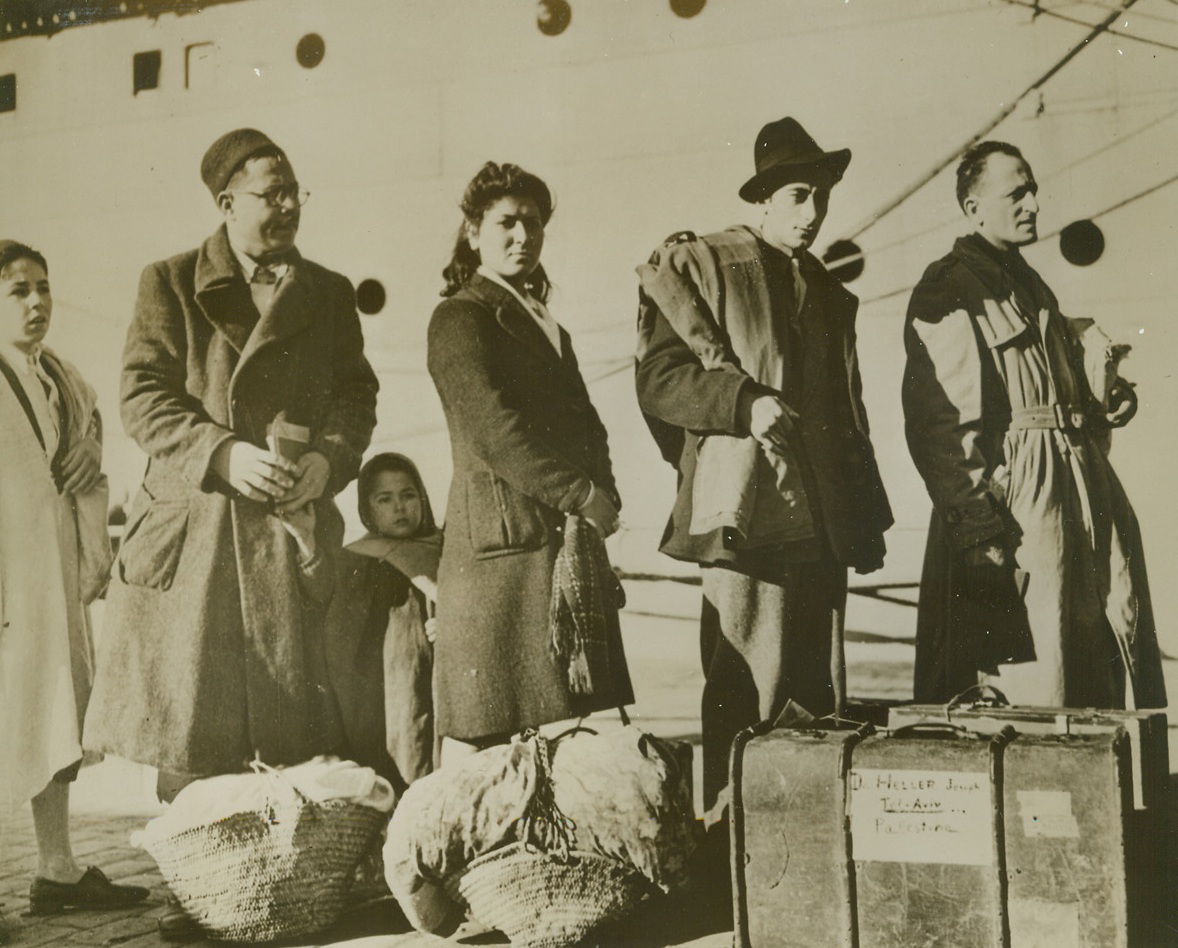
Heading For a New Home, 1/28/1944. North Africa – Jewish refugees line up on a dock in North Africa, awaiting their turn to embark for Palestine where they will become agricultural settlers. Through the cooperation of the American Jewish Joint Distribution Committee, British authorities and the American Office of Foreign Relief, they will find a new freedom. Credit line (ACME);
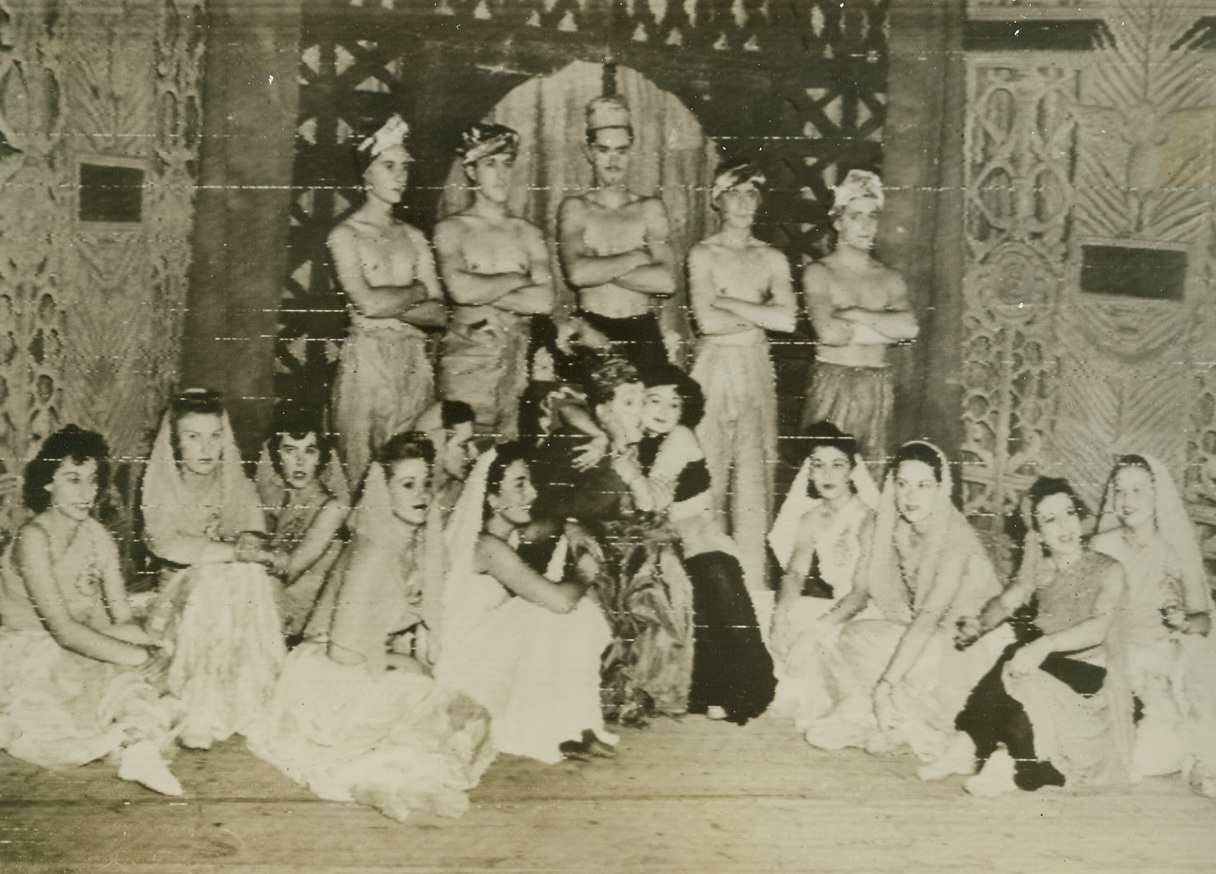
The WAC Swing, 1/5/1944. Algiers – S/Sgt Danny Webb of Hollywood, Calif., and Pfc Ona Freeman (both front center) of Kansas City, Mo., take the spotlight in this scene, the Harem number, from the all-soldier WAC musical comedy “Swing Sister WAC, Swing”. The revue was presented at the Algiers Opera House, to the delight of all servicemen stationed there. Credit (ACME photo by Charles Seawood for War picture pool, transmitted via Signal Corps radio telephoto);
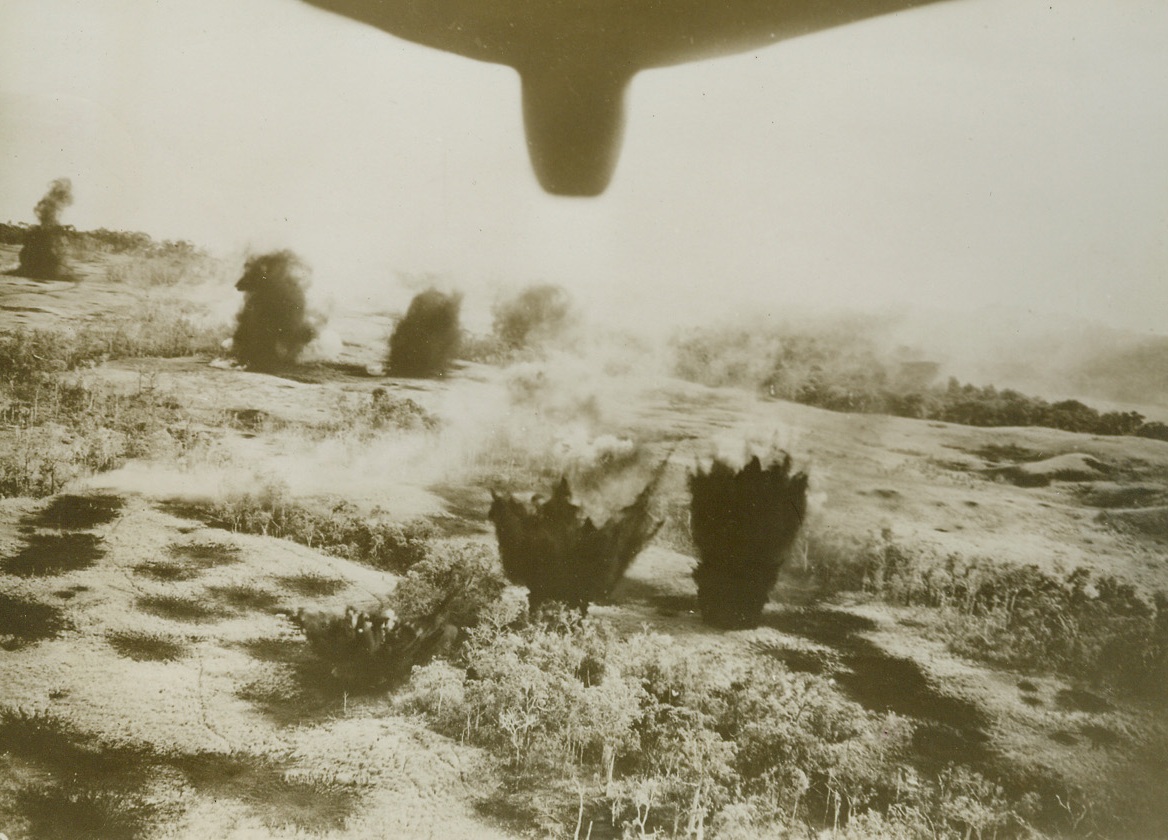
Fresh “Eggs” for Japs, 1/26/1944. Bombs from planes of the U.S. Army 5th Air Force, explode on installations and the Jap airfield at Cape Gloucester, in this photo just released in the U.S. The raid was part of the “softening up” process which preceded the Allied landing at the Southwest Pacific island of New Britain. When the landing was effected, American engineers immediately set to work to put the airfield in shape for use against the Jap base of Rabaul, New Britain.Credit: U.S. Army Air Force photo from ACME;
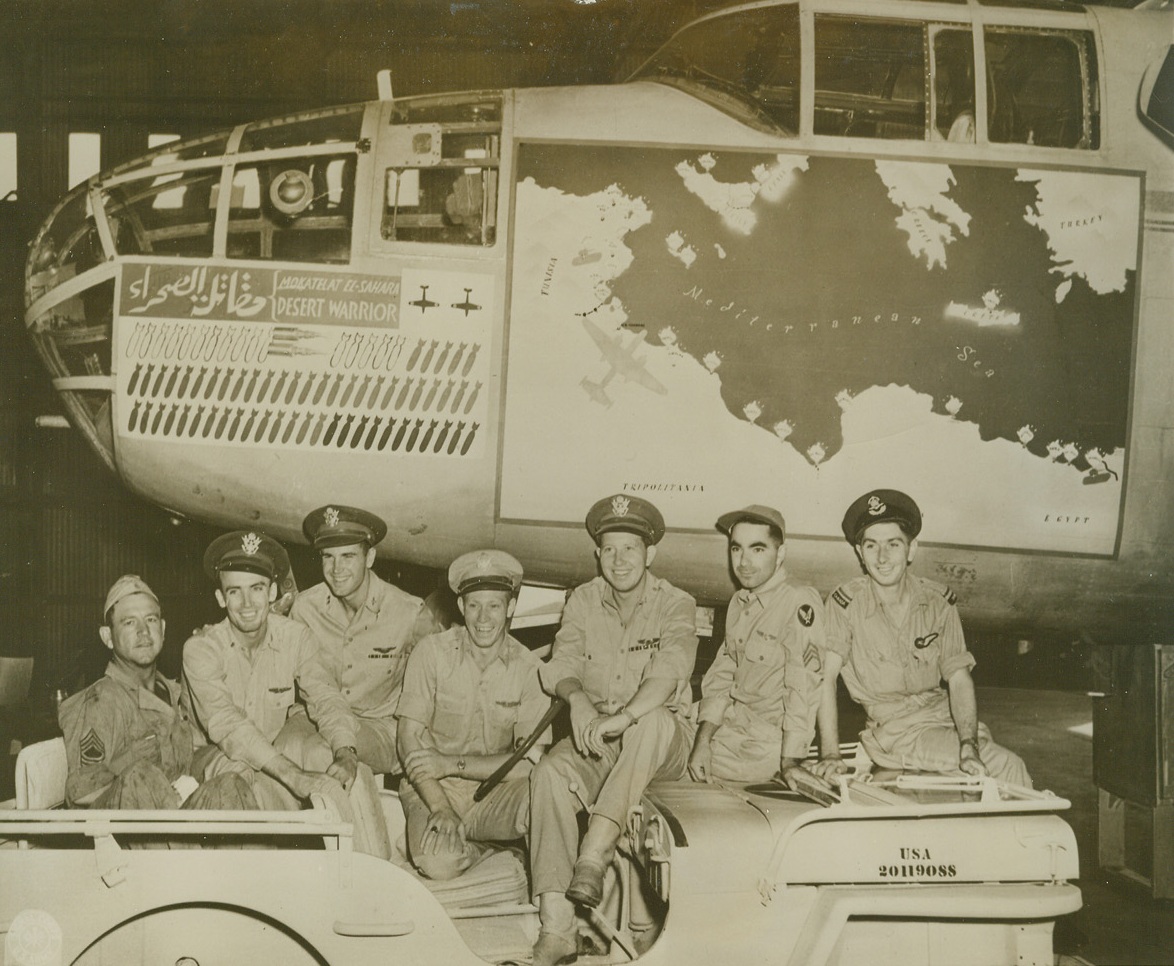
Next Mission—U.S.A., 1/10/1944. North African Theatre—The “Desert Warrior”, a well-decorated Mitchell B-25 bomber of the U.S. Army 9th Air Force, is shown just before it was taken by its crew to the United States after completing some of the most historic missions from the war from El Alamein to Sicily. The crew members seated on the Jeep are (left to right): Sgt. John R. Dawdy, of San Antonio, Tex.; Lt. Floyd R. Pond, Anadarko, Okla., navigator; Capt. Ralph M. Lower, Spokane, Wash., pilot; Lt. T.R. Tate; Lt. W.O. Seaman, Fresno, Calif; Sgt. J.B. Saragalo, Queens, N.Y.; and pilot officer A.A. Martin, British, of Columbia, Canada. The bombs painted on the cowling of the “Desert Warrior” represent the missions this ship performed. On the map are recorded the individual towns and battlefields bombed. Credit: U.S. Signal Corps photo from ACME.;
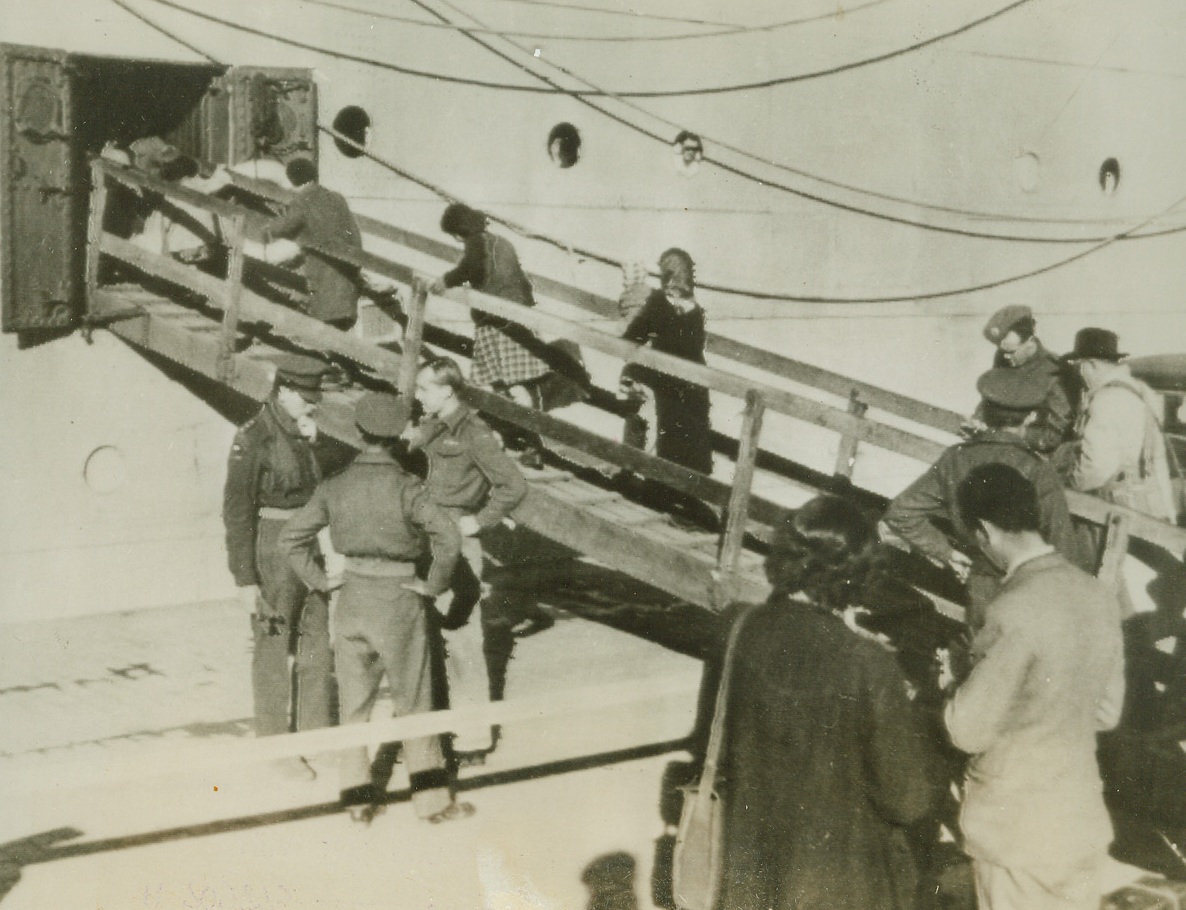
Heading for a New Freedom, 1/10/1944. A North African Port—These refugees, left homeless by Hitler’s ruthless advance in European countries, climb up the gangway of a ship at a North African port. They will be taken, with others, to Palestine where they will be given the opportunity to establish themselves as agricultural settlers. Credit: OWI radiophoto from ACME.;
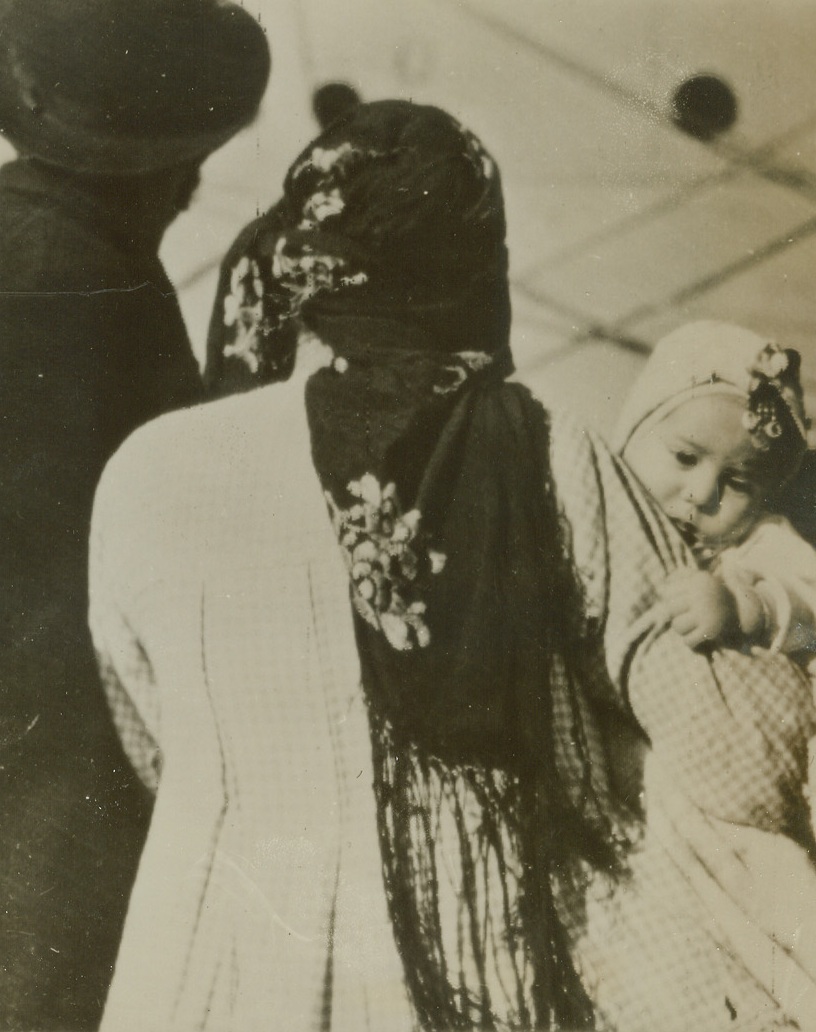
Heading for a New Homeland, 1/10/1944. A North African Port—A refugee family, left homeless by Hitler’s ruthless advance in Europe, wait to board a ship at a North African port, which will take them to Palestine. There they will be given a chance to establish themselves as agricultural settlers. Credit: OWI radiophoto from ACME.;
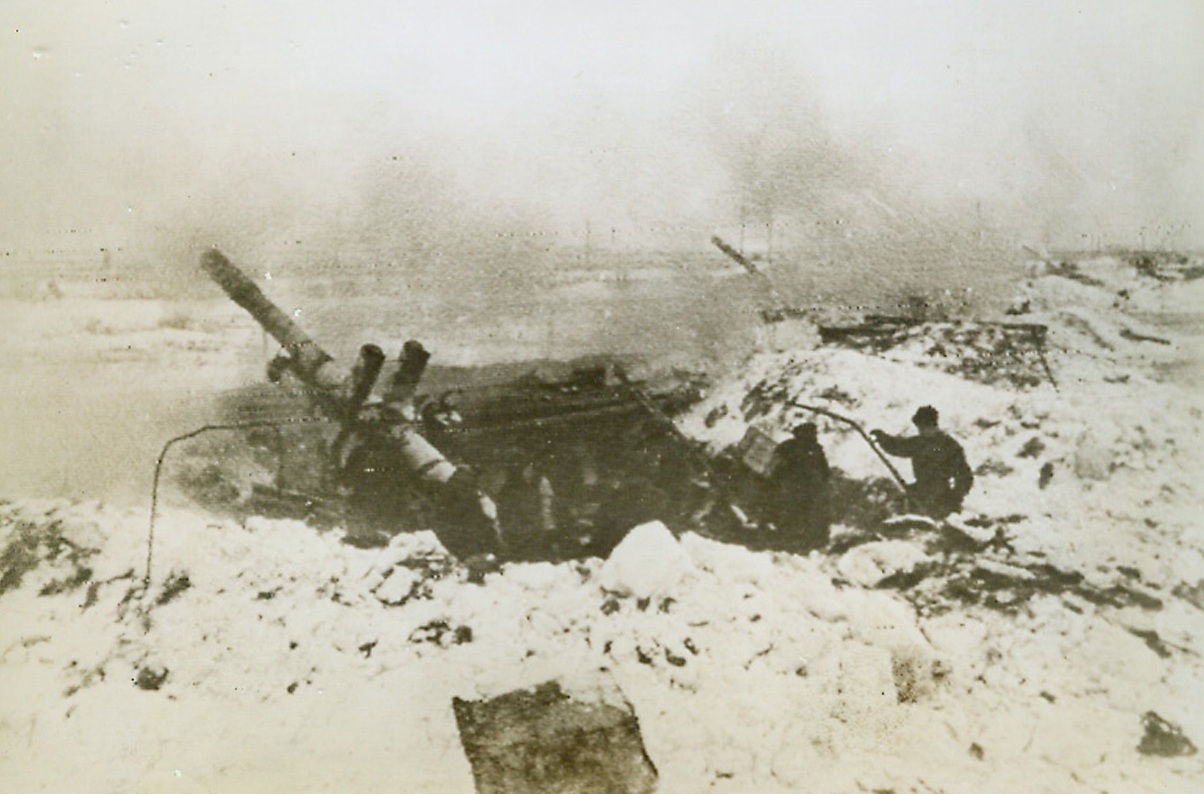
Soviets Rip Nazi Defenses at Leningrad, 1/22/1944. Russia—Heavy Russian guns blast Nazi fortifications near Leningrad, tearing holes in the mighty fortress built during the two-and-a-half year Nazi possession of the Soviet second city. The Russian caption says that “tens of thousands” of Germans have been killed in this area, where the capture of key rail junctions cuts off the escape of thousands more. Credit: ACME radiophoto.;
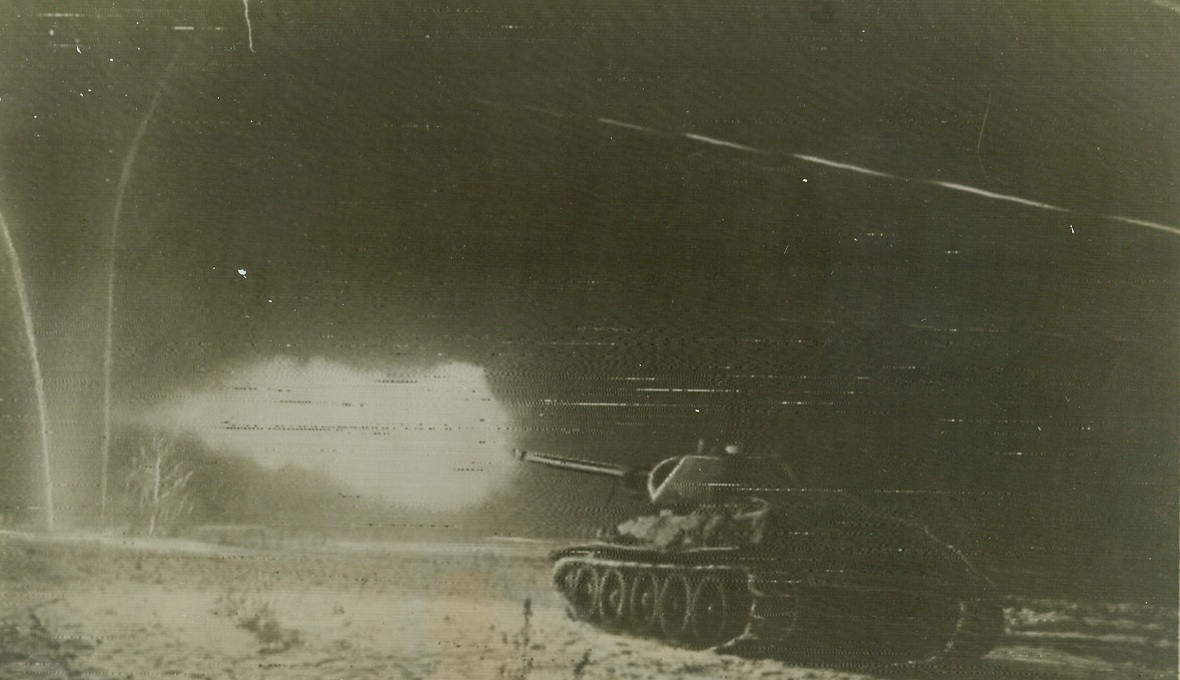
Red Tanks Battle Night and Day, 1/16/1944. Ukraine—A Soviet tank makes a spectacular picture as it fires on enemy positions at night on the first Ukranian front. Red Army troops have killed more than 100,000 Germans in 21 days of fighting on that front and in the past 24 hours have advanced five miles into German lines. Credit: ACME radiophoto;
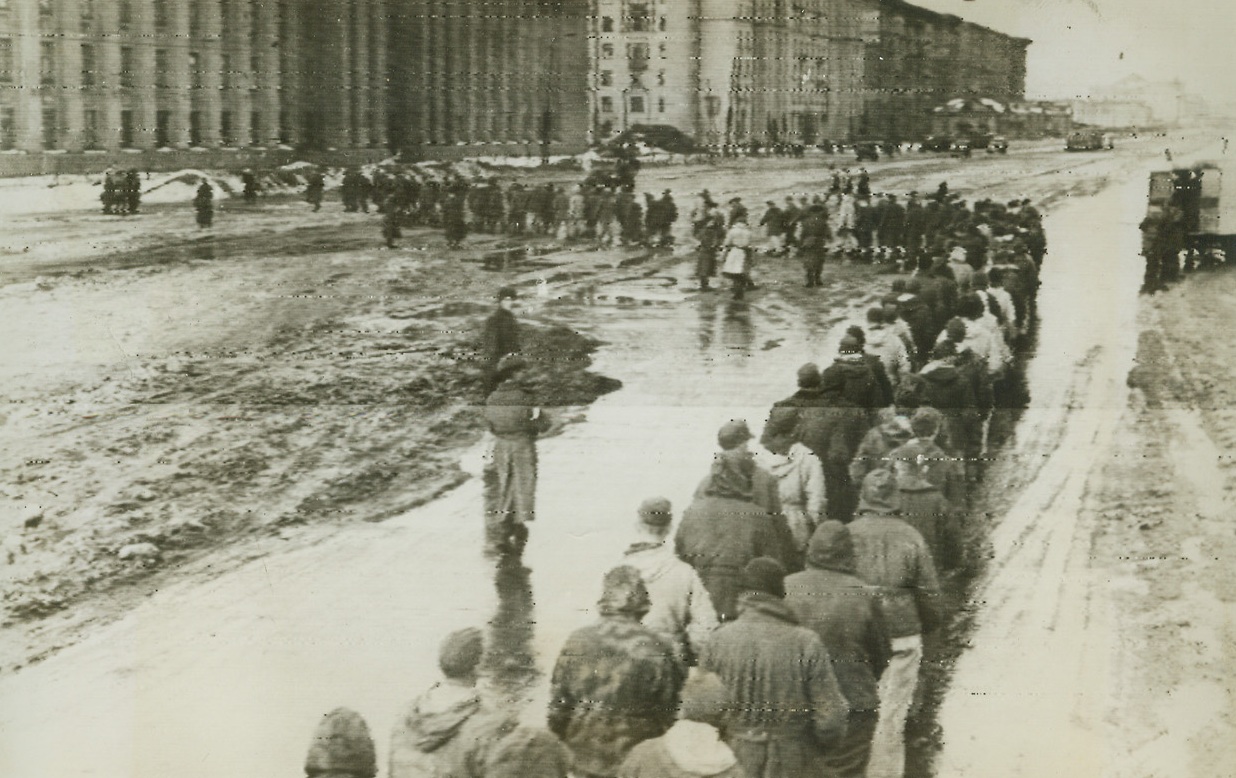
Defeat in the East, 1/30/1944. Leningrad—Symbolic of the defeat that the much-vaunted German Wehrmacht is suffering in the East is this long line of Nazi war prisoners in Leningrad who were taken when the lengthy siege on that city was lifted recently. What’s left of Germany’s battered armies are reported to be fleeing into Estonia through a 30-mile bottle-neck between the Gulf of Finland and Lake Peipus as Russian troops, advancing more than 10 miles a day, swept to the approaches of that Baltic state. Credit: ACME radiophoto;
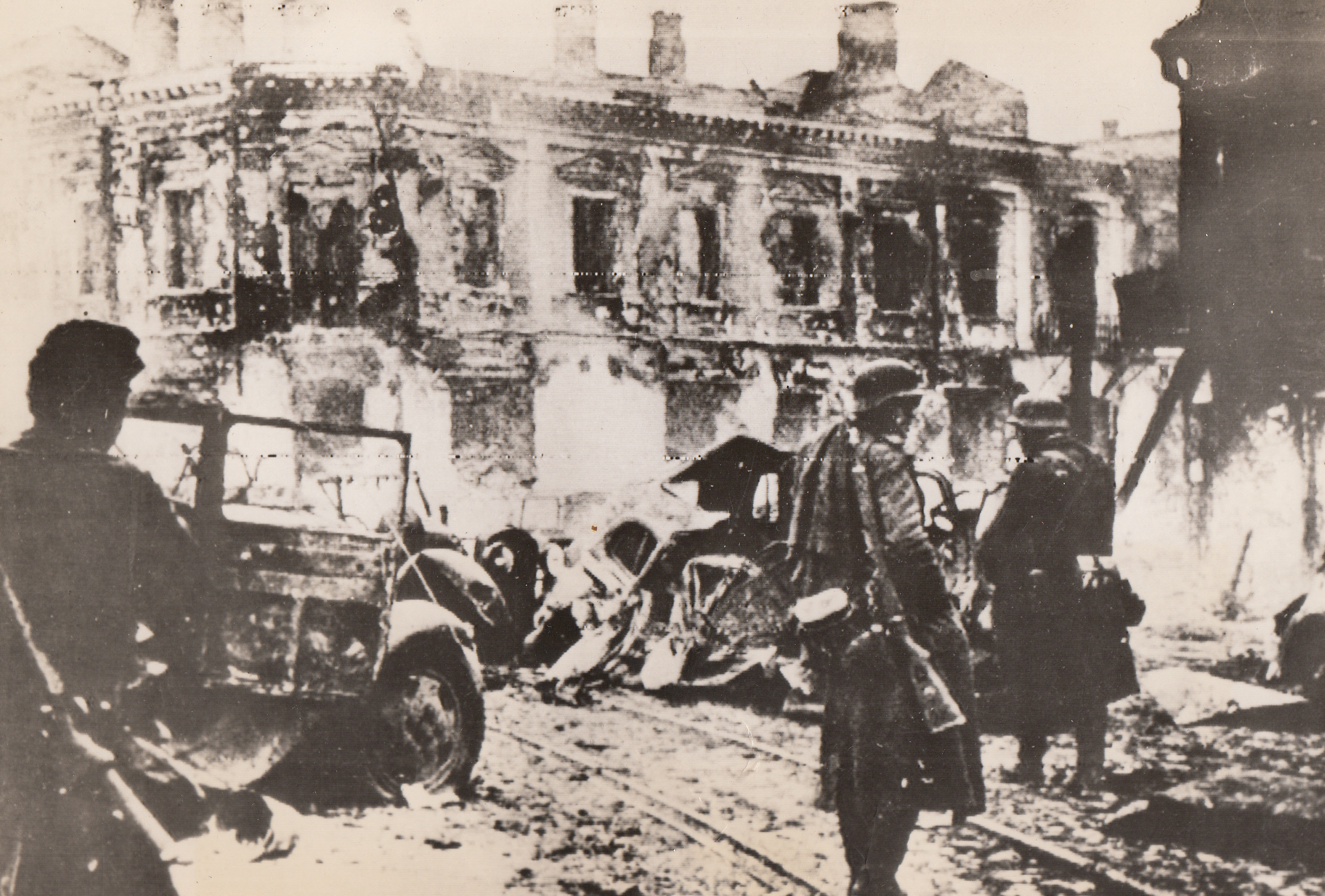
Brief Visit, 1/7/1944. Zhitower, U.S.S.R.—Launching their counter-offensive against the Kiev salient, the Germans tasted success briefly when they re-occupied battered Zhitomer. In this photo, received in London through a neutral source, Nazi infantrymen survey the city’s ruined streets.;
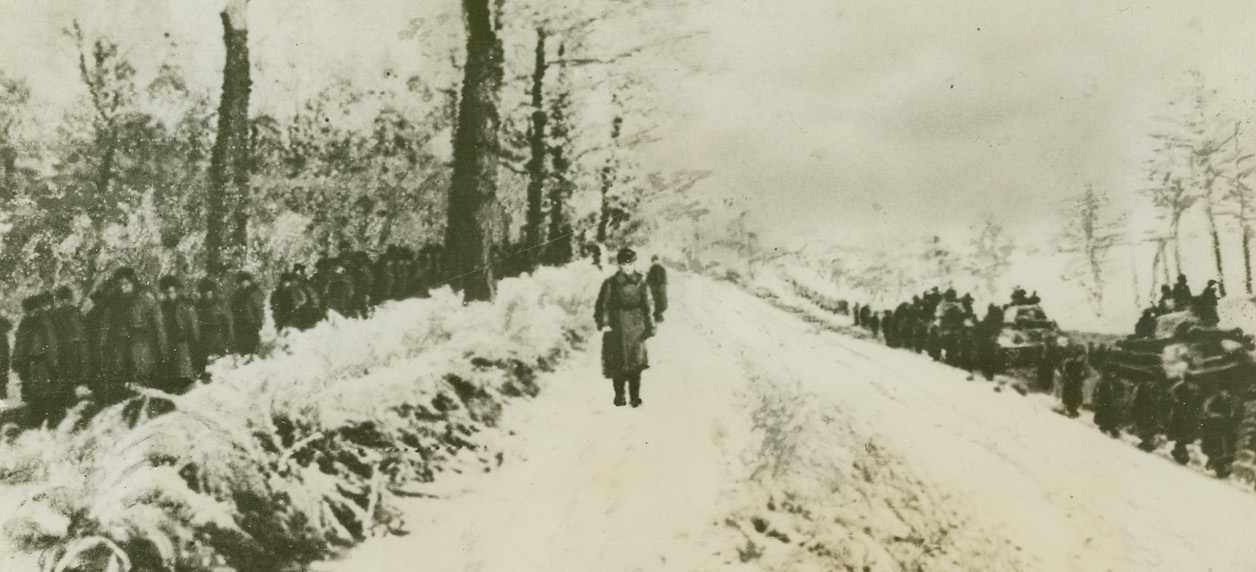
Long Cold Road to Revenge, 1/24/1944. Russia—As far as the eye can see, long columns of General Vatutin’s first Ukranian Army move westward on a frozen road on the Sarny battlefront in pre-war Poland. This is the first photo of the advance on an 80 mile front where desperately stiffened Nazi resistance is being broken. Credit: ACME.;
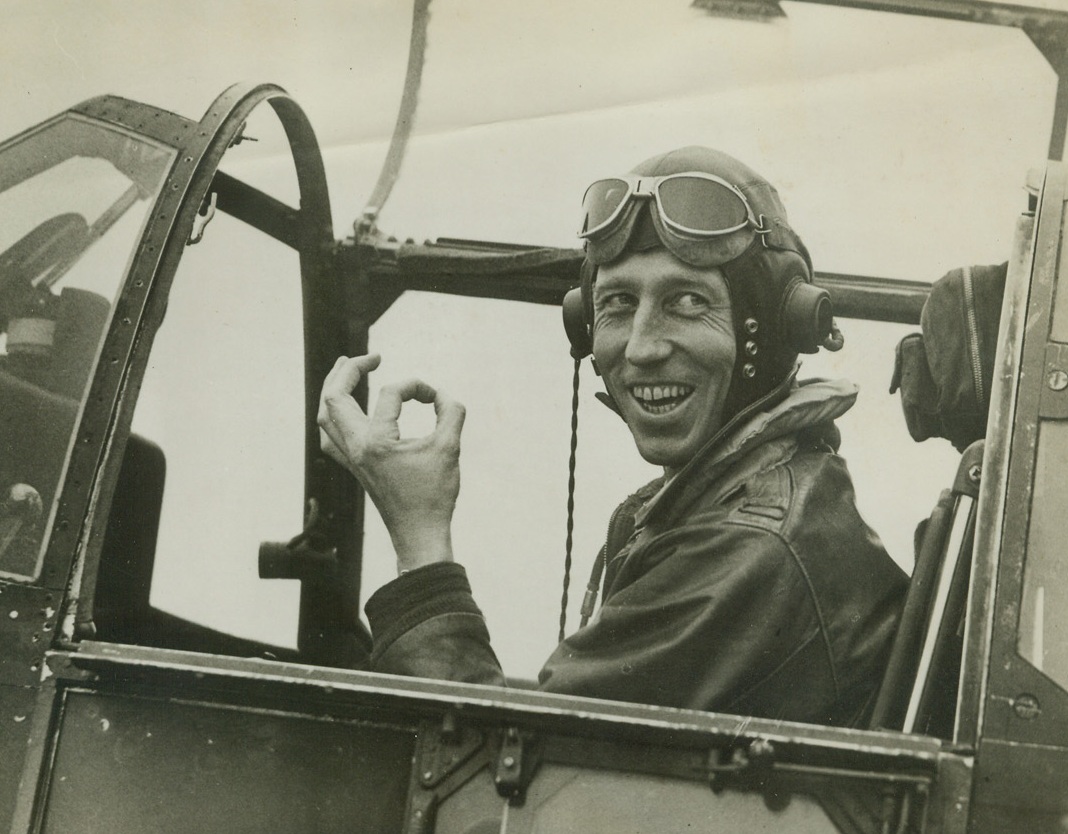
Maj. Howard Bags Another, 1/31/1944. England—Maj. James H. Howard, of St. Louis, Mo., who became one of the outstanding heroes of the air war over Europe, when single-handed he took on a pack of 30 Nazi fighters over Oserschleben, Germany, and shot down six of them. It was announced today that Maj. Howard was credited with another on the Reich. (Passed by censor). Credit: ACME.;
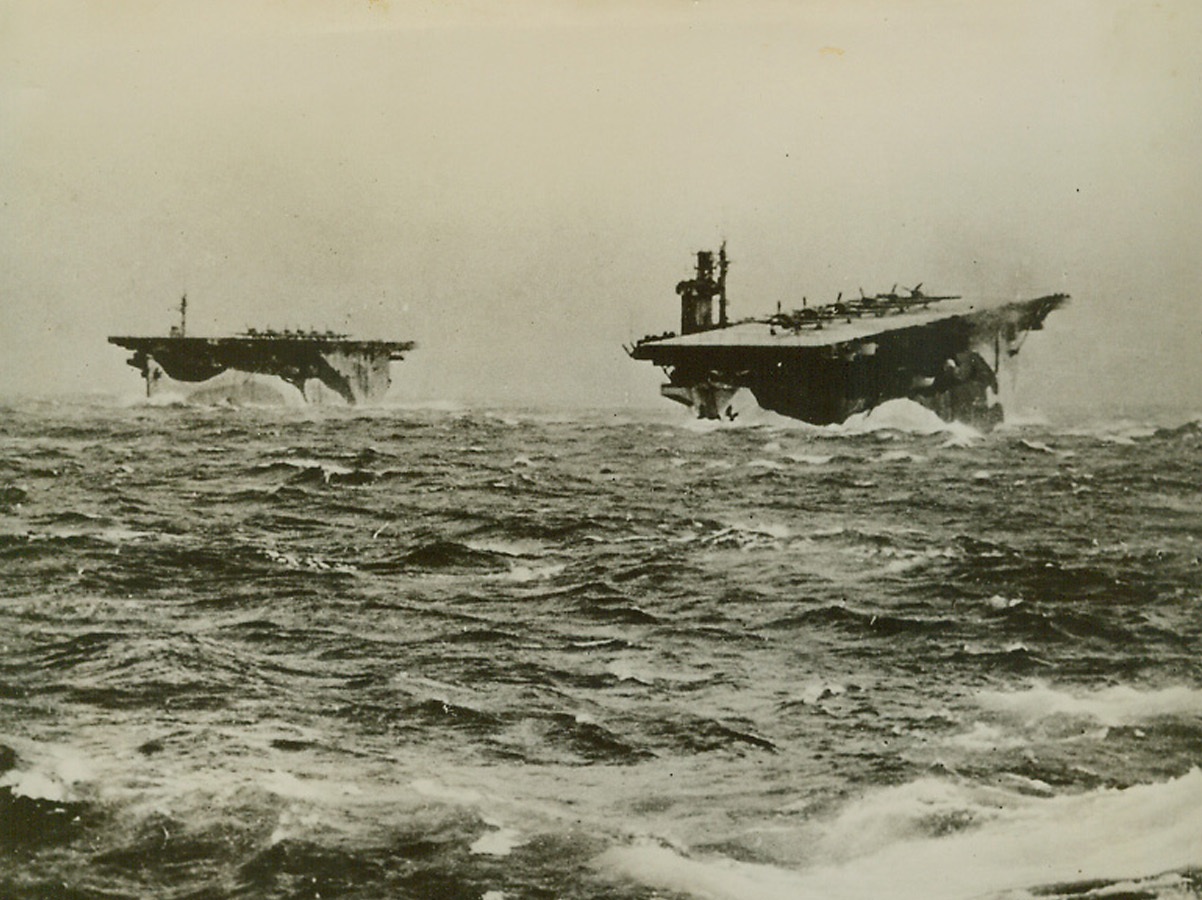
Escorts for Allied Convoy, 1/13/1944. At Sea—With fighter planes ranged on their pitching flight decks, the aircraft carriers Avenger and Biter toss in turbulent waters. Escorting an Allied convoy through dangerous waters, the British flattops press on through the stormy weather. Credit: ACME.;
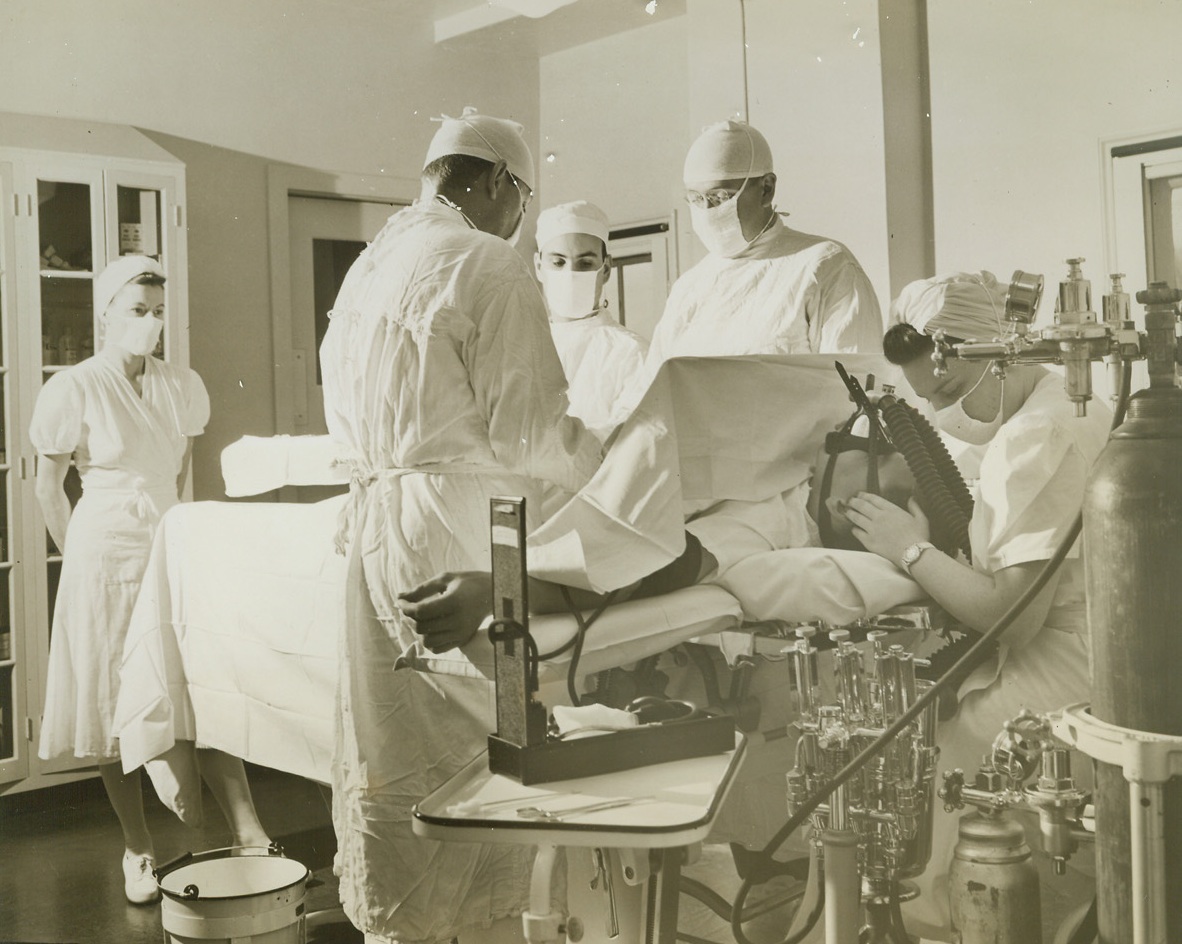
Skilled Surgeons and Soldiers in Palm Beach, 1/31/1944. Palm Beach. Fla.—A wounded soldier undergoes an operation at the Ream General Hospital, former breakers hotel which since last September has been an Army medical center specializing in neuro-psychiatric surgery and facial surgery. At present, about 800 men are being treated there, and the Army had considered wide expansion of accommodations until negotiations were started to return the hotel to its original owners, apparently at the instigation of local real estate and business interests. Credit: ACME.;
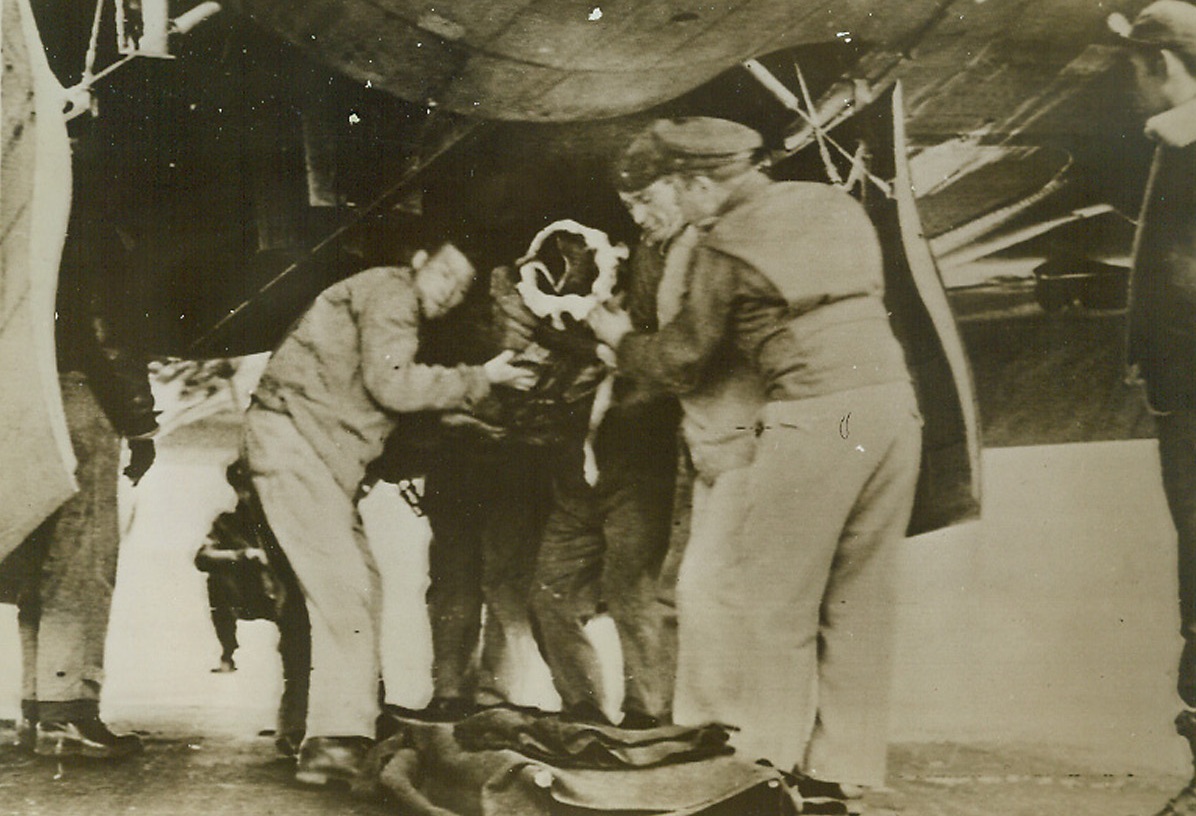
Wounded Waist Gunner Returns to Base, 1/31/1944. Washington, D.C.: Wounded when a 20mm shell exploded near his post, the waist gunner of a Flying Fortress is shown being removed through the bomb bay doors. The ship was on a mission to Frankfort in which some 800 bombers participated. Credit: US Army Signal Corps Radiotelephoto from ACME.;
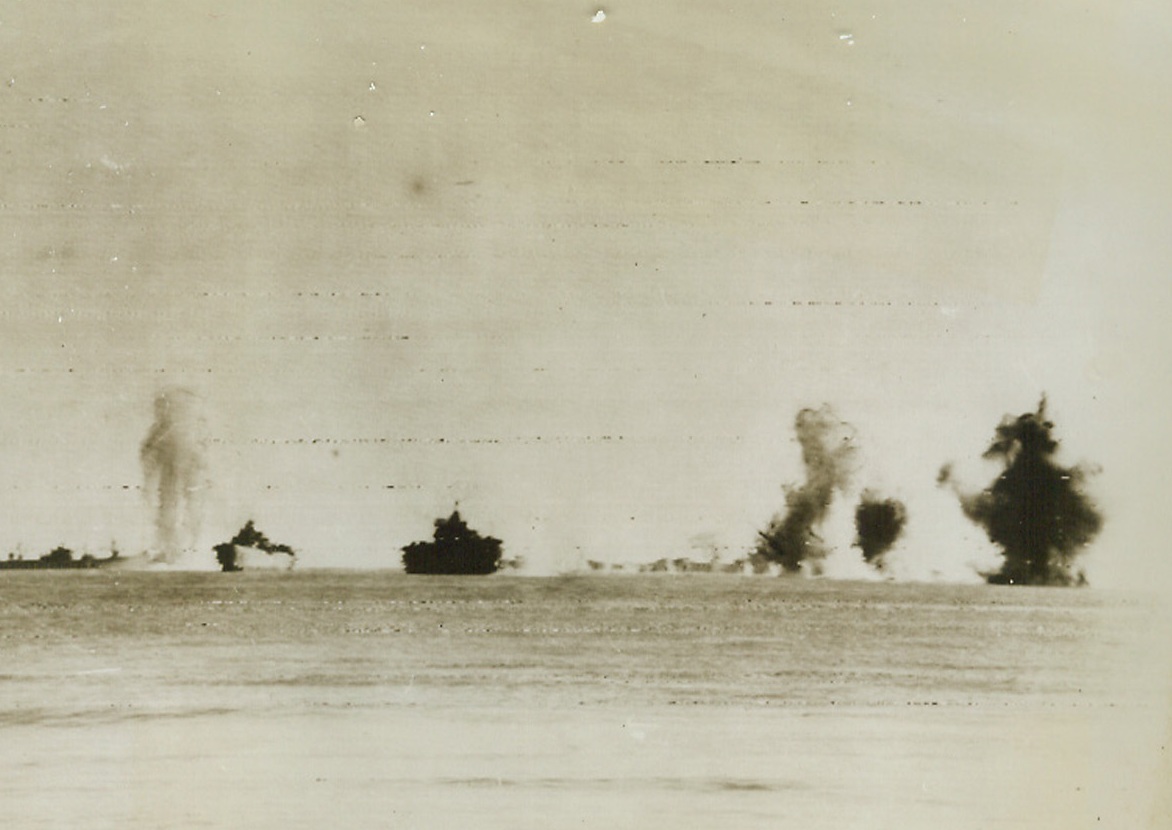
Close Shave, 1/31/1944. Washington, D.C.: German bombs miss their targets of Allied ships near Anzio Harbor, Italy. Credit: ACME photo by Bert Brandt for “AR Picture Pool via Army radiotelephoto.;
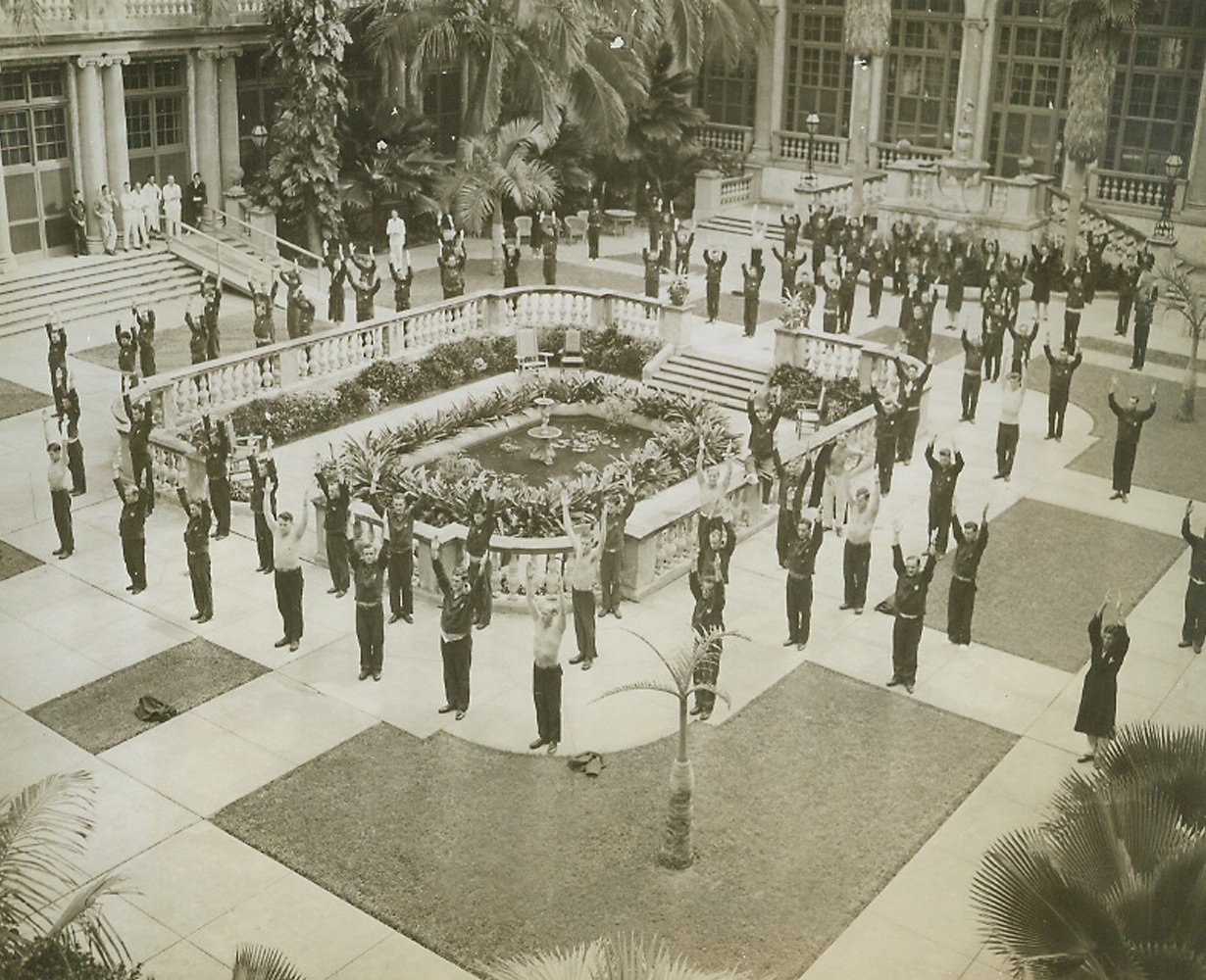
Getting Back Strength Under Florida Sun, 1/3/1944. Palm Beach, Fla—A bunch of husky, or near-husky soldiers doing their calisthenics is a strange sight in the patio of the exclusive Breakers Hotel, in Palm Beach. Now the Ream General Hospital, the former luxurious winter home of wealthy vacationists houses soldiers just returning from war theaters and those injured in U.S. camps. The wounded fighters may have to find a new place to relax and grow healthy if the onetime hotel is returned to its owners. Credit: ACME.;
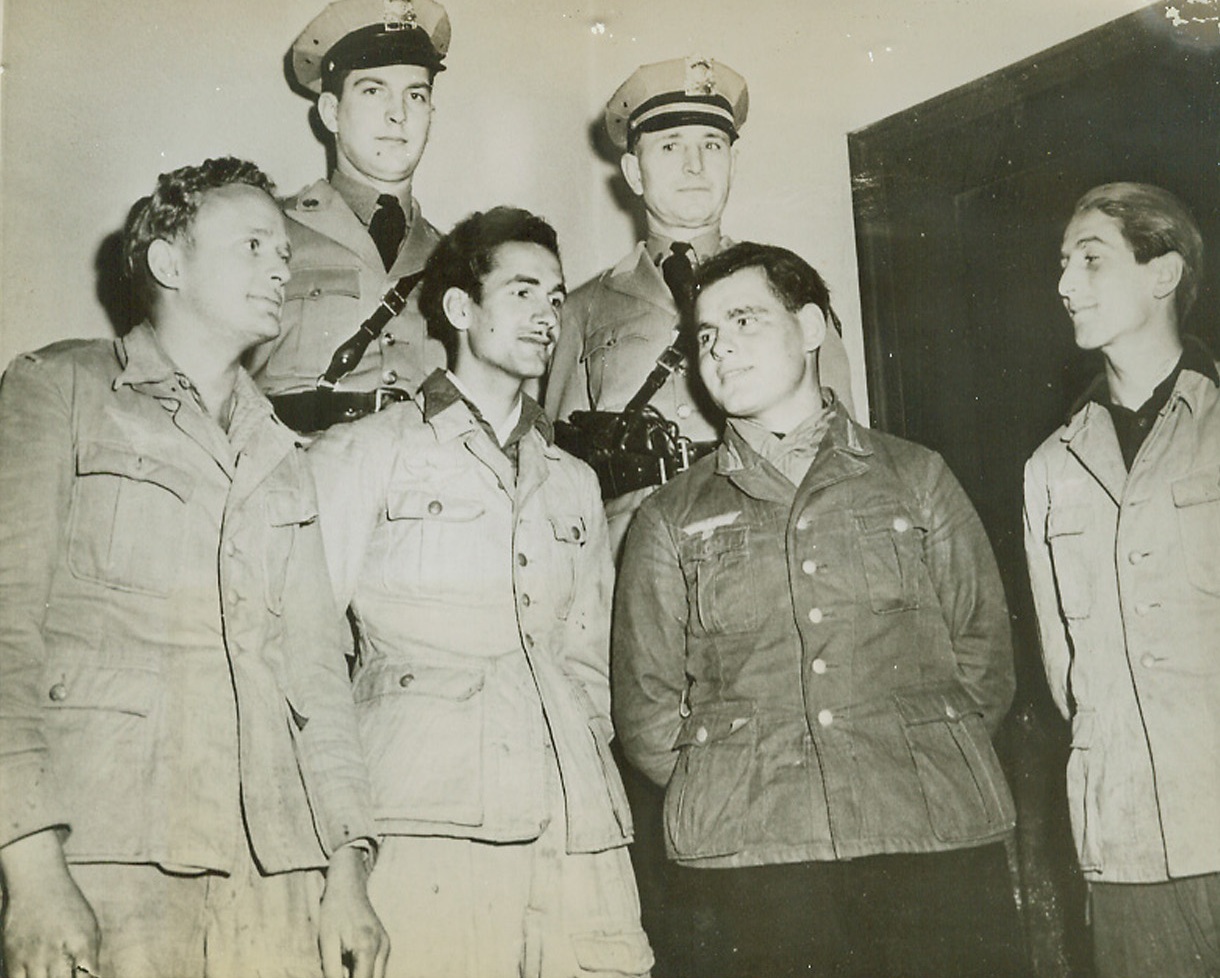
Nazis Recaptured After Escape, 1/9/1944. Wichita, Kans.—Four Nazi war prisoners caught near Wichita, Kansas, seem unruffled after being taken in the biggest manhunt of the region’s history by state highway patrolmen Capt. Paul Drescher (near right) and Galen Bennett (left). The prisoners (left to right) Hans Hass, 22; Alfons Putliewitz, 19; Enno Heyer, 20; and Karl Schroader, 25, escaped from a train near Elndale, Kansas. Credit: ACME.;
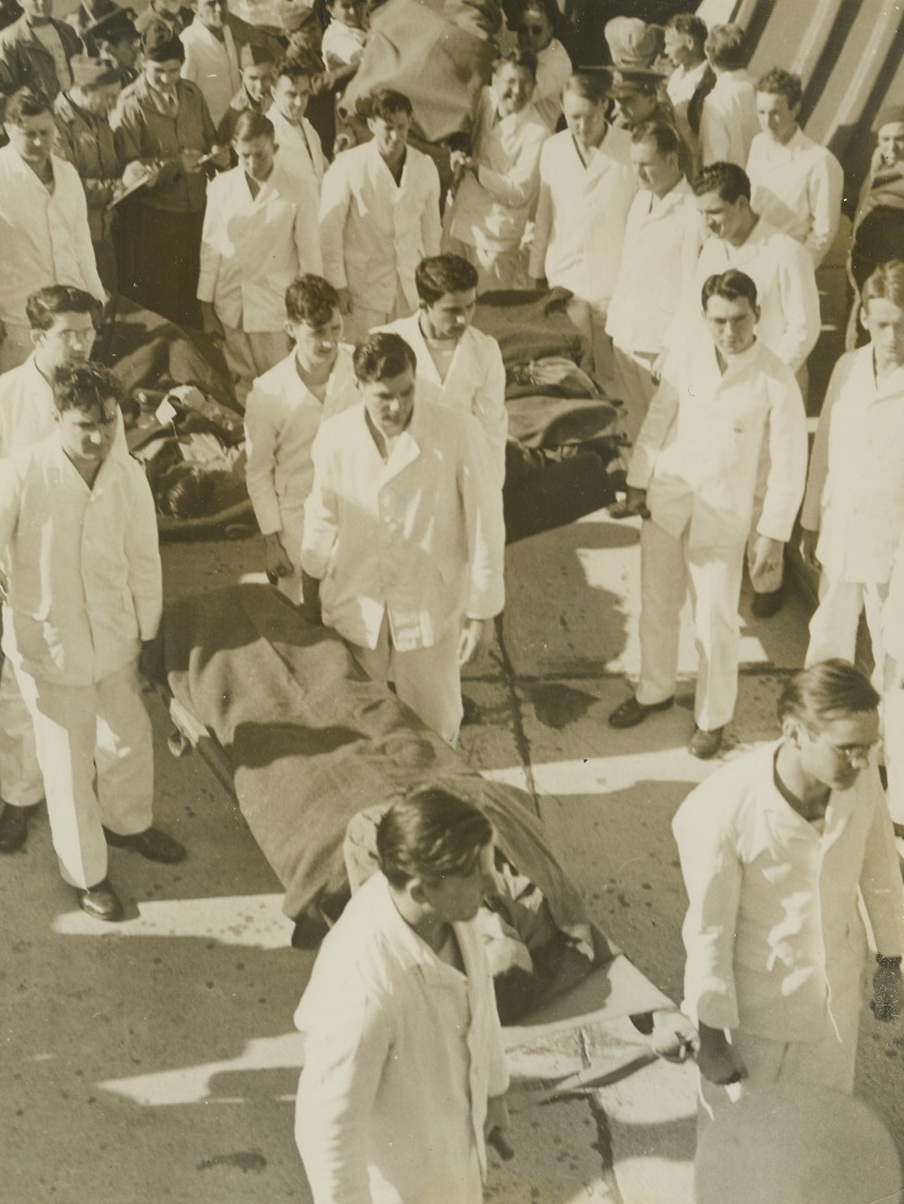
Patients Moved in First Massed Flight, 1/13/1944. Temple, Texas—Plenty of enlisted men were on hand as stretcher bearers and 16 ambulances were used to transfer patients from airplanes to McCloskey General Hospital in Temple, after the arrival of the first convoy of patients to be sent by air in continental United States. The patients, from Stark General Hospital, Charleston, S.C., were flown to Temple in planes of the Air Transport Command.Credit: U.S. Signal Corps photo from ACME.;
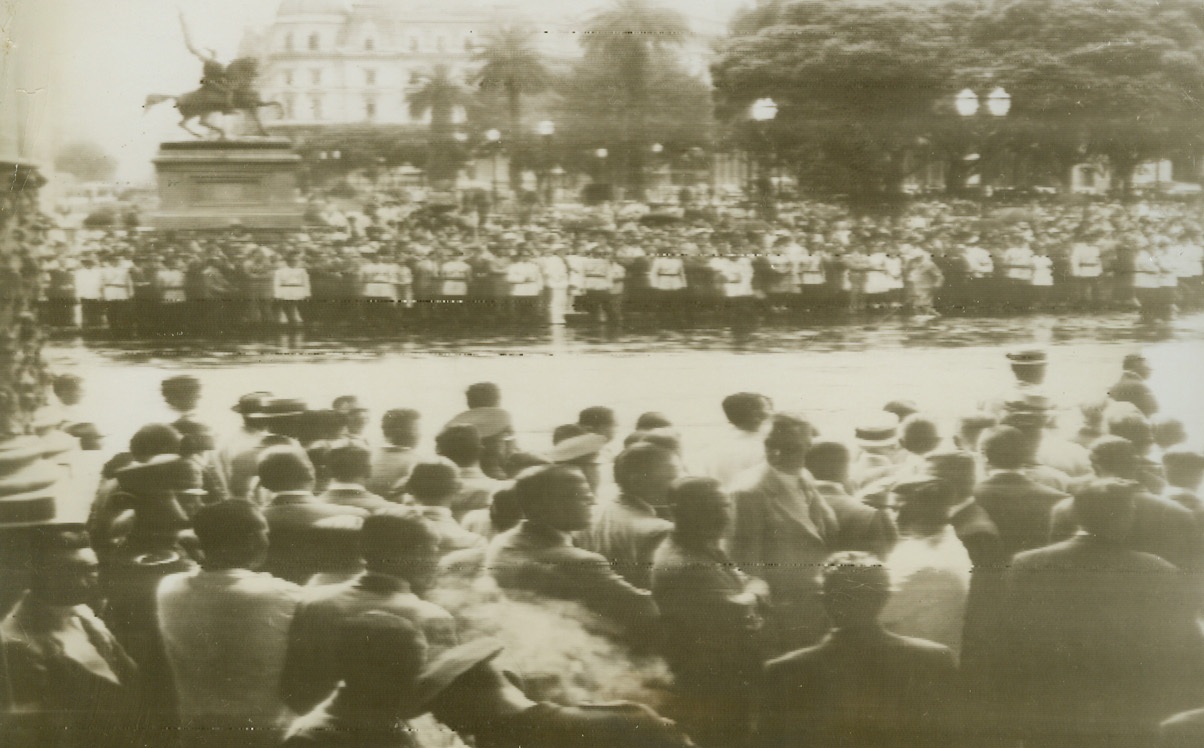
Thousands Hear Ramirez Speech, 1/26/1944. Buenos Aires, Argentina—In spite of the pouring rain, thousands gather in the Plaza de Mayo in front of the Casa Rosada in Buenos Aires to hear President Ramirez announce that Argentina had several relations with the Axis. The address was broadcast over a nation-wide radio hook-up. Photo radioed to New York from Buenos Aires today (January 26th).Credit: ACME radiophoto.;
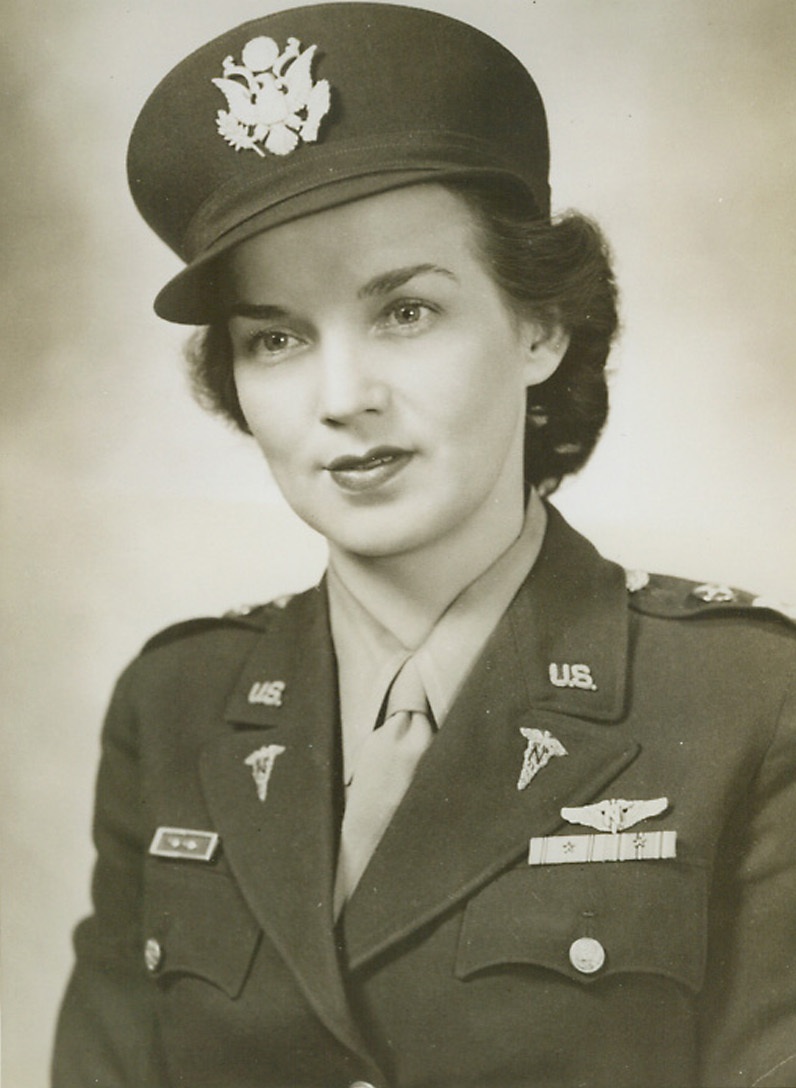
Flight Nurse Wears Her New Gold Wings, 1/14/1944. Captain Juanita Redmond, of the Army Nurse Corps, proudly wears the gold wings of a flight nurse above her National Defense and Pacific-Asiatic Theatre Ribbons, both of which bear the stars of combat areas. The wings have just been adopted as the insignia of the Army’s flying nurses. Captain Redmond, who hails from Swansea, S.C., also wears the Presidential Unit Citation Ribbon, with the stars representing Bataan and Corregidor. She is now attached to the Office of the Air Surgeon in Washington, D.C.Credit: U.S. Army Air Forces photo from ACME;
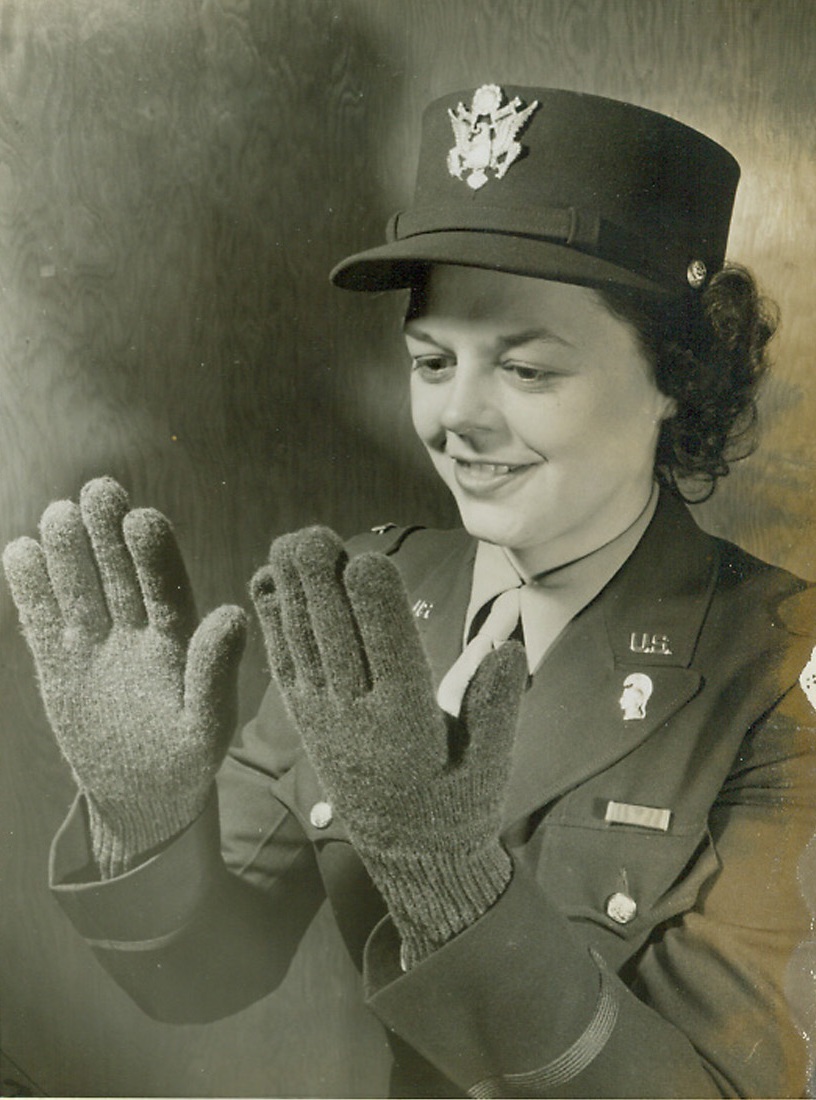
Left or Right Handed?, 1/12/1944. Chicago—You can’t tell the left from the right in these new Army issue gloves because they’re “ambidextrous,” says the Army quartermaster depot in Chicago. Wac Lt. Elfrieda Heideman wears the gloves in which the thumbs are knitted in a straight line with the other digits so that the glove fits either hand. The ambidexterity lessens replacements, too, says the Army, for only one glove has to be replaced instead of a pair, should a glove wear out or be lost.Credit: ACME.;
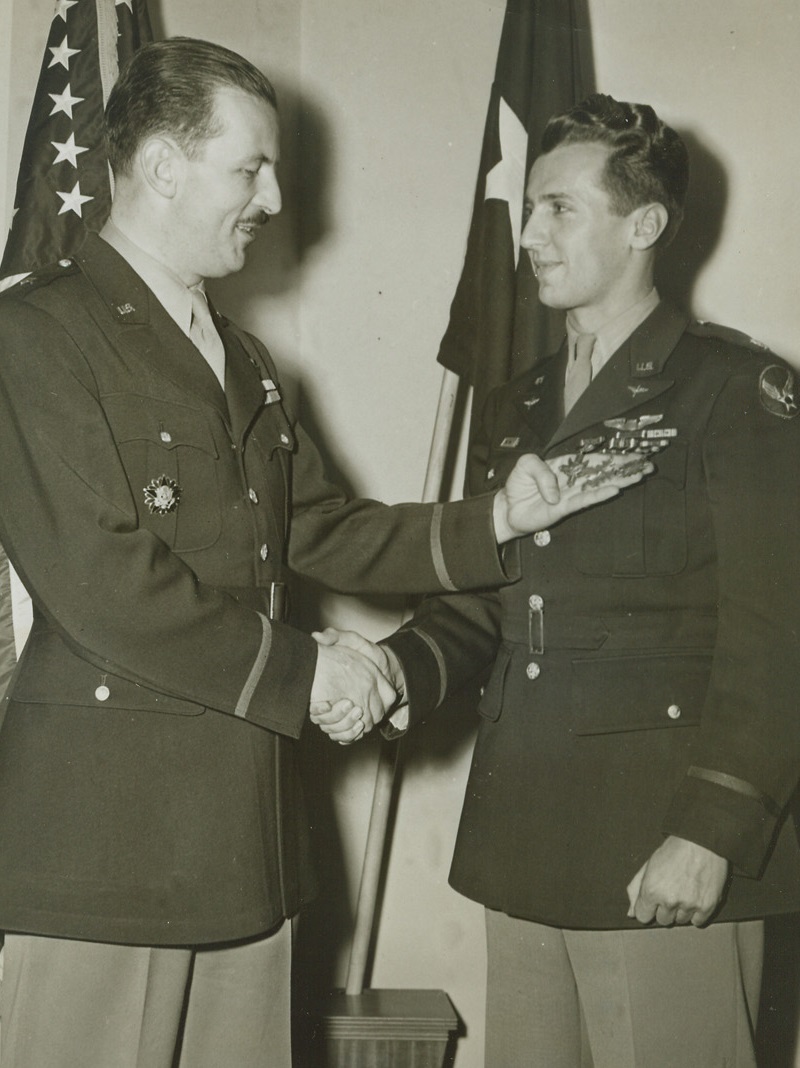
AWARDED THREE MEDALS FOR 100-DAY TREK, 1/18/1944. WASHINGTON, D.C.—A 100-day trek through an enemy-held jungle, after he was shot down by a Jap plane over Rabaul, brought three decorations for Major Arthur L. Post (left) of Milwaukee, Wisc. Bringing back valuable information when he finally reached Yank headquarters, Major Post was cited by Lt. Gen. Kenney and awarded the Distinguished Service Cross, the Flying Cross, and the Air Medal. Here, Brig. Gen. L.S. Kuter, acting Chief of the Air Staff, congratulates the flying hero. Credit Line (ACME);
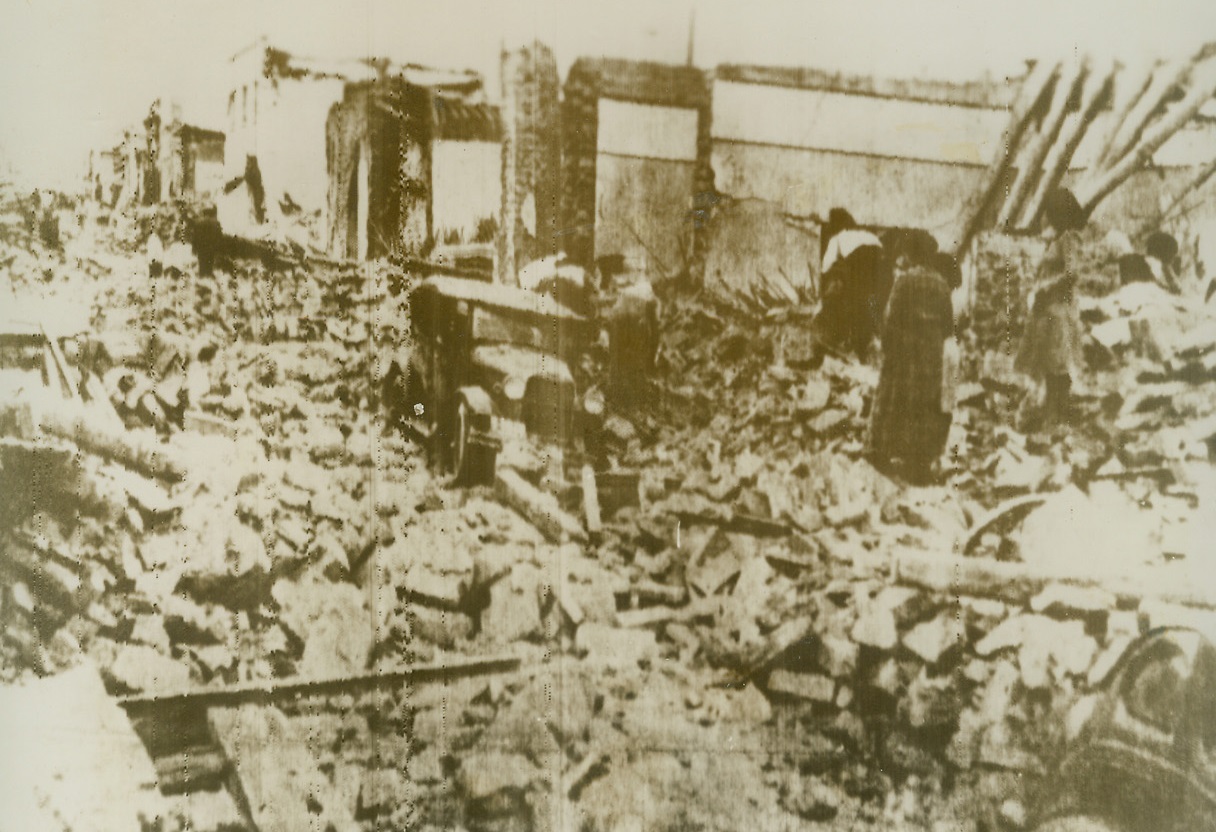
In Wake of Argentine Earthquake, 1/18/1944. Argentina—A group of survivors claw amid the ruins of the once-beautiful city of San Juan, Argentina, seeking loved ones beneath the huge piles of debris left by Saturday’s earthquake. Note cars that evidently had been parked on the street which is completely undistinguishable from other areas. In Buenos Aires, it was estimated that 10,000 were injured and 15,000 to 20,000 missing in the city and its environs. Not more than 20 houses are left standing in the ancient capital. Credit: ACME radiophoto.;
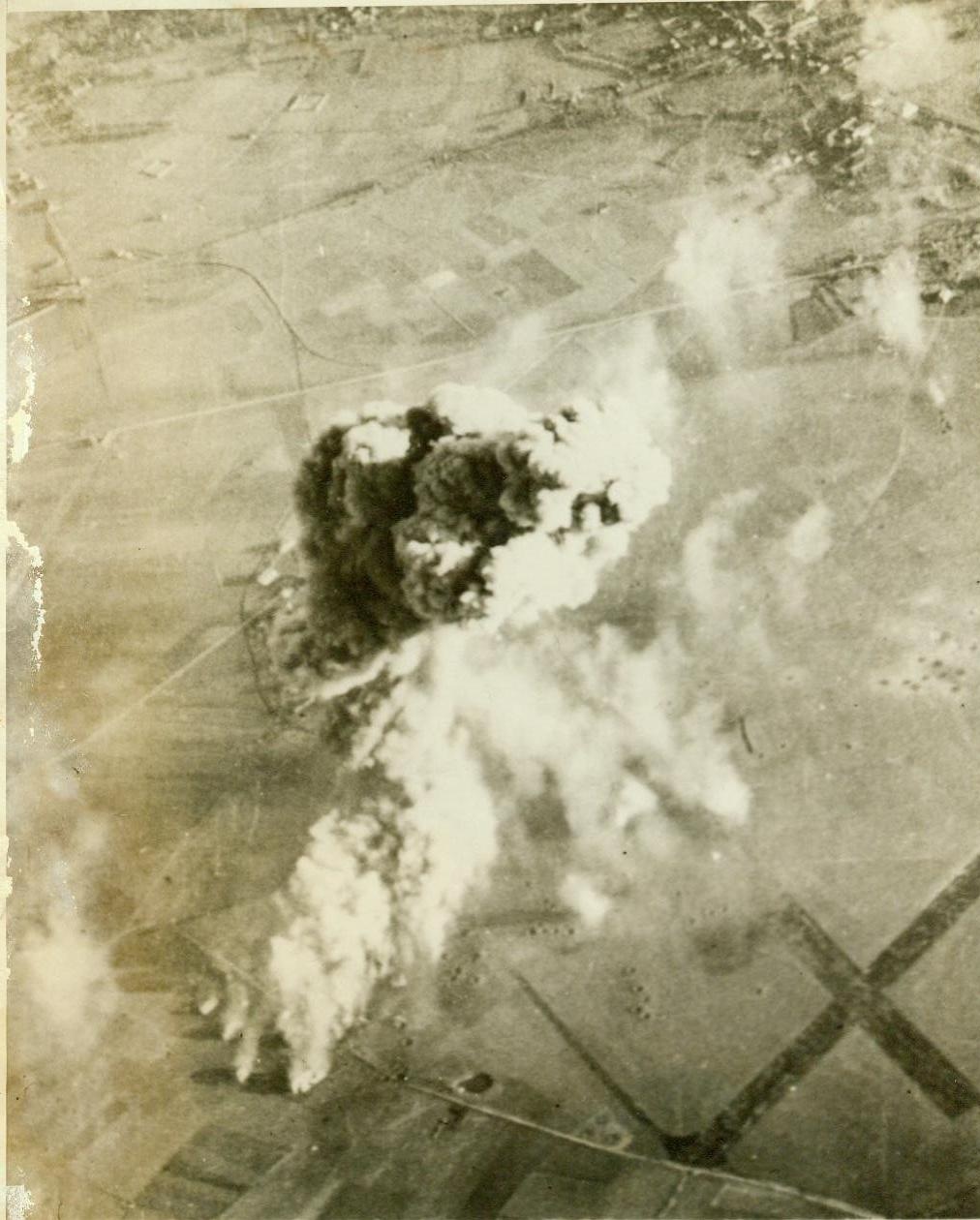
Nazi fuel goes up in smoke, 1/3/1944. A column of smoke, 4,000 feet high, rises from a German fuel storage dumb on the airfield at Chievres, France, after Martin B-26 Marauder medium bombers of the U.S. Army 8th Air Force had blasted it last Nov. 29. The concussion from exploding fuel was so great that the attacking bombers were bounced about in the air. The “X” (lower right), is the cross formed by the airfield’s runways. CREDIT LINE (U.S. Army official photo from ACME) 1-13-44;
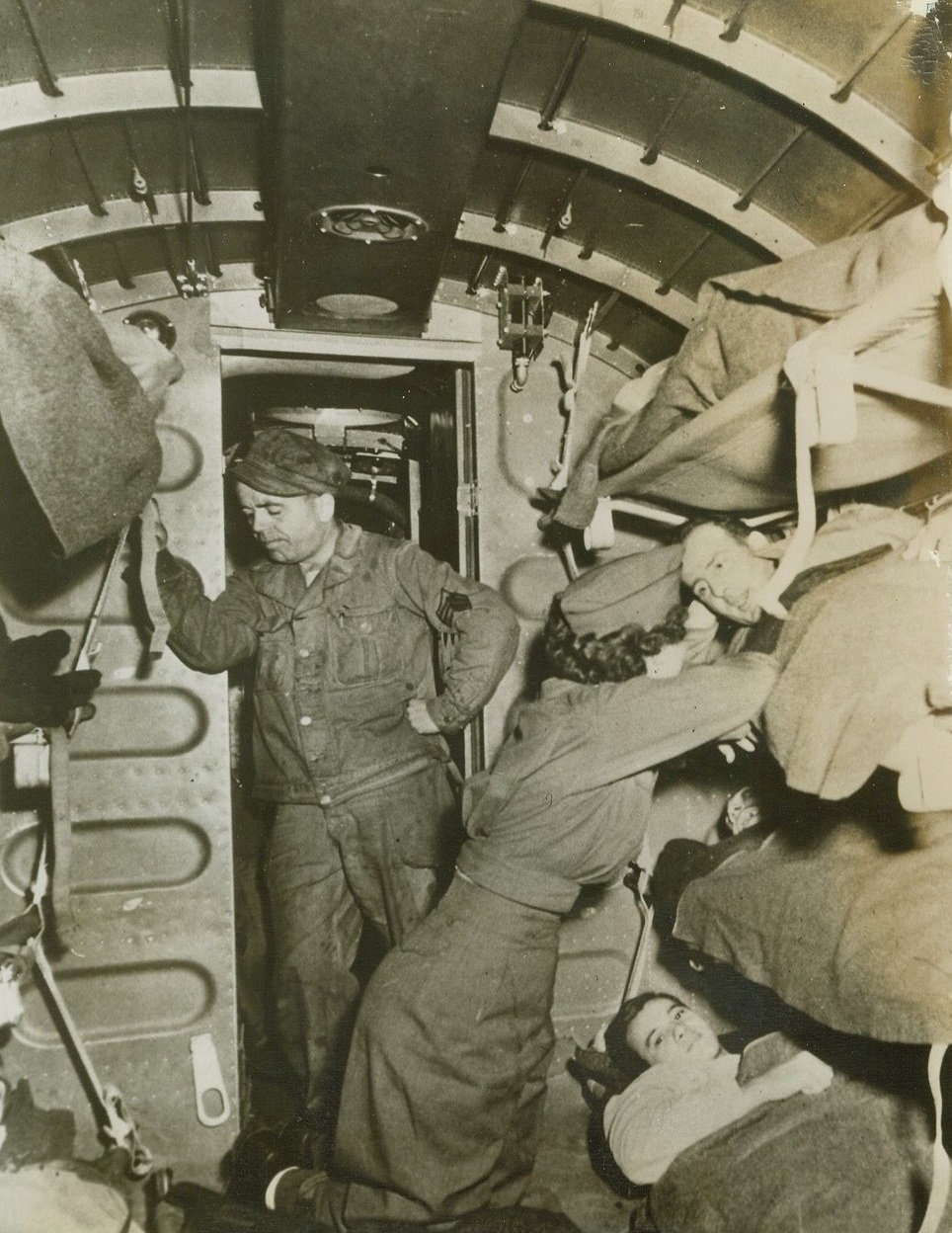
Wounded Flown to U.S. Hospitals, 1/19/1944. Flight Nurse Second Lieut. Kathleen Davis, First Troop Carrier Command, School of Air Evacuation, sees that patients are comfortable in plane during the first mass air evacuation of wounded in the U.S. Flight was from an Eastern port to inland Army general hospitals. The sergeant (standing) is a surgical technician. Credit: Army photo from ACME.;
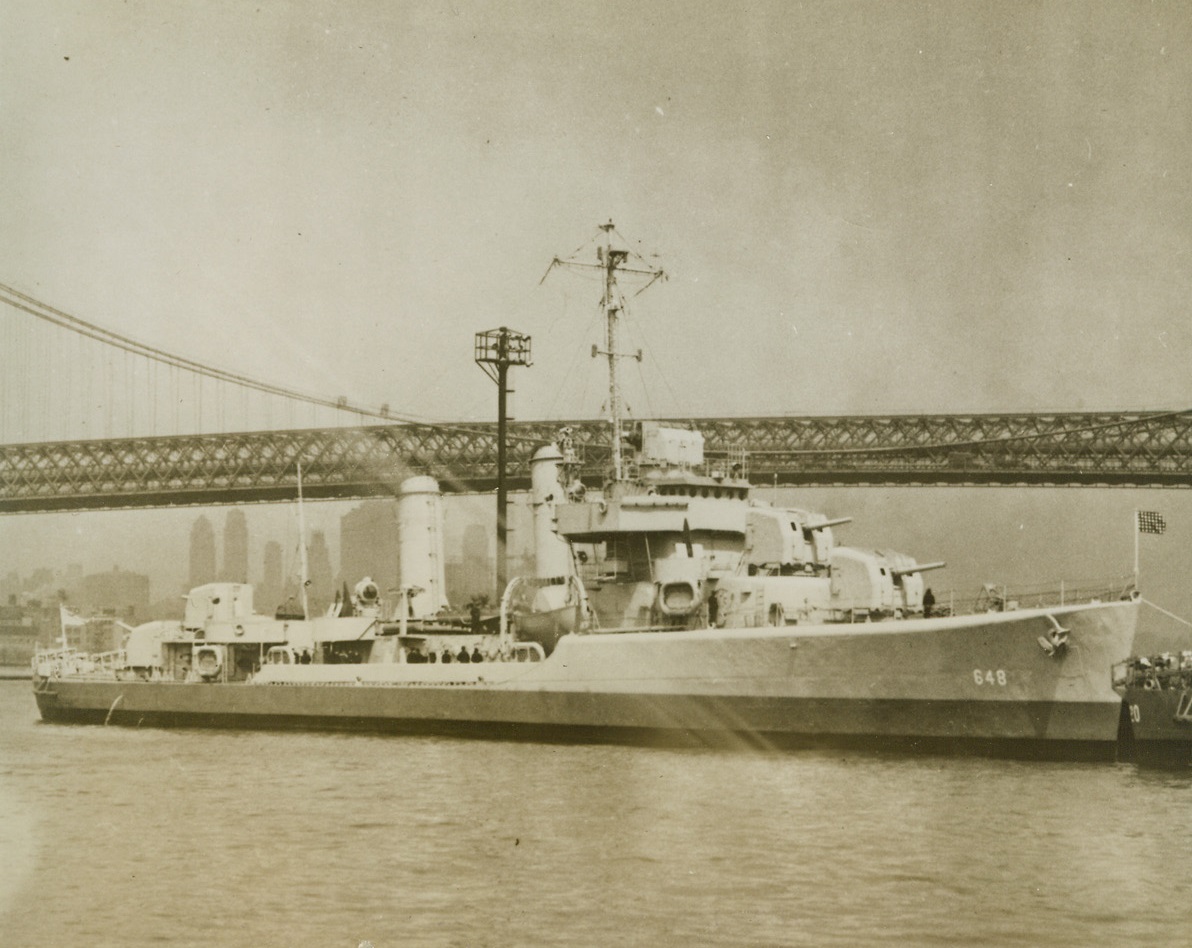
Navy Identifies Sunken Destroyer, 1/4/1944. Washington, D.C.—The Destroyer which exploded and sank at the entrance to New York Harbor yesterday (January 3rd), with an undetermined number of casualties, was identified by the Navy department tonight as the new, 1700-ton U.S.S. Turner. Commissioned only last April 15th, she was the second destroyer of that name, each having been named for a hero of the 1813 battle of Lake Erie. It is feared that at least 50 lives were lost in the ship’s mysterious explosion. Credit: illegible.;
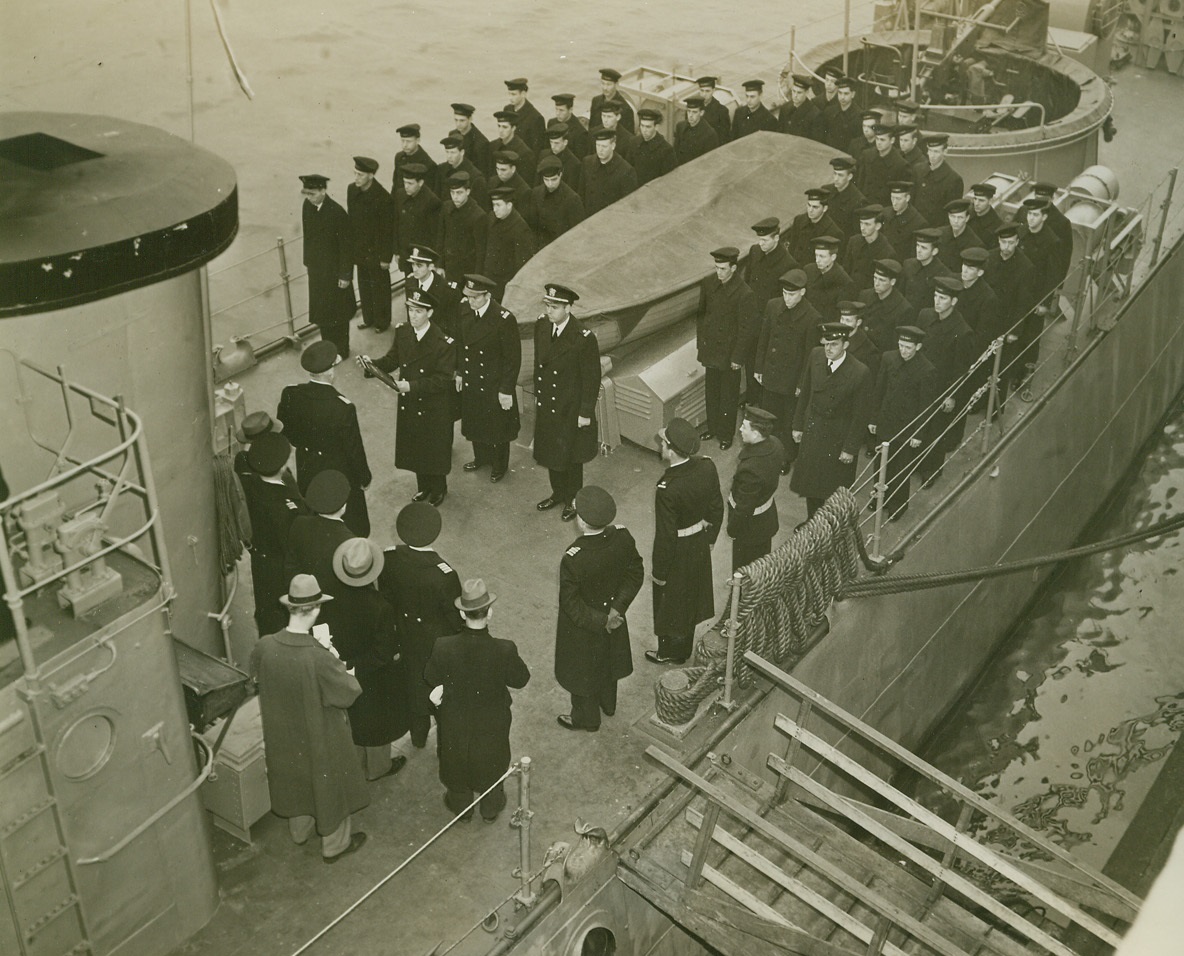
Honoring Sub Chaser, 1/26/1944. New York City—A memorial plaque honoring the officers and men who lost their lives when the submarine chaser, USS SC-209, went down during World War I, was presented to the USS PC-565 today (January 26th). The vessel honored was the first of the 110 foot patrol chaser class to distinguish itself by outstanding action against the enemy in World War II. Here is a general view of the ceremonies as Lt. Charles P. Sheppard, captain of the PC-565, accepts the plaque, which was offered to the Navy by H. Liggett Gray, a member of the SC-209 crew who was not aboard when the vessel went down. Credit: ACME.;
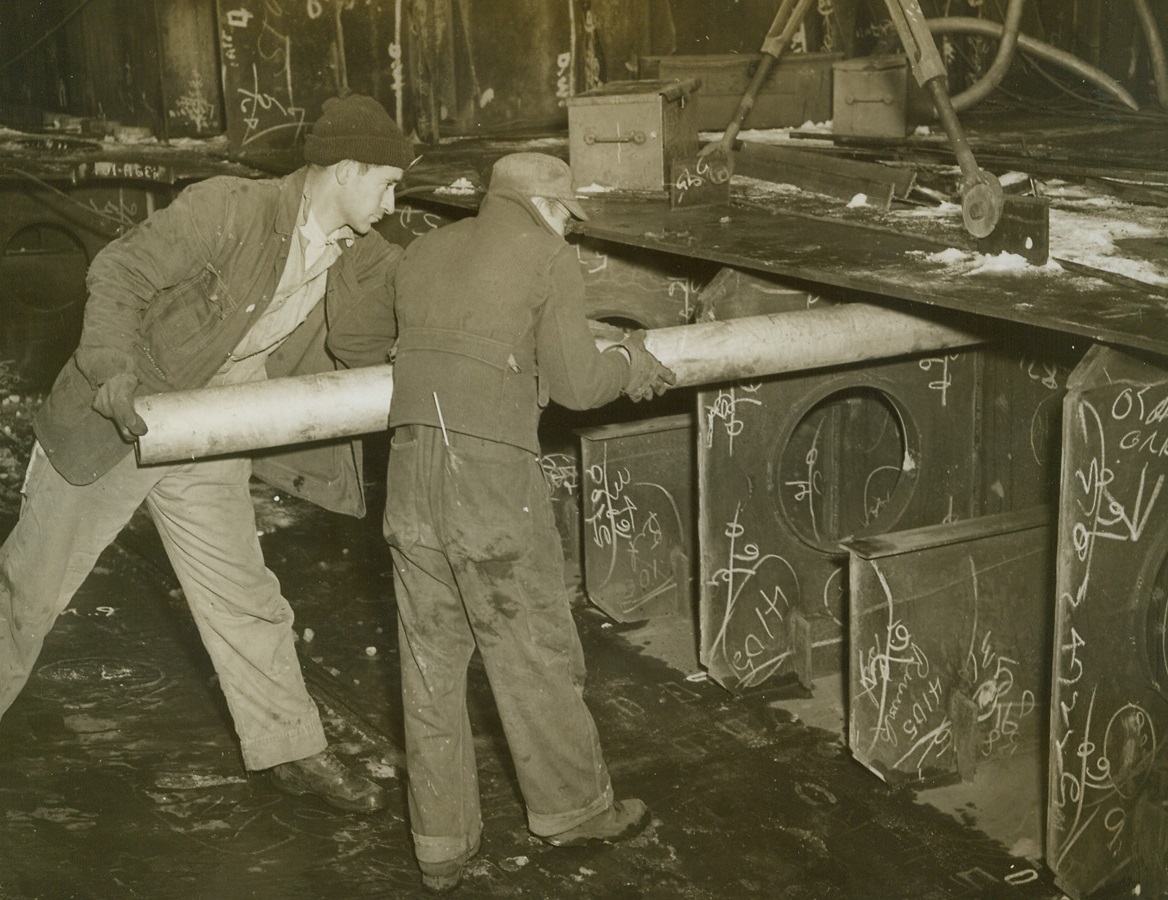
Flattop Under Construction, 1/21/1944. Newport News, VA. - Plumber H. H. McCracken (left) and his assistant, T. C. Ray, install an oil pipe peep in the bowels of one of the Navy’s new 45,000-ton Aircraft Carriers. This is the first photo ever released showing any work on the Navy’s giant flattops. Credit: Official U.S. Navy photo from ACME;
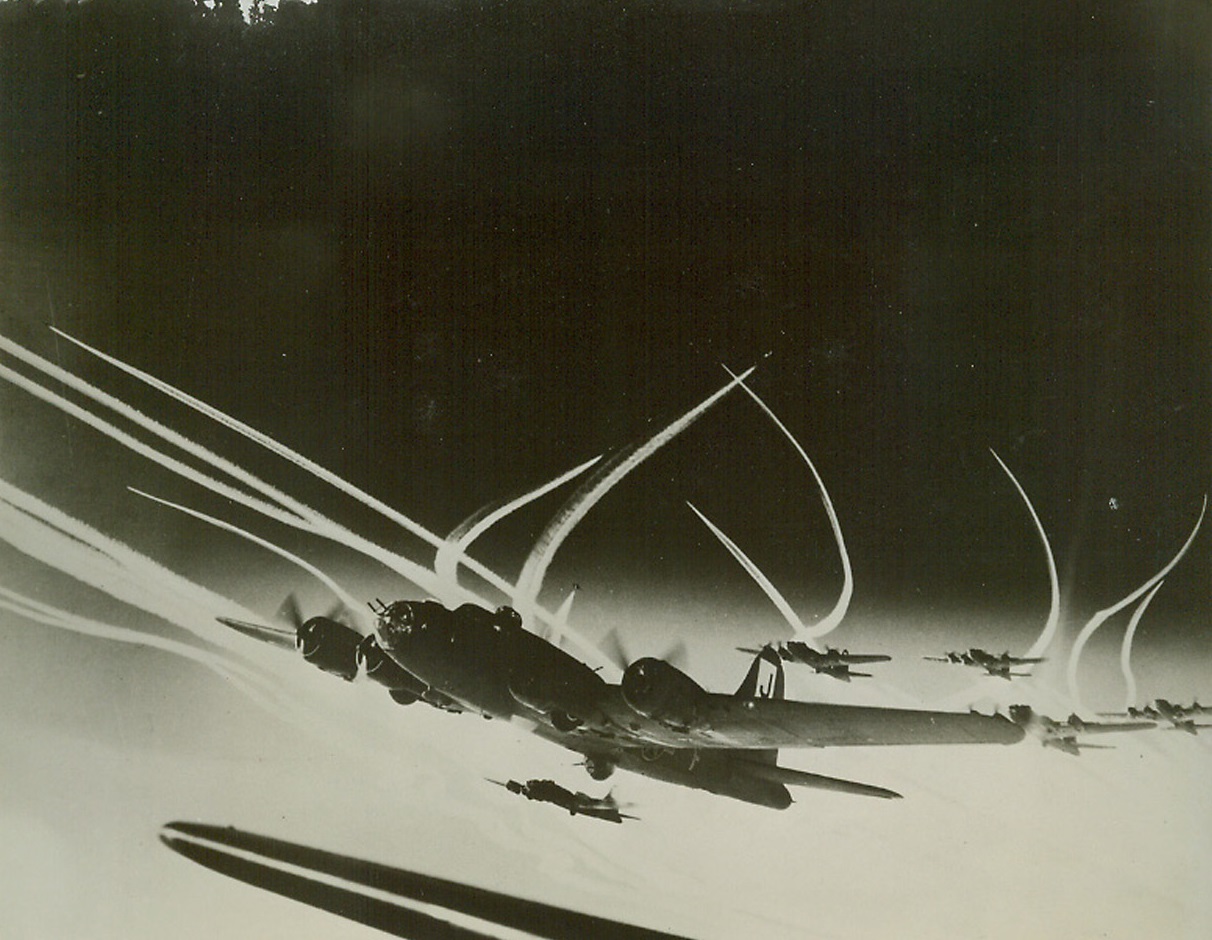
Deadly Sky Writers, 1/20/1944. Leaving white vapor trails high in the sub-stratosphere, these planes of the U.S. Army 8th Air Force head for another devastating raid on Hitler’s “Fortress Europa.” In the foreground, are Flying Fortresses, while in the background, fighters accompanying the bombers on the mission leave curved trails in the sky. Credit: U.S. Army Air Forces photo from ACME;
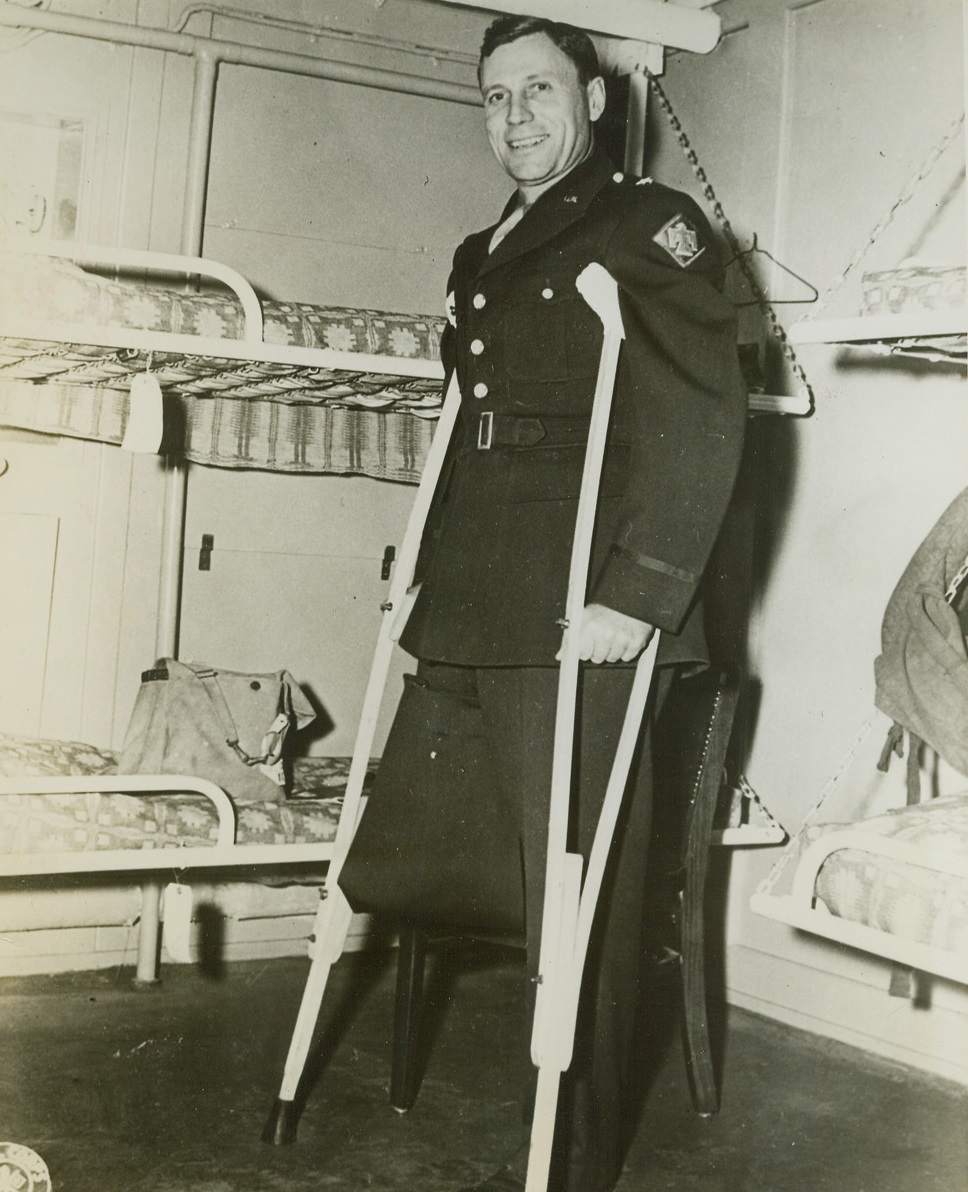
Wounded General Returns, 1/20/1944. An East Coast Port - Brig. Gen. C. M. Ankcorn, of Palouse, Wash., who lost his right leg in front line fighting in Italy while he was still a Colonel commanding a regiment of the 45th Infantry Division, is shown on his return to the United States recently. Gen. Ankcorn lost his leg when a jeep in which he was riding struck a mine in Italy. He has been in the Army since his graduation from Ohio State University in 1917. Credit: U.S. Army photo from ACME;
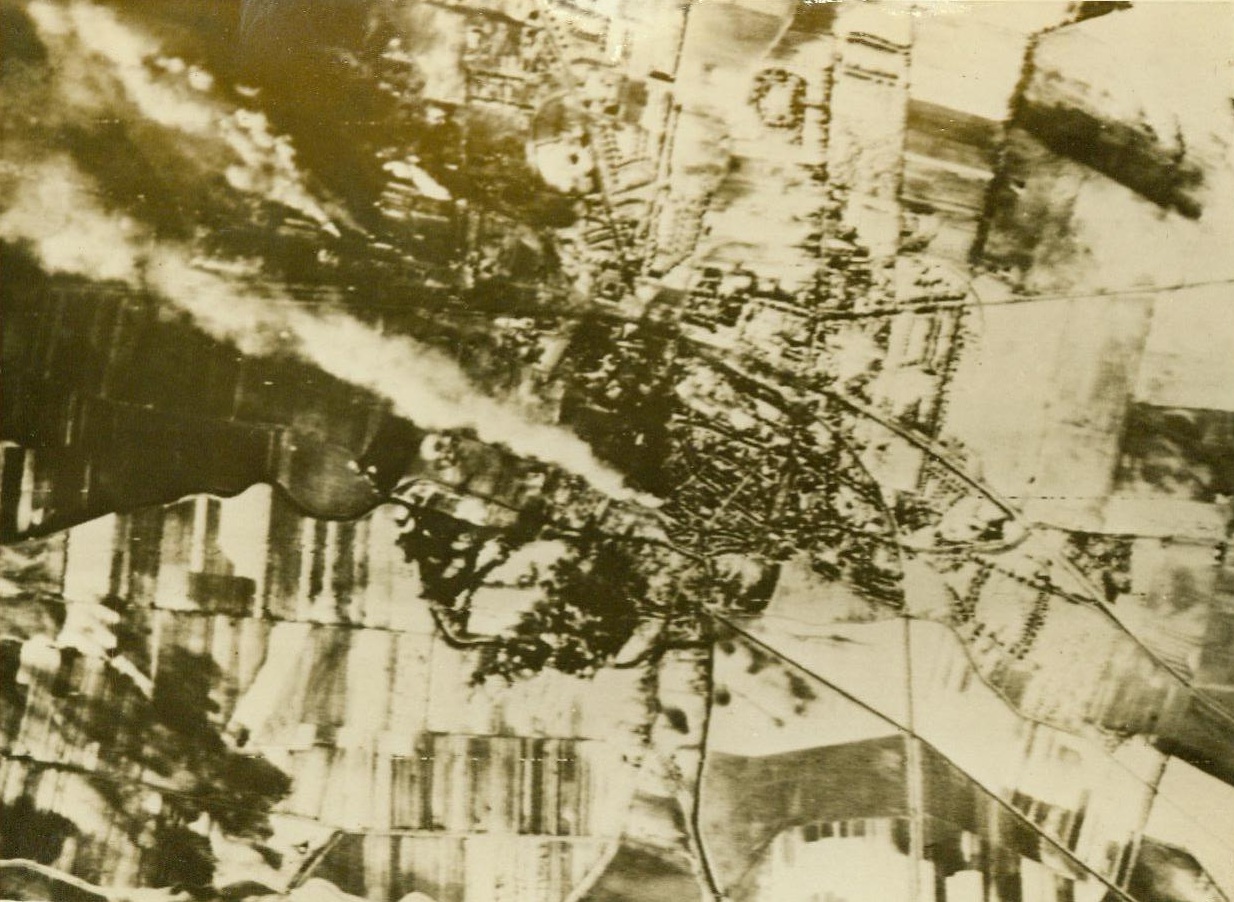
Bomb Nazi Air Plant, 1/13/1944. FOCKE-WULF – 190 factory buildings at Oschersleben, Germany were greatly damaged by Flying Fortresses in an attack January 11th. When the forts left the target, the main machine shop, erecting shop, and the assembly ship were all burning. CREDIT (USAAF photo via Signal Corps radiotelephoto from ACME) 1/13/44;
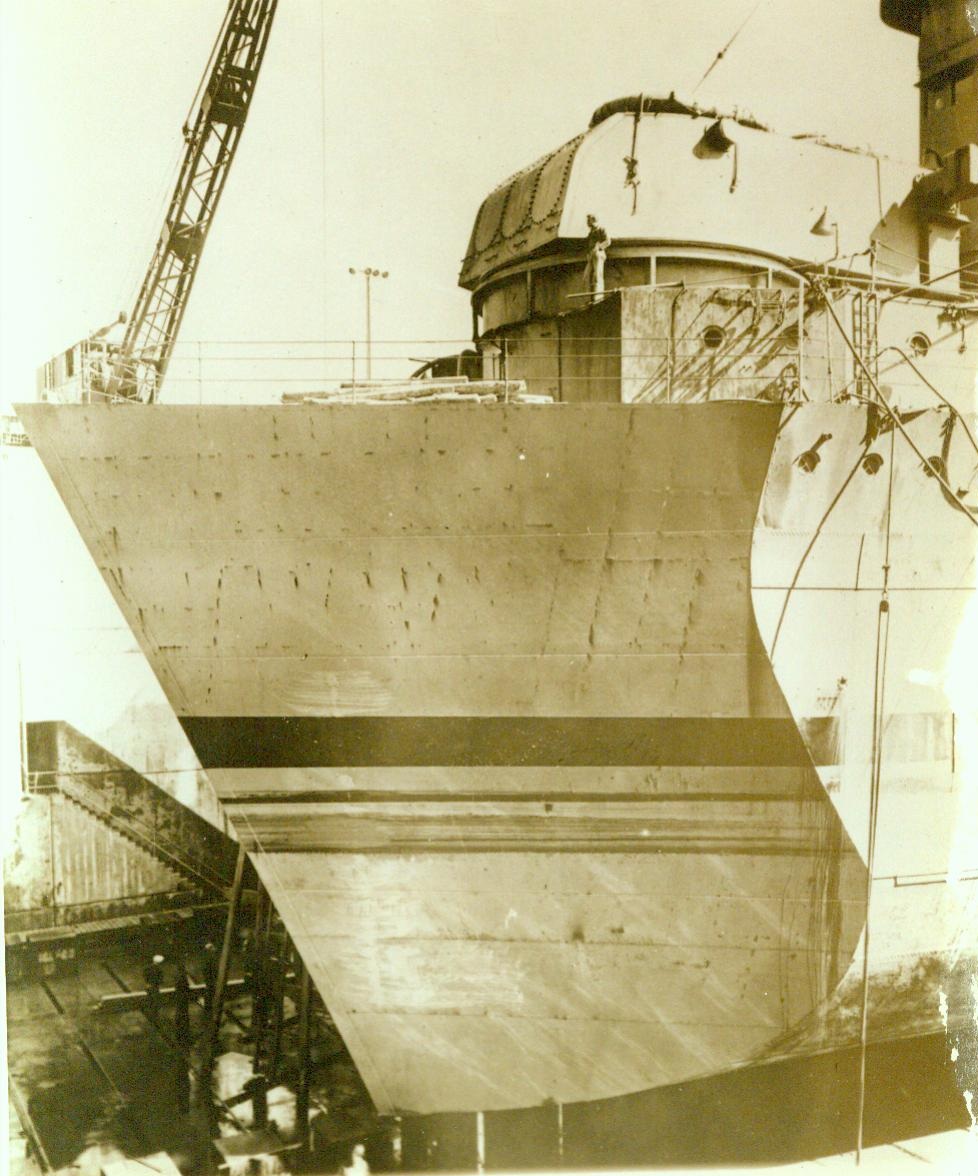
Stubby bow brings her home, 1/12/1944. BREMERTON, WASH. – With stubby temporary bow, this torpedoed U.S. cruiser made her way home from southwest Pacific battle area. A new bow was begun at Puget Sound Navy Yard, Bremerton, Wash., while the cruiser was enroute from south Pacific, and upon arrival she was quickly repaired and sent back into battle, a more deadly fighter than before. CREDIT LINE (U.S. Navy photo from ACME) 1/12/44;
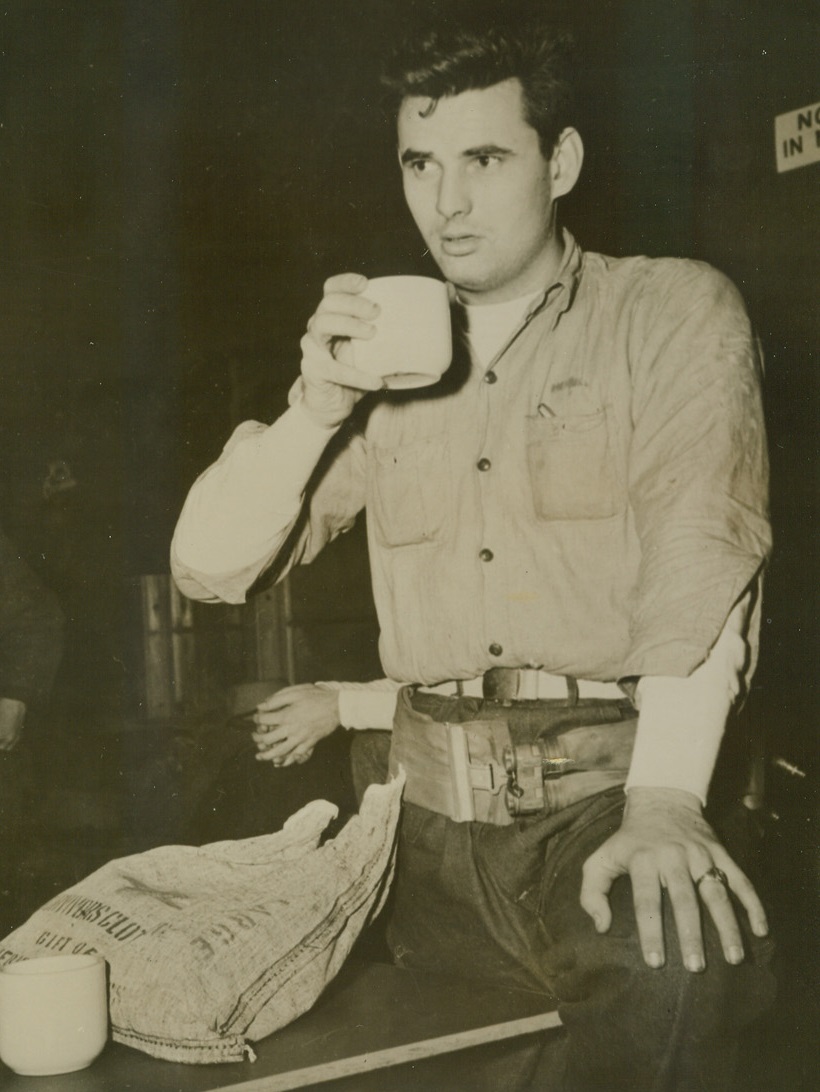
Survivor of Explosion, 1/3/1944. Sandy Hook, N.J. - Brought to the Sandy Hook Coast Guard Station after he survived the explosion and sinking of a U.S. Destroyer at the entrance to New York Harbor on January 3rd, Radioman I/c David L. Merrill, 21, of Henrietta, Texas, sips hot coffee. Beside him is the Red Cross “Survivor” kit of warm clothing, given him at the station. Credit: Official U.S. Navy photo from ACME;
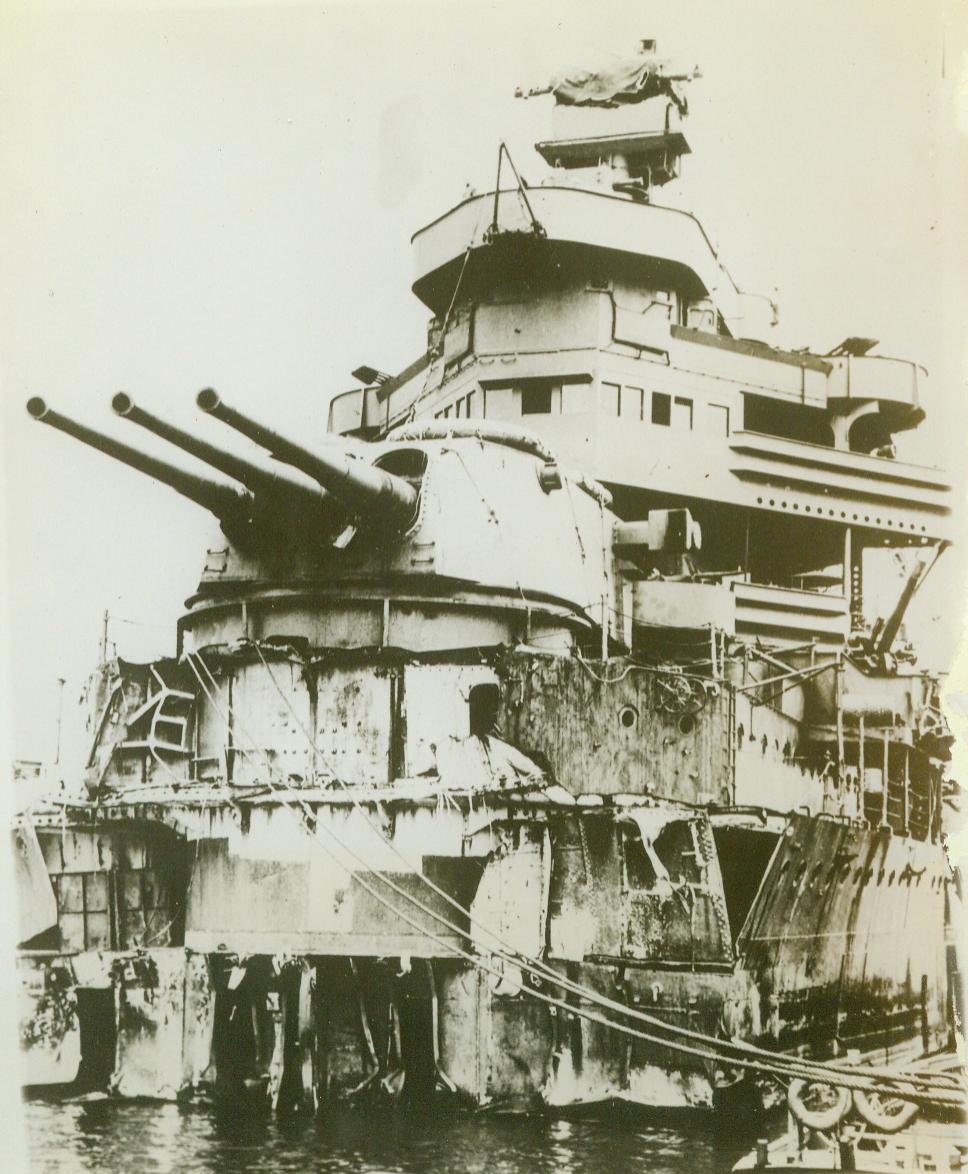
Bow blown off, 1/12/1944. SOUTHWEST PACIFIC – With bow shot off by torpedo blast in southwest Pacific battle with Japs, this U.S. cruiser limped to a Pacific island harbor for repairs and a temporary bow which allowed her to be taken to Pudget Sound Navy Yard, Bremerton Wash. For complete repairs and modernization. Now the cruiser is faster and more deadly than before. CREDIT LINE - U.S. Navy photo from ACME 1/12/44;
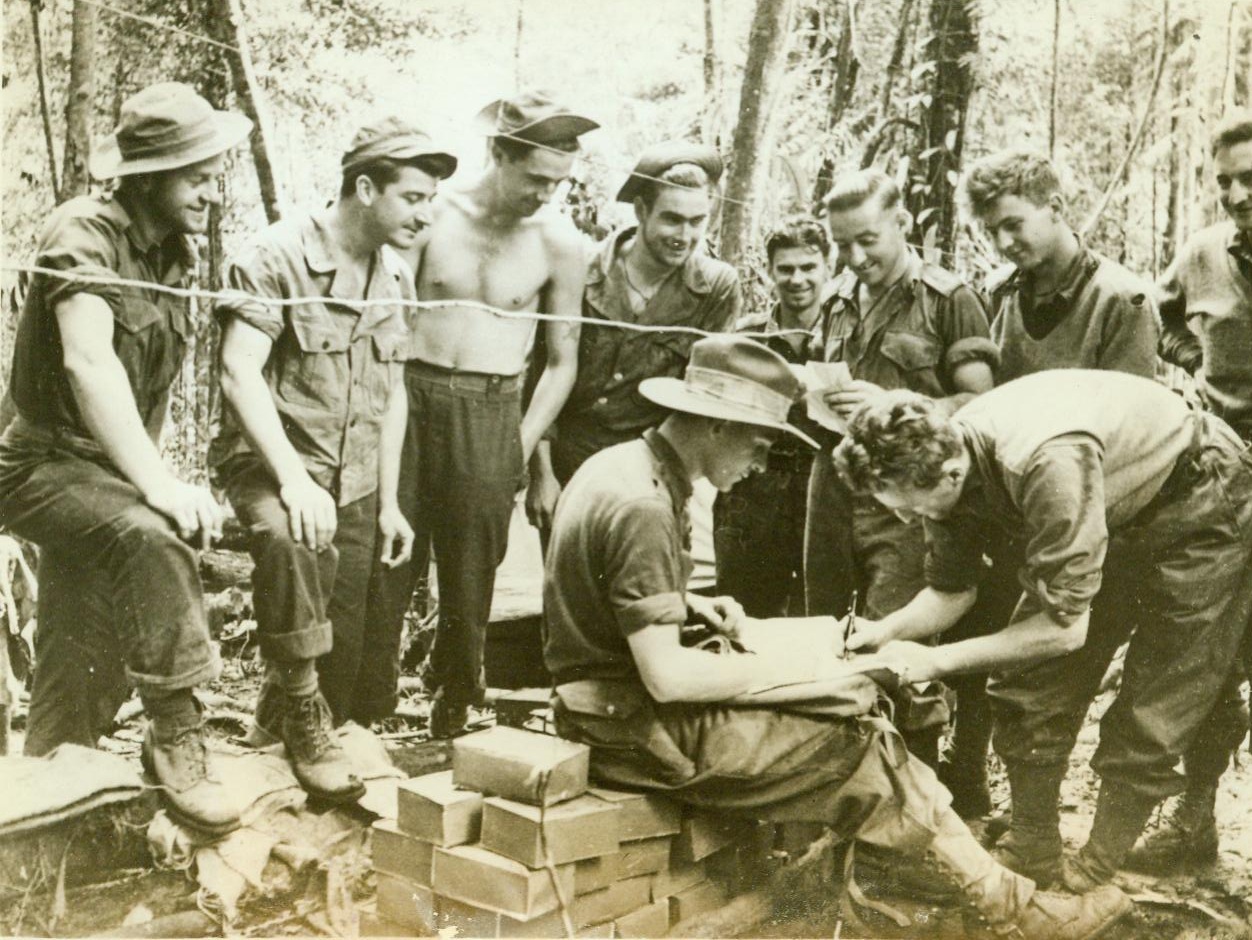
Nobody Denied Aussies Their Vote, 1/14/1944. NEW GUINEA - Neither the whims of Congressmen nor a complicated balloting system robbed Australian fighting men of their right to vote in their country's federal elections. Looking on as Cpl. A.E. Tierney of Wonthaggi, Victoria, signs the envelope in which his ballot is sealed, American troops wonder they'll be allowed to do the same when their countrymen go to the polls. Seated is Lt. Larry Drake of Draling, Victoria, the unit's electoral officer, who supervised the balloting only half a mile from the Japanese front lines at Goodview Junction.;
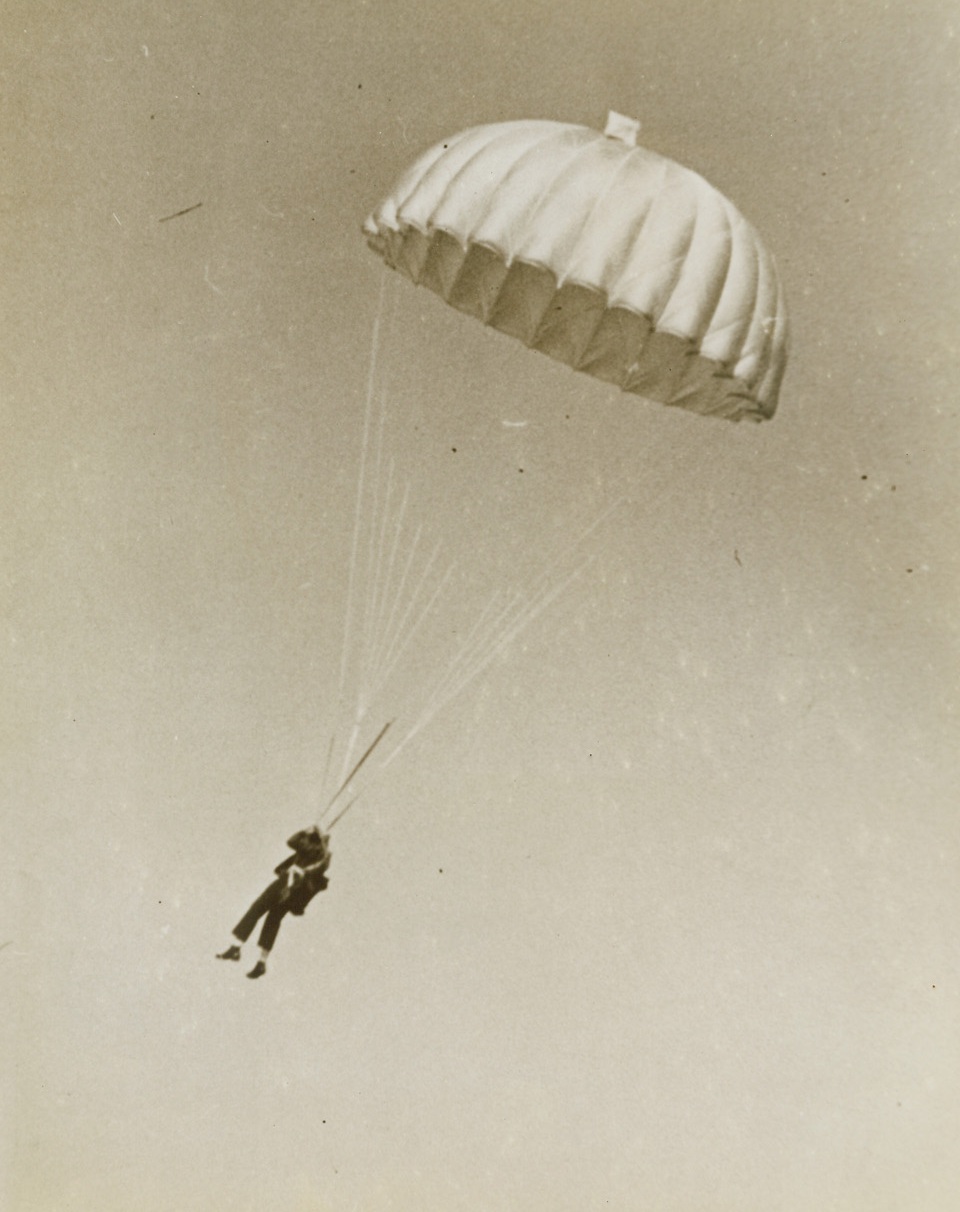
As His Plane Goes Down in Flames, 1/22/1944. San Francisco - Hitting the silk to safety, Lt. Harry E. Pape floats earthward after his fighter-plane plunged out of control 6,000 feet over Oakland, Calif. Pape’s only injury was a wrenched knee suffered on landing, but the burning plane injured 10 when it crashed into a building at the Alameda, Calif., Naval Air Station. Credit: U.S. Navy photo from ACME;
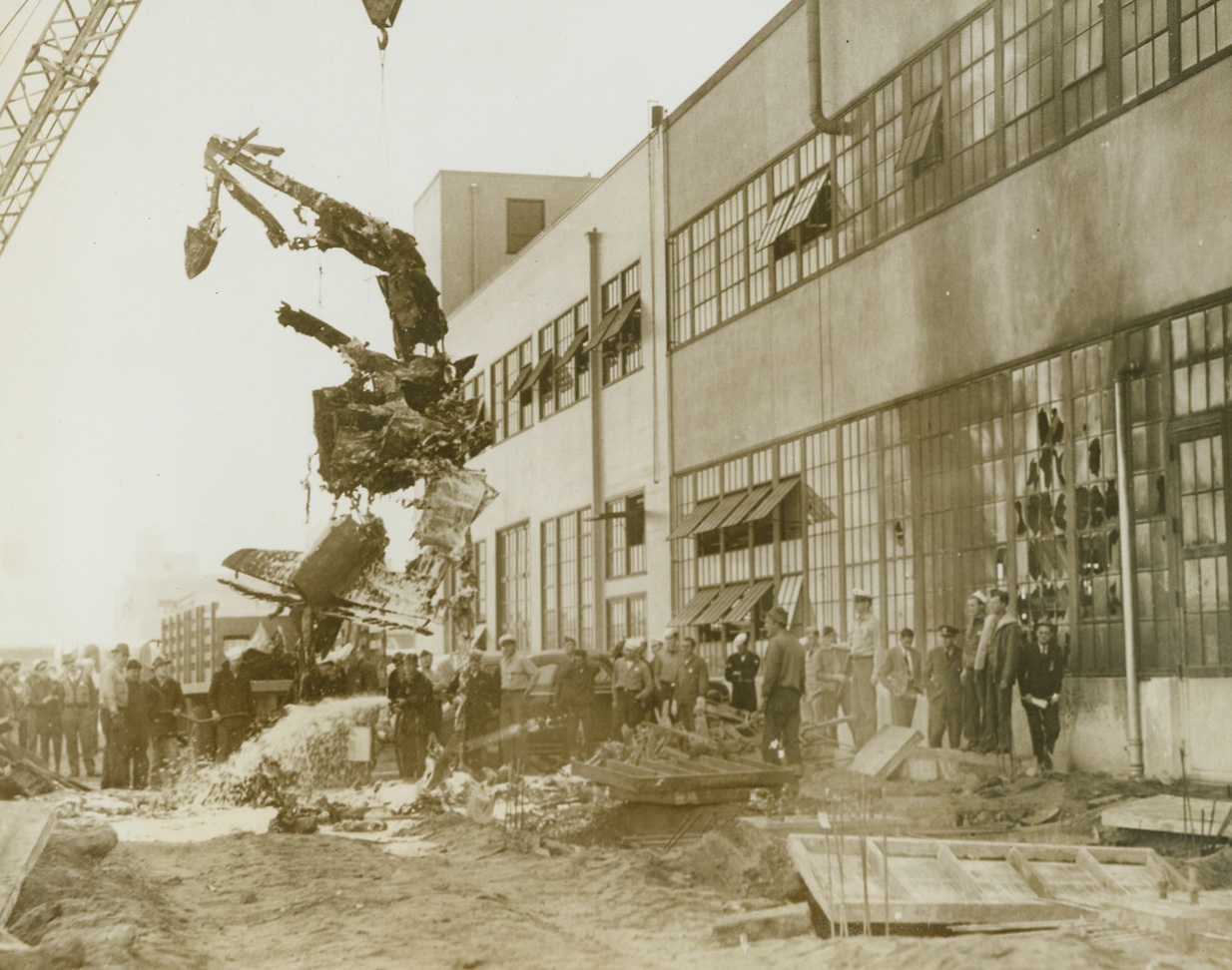
But the Pilot Escaped, 1/22/1944. San Francisco -- All that was left of Lt. Harry E. Paper’s single-seater Army fighter plane dangles from a crane at the Alameda, California, Naval Air Station where the aircraft crashed. Exploding, the cracked-up plane injured ten building employees with a shower of flaming gasoline, while the pilot parachuted to safety. Credit: U.S. Navy photo from ACME;
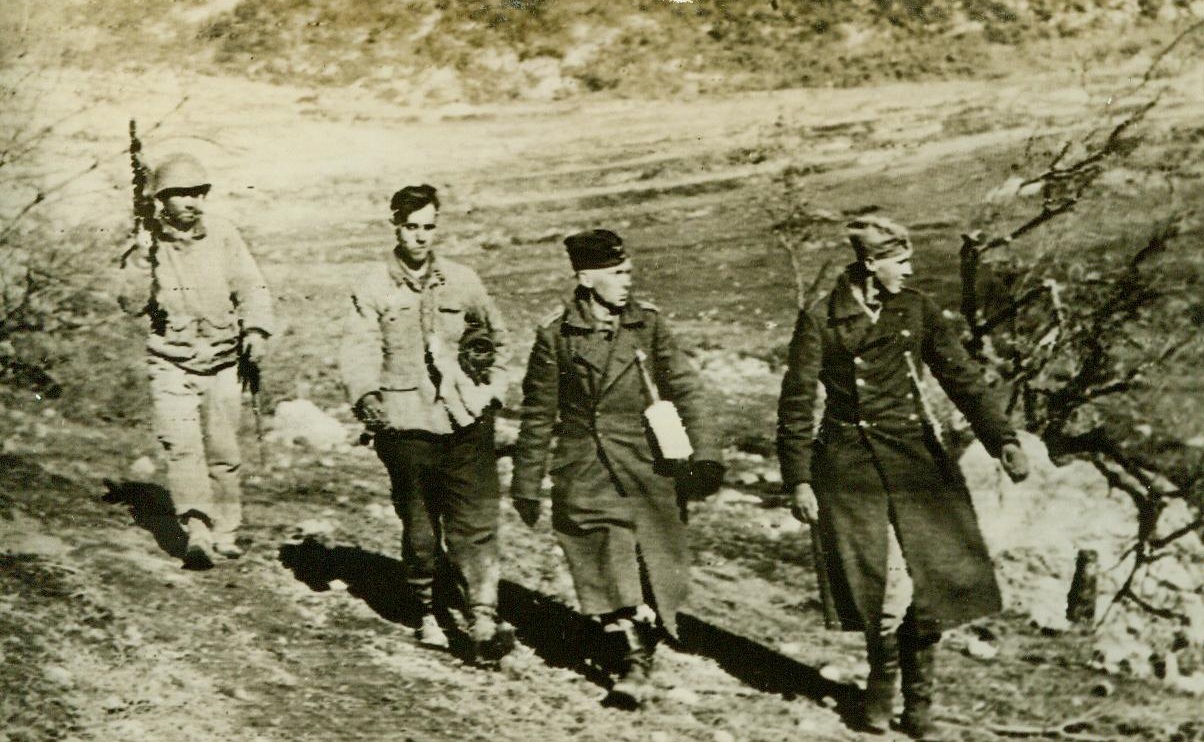
A short war for these Germans, 1/13/1944. MT. PORCHIA, ITALY – Pfc. Ira C. Creed, (left), of Johnson City, Tenn., marches three green recruits of the famous Hermann Goering Nazi Division down the side of Mt. Porchia, after capturing them single-handedly. The prisoners, who admitted they had only a little infantry training, were on duty in the front lines for only one night when he captured them behind a rock. They are shown on their way to a prisoner of war camp. CREDIT LINE (U.S. Signal Corps Radiotelephoto from ACME) 1-13-44;
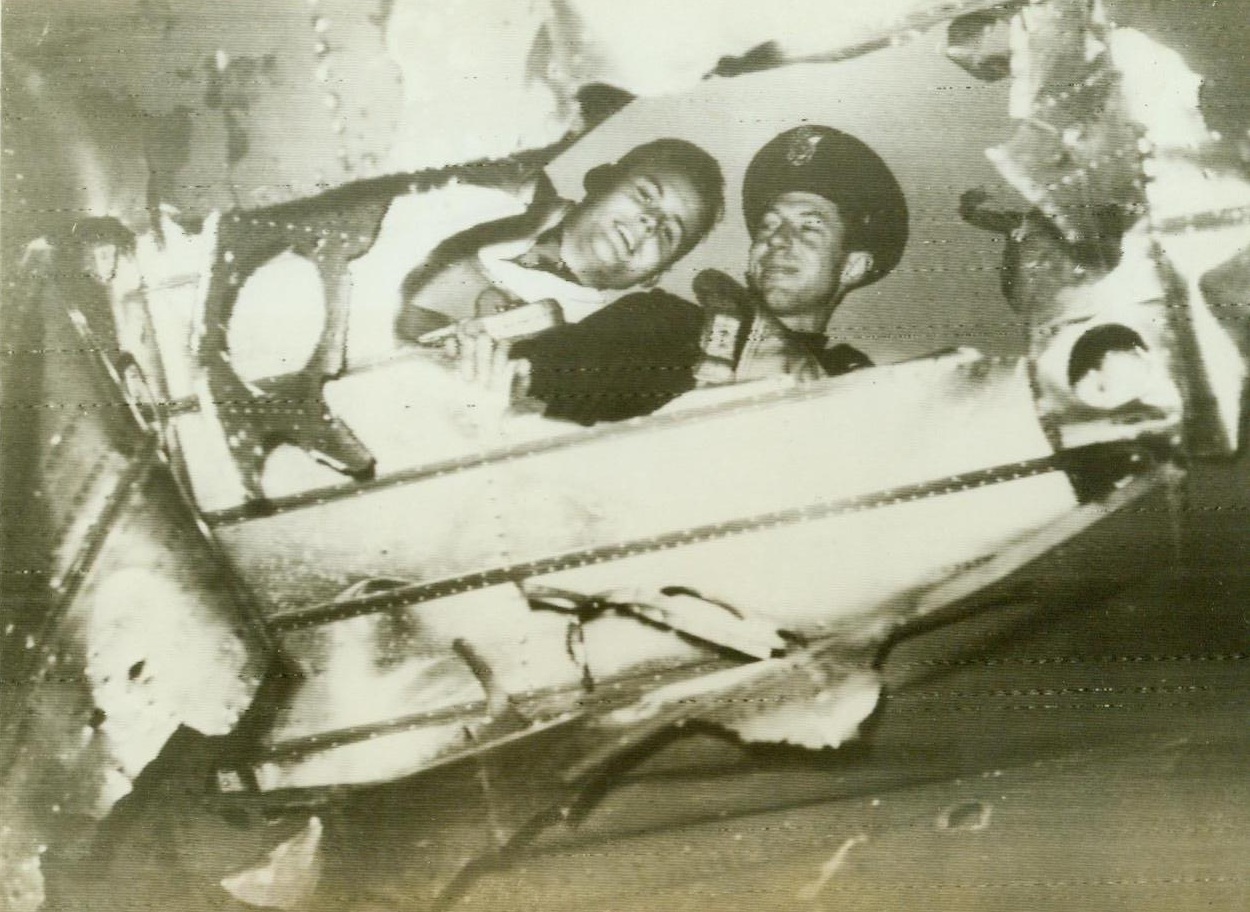
“Best damned pilot in the world”, 1/14/1944. SOMEWHERE IN ENGLAND – “He’s the best damned pilot in the world” was the way one of his wounded gunners described Second Lt. William Cely (wearing hat) of Houston, Texas, who brought the mutilated Fortress “Frenesi” back to its base in Britain after Tuesday’s (Jan. 11th) raid in which more than 60 bombers were lost. Wither her high tail nearly gone, holes in her wing big enough for a man to crawl through, one engine nearly knocked off, the crippled Fort flew through a swarm of attacking enemy fighters to come home. Examining a huge hole in the Frenesi’s wing with Lt. Cely is his co-pilot, Second Lt. Jabez Churchill of Santa Rosa, Calif. CREDIT LINE (ACME Radiotelephoto) 1/14/44;
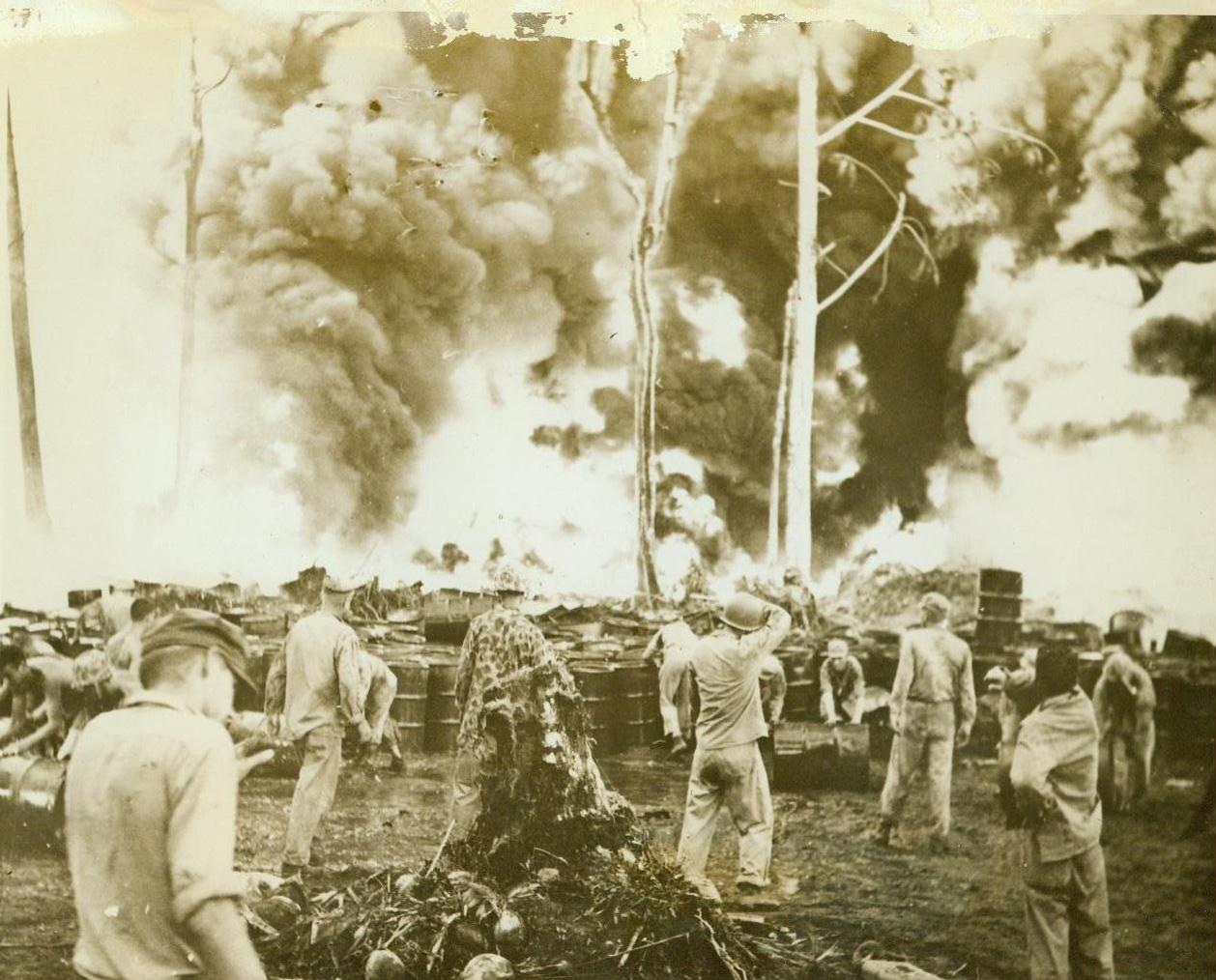
Leathernecks save fuel from Jap bomb fire, 1/11/1944. PURUATA ISLAND – United States Marines roll out unexploded drums of fuel from within 30 feet of hungry pillars of fire, set off by a Jap bomb hit on Puruata Island. Thousands of drums, wet down by hose lines, were saved by the leathernecks fighting in the Bougainville Area. Two heat prostration cases were the only casualties in the “battle” with a flaming enemy. CREDIT (Official U.S. Marine Corps photo – ACME) 1/11/44;
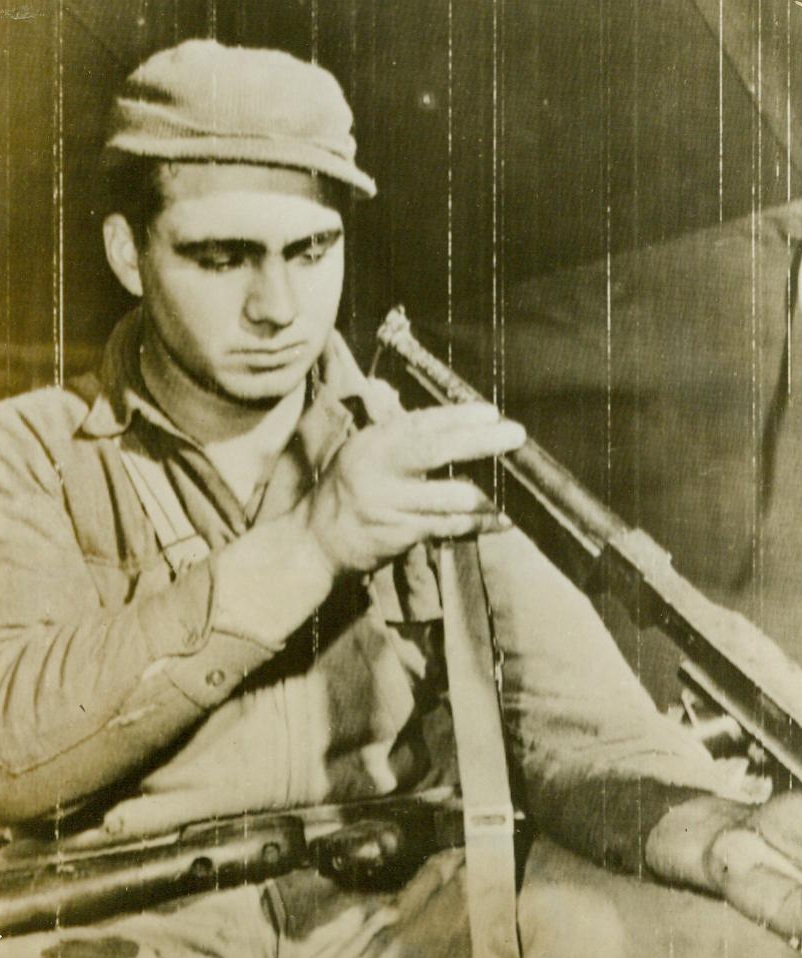
Put twenty-seven Nazis out of action, 1/11/1944. Sgt. Willie B. Slaughter, who lived up to his name and won the DSC, inspects his now-famous “Tommy Gun.” He used the weapon to knock out two Nazi machine guns nexts, kill seven, wounding seven and capturing 13 enemy fighters. CREDIT (U.S. Army Radiotelephoto from ACME) 1/11/44;
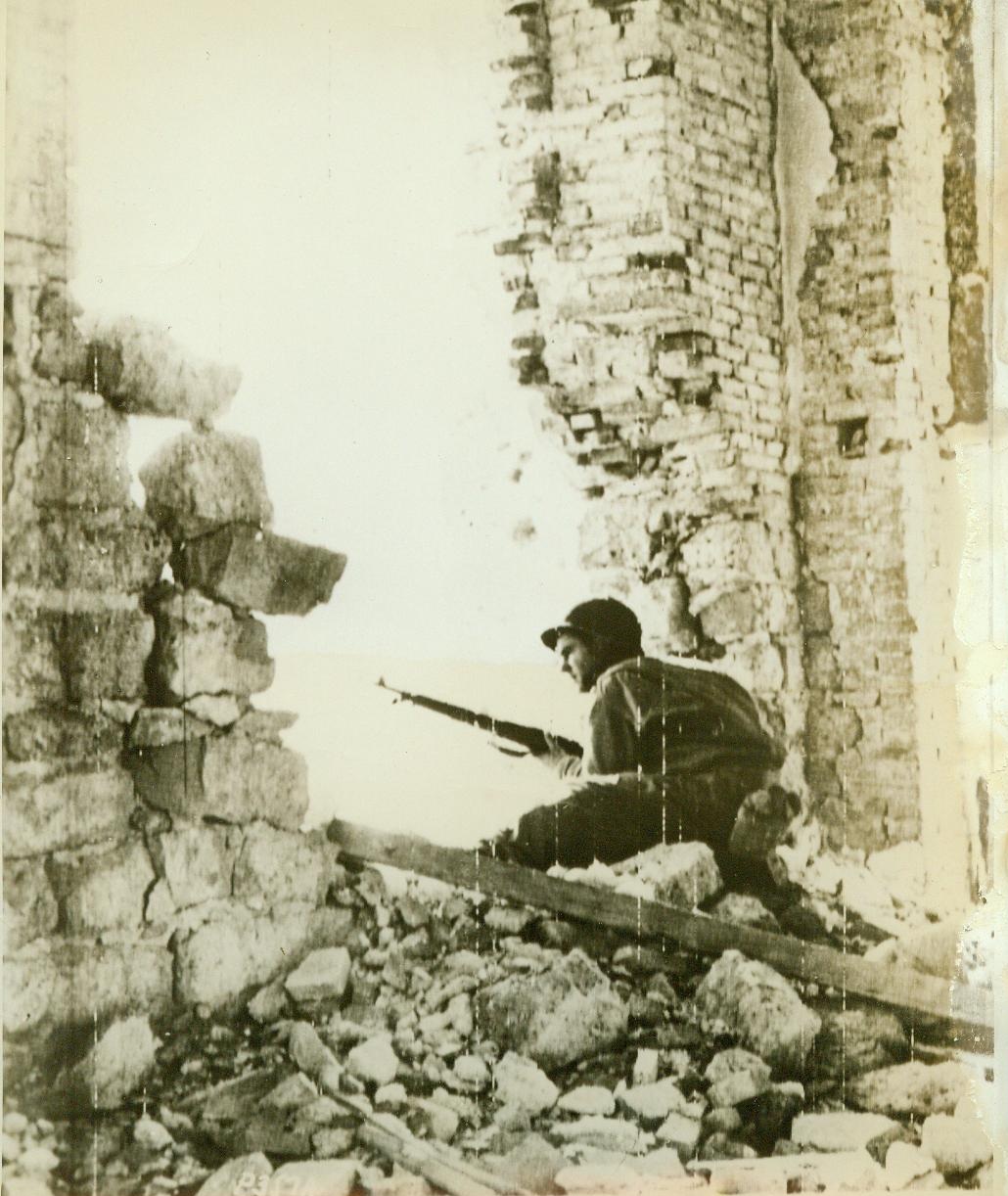
Looking for snipers, 1/11/1944. SAN VITTORE, ITALY – An American soldier peers carefully through a breach in a wall of a blasted building in San Vittore, keeping a sharp watch for German snipers remaining in the town after it was occupied by the Allies. This photo was flashed to the U.S. by radiotelephoto. CREDIT LINE (ACME ) 1-11-44;
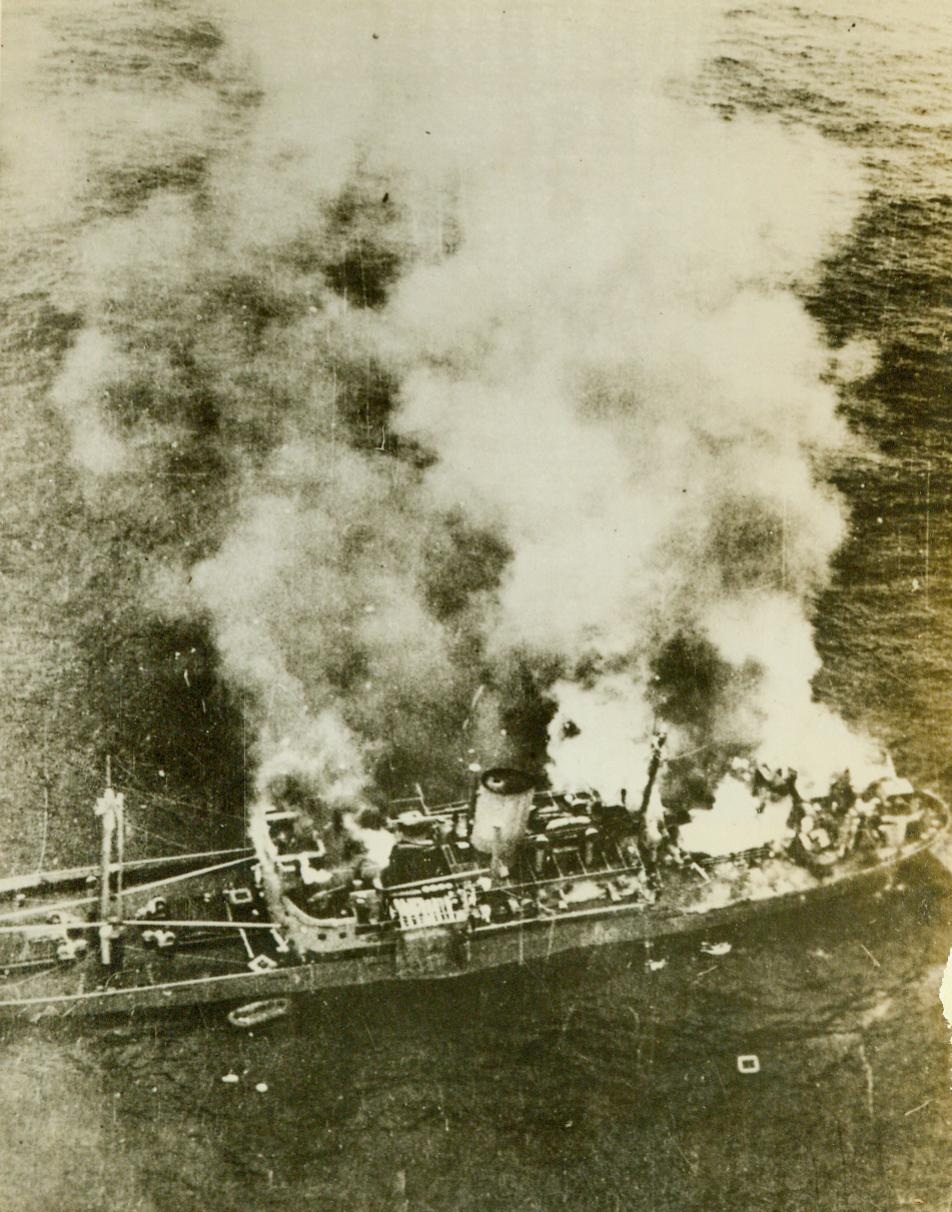
The beginning of a Nazi nightmare, 1/11/1944. AT SEA – Not only did the Allies bomb this German blockade runner, but when the Nazis sent out a flotilla of 11 destroyers to escort the vitally needed cargo to safety, a pair of British cruisers blasted three of them to the bottom of the Bay of Biscay, damaged others, and scared all of them away. A Czech-flown, American-built British Coastal Command RAF Liberator bomber laid the eggs on the enemy cargo ship. CREDIT LINE (ACME) 1/11/44;
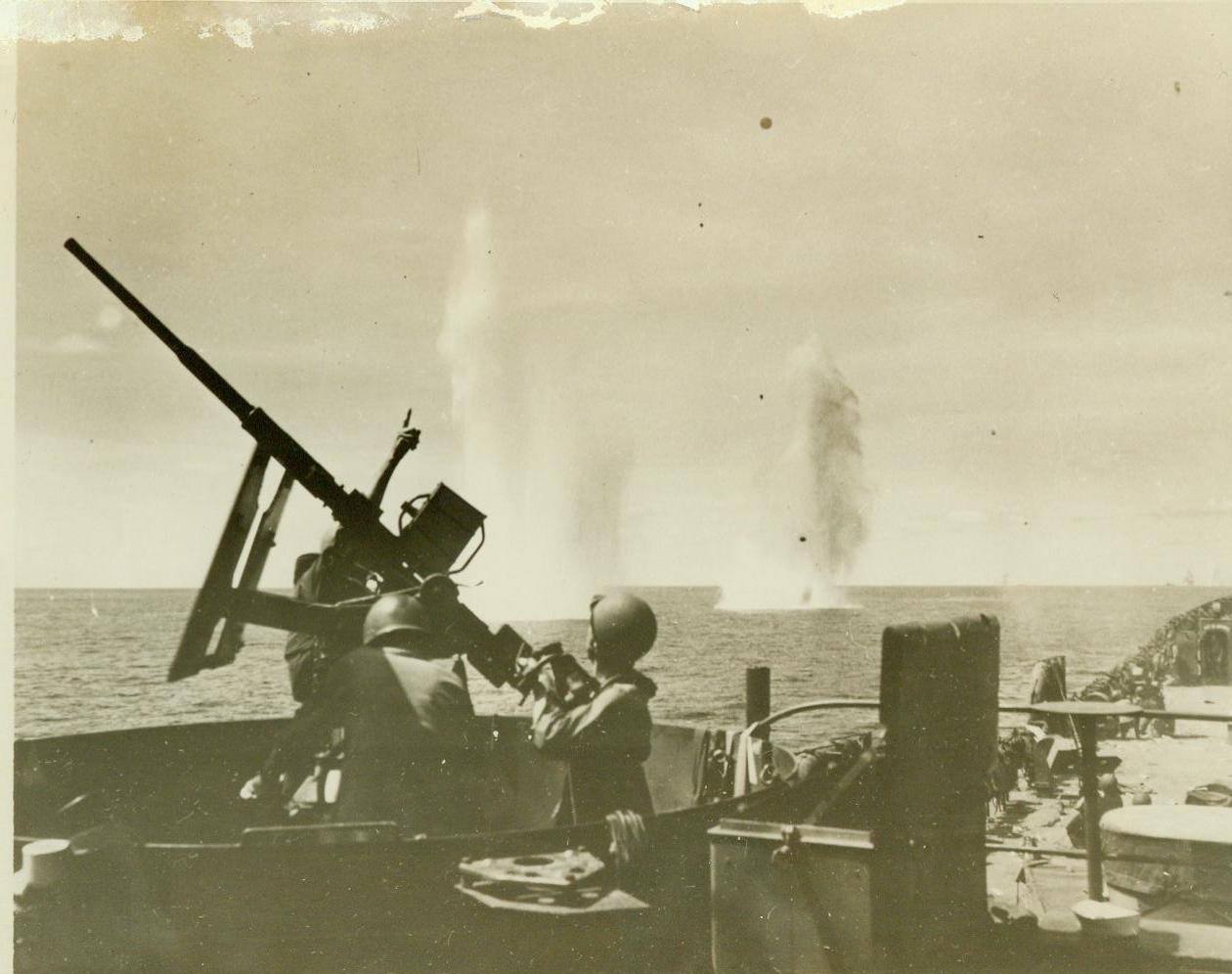
...Guard Gets Some Near Misses, 1/10/1944. ...BRITAIN - Far too close for comfort...the white geysers that mark Jap bombs...near an American LST (Landing Ship...) which aids the invasion of Cape...New Britain. Behind the...anti-aircraft gun, a U.S. Coast Guardsman...at the sky and an enemy plane.;
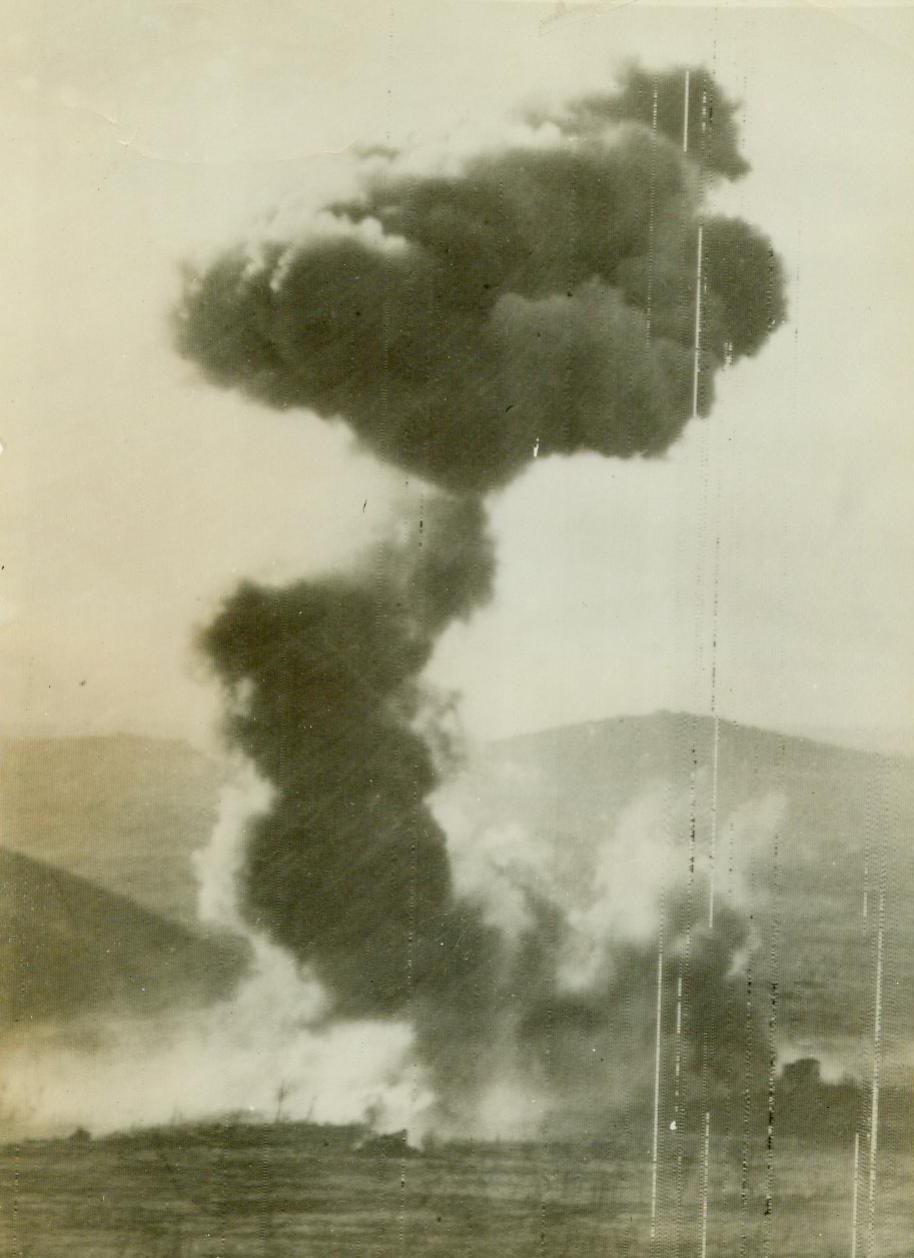
Long range scorched Earth policy, 1/10/1944. ITALY – The Germans evidently had to leave so quickly from Cassino Valley that they didn’t have time to destroy equipment and supplies which they were forced to leave behind. Here a German shell hits their own own gasoline and oil dump abandoned in their retreat from San Vittore. The hit throws flame and smoke 2,000 feet high over the valley. In the foreground are farmhouses which the Nazis had used as pillboxes. CREDIT (ACME) 1/10/44;
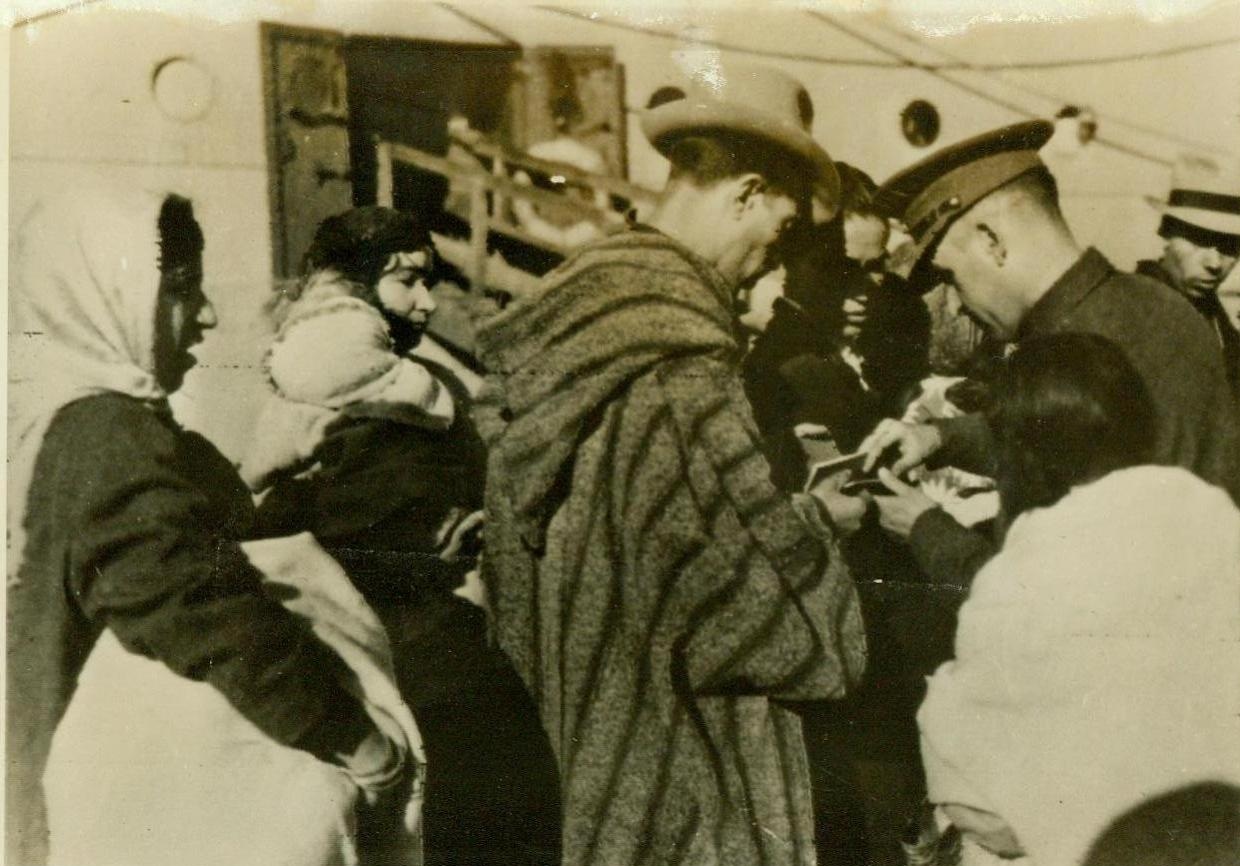
A new change for homeless refugees, 1/10/1944. A NORTH AFRICAN PORT – Some of a large group of refugees, left homeless by the German advance through Europe, check out at a North African port before boarding a ship, which will take them to Palestine. There, they will be given the opportunity to establish themselves as agricultural settlers. CREDIT LINE (ACME) 1-10-44;
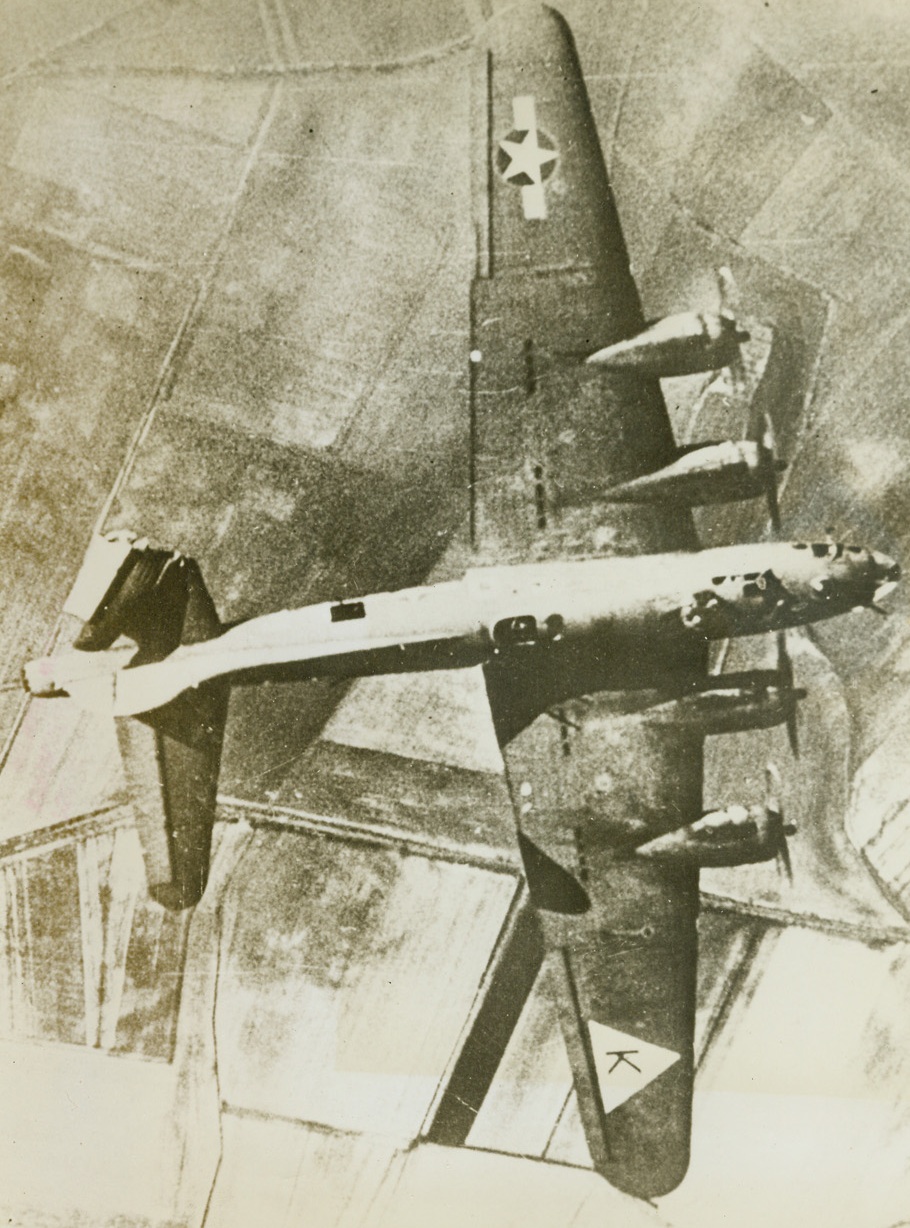
THE FORT IS A RUGGED WARBIRD, 1/27/1944. ENGLAND—Here’s further evidence that the Flying Fortress is a rugged ship. This warbird was struck by one of the enemy’s new aerial rockets as it headed for a raid on Nazi territory. Its left horizontal equalizer and elevator were damaged and the plane was forced out of formation, but the Fort made its high altitude run over the target anyway, and safely returned to its base. Photo was made from the Fortress above the damaged plane. Credit Line (ACME);
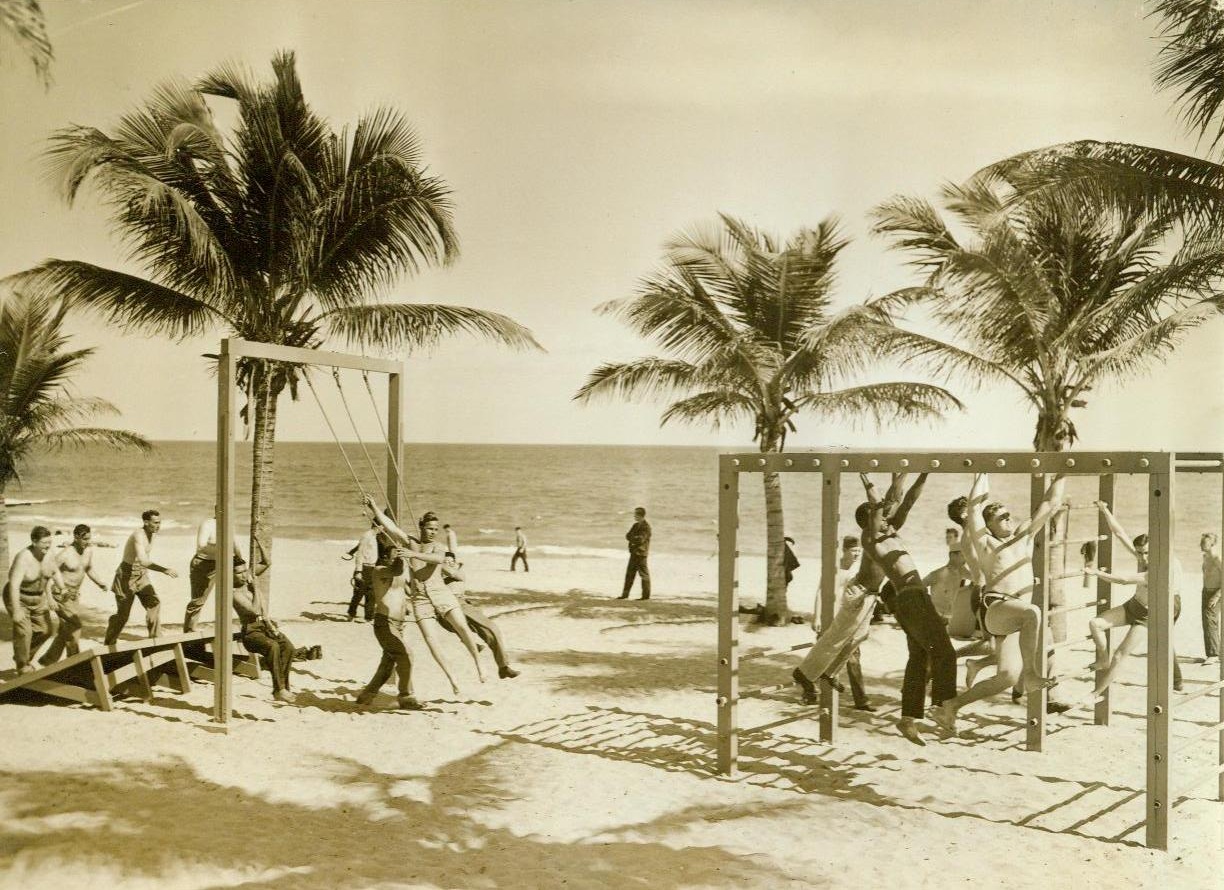
No Title. 1/31/1944.
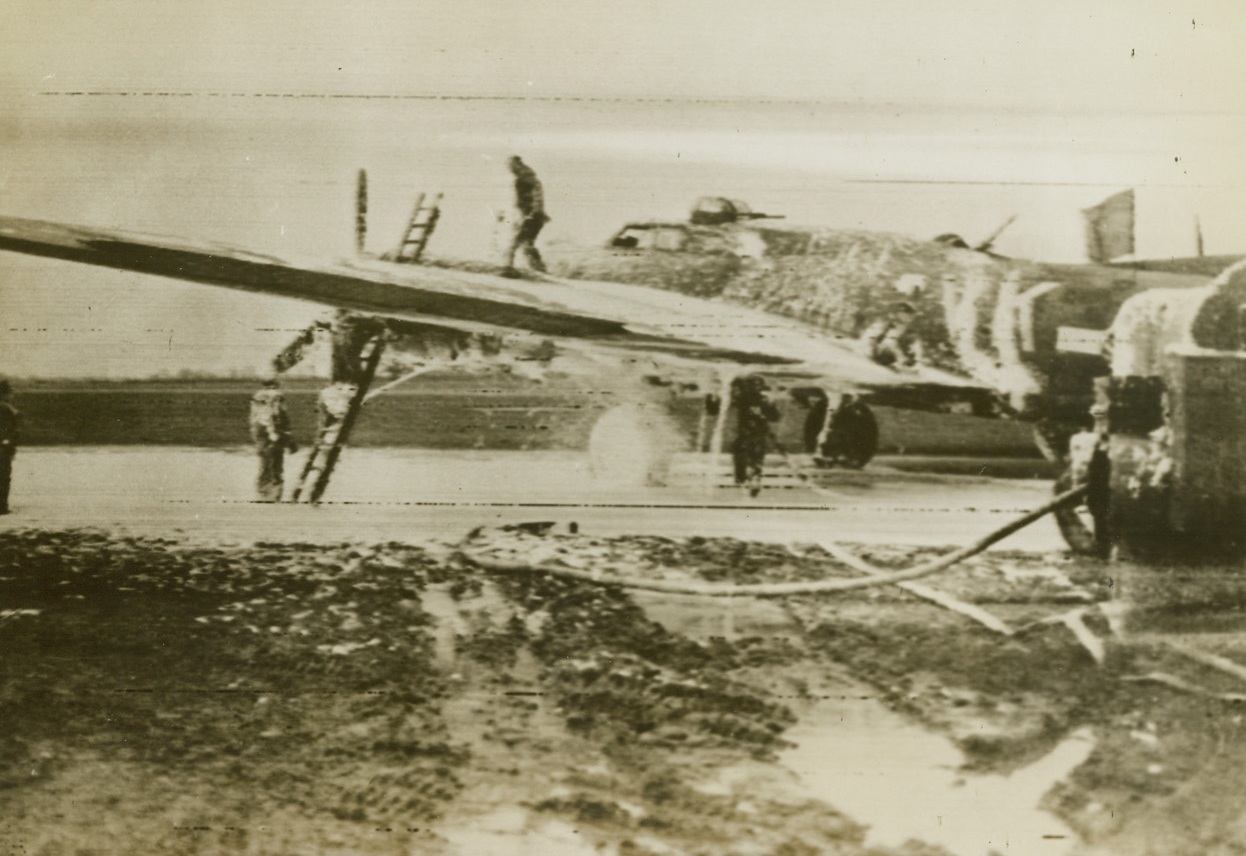
BROUGHT HOME IN FLAMES BY “SERIES STUNTER”, 1/14/1944. ENGLAND—A ground crew extinguishes the flames ravishing the Flying Fortress brought back to England ablaze by Lieut. Jack Watson, who last made headlines when he flew low over the Yankee Stadium during a World Series game last October and was rebuked by Mayor La Guardia. When he was jumped ”by about 50 German fighters,” and a shell blew up his No. 2 engine, Lt. Watson ordered his crew to jump, but managed to bring the fiery Eagle home. Credit (U.S. Army Air Forces photo via Signal Corps Radiotelephoto from ACME);
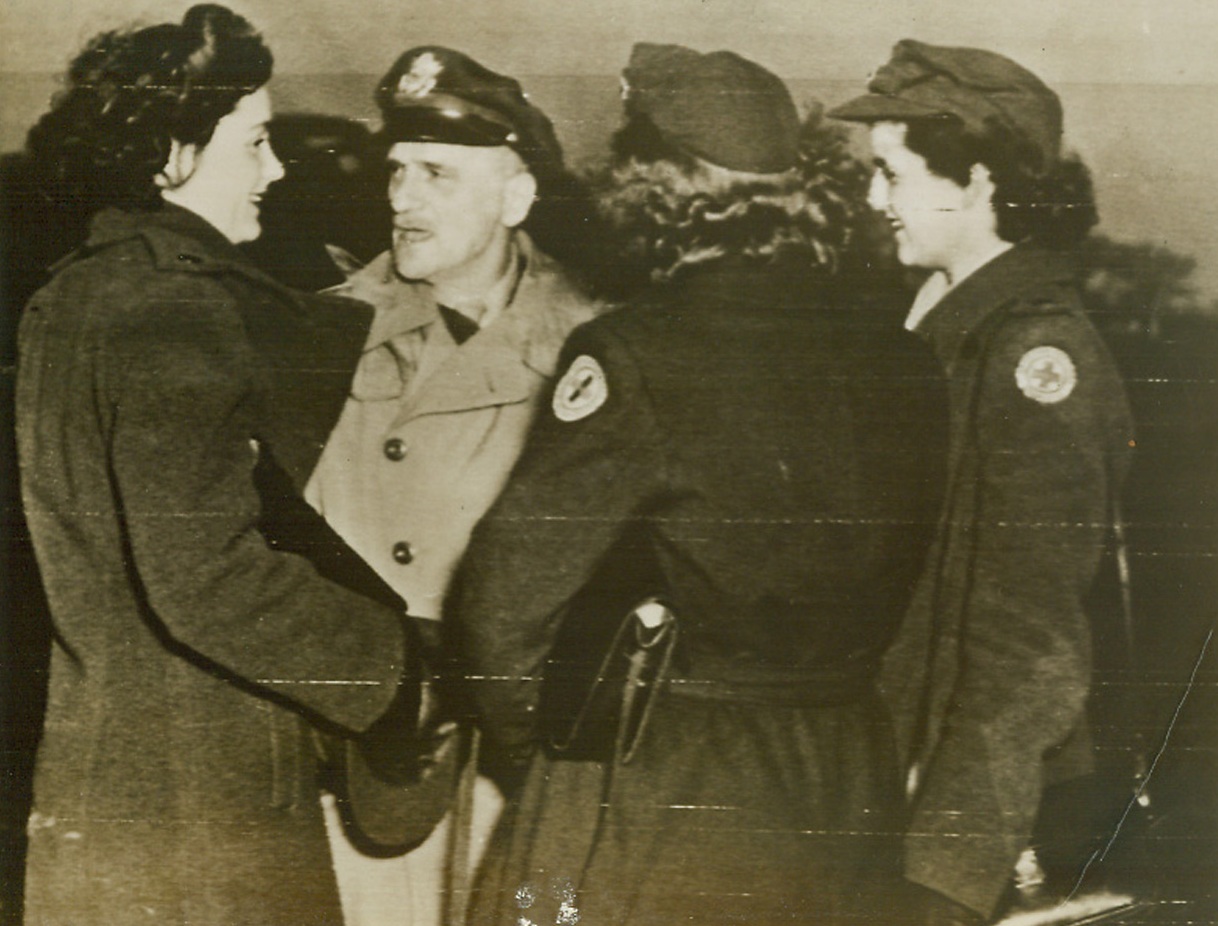
DAD GREETS HIS DAUGHTER, 1/5/1944. SOMEWHERE IN ENGLAND—Arriving at a Fortress base somewhere in England, Red Cross worker Tatty Spaatz (left) is greeted by her distinguished dad, Lt. General Carl Spaatz, American commander of strategic bombing in the invasions of Western Europe. With back to camera is Dorothy Mairek of Fort Wayne, Ind., and (at right) Virginia Sherwood of New York City, both Red Cross workers. Credit (Signal Corps Radiotelephoto from ACME);
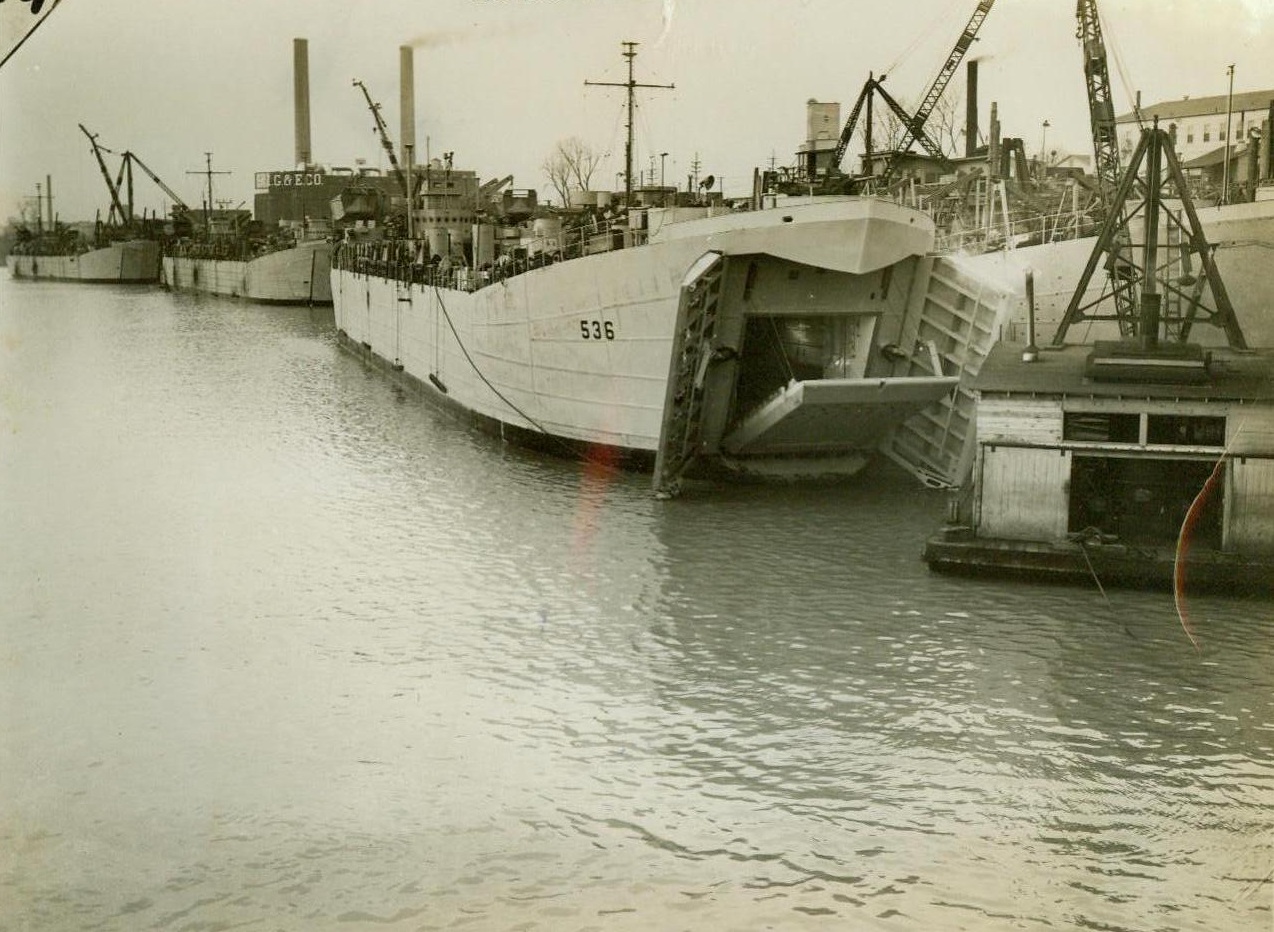
Shipbuilding brings boom to Evansville, 1/29/1944. Evansville, Ind.: Built on waste land, the two year old shipbuilding plant of the Missouri Valley Bridge and Iron Company, has been credited with producing a greater tonnage of ocean-going vessels than any other inland shipyard of the world, last year, and the Navy has its order to double last year’s quota! The company builds the Navy’s ugly-duckling, landing ships for tanks or LST as they are known in the service. Photo shows; LST vessels in the Ohio River ready for movement to the sea, 1,660 miles away! CREDIT LINE (ACME) 1-29-44;
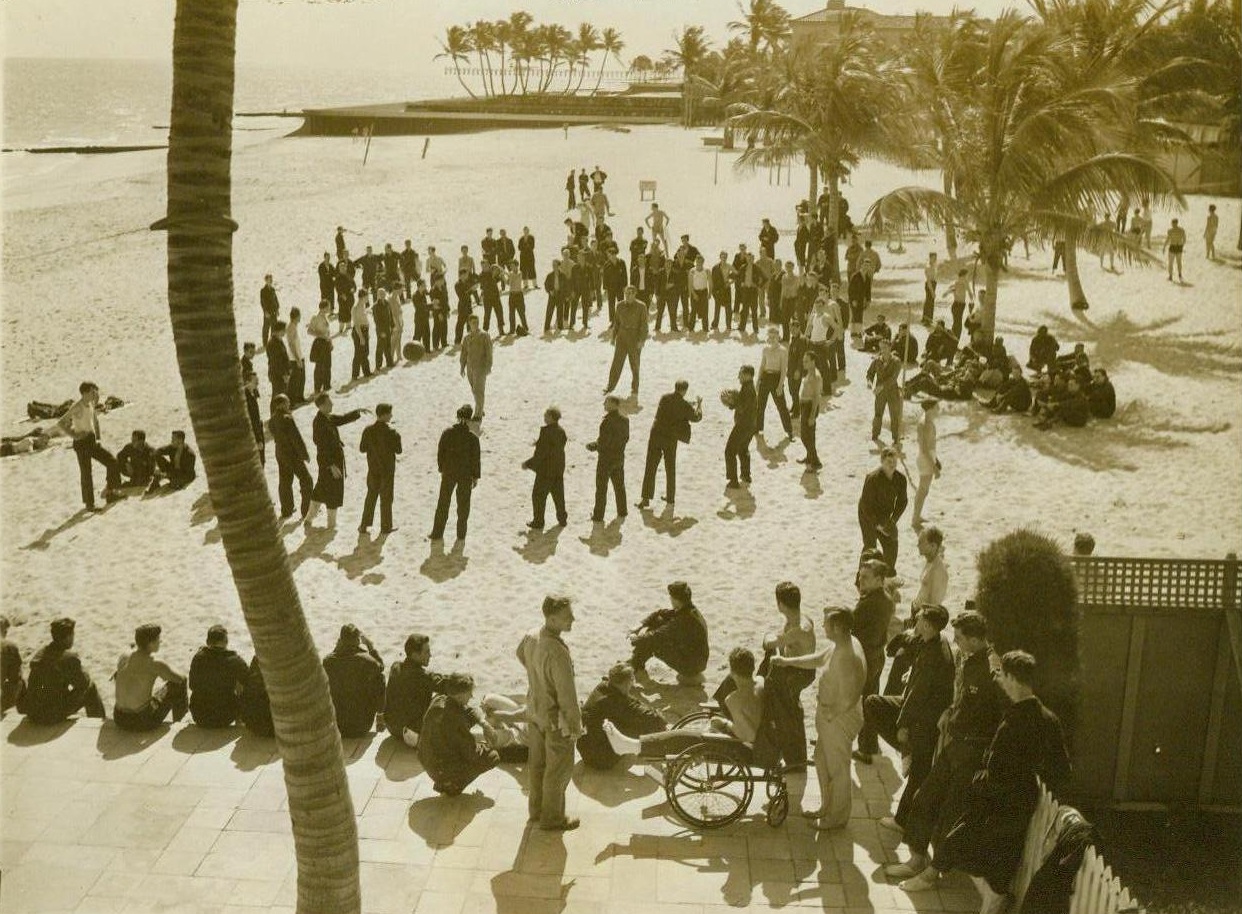
May have to find a new playground, 1/31/1944. PALM BEACH, FLA. – While some soak up sun in wheel chairs and other stretch out on the sand, a group of convalescing soldiers play healthful games on the sand at the Ream General Hospital, onetime Breakers Hotel in Palm Beach. Fighter Buddy Baer, recuperating from a back injury, is in the center of this circle of servicemen who may have to look for another “playground” is the hotel is returned to its owners for commercial use. CREDIT LINE (ACME) 1/31/44;
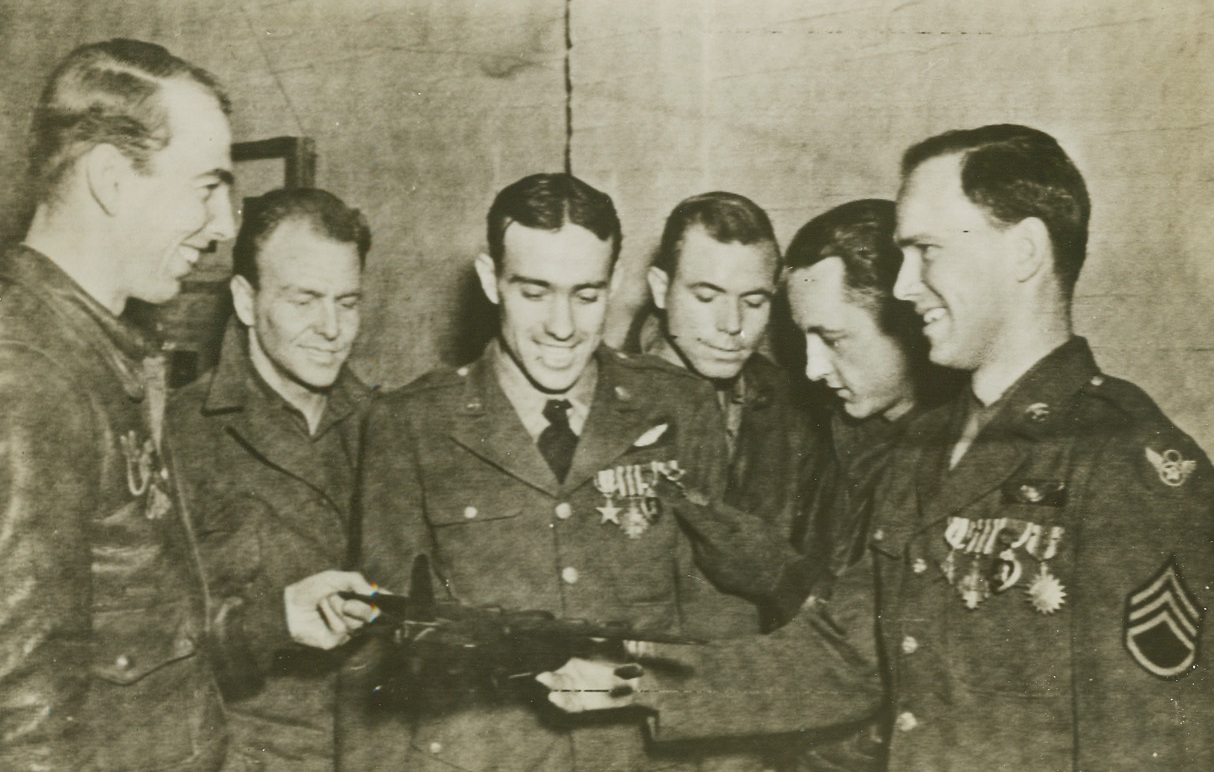
Seven in One Day, 1/31/1944. England – S/Sgt. Oliver R. Germann, 25, of Moran, Wyoming, extreme right, who received seven decorations in one day, the Silver Star, DFC with Oakleaf Cluster, Purple Heart, Airmedal with Three Oakleaf Clusters, holds a wooden model of a bomber given by S/Sgt. M. Hall, of Sanger, California, extreme left. Others watching the little ceremony are, left to right: S/Sgt. F.B. Mellums, of Springfield, Tennessee; S/Sgt. L.L. Ackerman, of Fox, Arkansas; T/Sgt. B.R. Smith, of Insull, Kentucky; S/Sgt. J.A. Crowder, of Luden, Tennessee, and S/Sgt. Oliver Germann. Credit: ACME;
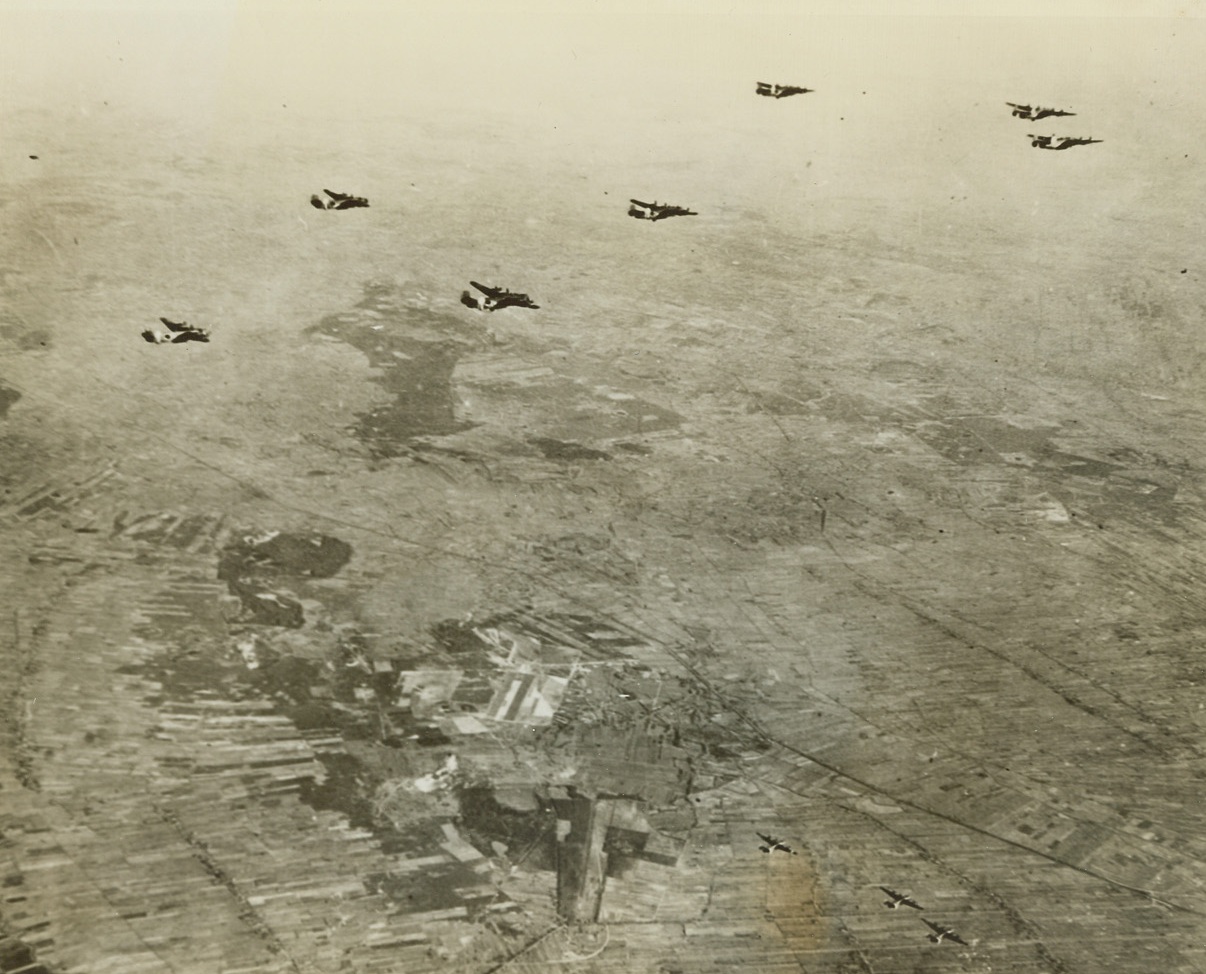
Just Ignored, 1/31/1944. England – Liberator bombers of the U.S. Army 8th Air Force wing their way to their target, Munster, Germany, and contemptuous of Nazi aerial strength, blandly ignore this German airfield enroute to their mission. Credit: U.S. Army Air Forces photo from ACME;
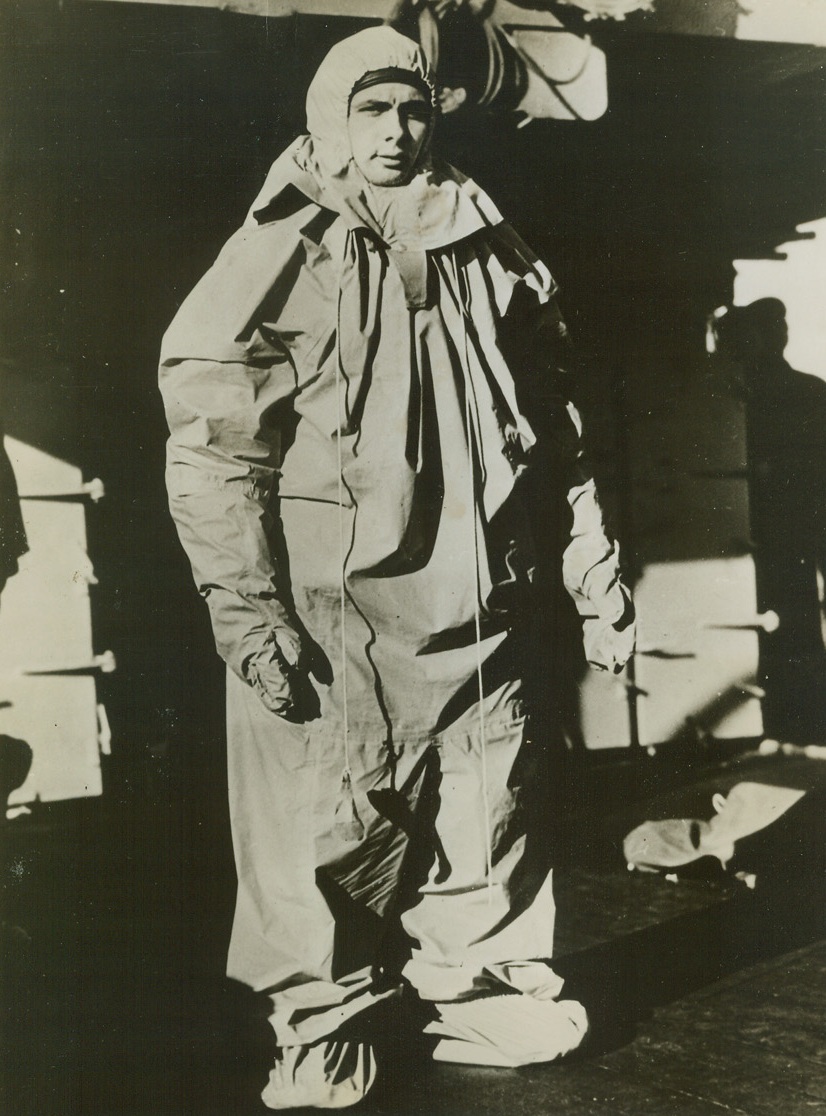
Dressed for an Icy Dunking, 1/6/1944. Recent tests proved that the lightweight exposure suit worn by this PCAF flier will increase the chances of survival of an airman brought down in icy seas. This pilot got a dunking in the Canadian-Atlantic and was able to float comfortably for hours, while his companions who wore only ordinary pilots’ clothing or sheepskin suits had to holler for “rescue” almost immediately. A joint U.S.-Canadian air-sea committee conducted the tests in 40 degree water. Credit: Army Air Force photo from ACME;
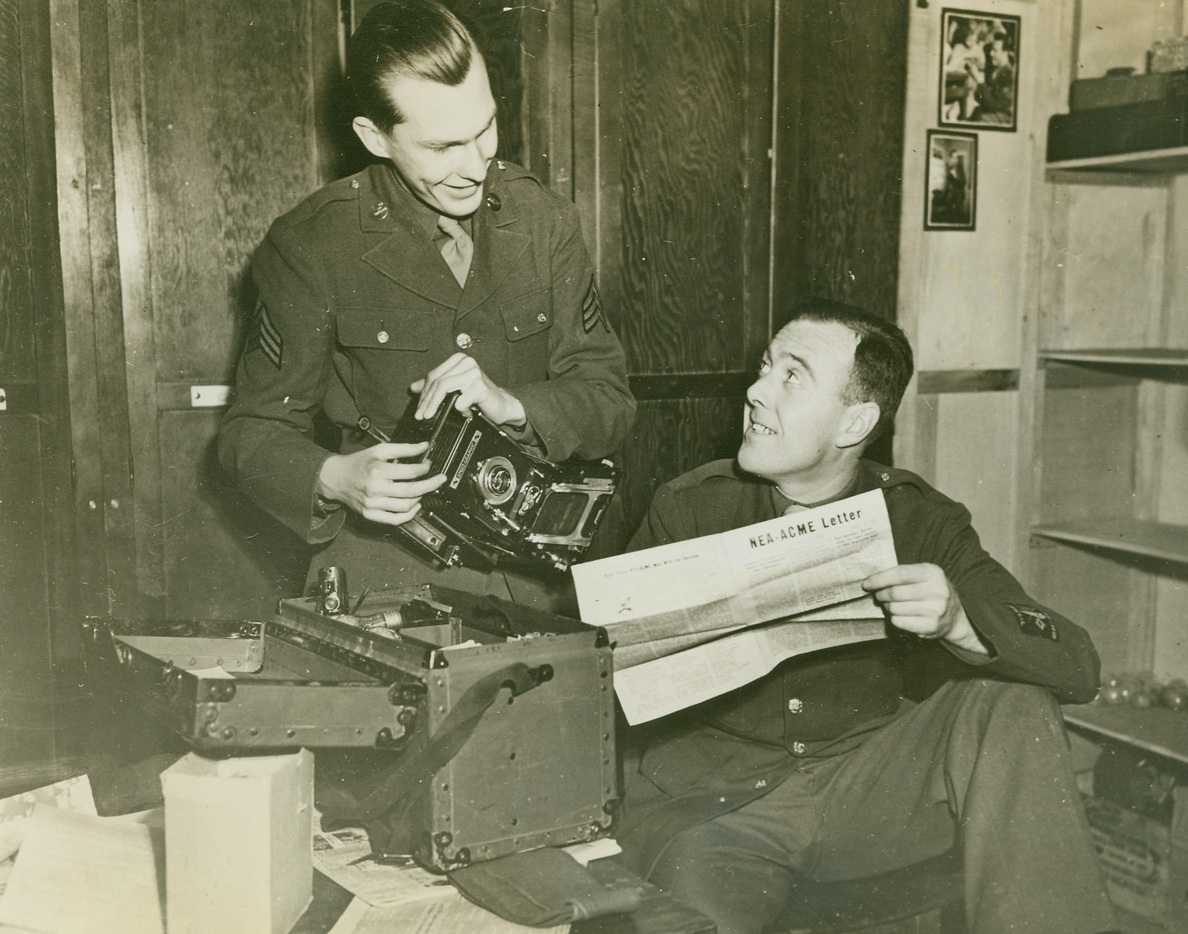
Hello Again, 1/7/1944. Somewhere in England – Meeting in England, a year and a half after both boys worked on ACME Newspictures’ photographic staff, Sgt. Reginald Kenny (left) of Somerville, New Jersey, and Sgt. Bruce Bacon, of Rockville Centre, Long Island, New York, catch up on their news of the boys back at the home office. Sgt. Bacon, who reads the NEA-ACME letter, is with the Army Pictorial Service. Sgt. Kenny is with the U.S. Army Public Relations Office. Credit: ACME;
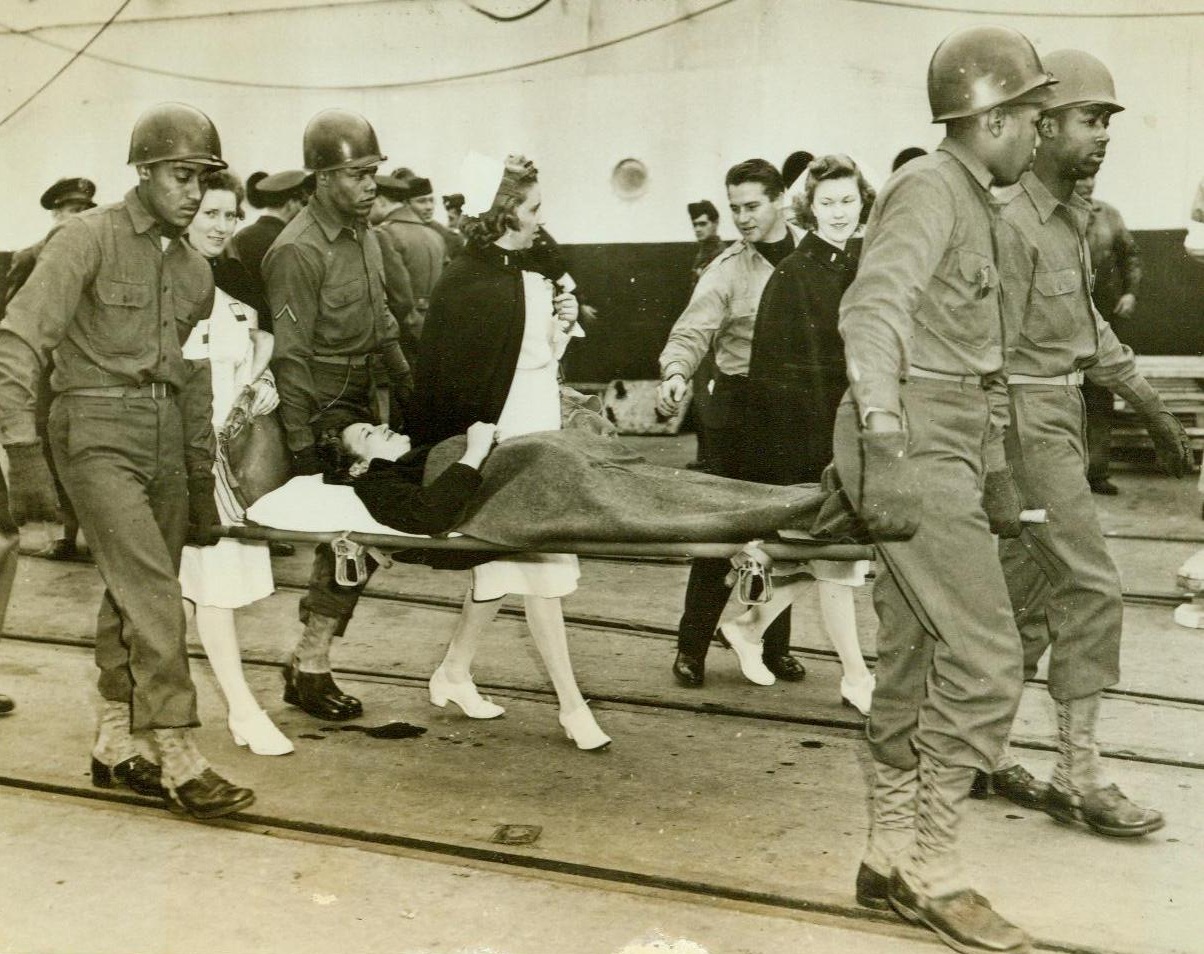
Army Nurse Comes Home, 1/8/1944. At an East Coast Port—Medical Corpsmen carry the stretcher on which Lt. Anna K. Smith came back to her native America. Smiling happily form her litter, the Army nurse was the first stretcher case to come off the U.S. Army hospital ship Acadia when it docked at an east coast port, bringing many casualties back from the battle zones. 1/8/44 (ACME);
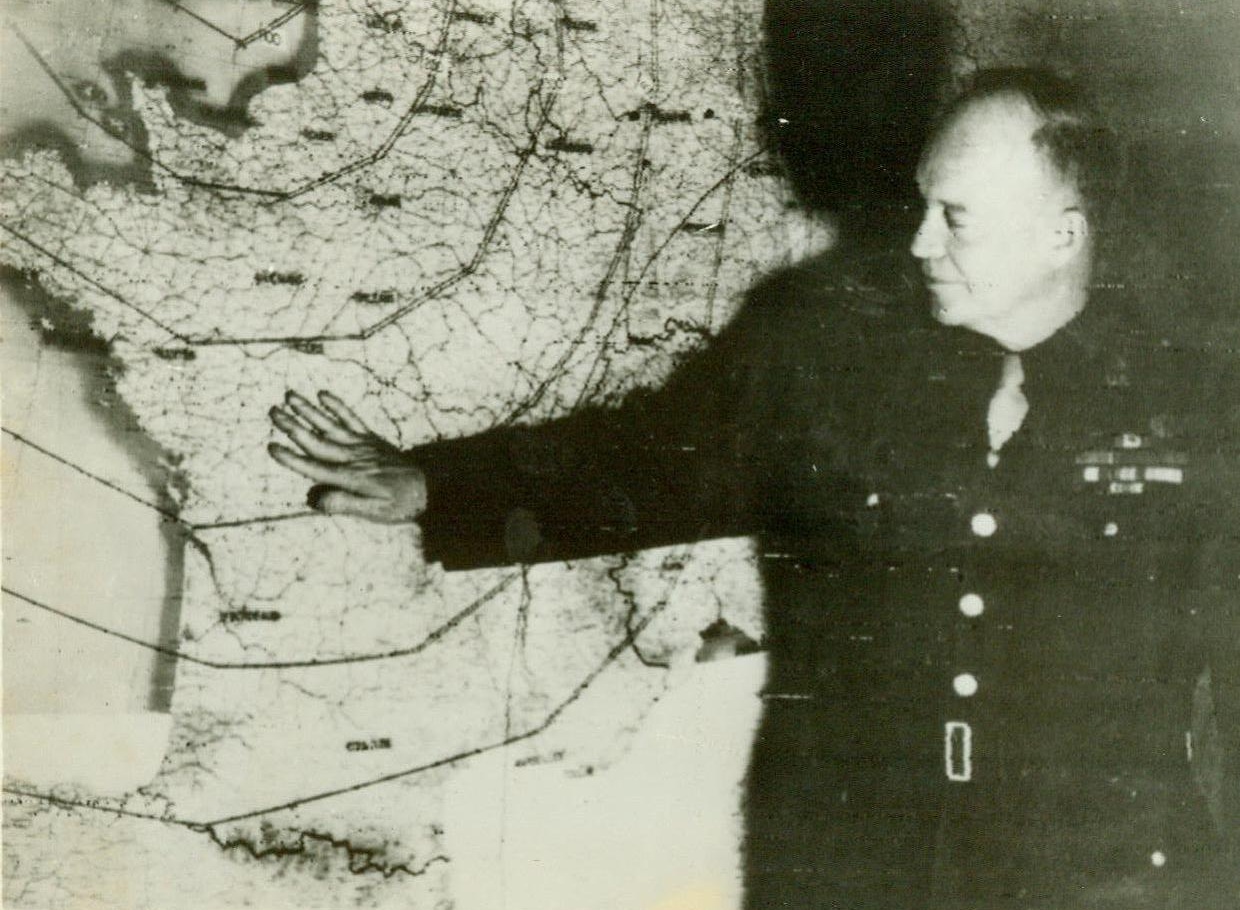
When We Strike......, 1/17/1944. London— Running his hand over the territory occupied by Hitler, as shown on a wall map at London Headquarters, General Dwight D. Eisenhower Commander-in-Chief for the forthcoming invasion of Europe, is shown during his press conference, held today (January 17th). 1/17/44 (RadioPhoto);
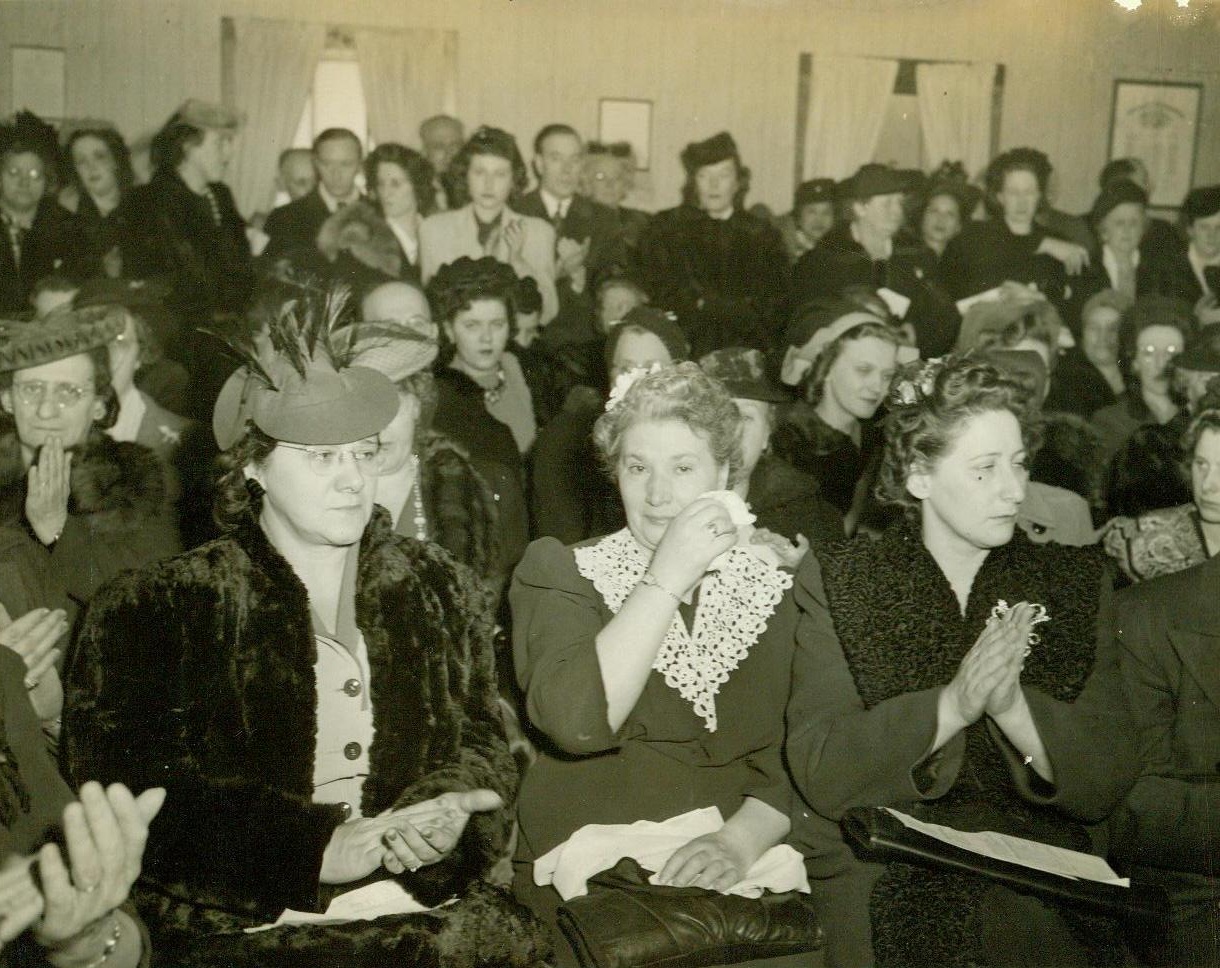
Heroes' Kin Demand Vengeance, 1/30/1944. Maywood, Ill. – Mrs. Fannie Britton (Center) weeps for her son “missing” on Bataan, as American Bataan Clan held indignation meeting at Maywood, Ill., Demanding more materials and men be supplied Gen. MacArthur, following news of Japanese atrocities inflicted on relatives of the Clan. 1/30/44 (Acme);
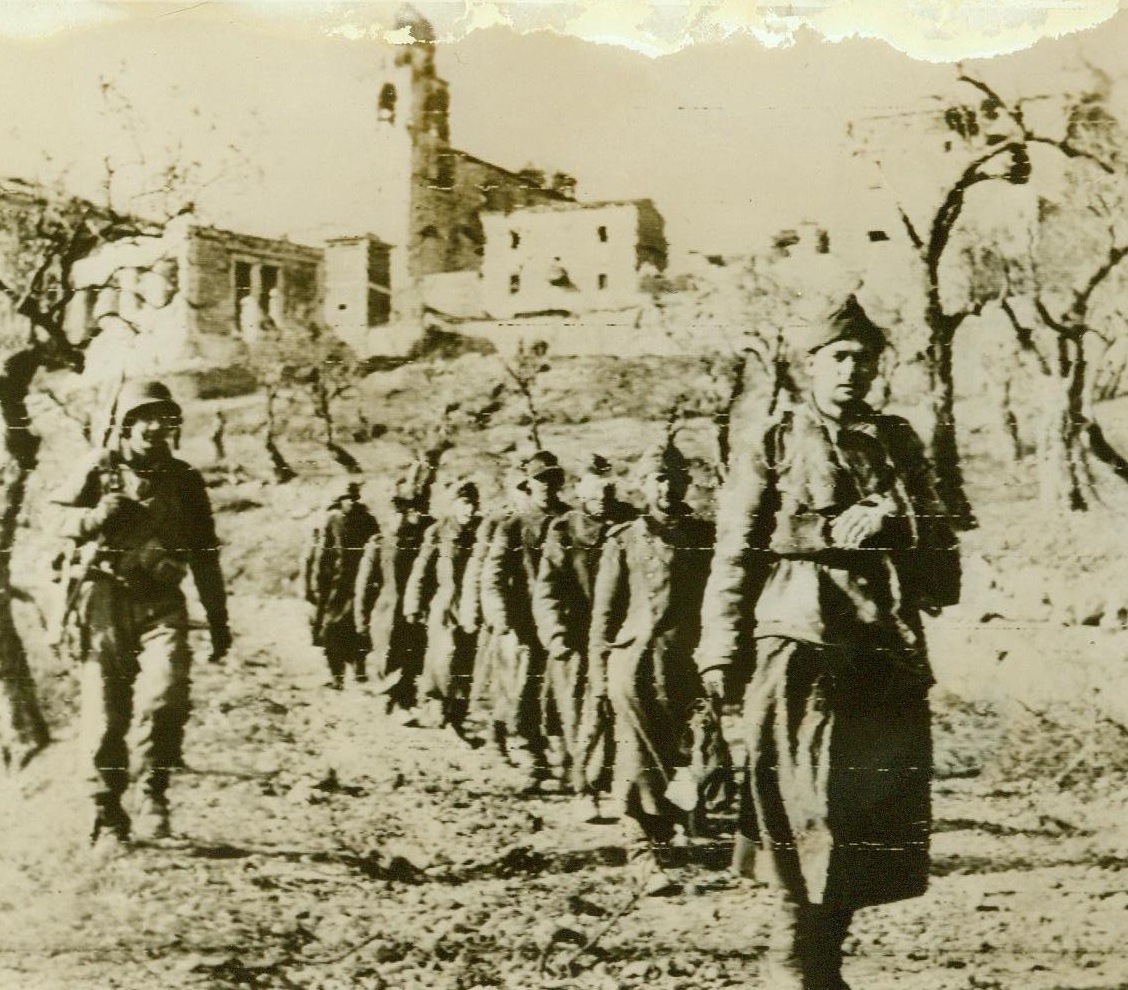
War-Weary Men in a War-Torn Village, 1/11/1944. Italy— Captured Germans are marched away from crumbling San Vittore, Italian town blasted by Nazis and Americans. The enemy soldier leading the line wears a sling, while another casualty follows in file. 1/11/44 ACME;
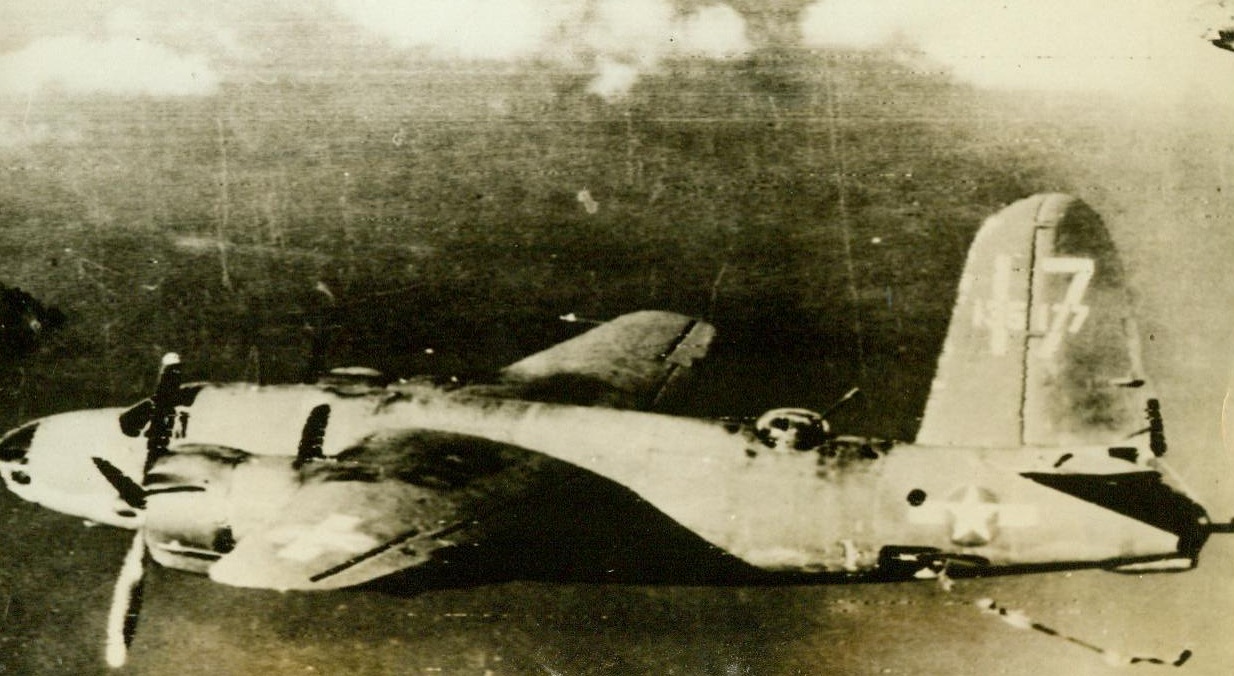
Struggle For Survival, 1/14/1944. Italy – Ammunition tracks are hurled from a gun position of a crippled B-26 Marauder as the crew tosses everything removable overboard to lighten the load. The plane’s left engine was stalled by bullets from Nazi 88 guns, while she was on a maiden mission to bomb Roccasecca Bridge, Italy, but pilot Lt. R.R. Bennett, of Toledo Ohio, and co-pilot Lt. Tilman Beardon, of Texarkana, Ark., maneuver the Marauder safely back to home base 1/14/44 (ACME);
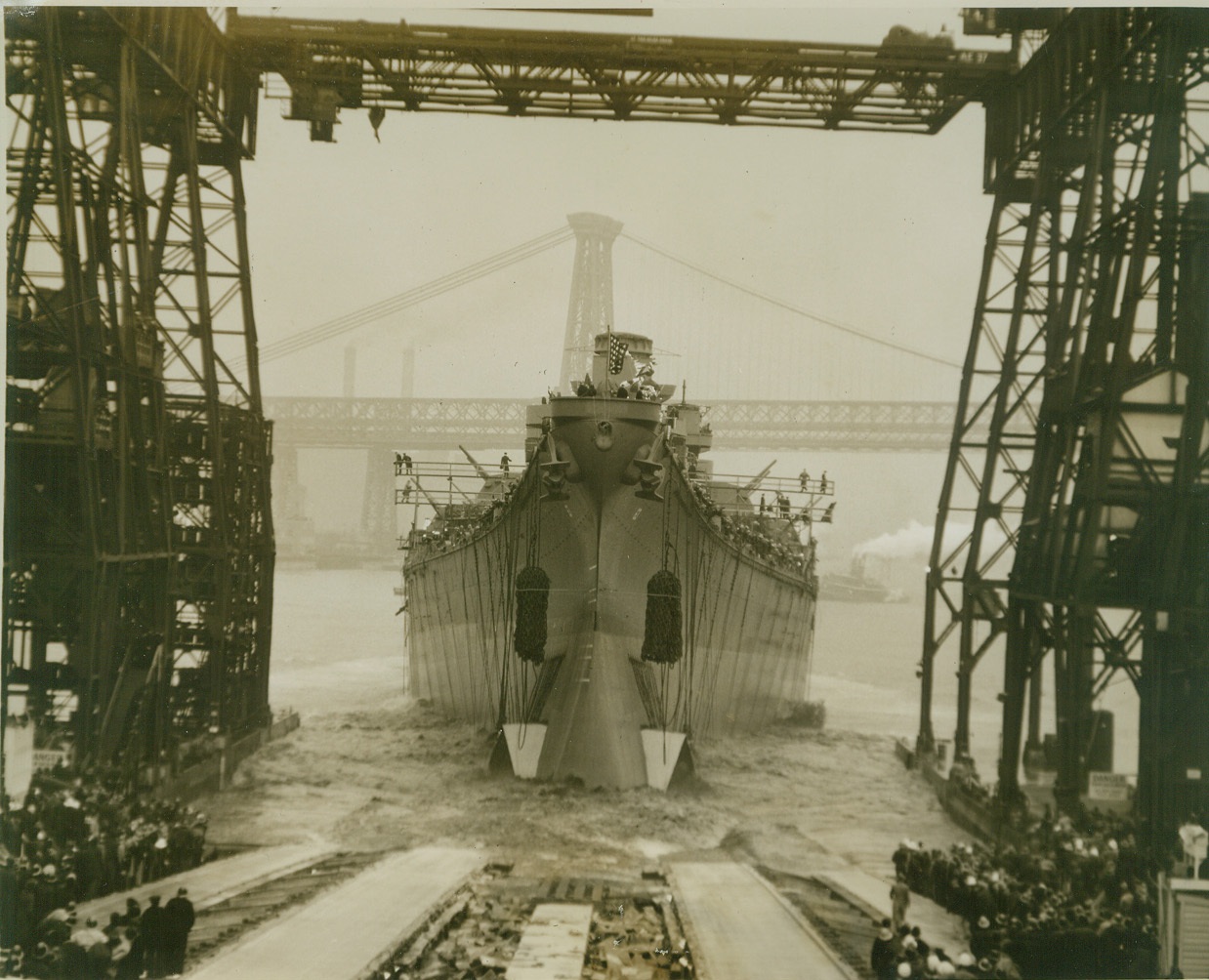
Launch U.S.S. Missouri, 1/29/1944. New York—The U.S.S. Missouri, our Navy’s newest 45,000 ton battleship, is shown as she hit the water after launching ceremonies today (January 29th) at the New York Navy Yard in Brooklyn. Credit: ACME.;
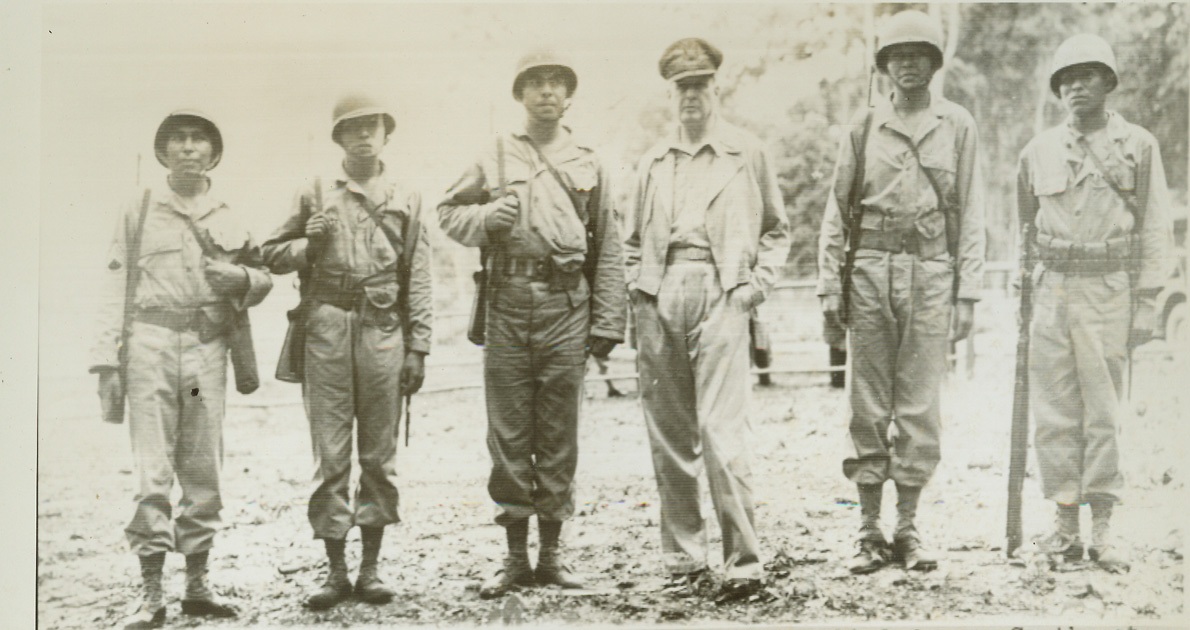
Gen. Douglas Macarthur, 1/19/1944. Gen. Douglas Macarthur, comm-in-chief Allied forces Southwest Pacific area, meets representatives of 5 different American Indian tribes in one U.S. Army unit. Left to right: S/Sgt. Virgil Brown (Pima), Phoenix, Ariz.; Sgt. Virgil F. Howell (Pawnee), Pawnee, Okla.; S/Sgt Alvin J. Viloan (Chitmatcha), Charenton, LA.; General Macarthur; Sgt. Byron L. Tsignine (Navajo), Ft. Defiance, Ariz.; Sgt. Larry L. Dekin (Navajo), Copper Mine Ariz. (U.S. Signal Corps Photo).;
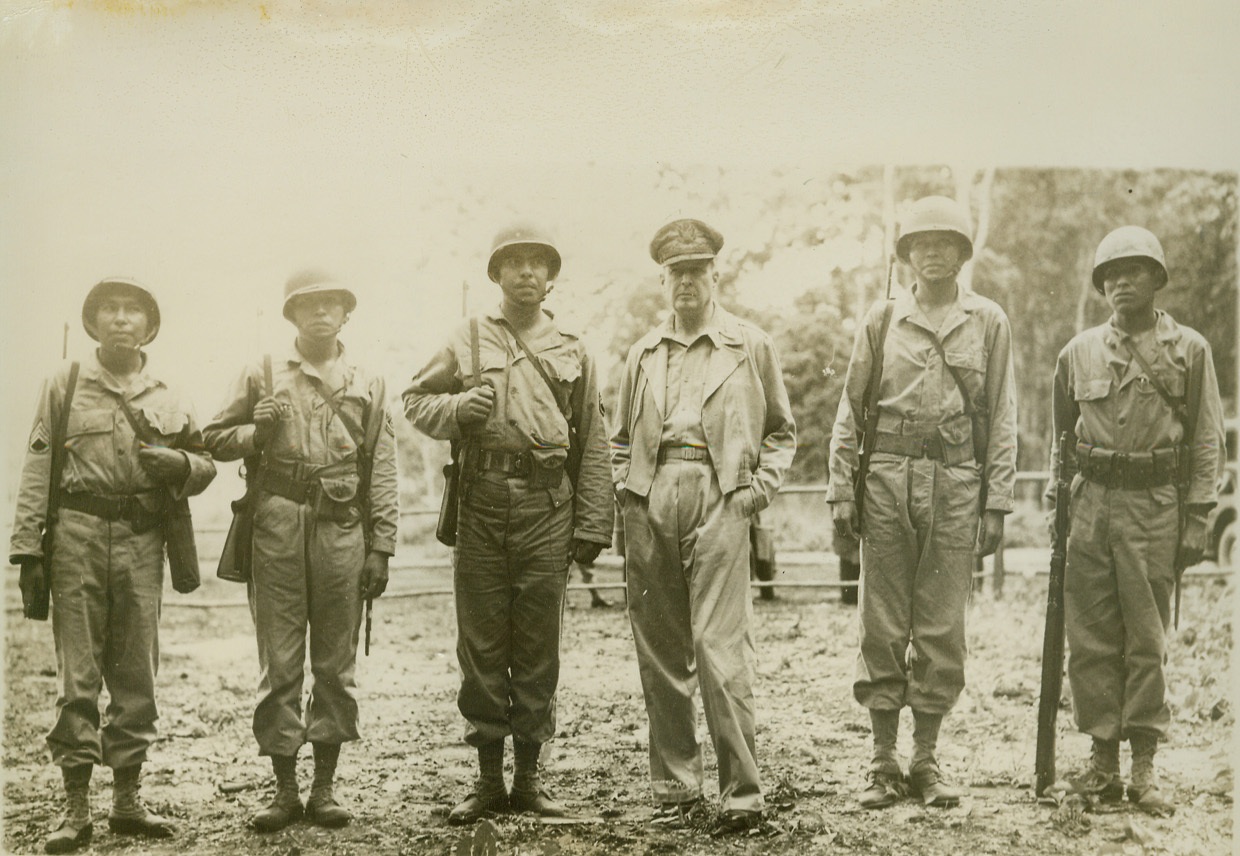
Five Indian Tribesmen Meet a Chief, 1/19/1944. Somewhere in the Southwest Pacific—Gen. Douglas Macarthur, Commander-in-Chief of Allied Forces in the Southwest Pacific, meets representatives of five different American Indian tribes in one U.S. Army unit. S/Sgt. Virgil Brown (Pima), Phoenix, Ariz.; Sgt. Virgil F. Howell (Pawnee), Pawnee, Okla.; S/Sgt Alvin J. Viloan (Chitmatcha), Charenton, LA.; General Macarthur; Sgt. Byron L. Tsignine (Navajo), Ft. Defiance, Ariz.; Sgt. Larry L. Dekin (Navajo), Copper Mine Ariz. (U.S. Signal Corps Photo).;





 Trash & Recycling
Trash & Recycling
 Online Payments
Online Payments
 City Documents
City Documents
 Parks
Parks
 Traffic Court
Traffic Court
 CITY PARKS
CITY PARKS
 Outdoor Recreation
Outdoor Recreation
 Volunteer
Volunteer
 Home
Home TRANSLATE
TRANSLATE
